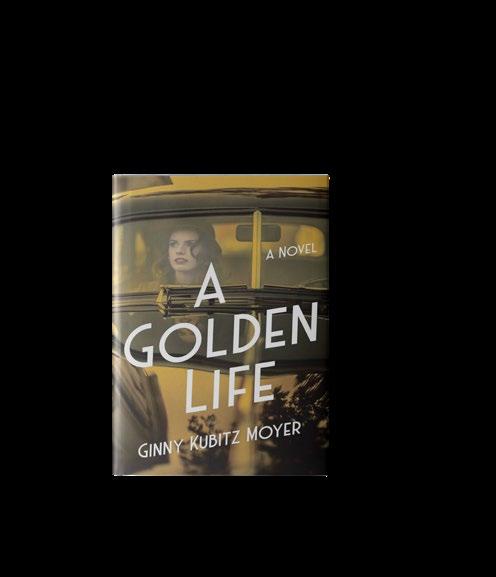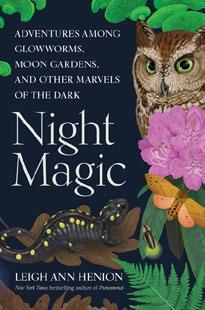FEATURING 332 Industry-First Reviews of Fiction, Nonfiction, Children’s, and YA Books



FEATURING 332 Industry-First Reviews of Fiction, Nonfiction, Children’s, and YA Books


A first look at the most anticipated titles of publishing’s biggest season


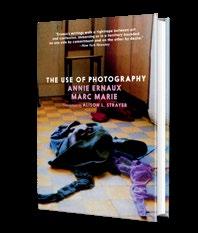


FROM THE EDITOR’S DESK
THESE MAY BE the dog days of August, but here in the Kirkus offices we’ve been relishing the brisk chill of autumn for several weeks now. Yes, it’s Fall Preview time, when our editors look to the big publishing season ahead. In this issue, we spotlight 150 of the most-anticipated titles for adults and young readers, including a bevy of celebrity memoirs (Kenny G, Connie Chung) and prominent nonfiction from fiction stars like John Grisham and Edwidge Danticat. And, of course, there’s fiction galore: novels set in the worlds of TV (Danzy Senna), ballet (Juhea Kim), chess (Sally Rooney), and literature (Louis Bayard), as well as books that explore differing notions of home from Daniel Lavery, Richard Price, Rivers Solomon, and others.
Inevitably, some fall books are not ready to be reviewed by the time we begin work on this issue— and some releases from celebrities are kept under strict embargo. Here are four more titles we can’t wait to get our hands on.
Lovely One: A Memoir by Ketanji Brown Jackson (Random House, Sept. 3): All eyes are on the Supreme Court these days, and this memoir by President Biden’s 2022 appointee promises special insight into the workings of SCOTUS as well as Jackson’s more personal story. According to the publisher, the author “reveals what it takes to advance in the legal profession when most people in power don’t look like you, and to reconcile a demanding career with the
Frequently Asked Questions: www.kirkusreviews.com/about/faq
Fully Booked Podcast: www.kirkusreviews.com/podcast/
Advertising Opportunities: www.kirkusreviews.com/book-marketing
Submission Guidelines: www.kirkusreviews.com/about/publisher-submission-guidelines
Subscriptions: www.kirkusreviews.com/magazine/subscription
Newsletters: www.kirkusreviews.com
For customer service or subscription questions, please call 1-800-316-9361
joys and sacrifices of marriage and motherhood.”
The Use of Photography by Annie Ernaux and Marc Marie, translated by Alison L. Strayer (Seven Stories, Oct. 1): A new book from the 83-year-old French writer, who received the Nobel Prize in Literature in 2022, is a literary event, and this 2005 work, now translated, is no exception. As the author was undergoing chemotherapy and radiation therapy for breast cancer, she was also involved in a love affair with journalist Marc Marie, who pens alternating chapters here. The book also presents 14 color still-life photographs taken by the authors.
The Message by Ta-Nehisi Coates (One World/Random House, Oct. 1): I have no doubt that Coates’ 2015 book, Between the World and Me, is already an established classic of our time. (Readers polled by the New York Times for its list of the 100 Best Books of the 21st Century agreed.) So expectations are high for this collection of three linked
essays, which finds the author traveling to Senegal, South Carolina, and Palestine to grapple with the stories we tell about ourselves. The publisher says Coates highlights “the urgent need to untangle ourselves from the destructive myths that shape our world—and our own souls.
Sonny Boy: A Memoir by Al Pacino (Penguin Press, Oct. 15): The star of Dog Day Afternoon, The Godfather, Serpico, Scarface, and so many more unforgettable films will finally tell his life story. Raised in the South Bronx and educated at New York’s High School of Performing Arts, Pacino was already a veteran of the Downtown theater scene when he won acclaim for his role in the 1971 film The Panic in Needle Park. His publisher calls it “the memoir of a man who has nothing left to fear and nothing left to hide.”

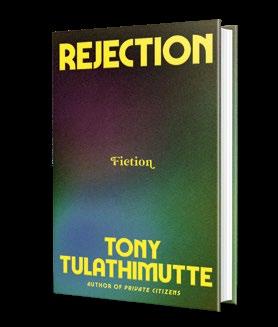


Co-Chairman HERBERT SIMON
Publisher & CEO
MEG LABORDE KUEHN mkuehn@kirkus.com
Chief Marketing Officer
SARAH KALINA skalina@kirkus.com
Publisher Advertising & Promotions
RACHEL WEASE rwease@kirkus.com
Indie Advertising & Promotions
AMY BAIRD abaird@kirkus.com
Author Consultant
RY PICKARD rpickard@kirkus.com
Lead Designer KY NOVAK knovak@kirkus.com
Kirkus Editorial Senior Production Editor
ROBIN O’DELL rodell@kirkus.com
Kirkus Editorial Senior Production Editor
MARINNA CASTILLEJA mcastilleja@kirkus.com
Kirkus Editorial Production Editor
ASHLEY LITTLE alittle@kirkus.com
Copy Editors
ELIZABETH J. ASBORNO
NANCY MANDEL
BILL SIEVER
Magazine Compositor
NIKKI RICHARDSON
Contributing Writers
GREGORY MCNAMEE MICHAEL SCHAUB
Co-Chairman
MARC WINKELMAN
Editor-in-Chief TOM BEER tbeer@kirkus.com
President of Kirkus Indie CHAYA SCHECHNER cschechner@kirkus.com
Fiction Editor LAURIE MUCHNICK lmuchnick@kirkus.com
Interim Nonfiction Editor WENDY SMITH wsmith@kirkus.com
Young Readers’ Editor LAURA SIMEON lsimeon@kirkus.com
Young Readers’ Editor MAHNAZ DAR mdar@kirkus.com
Editor at Large
MEGAN LABRISE mlabrise@kirkus.com
Senior Indie Editor
DAVID RAPP drapp@kirkus.com
Indie Editor ARTHUR SMITH asmith@kirkus.com
Editorial Assistant
NINA PALATTELLA npalattella@kirkus.com
Indie Editorial Assistant
DAN NOLAN dnolan@kirkus.com
Indie Editorial Assistant SASHA CARNEY scarney@kirkus.com
Mysteries Editor THOMAS LEITCH

Fall Preview Colleen Abel, Reina Luz Alegre, Jenny Arch, Mark Athitakis, Diego Báez, Elizabeth Bird, Kimberly, Brubaker Bradley, Jessica Hoptay Brown, Jeffrey Burke, May-lee Chai, Alec B. Chunn, Amanda Chuong, Elise DeGuiseppi, Rosalind Faires, Jenna Friebel, Amy Goldschlager, Melinda Greenblatt, Tobi Haberstroh, Katrina Niidas Holm, Natalia Holtzman, Julie Hubble, Ariana Hussain, Wesley Jacques, Lyneea Kmail, Megan Dowd Lambert, Christopher Lassen, Hanna Lee, Karen Long, Patricia Lothrop, Wendy Lukehart, Thomas Maluck, Michelle H Martin, J. Alejandro Mazariegos, Jeanne McDermott, Noelle McManus, Kathie Meizner, Liza Nelson, Nick Owchar, Andrea Page, John Edward Peters, Shira Pilarski, Carolyn Quimby, Amy Reiter, Amy Robinson, Roberto Rodriguez, Lloyd Sachs, Meredith Schorr, Gene Seymour, Clay Smith, Daneet Steffens, Mathangi Subramanian, Jennifer Sweeney, Renee Ting, Elliott Walcroft, Marion Winik, Bean Yogi Regular Issue Nada Abdelrahim, Paul Allen, Kent Armstrong, Heather Rose Artushin, Mark Athitakis, Diego Báez, Audrey Barbakoff, Thomas Beheler, Elizabeth Bird, Ariel Birdoff, Amy Boaz, Jessie Bond, Hannah Bonner, Kimberly Brubaker Bradley, Nastassian Brandon, Melissa Brinn, Jessica Hoptay Brown, Timothy Capehart, Catherine Cardno, Tobias Carroll, Charles Cassady, May-lee Chai, Ann Childs, Alec B. Chunn, Adeisa Cooper, Jeannie Coutant, Maya Davis, Michael Deagler, Cathy DeCampli, Amanda Diehl, Steve Donoghue, Melanie Dragger, Anna Drake, Jacob Edwards, Gina Elbert, Rosalind Faires, Joshua Farrington, Brooke Faulkner, Katie Flanagan, Ayn Reyes Frazee, Jenna Friebel, Elaina Friedman, Robbin Friedman, Elisa Gall, Laurel Gardner, Cierra Gathers, Jean Gazis, Carol Goldman, Carla Michelle Gomez, Melinda Greenblatt, Valerye Griffin, Christine Gross-Loh, Vicky Gudelot, Tobi Haberstroh, Geoff Hamilton, Sean Hammer, Peter Heck, Loren Hinton, Katrina Niidas Holm, Julie Hubble, Ariana Hussain, Wesley Jacques, Jessica Jernigan, Marcelle Karp, Ivan Kenneally, Colleen King, Stephanie Klose, Lyneea Kmail, Andrea Kreidler, Chelsea Langford, Christopher Lassen, Tom Lavoie, Judith Leitch, Maureen Liebenson, Coeur de Lion, Barbara London, Patricia Lothrop, Kyle Lukoff, Douglas MacLeod, Kaia MacLeod, Joan Malewitz, Mandy Malone, Thomas Maluck, Joe Maniscalco, Collin Marchiando, Michelle H Martin, Gabriela Martins, Matthew May, J. Alejandro Mazariegos, Kirby McCurtis, Jeanne McDermott, Zoe McLaughlin, Kathie Meizner, J. Elizabeth Mills, Clayton Moore, Lisa Moore, Andrea Moran, Rhett Morgan, Jennifer Nabers, Cleyvis Natera, Mimi Nguyen, Randall Nichols, Sarah Norris, Katrina Nye, Erin O’Brien, Tori Ann Ogawa, Connie Ogle, Mike Oppenheim, Nick Owchar, Emilia Packard, Andrea Page, Derek Parker, John Edward Peters, Jim Piechota, Christofer Pierson, William E. Pike, Shira Pilarski, Margaret Quamme, Carolyn Quimby, Kristy Raffensberger, Kristen Rasmussen, Maggie Reagan, Alyssa Rivera, Lauren Roberts, Amy Robinson, Roberto Rodriguez, Christopher R. Rogers, Lizzie Rogers, Gia Ruiz, Lloyd Sachs, Bob Sanchez, Caitlin Savage, Meredith Schorr, Jerome Shea, Sadaf Siddique, Karyn N. Silverman, Linda Simon, Julia Sirmons, Jennifer Smith, Allison Staley, Daneet Steffens, Mathangi Subramanian, Jennifer Sweeney, Deborah Taylor, Eva Thaler-Sroussi, Bill Thompson, Renee Ting, Lenora Todaro, Katie Vermilyea, Gnesis Villar, Elliott Walcroft, Barbara Ward, Erica Weidner, Amelia Williams, Wilda Williams, Kerry Winfrey, Marion Winik, Livia Wood, Bean Yogi, Jean-Louise Zancanella



There’s a lot going on this fall—have you noticed? But you should always make time to read fiction. Whether you’re looking for an ultratopical contemporary novel or an epic fantasy that will carry you away, there’s a bounty of choices coming to your local bookstore or library this season.
Kirkus Star
Alam, Rumaan | Riverhead (288 pp.)
$30.00 | Sept. 17, 2024 | 9780593718469
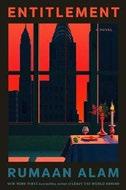
A billionaire philanthropist’s ambitious young protégé wants her slice of the pie. Whereas Alam’s previous book, Leave the World Behind (2020)—a National Book Award finalist and the basis for a Netflix film—focused on cataclysmic external threats, his new novel explores a threat from within: ambition. Or maybe that’s not quite right, because the blinding ambition of Alam’s protagonist, Brooke Orr, a Vassar-educated Black woman raised in New York City by a mission-driven white mother, is shaped by the world in which she finds herself and is propelled by its inequities. After years in an unrewarding teaching job at a Bronx charter school, Brooke, 33, takes a job as a program coordinator at 83-yearold white billionaire Asher Jaffee’s charitable foundation and is embraced as his protégé. But once Brooke has been welcomed into Asher’s place of privilege, she believes she is entitled to all it can provide: the designer clothes, the fancy meals, a space to call her own, and, more than anything, the power to change lives, to save souls. As Brooke makes increasingly ill-advised decisions, the tension slowly and compellingly builds toward a dizzying conclusion that feels both surprising and inevitable. Here, as always, Alam’s facility for vividly setting a scene or finding just the right detail or metaphor, his ability to journey inside the minds and emotions of a range of people, and his willingness to unflinchingly and insightfully address issues of
race, class, gender, and age are on full display. An exploration of the ways that access or proximity to money can dramatically shift perspective and skew purpose, identity, and behavior, the novel considers a question central to today’s America: If money equals freedom, what does that mean for people who don’t have it?
Cements Alam’s status as a talented truth-teller willing to tackle tough issues with grace, generosity, and sensitivity.
Almodóvar, Pedro | Trans. by Frank Wynne | HarperVia (240 pp.) | $26.00 Sept. 24, 2024 | 9780063349766

The noted Spanish director delivers a series of contes à clef, giving his merrily transgressive takes on life a good literary workout.
“This collection of stories (I call everything a story, I don’t distinguish between genres) demonstrates the intimate relationship between what I write, what I film, and what I live,” writes Almodóvar, the creator of films such as All About My Mother and Women on the Verge of a Nervous Breakdown. The declaration is a touch cryptic, but what follows is often strange and sometimes shocking, as with his opening story, “The Visit,” in which the putative sister of a man molested by priests in boyhood confronts one of them; he accuses her of dressing like a prostitute, to which she retorts, “I don’t particularly like the way you dress either.” For those who know Almodóvar’s films, the surprise ending won’t come entirely as a surprise. In another story, an
actor, León, desperate for a project, contemplates a top-to-bottom rewriting of the classic L’Amore, Roberto Rossellini’s adaptation of a play by Jean Cocteau, its star the luminous Anna Magnani; in León’s vision, it will become a love story between men: “The lover is bisexual.... Bisexuality is the great neglected topic of the sexual revolution.” It doesn’t play out. Perhaps the most eccentric tale portrays an aristocratic vampire who comes calling on, again, a priest whose blood flows after self-flagellation; says the vampire, who could have sunk his teeth into the scenario but professes no interest in “vampirizing,” “I am like your mystics; I like to be alone, left to follow my own devices and desires.”
Jesus, Barabbas, the singer Chavela, Isabella and Ferdinand, and, yes, the vampire all show up in these oddly delightful stories, no one doing quite what they’re expected to do.
Sometimes surreal, sometimes prurient, sometimes discomfiting— and every page worth reading.
Bayard, Louis | Algonquin (304 pp.)
$29.00 | Sept. 17, 2024 | 9781643755304
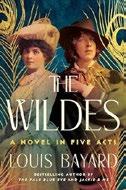
Bayard’s fictional vision of the Oscar Wilde scandal in 1890s England focuses on what the playwright’s choices, successes, and scandals cost innocent bystanders—particularly his family.
Fittingly, this bittersweet tragicomedy full of bad manners is structured like a Wilde play. The long first act, set on a Norfolk farm rented by the Wildes during the summer of 1892—three years before Oscar’s infamous court cases—focuses on Constance Wilde’s discovery of Oscar’s physical relationship with Lord Alfred Douglas. Both Wildes skirt around what they know is happening with verbal wit, their spiritual intimacy and mutual affection as obvious as Oscar’s
self-destructive passion for the charming narcissist, eternally boyish Alfred. Despite Oscar’s entreaties, the deeply hurt Constance departs Norfolk without him although the marriage limps along (a situation reminiscent of the Kennedy marriage in Bayard’s Jackie & Me, 2022). The novel is concerned less with the historical facts of what happened next—Oscar’s failed libel suit against Alfred’s father and resulting incarceration for sodomy—than with the human fallout. The following acts concern Constance’s short, unhappy life after moving abroad to hide herself and her children from the ugly publicity, and then how each of the Wildes’ two sons, so intensely beloved in early childhood by both parents, ends up psychologically damaged in adulthood. Sexuality matters less in this telling than broader issues of sexual ethics, loyalty, and conformity. Oscar’s sexual orientation is less important than his selfishness, pride, weakness, and capacity for abiding love. As she grapples with her own sexual yearnings and sense of self-worth, Constance, an intellectual and supporter of women’s rights, is upset by Oscar’s loss of desire for her—their marriage began with mutual physical attraction—as much as by whom he desires instead. The truth is heartbreaking, but Bayard’s fifth act offers an implausible but satisfying solution Wilde himself might have written to send the audience home smiling.
Bayard turns the Wilde family’s tragedy into an engrossing, eternally relevant fable of fame, scandal, and love.
Kirkus Star
The Mighty Red Erdrich, Louise | Harper/ HarperCollins (384 pp.) | $32.00 Oct. 1, 2024 | 9780063277052

This deft, almost winsome novel begins at night, with Crystal Frechette, a trucker. She’s hauling sugar beets and wearing “a lucky hat knitted by her daughter,” Kismet Poe. Her headlights are “peacefully cutting radiant holes in the blackness” when she glimpses a mountain lion vault across the road. It’s a sign, but of what? Kismet, finishing high school, is edgy, furious, and bored. Both Gary Geist, her school’s quarterback, and Hugo Dumach, a nerdy home-schooler, fixate on her as the angel destined to slay their wildly divergent demons. This nutty love triangle kickstarts the plot; Kismet, in a futile stab at avoiding teen marriage, slips from a bridge into the cold Red River, floating downstream until she’s rescued. But true love here is the kind between mother and daughter. This pair, beset by the 2008 economic meltdown, proves expert in “getting trapped but at least not giving up.” Around them, a recent, communal catastrophe on the frozen river stays murky through three-quarters of the story. In counterpoint, the town’s daffy book club dissects Eat Pray Love and The Road, each session blooming into comic set pieces. Erdrich reaches for some of her fictional staples: a waitressing gig, multiple viewpoints, and, always, mixed-heritage Native people trying to grasp and transmit that heritage. Her writing feels both effortless and wise. She notes a boy’s “shy armpits” and how a soundproofed house can feel “inhuman, maybe even violent.” Even if a minor character, the Catholic priest, bogs down in caricature, Erdrich has few equals in braiding landscape and sky into the marrow of her characters. Her poet’s origins are in full force as she folds in the sickening damage of fracking and pesticide-dependent agriculture, right alongside the sprouts of resistance. In this tender and capacious story, love and tragedy mingle along the river and into the world.
Kirkus Star
Greenwell, Garth | Farrar, Straus and Giroux (320 pp.) | $28.00 Sept. 3, 2024 | 9780374279547

Greenwell, who has written so evocatively about desire and sex in What Belongs to You (2016) and Cleanness (2020), now probes something quite different: life-threatening illness.
The Red River of the North cuts a vivid track through the hardscrabble lives that anchor Erdrich’s surpassing North Dakota fiction.

With no warning and a violent eruption of pain so intense it felt like someone “plunged a hand into [his] gut and grabbed hold and yanked,” the narrator suffers an infrarenal aortic dissection—a tear of the inner layer of his aorta. It’s a sometimes fatal malady that usually happens to people older than the narrator, who’s in his 40s. Deeply reluctant during the pandemic to go to the hospital in Iowa City, he endures the pain at home until his partner, L, convinces him to get treatment. The medical staff is alarmed, and also titillated, by encountering such a rare malady. The narrator of this autofiction endures lab test after lab test and must learn how to be powerless—how, for example, to refrain from using the bathroom near his ICU bed by himself or how to walk there without tangling the many wires and IV lines threaded from his body. As usual in a Greenwell novel, the tangents are tantalizing, and with so much time spent inert and left to ponder, the narrator finds his imagination flying beyond his hospital bed to the fracturing of his family, his life with and love for L, and the implications of their disastrous home renovations. But this is a novel about bodies and how weird they are, and Greenwell often returns to thinking about them. “What a strange thing a body is,” he writes, “…and how strange to have hated it so much, when it had always been so serviceable, when it had done more or less everything I had needed until now, when for more than forty years it had worked so well.” There’s more suspense
here than in Greenwell’s previous work, as the reader is eager to discover the outcome of the narrator’s illness: How will he get out of the ICU and return to life? Greenwell—such a finely tuned, generous writer—transforms a savage illness into a meditation on a vital life.
The Witches of El Paso
Jaramillo, Luis | Primero Sueño Press (288 pp.)
$27.99 | Oct. 8, 2024 | 9781668033210
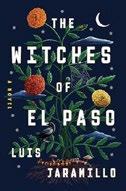
A busy El Paso lawyer embarks on a supernatural journey when she uncovers a startling truth about her great-aunt. In 1943, Elena Eduviges Montoya, called “Nena” by her family, resigns herself to serving her older sisters as a housemaid and nanny while World War II rages, “biding her time until the Germans attacked.” But one sweltering afternoon, Nena has a vision foretelling the death of their landlord, and that night she receives a midnight visit from black-clad Sister Benedicta de la Cruz, who transports her to 1792—when El Paso del Norte was still part of New Spain—and leads her to a strange convent, where the nuns are likewise afflicted by visions. Nena learns she must remain in this enchanted realm in order to undertake training to channel “La Vista,” that part of God that comprises nature and chaos, before she can return home. Fast forward to the present day, and Nena’s great-niece, Marta, juggles her roles as a lawyer at a struggling firm, a mother to two boys, and a wife stuck in a humdrum marriage. All this gets turned upside down when an alarming kitchen incident involving the elderly Nena, burned rice, and handsome firemen brings Nena to live with Marta’s family. After Marta has an unnerving
experience with seemingly supernatural soot (“when she opens her eyes again, the wall continues to blink, soot there, soot gone”), Nena comes clean about a secret she’s kept for a lifetime: She gave birth to a baby, Rosa, during her time on “the other side.” The revelation sets the women on a path to recover Rosa from the shadowy realm of El Paso del Norte. Alternating chapters between Nena’s past and Marta’s present, Jaramillo braids the storylines together like a mal de ojo bracelet, seamlessly weaving in Spanish language terms and Mexican cultural touchstones such as pozole, rebozo, and el aquelarre. Jaramillo’s atmospheric prose conjures the dusty El Paso of the past, and depictions of La Vista vibrate with “colorful knots of waves,” glowing indigo, maroon, and bright pink, yielding “a wild spell, like yeast in the air.” This riveting page-turner affirms the adage, “Family stories teach us how to live. Family secrets teach us to kill parts of ourselves.”
Gripping and cinematic, the novel’s worlds of El Paso past and present will bewitch and enrapture.
Kim, Juhea | Ecco/HarperCollins (320 pp.)
$30.00 | Nov. 26, 2024 | 9780063394759

Riveting novel of a prima ballerina’s tumultuous rise, fall, and potential return.
Kim’s bold second novel propels the reader into the competitive world of contemporary Russian ballet. The book begins with a crisis: Former prima ballerina Natalia Leonova is a mess. Addicted to pain meds and sleeping pills—which she’s washing down with vodka—Natalia has returned home to
St. Petersburg to attempt a comeback. A disastrous accident has prematurely ended her star turn at the Paris Opéra, but even worse than the injuries to her feet are her psychic wounds and loss of confidence. As Natalia struggles during rehearsals, she reminisces about her past as a protégé of the famed Mariinsky Ballet school and company. The reader is plunged into the rivalries between dancers, lovers, friends, and even nations as Natalia rises through the ranks. Although born into poverty and raised by a single mother, Natalia has an extraordinary gift: She can jump higher than any other ballerina. Reflecting on her audition, Natalia recalls, “It was the force of all I’d been suppressing; I felt like I could reach my hands and tap the ceiling if I wished. The board members were now pointing in my direction. Murmurs and gasps. That’s a jumper. I sprang even higher.” Kim weaves in plot threads involving the Russian invasion of Ukraine, the tabloid press, and celebrity parties, as well as complications related to various expressions of sexual desire to show that no form of art can exist separately from the complexity of life. At times Natalia seems extremely naïve about the ways of the world outside ballet; refreshingly, the novel never punishes her for her excellence or her ambition. This is another brilliant page-turner from Kim, whose first novel, Beasts of a Little Land (2021), was a finalist for the Dayton Literary Peace Prize. Written in sumptuous prose, Kim’s novel is a feast for the senses.
Kirkus Star
Koch, Ariane | Trans. by Damion Searls | Dorothy (176 pp.) | $16.95 paper Sept. 3, 2024 | 9781948980197

A woman adrift finds her life upended by a traveling stranger. The nameless protagonist in Swiss playwright and artist Koch’s
debut novel has “come to rest” in her parents’ house in her small hometown, her parents having moved away. A self-described “tomb-keeper,” the protagonist lives among the detritus of her childhood home and memories associated with it. She feels deeply disconnected from her hometown and its inhabitants but is unwilling to leave. The novel opens with her noticing “the visitor,” who seems to have “materialized from the void,” at the local bar. Though she keeps her distance from other townspeople, she is drawn to the stranger and invites him to live with her. Immediately, their relationship is all extremes; the house holds them together as their odd behaviors force them apart. Seemingly, the longer the visitor stays, the more deranged the protagonist becomes. When the down-on-his-luck visitor begins to shed his sadness and flourish, the protagonist realizes she cannot control him or herself anymore: “The visitor has nested in me to such an extent that no matter how hard I try to rebel against him I am in the end only destroying myself.” The plot, if you can call it that, must be excavated from beneath the protagonist’s thoughts, feelings, and memories. Realism gives way to exaggeration that melts into the absurd. Disparate vignettes offer jarring glimpses into the protagonist’s psyche, including her increasingly strange and complicated dynamic with the visitor—as well as her distant relationship with her parents and siblings. It can be easy to miss the moments of humor and beauty that litter Koch’s novel while navigating the meandering and peculiar prose. One such moment is when the protagonist approaches the visitor for the first time: “It’s too bad that we always miss the beginnings of things, while the ends of said things always hammer into our bodies.” The novel’s ending offers a new beginning for the protagonist, which she thankfully does not miss this time around.
Layered, experimental, and fragmented, this novel embraces the strangeness both in and around us.
Krasznahorkai, László | Trans. by Ottilie Mulzet | New Directions (512 pp.)
$18.95 paper | Sept. 3, 2024 | 9780811231534

K rasznahorkai’s latest postmodern experiment explores small-town discontents in post-unification eastern Germany.
“Your voice is so fucking insipid, Florian, are you some Jew or what?” So bellows “the Boss,” the head of a clutch of neo-Nazis in a Thuringian backwater smack in the heart of the new Germany. Apart from idolizing Hitler, the Boss is also a hectoring concertmaster who owns a cleaning company (its ominous all-caps slogan “ALLES WIRD REIN, ALL WILL BE CLEAN”). It’s good for business but enraging all the same that someone is spray-painting sites associated with Johann Sebastian Bach, one of the Boss’ many obsessions, with graffiti signed “WOLF HEAD.” The subject of the Boss’ meltdown is Florian Herscht, a gentle and dim giant who is fascinated by particle physics, even if he doesn’t understand it, and harbors fears of dentists, tattoos, and the end of the world. About the latter he regularly writes to German premier Angela Merkel, warning of the impending apocalypse. Reminiscent of the similarly dim but good-hearted giant of Günter Grass’s The Tin Drum, Florian strains to understand what is happening in tiny Kana, now populated by immigrants from Eastern Europe and from even as far away as Vietnam. While the Boss rails against his neighbor Ringer, “a Jew, meaning he was part of the conspiracy,” the wolves are indeed returning, as are magical birds and other signs and portents of the very apocalypse that Florian worries about. In a long book with only one terminal punctuation mark, not easy to read but graced by a certain poetry, Krasznahorkai allegorizes globalism and nationalism, gets in digs at complacent burgers and ardent environmentalists, and illustrates, through Florian and other characters, how thinly the veneer of civilization lies atop a thick crust of savagery.
Brilliant, like all of Krasznahorkai’s books—and just as challenging, though well worth the effort required.
Kushner, Rachel | Scribner (416 pp.)
$29.99 | Sept. 3, 2024 | 9781982116521

A woman infiltrates a cabal of French radicals. Will she go native?
The narrator of Kushner’s fourth novel goes by Sadie, though her real name—like much of her identity—is clouded in mystery. She works undercover to undermine environmental activists, formerly for the U.S. government, but since a case went sideways, she’s gone freelance. Now, she’s been commissioned by unnamed “contacts” to disrupt the Moulinards, a small farming cooperative in southwestern France protesting a government effort to construct a “megabasin” to support large-scale corporate farming. The Moulinards’ leader, Bruno, is an “anti-civver,” skeptical not just of capitalism but of the entire human species. (His writings—he exists largely in the form of email dispatches— argue that Neanderthals might have been better adapted for the planet.) Sadie has an arsenal of tools to monkey-wrench the monkey wrenchers—a willingness to exchange sex for access, a knack for languages and hacking, well-made cover stories, fake passports—but her work among the Moulinards stokes her own identity crisis. As she enters their world, she processes their enthusiasm, their philosophy (there are abundant references to critic Guy Debord), and their paranoia, which escalates as a national minister plans a visit to the region, upping the stakes. As if echoing Bruno’s concern, Sadie is such a slyly clever human that she’s undermining her own humanity. Sadie is similar to Kushner’s earlier fictional protagonists—astringent, thrill-seeking, serious, worldly—but here the author has tapped into a more
melancholy, contemplative mode that weaves neatly around a spy story. Nobody would mistake it for a thriller, but Kushner has captured the internal crisis of ideology that spy yarns often ignore, while creating an engaging tale in its own right. A deft, brainy take on the espionage novel.
Lange, Nora | Two Dollar Radio (340 pp.) $18.95 paper | Sept. 17, 2024 | 9781953387516

Two peculiar sisters navigate the pain and beauty of growing up in rural America. In the 1980s, Joanne and Bernadette Fareown are raised by parents Henry and Sylvia on an Illinois farm. The backdrop is rather mundane, but the family is anything but. Henry and Sylvia, sexually affectionate to a fault, spend much of their time in the throes of passion while their daughters pore over books of ancient mythology, feminist philosophy, and other esoterica. They refer to themselves as “junk kids” and partake in strange intellectual rituals “just as the classics had taught us to do.” Jo, the elder sister, was born “a nine-pound skeptic,” prone to rebelling against anything and everything. She speaks in an unusually erudite manner, spouting baroque truisms—“We are surrounded by America with its orgies of barbarism”—in between mental breakdowns and general hell-raising. Bernie, meanwhile, yearns to escape the suffocating poverty of the rural Midwest but only ends up a moderate distance away, at a university in Chicago. In spite of her attempts to sever her past (and the ever-present threat of mental illness, which has plagued so many Fareown women before her), she notes, “I would never escape the web that was my family. I would never break from that group of individuals facsimiled for America.” Her aching to understand herself, her family history, and, of course, her beloved sister
takes her across the country, a mystical and darkly humorous voyage rife with bizarre interactions and apt cultural references. Lange’s debut novel is a refreshingly sardonic take on the decaying ideal of the American dream, with an anti-capitalist tilt. At the end of it all, this is not just a brilliant bildungsroman: Like the classics that the Fareown sisters quote ad infinitum, it’s a lush, uncanny mythology itself.
A wonderfully shrewd, surreal, and comical odyssey through a crumbling American landscape.
Lavery, Daniel M. | HarperVia (272 pp.) $28.99 | Oct. 15, 2024 | 9780063343535

This comic novel follows the lives of the denizens of the titular women’s hotel in 1960s New York. For 35 years, the Biedermeier has provided room and half board to the working women who make it their home. But when the hotel’s ever-shrinking income forces Mrs. Mossler, the proprietress, to contemplate cutting the first meal of the day, staff members and residents are forced to consider that the establishment’s days may be numbered. Lavery’s long-form fiction debut is less an intricately plotted novel than a collection of minor tribulations and close observations. Luckily, he has assembled a cast that charms from page 1, including Katherine, the capable and somewhat too accommodating first-floor director; Stephen, an elevator operator who’s a borderline extortionist on moving day; Kitty, a first-floor resident who’s simply shameless about asking for favors; Pauline, a second-floor resident and part-time revolutionary; Lucianne, a third-floor resident and social columnist; J.D., a fourth-floor resident and George Sand biographer; Dolly, a lesbian bartender who also lives on the fourth floor—plus two new arrivals, the glamorous Gia and the
rather hopeless Ruth. Despite the substantial ensemble and modest page count, every character is distinct and their backstories, misadventures, and little victories intertwine skillfully. Lavery has a wonderful ear for a period turn-of-phrase and his prose glitters with humor and affection for human foibles—for example, “Stephen was a sort of perpetual student who worked toward his degree after the manner of the fairy bird in the Brothers Grimm story about eternity, who every hundred years flew to the top of a distant mountain and sharpened his beak on it.”
Readers will be hard-pressed not to read sections aloud to passersby.
For those unafraid to meander, a stay at the Biedermeier is pure pleasure.
Lerner, Betsy | Grove (304 pp.)
$28.00 | Oct. 1, 2024 | 9780802163707

The younger of two siblings grows up in the shadow of her beautiful, reckless, mentally ill sister.
“Here are the ways I could start this story,” Amy Shred says, offering three choices in a brief prologue to memoirist and literary agent Lerner’s debut novel. “Olivia was breathtaking.” “For a long time, I was convinced that she was responsible for everything that went wrong.” “No one will love you more or hurt you more than a sister.” The engaging, thoughtful voice established here goes on to unfold the story of Amy’s childhood, coming of age, and early adulthood, all profoundly shaped by the wild trajectory of her older sister: a rebel, a runaway, a mental patient, a dropout, a thief, a missing person. Amy herself— called Bunny or Bun in the family—is the classic supersmart miserable outsider, bullied at school, friendless, always bewildered at the utter unfairness of life. What could be a nice normal Connecticut Jewish family is anything but as Amy’s parents are pushed far beyond their ability
GUIDE ME HOME
to cope, and ultimately their ability to stay married. Amy finishes a science major at college in three years and throws herself into graduate work at a lab at Columbia University, zigzags into publishing, finally loses her virginity, meets the man she will marry, and goes into therapy. The story unfolds with the verisimilitude of a memoir: Amy’s nuanced relationships with her mother, her father, and her partners are all utterly convincing and relatable. Her mother, Lorraine, is a particularly fine creation, both a very specific East Coast Jewish type and an archetypal maternal presence. “In the months and years after she died, I often saw the world through her eyes, as if I had inherited her mantle of judgment, her scoreboard in the sky.” Many of us know that feeling exactly. A seamlessly constructed and absorbing fictional world, full of insight about how families work.
Leung, Muriel | Norton (272 pp.) $18.99 paper | Oct. 22, 2024 | 9781324076186

Inhabitants of a New York City tenement band together to brave the “after-after.” Earthquakes rock Manhattan, reducing the financial district to rubble. Then weekly acid rainstorms start corroding buildings, bridges, roads, and power lines. Cell towers go down, checkpoints go up, and travel between boroughs becomes difficult. Mira tries to convince her partner, Mal, to flee Queens—now an “At Risk” zone—and go stay with Mira’s mother, Ma, on the Lower East Side, but their crumbling abode was orphan Mal’s childhood home, and she can’t bring
herself to leave. Heartbroken but unwilling to die for Mal’s nostalgia, Mira returns to her own childhood home: building 4B, apartment 9A of the Gratuitous Place housing projects. Mira feels lost without Mal, though, and begins hosting a ham radio show, How To Fall in Love in a Time of Unnameable Disaster, in hopes that Mal will hear. Instead, Mira’s transmissions attract the romantic attentions of Sad—the headless man who lives in unit 1A. Excerpts from Mira’s broadcast pepper Leung’s ambitious debut, which unfolds via myriad perspectives and narrative fashions. From Ma to gleeful poltergeist Grandpa Why to the spirit of an oversized queer cockroach named Shin, each boldly drawn point-of-view character adds a new layer to the story and texture to the world in which it’s set. Style occasionally overshadows substance, fuzzing the tale’s focus, and readers seeking catharsis may be left wanting, but by and large, Leung’s novel strikes a satisfying chord, harmonizing joy and optimism with despair and melancholia. Surreal imagery combines with poetic prose to illustrate what life and love look like when crisis becomes commonplace and everyone is grieving—even the ghosts. At once absurd and profound.
Locke, Attica | Mulholland Books/ Little, Brown (320 pp.) | $29.00 | Sept. 3, 2024 9780316494618 | Series: Darren Mathews, 3

Locke resolves the loose ends of her award-winning trilogy of novels set along East Texas’ Highway 59—beginning with Bluebird, Bluebird (2017)
and Heaven, My Home (2019)—in ways at once gratifying and unsettling. The year 2019 finds Donald Trump still in the White House and Texas Ranger Darren Mathews struggling toward as much peace of mind as a proud yet vulnerable Black man can find. What’s kept him especially vulnerable is the looming threat of indictment by an ambitious district attorney for obstructing justice in the murder of a white nationalist, the principal problem being that Darren knows he’d be found guilty. “He wasn’t entirely sure he didn’t deserve to be indicted. Wasn’t sure either that he didn’t deserve a medal.” Either way, Darren decides he can no longer function as a Ranger under this cloud, so he turns in the badge he’d once proudly worn. When he comes home after resigning, he finds his estranged mother, Bell, waiting for him. Darren has many reasons for not wanting to talk to her, beginning with an assortment of resentments from his childhood and culminating with the fact that she gave the weapon used in the aforementioned murder to the DA. “I was trying to protect you,” she insists, which Darren doesn’t believe. Nor does he believe that she’s sober after years of alcoholism. But she’s not here to stir up old grievances. Bell’s asking him to find a Black student at Stephen F. Austin College who disappeared from a sorority house where Bell’s been working as a maid. At first, Darren’s too wound up over his mother coming into his life again to even consider her request, so wound up that he tumbles into his own nightmarish round of hard drinking, but he eventually decides to take the case. And there’s much more to it than anybody connected with the school or the girl’s all-white sorority bothers to acknowledge. The trail leads to a town called Thornhill, which is dominated by a family-run corporation with deep political connections and vaguely sinister control over its employees. This case may lack something of the edgy, violent nature of the crimes in the two earlier books. But Locke’s main order of business here is with Darren’s reckoning and reconciliation with a past as full of deceit and false leads as even the most elaborate whodunit. We’ve missed Attica Locke’s deft and wise way with the crime novel. We want more.


Interactive Content

www.laevnotes.com
Paperback ISBN: 978-1-7343635-3-1
Kindle eBook ISBN: 978-1-7343635-4-8


“Rich personal and cultural history of a young woman in Berlin’s Belle Epoque.”
—Publishers Weekly/ BookLife Reviews

“A tender, personalitycentered biography of golden age Berlin.”
—Kirkus Reviews
“A wonderfully composed portrayal that could be considered narrative Art Nouveau.”
—BookTrib
Author of The Mighty Red
HOW CAN A novelist keep writing so many good books so consistently for so long? Louise Erdrich came out of the gate strong with Love Medicine in 1984, but the last 12 years have seen a magnificent run of novels that racked up prizes galore. This fall brings another surefire winner: The Mighty Red (Harper/HarperCollins, Oct. 1), which Kirkus, in a starred review, calls “tender and capacious.” (See the review on p. 7.) Erdrich answered some questions by email; the exchange has been edited for length and clarity.
What were you reading, listening to, or watching during the writing of The Mighty Red?
The book is set in 2008-09, so I was listening to Lady Gaga, Britney Spears, Beyoncé, the Pussycat Dolls. Also Northern Cree. I was reading old newspapers and agriculture reports; The Road ; Eat, Pray, Love ; Far From the Madding Crowd ; The Return of the Native ; as much as I could bear on pesticides, herbicides, and groundwater depletion; also the geology of the Red River Valley, bird migration, trees, and storms. As I was finishing up a long, involved bout of editing, I was overjoyed to get an advance copy of Where Wolves Don’t Die by Anton Treuer, an Anishinaabe writer from Minnesota. This book took me far from the Red River Valley into Indigenous territory in Canada, on a life-and-

death adventure with people who were warm, funny, competent, impulsive, mistaken, wise.
Where and when did you write the book?
I write in the attic of my house in an old chair I had reupholstered in a crimson-red plush material. I still have to write whenever I get the chance and don’t have a true routine. It feels exquisite when my life is calm and orderly, but then I become impatient and feel that I should be cleaning. About five years ago I began to realize that my carefully compiled scrapbooks and notebooks and diaries had become alarming. I was going to burn them but my sister said to keep them because you never know.
What was most challenging about writing this book? And most rewarding?
As I started The Mighty Red I thought it was going to be about a terrible process—industrial farming—but it became a book about a different terrible process—love—and another terrible process—making money— and yet another terrible process— work. Somewhere along the way all of these terrible processes got mixed up with ecstasy and beauty. Writing the beginning was easy and pleasurable; writing the end was easy and pleasurable; writing the middle was a terrible process.
What fall release are you most


eager to get your hands on and read?
I look forward to rereading Creation Lake by Rachel Kushner. At last I get to say how deeply, madly, irrecoverably, I loved Creation Lake. I got that eerie sensation from the first page—the feeling you have when you know you belong to this book. Not only was she writing my favorite sort of narrator (despicable) and about my least favorite sort of people (charismatic whiny men), but she was writing about my favorite subjects (deep time and betrayal) and it was all stylish and cool, and then somehow the book struck a blow to my heart, which surprised me a lot, because I did not suspect what Rachel Kushner was really up to all along.
Interview by Tom Beer.
Madison, Shawntelle | Amistad/ HarperCollins (448 pp.) | $28.00 Sept. 3, 2024 | 9780063290594
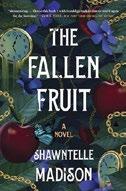
A n intriguing hybrid of historical romance and fantasy suggests that going back in time may be one way to weed out generational trauma.
“My family tree has poisoned roots,” Cecily Bridge-Davis announces at the start of this haunting saga about the “curse” of time travel. It is May 1964 and Cecily, an African American professor of history, has come into possession of her father’s 65-acre patch of Virginia farmland. When she leaves her Tennessee home to see what’s there, she finds an empty cabin, a spool made from a maple tree, and a family Bible with a yellowed flyleaf listing the names and birth dates of every Bridge family member born on the farm from the 1760s to the 1920s. She also hears from an elderly local about a long-ago murder-kidnapping implicating one of her ancestors. Which turns out to be slightly less shocking than discovering the reason why some of those ancestors vanished for decades: One Bridge offspring in each generation is somehow transported back in time. She also finds a map with locations of strange containers along with a list of “Bridge Family Rules” for time travel: “Never interfere with past events.” “Always carry your freedom papers.” “Search for the survival packs in the orchard.” “Do not speak to strangers unless absolutely necessary.” Cecily presses her inquiry into the family’s temporally peripatetic history all the way back to the 18th century and such precursors as Luke, whose tumble through time takes him from freedom to slavery and eventually into the Continental Army, where he undergoes the travails of Valley Forge. After her forays in the library for more information, Cecily herself is compelled to leave 1964 for 1911, where she takes a different identity and eventually gets a teaching job in circa 1924 Washington, D.C., where she tells one of her students, a young woman named Amelia Bridge, that
they’re related and that “Millie” must make the most important time jaunt of their shared family history. Sometimes all this gets even more complicated than it reads here. But Madison shows considerable skill and narrative control. To her credit, it’s hard not to be reminded of Octavia Butler’s Kindred, as well as The Time Traveler’s Wife and some of Ray Bradbury’s time-displacement stories.
A crafty, page-turning spin on chronicling Black family history.
Mihesuah, Devon A. | Univ. of Oklahoma (178 pp.) | $19.95 paper Oct. 8, 2024 | 9780806194677

A chilling collection of stories about the tricksters and other beings of Choctaw lore who refuse to be forgotten.
When homicide detective Monique Blue Hawk thinks she’s encountering a deer in “Kashehotapolo: The Deer Man,” she makes a startling discovery: “It stepped into the clearing. Her jaw dropped. She looked lower and with a start realized that the buck did not have a deer head. She saw an old man’s face, furred like a deer, wrinkled and passive.” Kashehotapolo is one of the entities in the Choctaw pantheon, and Choctaw historian and writer Mihesuah explores the interactions of humans with these various beings in tales blending folklore with ghost stories, detective fiction, and other genres. Some are set in the years before and after the Chahtas, or Choctaws, were forced to leave their homelands and migrate west in the 1830s. Mihesuah explains in a note how the supernatural creatures in their belief system followed them west, too. Some, like the shampe—a version of Bigfoot—seem frightening but are harmless, while others are truly menacing. That includes the shape-shifting Elus Crow in “The Cornfield,” a story that wouldn’t feel out of place in a Stephen King
collection. Alive for centuries, Crow, who’s an evil opa, or horned owl, preys on lost travelers who come upon his remote farm. His “helpful” directions to the main road always send them into one of his witch holes, the perfect place to keep them until he’s ready for his next meal. Some creatures, like the Little People, seem motivated more by mischief than malevolence. Others demonstrate a desire to protect Choctaw heritage, as one unfortunate young professor learns in “Tenure” after falsely claiming Choctaw lineage to further his academic career. The author’s years of research richly inform these tales, and she keeps the superlatives to a minimum—her subject matter is fantastic enough without them. Surprisingly, many of these stories resolve in satisfying ways, if not with an outright happy ending, and the author says in an introduction that “composing fictional stories about real-life histories allows me to create the endings that I want to see, and the act of facing scary cosmological creatures with a keyboard also gives me some control over what I fear.”
These tales of things that go bump in the night also pay tribute to the Choctaws’ preservation of their culture.
Moriarty, Liane | Crown (512 pp.)
$27.00 | Sept. 10, 2024 | 9780593798607
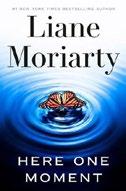
What would you do if you knew when you were going to die?
In the first page and a half of her latest page-turner, bestselling Australian author Moriarty introduces a large cast of fascinating characters, all seated on a flight to Sydney that’s delayed on the tarmac. There’s the “bespectacled hipster” with his arm in a cast; a very pregnant woman; a young mom with a screaming infant and a sweaty toddler; a bride and groom, still in their wedding clothes; a surly 6-year-old forced to miss a laser-tag party; a darling elderly
couple; a chatty tourist pair; several others. No one even notices the elderly woman who will later become a household name as the “Death Lady” until she hops up from her seat and begins to deliver predictions to each of them about the age they’ll be when they die and the cause of their deaths. Age 30, assault, for the hipster. Age 7, drowning, for the baby in arms. Age 43, workplace accident, for a 42-year-old civil engineer. Self-harm, age 28, for the lovely flight attendant, who is that day celebrating her 28th birthday. Over the next 126 chapters (some just a paragraph), you will get to know all these people, and their reactions to the news of their demise, very well. Best of all, you will get to know Cherry Lockwood, the Death Lady, and the life that brought her to this day. Is it true, as she repeatedly intones on the plane, that “fate won’t be fought”? Does this novel support the idea that clairvoyance is real? Does it find a means to logically dismiss the whole thing? Or is it some complex amalgam of these possibilities? Sorry, you won’t find that out here, and in fact not until you’ve turned all 500-plus pages. The story is a brilliant, charming, and invigorating illustration of its closing quote from Elisabeth KüblerRoss (we’re not going to spill that either). A fresh, funny, ambitious, and nuanced take on some of our oldest existential questions. Cannot wait for the TV series.
Kirkus Star
Murakami, Haruki | Trans. by Philip Gabriel | Knopf (432 pp.) | $35.00 Nov. 19, 2024 | 9780593801970
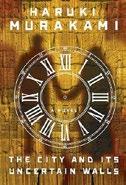
Another beguilingly enigmatic tale from Murakami, complete with jazz, coffee, Borgesian twists, the Beatles, and other trademark motifs. In what is in many ways a bookend to 1Q84, Murakami blends science fiction, gothic novel, noir mystery, horror (think Kiyoshi
Kurosawa’s film Pulse), and coming-of-age story. His protagonist and narrator, as the novel opens, is a 17-year-old boy aswoon in love with a 16-year-old girl. “At that time neither you nor I had names,” he sighs, and when the girl slips away, he knows too little about her to find her. Before that, though, she transports him to a walled city that’s not on any map: “Not everyone can enter. You need special qualifications to do that.” Both of them have those qualifications, the young man filling the urgently needed role of a reader of dusty and long-backlogged dreams. The girl moves on, the boy becomes a middle-aged man, and back in the real world where “silence and nothingness, as always, were my constant companions,” he abandons Tokyo for a little mountain town to become its librarian, curating real books, not dreams. There he encounters two otherworldly characters, one a neurodivergent teen, Yellow Submarine Boy, who memorizes every book he reads, whatever the subject. The other—well, as he explains, “without hesitation, I’d say that although it’s rather dated and convenient, you could call me a ghost.” Both characters point in their own ways to a fleeting world where all that matters, in the end, is love—and where love is always just out of reach. It’s an elegant fable that deftly weaves ordinary reality—“something you have to choose by yourself, out of several possible alternatives”—with a shadow world that is at once eerie and beautiful. Astonishing, puzzling, and hallucinatory as only Murakami can be, and one of his most satisfying tales.
Osman, Richard | Pamela Dorman/ Viking (400 pp.) | $27.00 Sept. 17, 2024 | 9780593653227

another lovable group of unwitting investigators.
The Thursday Murder Club takes a break while British TV personality—and bestselling author—Osman introduces
Amy Wheeler and her father-in-law, Steve, have a special relationship. They talk on the phone every day but in a particularly British way, communicating important things while chatting about the weather. Steve is a former London cop who’s retired to the small town of Axley, and since his wife died he’s retreated into a routine of playing with his cat, Trouble, and attending Quiz Night at the local pub. Amy works as a bodyguard for Maximum Impact Solutions, a private security company, traveling the world and having adventures. Her husband, Adam—Steve’s son—works in finance and also spends most of his time traveling; they view their relationship as a long-term bet and don’t mind not seeing much of each other for now. Things begin to go sideways, though, while Amy is on a private island off the coast of South Carolina guarding Rosie D’Antonio, a Jackie Collinsesque novelist who’s being threatened by a Russian oligarch who took offense at one of her books. The problem is that three other clients of Amy’s firm have been killed in three separate incidents, each murder occurring when Amy was nearby. Is someone sending her a message? Then the only other person on Rosie’s island, an ex–Navy SEAL hired by Amy’s boss to back her up, tries to kill Amy, and the race for answers is on. Amy begins by reaching out to the only person she can trust—Steve. Rosie isn’t going to be left out of the excitement, so, aided by her private jet, the three set off on a journey around the globe as they try to figure out what’s going on while keeping Amy (and Rosie) alive. As in Osman’s other series, they cross paths with a variety of people— including drug-dealing politicians, customs agents, and social media influencers—who may or may not be inclined to help them, and watching the unlikely threesome charm each other and (almost) everyone they meet is a delight.
The mystery isn’t all that mysterious, but Osman fans will be glad to hop on that private jet and go along for the ride.
Pek, Jane | Vintage (416 pp.) | $18.00 paper
Dec. 3, 2024 | 9780593470152
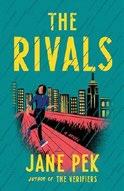
When a client dies unexpectedly, professional verifier Claudia Lin and her business partner explore the possibility that certain dating apps may be offering customers more than they bargained for.
At the beginning of Pek’s excellent follow-up to The Verifiers (2022), Claudia—murder-mystery maven and committed New York City cyclist—and her business partner, Becks, welcome a new client, Mason Perry. The two women, together with tech superexpert Squirrel, comprise a tiny detective agency, Veracity, that specializes in investigating people on dating apps and discovering whether they’re telling the truth about themselves. Perry—“projecting a forcefield of confidence that a ballistic missile would bounce right off of” while being illinformed enough not to realize there was a series of Perry Mason books before the TV show—asks them to look into his latest potential date, Amalia Suarez. But faster than you can say “dead client,” the verifiers find themselves investigating the possibility that dating apps are creating manipulated personas for nefarious purposes. Ratcheting up the tension, Claudia’s brother may also be in danger. As Claudia and Becks explore a potential “far-reaching corporate conspiracy to control the hearts and minds of the online public,” Pek has glorious fun with a cornucopia of references to both classic mystery tropes and espionage thrillers. Claudia takes her life guidance directly and very seriously from literature, and may have met her match in Amalia, who wrote a prize-winning college paper comparing Latin American and Japanese magical realism through the fictional detectives of Jorge Luis Borges and Haruki Murakami. Tangling with intriguing techies while juggling challenging family dynamics and
her growing attractions to both Amalia and Becks, Claudia has her hands—and her heart—beyond full.
A keen knowledge of spy thrillers and detective stories fuels Lin’s excellent investigation into matchmaking apps.
Powers, Richard | Norton (400 pp.) | $29.99 Sept. 24, 2024 | 9781324086031

A story of friendship, technology, oceans, and a small island. Powers juggled nine lead characters in The Overstory (2018), his Pulitzer Prize–winning novel. Here he wrangles just four, but the result is almost as complicated. Two nerdish boys, Rafi Young and Todd Keane, bond in high school over chess and Go. In college, Rafi falls in love with Ina Aroita, a Hawaii-born Navy brat whose mother is Tahitian. The men fall out shortly after brainstorming over Todd’s idea for a computer game called Playground. This strand of the novel is told in retrospect by Todd at age 57, addressing an unidentified “you,” after he receives a diagnosis of dementia with Lewy bodies; he’s an unreliable narrator in more than one way. Interspersed are scenes in later years on the French Polynesian island of Makatea, scarred by phosphate mining and down to a population of 82, including Rafi and Ina and the novel’s fourth lead, an elderly Canadian scuba diver named Evelyne Beaulieu. Her lifelong love of the diversity and preciousness of aquatic life provides the book’s other narrative strand and its environmental theme. Through Todd, Powers sketches the computer and social media revolutions, from early coding to gaming to AI. The counterpoint to this high-tech history is Makatea, a paradise lost to industrial mining that decades later must decide whether to accept a consortium’s lucrative proposal to use the island to build floating autonomous cities. This is a challenging novel, fragmented but
compelling, with fine writing on friendship and its loss and on the awe and delight the ocean inspires. Along with its environmental warnings, the book carries an intriguing look at the ways people and animals play, as in the boys’ competitive chess, the antics of manta rays, the allure of computer games, and what a metaminded author might do with his readers. An engaging, eloquent message for this fragile planet.
Price, Richard | Farrar, Straus and Giroux (352 pp.) | $29.00
Nov. 12, 2024 | 9780374168155
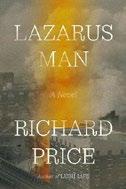
A group portrait of Harlem residents in the aftermath of a five-story tenement collapse in 2008 that mysteriously changes the life of a survivor.
Thirty-six hours after the event, workers pull from the rubble 42-year-old Anthony Carter, an unemployed biracial schoolteacher and recovering coke addict. In the days—and daze—that follows, he doesn’t find religion as much as it finds him in the form of a female prophet. Targeting him with her “raging aviary of disembodied howls and shouts,” she helps transform him into an unlikely motivational speaker and media star. But close observers, including young freelance photographer Felix Pearl, find something a bit off about Carter’s inspirational words, like he was “trying and failing to hold on to a rapidly dissolving fragment of a dream.” Police detective Mary Roe, who barely survived a calamitous elevator accident and is now obsessed with finding a missing survivor of the tenement collapse, doesn’t know what to make of Carter. And postal worker Anne Collins, who is instantly drawn to him after they lock gazes across an outdoor event, flees the relationship just as quickly. Price’s first novel since The Whites (2015)—a work of crime fiction written under the pen name
Harry Brandt—shows off his usual mastery of urban life, including what a community activist calls “our Deathstyle,” embodied in the unforgettable image of a kid who “was eating Chinese right before he was shot and the pellets blew the white rice right out through his back.” But the author is mostly in a kinder and gentler mode, affectingly capturing the complicated domestic lives that help people cope in difficult times. For all the darkness in the novel with its 9/11 overtones, there’s a sense of transcendence in the Harlem community’s shared experience and survivors’ spirit.
An affecting novel by a literary urbanologist in top form.
Rooney, Sally | Farrar, Straus and Giroux (464 pp.) | $29.00 Sept. 24, 2024 | 9780374602635

Two brothers— one a lawyer, one a chess prodigy—work through the death of their father, their complicated romantic lives, and their even more tangled relationship with each other.
Ten years separate the Koubek brothers. In his early 30s, Peter has turned his past as a university debating champ into a career as a progressive lawyer in Dublin. Ivan is just out of college, struggling to make ends meet through freelance data analysis and reckoning with his recent free fall in the world chess rankings. When their father dies of cancer, the cracks in the brothers’ relationship widen. “Complete oddball” Ivan falls in love with an older woman, an arts center employee, which freaks Peter out. Peter juggles two
women at once: free-spirited college student Naomi and his ex-girlfriend Sylvia, whose life has changed drastically since a car accident left her in chronic pain. Emotional chaos abounds. Rooney has struck a satisfying blend of the things she’s best at—sensitively rendered characters, intimacies, consideration of social and philosophical issues—with newer moves. Having the book’s protagonists navigating a familial rather than romantic relationship seems a natural next step for Rooney, with her astutely empathic perception, and the sections from Peter’s point of view show Rooney pushing her style into new territory with clipped, fragmented, almost impressionistic sentences. (Peter on Sylvia: “Must wonder what he’s really here for: repentance, maybe. Bless me for I have. Not like that, he wants to tell her. Why then. Terror of solitude.”) The risk: Peter comes across as a slightly blurry character, even to himself—he’s no match for the indelible Ivan—so readers may find these sections less propulsive at best or over-stylized at worst. Overall, though, the pages still fly; the characters remain reach-out-and-touch-them real. Though not perfect, a clear leap forward for Rooney; her grandmaster status remains intact.
Kirkus Star
Senna, Danzy | Riverhead (288 pp.) $29.00 | Sept. 3, 2024 | 9780593544372

When her second novel hits a wall, a biracial California writer makes a desperate attempt to start a TV career. One of the funniest scenes in
this brilliant, of-the-moment, just really almost perfect book happens early on, in a flashback to the party in Brooklyn where Jane met Lenny, her husband and the father of their two kids. Feeling that she’s aging out of the dating game, Jane has recently consulted an “intuitive psychodynamic counselor with a specialty in racial alchemy,” aka a psychic, who told her she’s about to meet her future husband, a funny, tall, handsome Black man who would be wearing “West Coast shoes.” But when she meets Lenny, who seems to perfectly fit this description, he’s with a very possessive white girlfriend. “Ebony and ivory, together in disharmony...perhaps because it was her origin story, she could not bear the sight of interracial love.” She calls the psychic from the party to confirm. The psychic says it’s definitely him, and then goes into a rant against intermarriage. “Listen, our ancestors didn’t survive the horrors of the Middle Passage so some Caucasoid poet could miscegenate us out of existence.” He also says that if she doesn’t get this guy, she’ll be alone for 24 years. That gets her moving. And since Senna is married to the writer Percival Everett, it’s kind of fun to imagine that this intellectual, anticapitalist, abstract visual artist husband is sort of...yeah. But that’s just one of the great things. The rant about teaching Gen Z versus millennial college students is sure to kill any college professor (“She had in recent years begun to assign only minimalist autofiction by queer POC authors to her undergraduates, and she had to admit it was a better classroom experience for all”), and the story of Jane’s doomed second novel, an opus on biracial characters in history that she’s spent 10 years writing, is literary satire par excellence, like R.F. Kuang’s Yellowface or Everett’s Erasure. Anyone who’s ever been obsessed with a Hanna Andersson catalog: You are also the target market. The only reason we said “almost perfect” earlier is that there’s a big plot twist that doesn’t quite compute, but if you care, that makes one of us.
That’s entertainment.
Kirkus Star
Solomon, Rivers | MCD/Farrar, Straus and Giroux (304 pp.) | $28.00 Oct. 1, 2024 | 9780374607135

A family tragedy occasions this startling reimag ination of the hauntedhouse genre. Ezri Maxwell and their sisters, Eve and Emmanuelle, have begun receiving increasingly alarming texts from their mother. Or, rather, someone claiming to be their mother. When Ezri was a teen, admission to Oxford University granted them—Black, nonbinary, and neurodivergent—the ideal escape from the hostile, entirely white gated community outside of Dallas in which their parents, seeking upward mobility, made a home. Ezri’s childhood was haunted by frightening, unexplainable occurrences for which they were often blamed, and they’ve been estranged from their parents since leaving home. The siblings have suspected for years that something dark, supernatural, haunts the rooms of 677 Acacia Drive. Yet their parents—unyielding, clinging to their upper-middle-class life—have refused to budge. When communication abruptly stops between their sisters and parents, Ezri must return to Dallas with their daughter, Elijah, in tow. After nearly two decades, Ezri revisits 677, where they find both parents dead. Though the local police report that the Maxwells planned a murder-suicide, the siblings are far from convinced. They can’t agree, however, on whether their parents were killed by supernatural forces or not. In evocative prose, Solomon harnesses and recasts classic horror tropes to tell an original story of race and class, family, trauma, and grief. Each character—including the parents— is finely rendered, with the dynamic among the siblings illustrating the ways loyalties shift and change, in constant renegotiation, and dramatizing the ruptures activated by traumatic events. The novel’s construction is elliptical, with past and present alternating from chapter
to chapter. Most are narrated by Ezri, with a few shifts in perspective. While this may throw some readers off, the twists and turns are carefully drawn, with the tension mounting toward a shocking end. Readers should be aware that the novel features themes of grooming and child sex abuse, and Solomon is thoughtful in their treatment of these heavy issues. With this exhilarating and unforgettable work, Solomon proves to be a formidable writer.
Kirkus Star
Tchaikovsky, Adrian | Orbit (416 pp.) | $19.99 paper | Sept. 17, 2024 | 9780316578974

A dissident is condemned to dangerous work on a distant world containing mysterious ruins from a vanished alien society. Professor Arton Daghdev’s xenobiology research violates the orthodox principles of the governing Mandate, which dictates that science must support the idea that humans are the pinnacle of all evolution, everywhere. He’s also been secretly dabbling in more direct revolution—or at least, talking about it—but the authorities don’t know that. For his academic trespasses, he’s shipped off to serve as convict labor on the planet Kiln, where ancient ruins suggest there was once an intelligent race. His job is to find the remains of this race and furnish evidence of just how much like humanity it was. Instead, he discovers a world full of metaspecies—communities of symbiotes who have united into single organisms— and a sullen population of convicts who cannot trust each other enough to pull off a successful uprising against the sadistic commandant and brutal guards. The symbiotes of Kiln seem anxious to add humans to their collection; unfortunately, such attempts usually lead to madness and/or death for the human. But a catastrophic encounter with one such group of life-forms provides Arton and his
fellows with both insight into the race of the builders and a possible way of winning liberation. The biological puzzle of life on Kiln depicted here is fascinating, reminiscent of biologist/SF author Joan Slonczewski’s The Children Star (1998). The biological aspect of the story is a tool to support Tchaikovsky’s primary message, which is a vivid illustration of how suspicion can undermine both an authoritarian regime and any potential resistance to that regime. In this novel, a lack of honesty and poor communication can literally kill. But at the same time, all talk and no action is no path to success, either.
A savagely satirical take on the consequences of repressive doctrine and the power of collective action.
Tokarczuk, Olga | Trans. by Antonia Lloyd-Jones | Riverhead (320 pp.) $30.00 | Sept. 24, 2024 | 9780593712948

In a work that harks back to The Magic Mountain , a young Pole seeks treatment for tuberculosis. In the latest from Nobel Prize–winner Tokarczuk, a young man suffering from tuberculosis seeks respite for his illness at a sanatorium in the Silesian mountains. When Mieczysław Wojnicz finds the resort itself full, he rents a room at the Guesthouse for Gentlemen, a small inn owned by Wilhelm Opitz, where, almost immediately, strange things start to happen: For one thing, Wojnicz starts hearing a cooing sound that seems to emanate from the attic; for another, the local herbal liqueur the men drink in the evenings might be affecting them in not-entirely-natural ways. But the main thrust of this novel, which repeatedly calls to mind Thomas Mann’s Magic Mountain, with which it shares a time period and setting, appears to be located in the debates that spring up between the men at
the guesthouse, though Wojnicz rarely participates. “The subjects recurred, vanished and returned,” Tokarczuk writes. “Does man have a soul? Does he always act selfishly? Monarchy or democracy? Is socialism an opportunity for mankind? Can one tell whether a text was written by a man or a woman? Are women responsible enough to be allowed voting rights?”
This is the direction in which the debates inevitably lead: the differences between men and women, and the ultimate, inevitable inferiority of women. The book, which is notably lacking in female characters, returns to this topic again and again, in increasingly subtle ways. But gender is just one of the mysteries at play here. Why won’t Wojnicz undress for the doctor? Why does another patient keep warning Wojnicz about violent deaths that supposedly occur at the sanatorium each year? Tokarczuk’s latest work reckons with some of the major intellectual questions of the 20th century while simultaneously spinning a mysterious—and spooky— web of intrigue and suspense.
A crucial addition to Tokarczuk’s oeuvre.
Tulathimutte, Tony | Morrow/ HarperCollins (272 pp.) | $28.00 Sept. 17, 2024 | 9780063337879

Rejection alters the course of reality for the characters in this memorable novel-in-stories.
Tulathimutte’s innovative collection features seven interconnected stories all dealing with rejection in one way or another. Contextualizing the whole collection, the opening story, “The Feminist,” follows a self-proclaimed feminist man over decades as he gathers his “thickening dossier of unfairness.” In “Pics,” Alison, a woman in her late 20s, becomes unintentionally obsessed with a longtime friend with whom she’s had a one-time fling. In between stalking him on social media, crafting apology emails,
adopting a unique and questionable pet, and considering starting a podcast, she texts her friends from a former internship; the group chat—full of sexual puns, therapy-speak, comedic bits, and emojis—shows the full extent of Alison’s spiral. In “Our Dope Future,” a homeschooled “serial entrepreneur, inventor, and futurist” writes a Reddit post from hell; using co-opted slang, the narrator slowly reveals the lengths he’s willing to go to firm up his romantic and domestic future. Tulathimutte is unafraid to write the most disturbing, disgusting, and delightfully deranged things. Each time you think the characters have hit rock bottom, they pull out a shovel and start digging more. Some have a stunning lack of self-awareness, while others are too aware to function. They all, however, seem to be bottomless pits of want and desire and vulnerability. Their need for approval, acceptance, relevancy, and even chaos is so intense that it can feel nauseating at times. Tulathimutte’s writing is not only smart, but laugh-outloud funny. In “Ahegao, or, The Ballad of Sexual Repression,” the newly out narrator tries to explain the vanilla version of his sexual desires to his boyfriend—and his boyfriend cracks an incredible Stanley Kubrick sex joke. The characters, ideas, and symbols echo across the stories, and these metatextual layers—along with the layers of internet lore and memes—create a hilariously brazen and existentially unsettling portrait of modern life, love, and identity. An inventive and shameless story collection for the chronically online.
VanderMeer, Jeff | MCD/Farrar, Straus and Giroux (528 pp.) | $29.00 Oct. 22, 2024 | 9780374616595

VanderMeer extends his Southern Reach trilogy with a deeper exploration of worlds both creepy and bureaucratic. The charm (and frustration)
of VanderMeer’s epic saga about the mysterious Area X is how much information is withheld, making the reader unsure of where they stand until the story explodes into uncanny and horrifying terrain. In that regard, the fourth entry in the series sticks to type, roughly focused on events preceding and following the earlier books. The opening sections concern Old Jim, a Central investigator researching the first expeditions by biologists into the Forgotten Coast, which involved the introduction of alligators and unsettling encounters with the rabbits first met in Authority (2014), as well as a mysterious Rogue that may be working in league with a particularly aggressive alligator nicknamed the Tyrant. Later chapters focus on Lowry, an investigator on a later expedition into the region, observing his colleagues’ numbers rapidly whittled down as the malevolent Tyrant emerges. Lowry is profane— few books published in the past 10 years have a higher f-bomb-to-page ratio—and highly drugged, elements that enliven the story in two ways. They convey the contempt and frustration with institutions that have been a hallmark of the Southern Reach series; more ingeniously, they underscore the latter chapters’ surrealistic, psychedelic brand of horror, which helps sell some more grotesque incidents Lowry becomes a part of. Indeed, Lowry’s sections feature some of the most vivid writing in the entire series, sinuous and delightfully weird. Does VanderMeer resolve lingering questions from the previous novels? Not really. But the main theme of the trilogy was always unknowability—untrustworthy leaders, reckless wildlife, and complicated humans are his constant focus, and here he cannily balances the strangeness with the terror of confronting it. And it’s fair to suspect the terror will go on: As he writes, “Nothing in the end could placate Area X.”
An extension of a genre-busting narrative, maintaining and complicating its vibes.



LUIS JARAMILLO
Author of The Witches of El Paso
LUIS JARAMILLO IS an assistant professor of creative writing at the New School in New York City and the author of the short story collection The Doctor’s Wife. His first novel, The Witches of El Paso (Primero Sueño Press/Atria, Oct. 8), explores family secrets and the supernatural along the U.S.-Mexico border. In a starred review, a critic for Kirkus calls the book “gripping and cinematic.” Jaramillo answered these questions via email, and the responses below have been edited for length and clarity.
Where and when did you write the book? Describe the scene for us. I write in the early morning, sitting on my couch with my back against the armrest and my legs stretched in front of me. It’s a supremely lazy position, but one that provides maximum support for my body and spirit.
What was most challenging about writing The Witches of El Paso? And most rewarding?


The dreaded elevator pitch: What, briefly, is The Witches of El Paso about?
As the novel begins, labor lawyer Marta is juggling work, motherhood, and the care of her very old great aunt, Nena, who claims she can talk to the dead. After a kitchen fire with strange origins, Nena begins to tell Marta the great secret of her life— that when she was 18, she was taken hundreds of years into the past, away from the El Paso of the 1940s to El Paso del Norte, where Nena falls deeply in love, becoming pregnant. A skeptical Marta is drawn into Nena’s quest to find the daughter she left in colonial Mexico. Along the way, Marta awakens to her own supernatural powers and the possibility of a world where the border between life and death is as porous as the border between countries.
I’ve come to accept that I’m a slow writer, that it takes a long time for the thing to take the right shape. It sucks to have to be patient. At the same time, I love having a project. There’s nothing better than playing around with language, trying to translate the language of the heart into prose. I also had such fun talking to relatives about El Paso and New Mexico, and I heard some wild stories, some of which I fit into the novel.
Will you be touring or doing events for the book this fall? Any you are especially looking forward to? Why?
I’ll have events in New York, Chapel Hill, El Paso, Austin, San Francisco, Los Angeles, and Portland. My book launch will be at Books Are Magic in Brooklyn. New York raised me as a writer, and I’m really looking forward to celebrating the birth of this novel with friends and mentors who have helped me and this book. I’ve taught many students at the New School, and they’ve also been

The Witches of El Paso Jaramillo, Luis Primero Sueño Press/Atria | 274 pp. $27.99 | Oct. 8, 2024 | 9781668033210
with me, teaching me about persistence and bravery.
What fall release(s) are you most eager to get your hands on?
I can’t wait to read Lena Valencia’s book of short stories, Mystery Lights. Graywolf is publishing a translation of Yuri Herrera’s Season of the Swamp, about Benito Juárez’s lost years in New Orleans. The great Abigail Thomas is publishing a memoir, Still Life at Eighty, that will be moving, funny, and full of wisdom.
Interview by Nina Palattella.

The presidential election season often feels like a slow time for fiction releases— but there are enough exciting books coming out this fall to keep even the most voracious reader busy. Here are the opening lines of Entitlement (Riverhead, Sept. 17), Rumaan Alam’s first novel since Leave the World Behind (2020): “It was a strange, sultry summer, the summer of the Subway Pricker, but Brooke Orr had decided not to let that interfere with the business of life in New York.” The Subway Pricker! You can feel the dread radiating off the
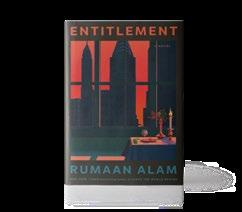

page. Brooke is a Black woman who works for a white billionaire’s charitable foundation and finds her ambition growing to match her surroundings. Our starred review says this book “cements Alam’s status as a talented truth-teller willing to tackle tough issues with grace, generosity, and sensitivity.”
With We Solve Murders (Pamela Dorman/Viking, Sept. 17), Richard Osman gives the elderly sleuths of the Thursday Murder Club books a rest only to introduce a new elderly sleuth, retired London cop Steve Wheeler, along with his daughter-in-law, Amy, a



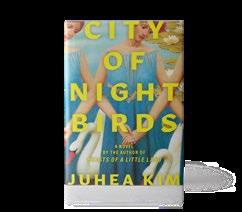
bodyguard for a private security company. Amy’s protecting glitzy novelist Rosie D’Antonio when she realizes that someone is trying to kill her—kill Amy, that is. “Osman fans will be glad to hop on [Rosie’s] private jet and go along for the ride,” according to our starred review.
After the 2021 English translation of The Books of Jacob, Nobel laureate Olga Tokarczuk returns with The Empusium: A Health Resort Horror Story, translated by Antonia Lloyd-Jones (Riverhead, Sept. 24). It’s a much slimmer book than both its predecessor and Thomas Mann’s The Magic Mountain, similarly set at a tuberculosis sanitorium. The guests, all gentlemen, debate the issues of the day, including the relative value of men and women. Our starred review says Tokarczuk “reckons with some of the major intellectual questions of the 20th century while simultaneously spinning a mysterious—and spooky— web of intrigue and suspense.”
Our starred review calls Rivers Solomon’s Model Home (MCD/Farrar, Straus and Giroux, Oct. 1) a “startling reimagination of the haunted-house genre.” Black, nonbinary Ezri Maxwell has gotten as far as they can from their upbringing in a white community near Dallas,
where their parents were cold and their house was— haunted? Now their sisters insist something’s wrong, and they all converge on their childhood home to find their parents dead. “Solomon harnesses and recasts classic horror tropes to tell an original story of race and class, family, trauma, and grief,” says our starred review.
Louise Erdrich continues her string of extraordinary novels with The Mighty Red (Harper, Oct. 1), set in a sugar beet–growing community in North Dakota. There’s a love triangle among high school students aiming for marriage, an intense mother-daughter relationship, and an entire town dealing with the impact of a catastrophic accident. Erdrich’s “writing feels both effortless and wise,” according to our starred review.
Juhea Kim’s first novel, Beasts of a Little Land (2021), was an epic story of 20th-century Korea. Her second, City of Night Birds (Ecco, Nov. 26), goes in a completely new direction, focusing on the world of contemporary Russian ballet and featuring ambition, love, injury, pain, celebrity, and even a subplot about the invasion of Ukraine. Our starred review calls it “another brilliant page-turner.”
Laurie Muchnick is the fiction editor.
An insurance salesman learns that he’s predisposed to murder in this comic novel.
Brock Hobson doesn’t mind being, as his daughter says, “as predictable as a metronome.” He works as an insurance salesman in Kingsboro, Ohio, a town where “a third of the town has a drinking problem, and another third is on meth and/or Oxy,” and volunteers as a Sunday school teacher, spending evenings with his girlfriend, Trey, and his two teenage children, Joe and Lena. (Their mother, Cheryl, lives with her new beau, Burt, a doltish subcontractor whom Brock notes “fits quite comfortably into the Mr. Asshole category.”) When Brock goes to a doctor complaining of a pain in his side, the
physician convinces him to take a blood test invented by a company called Generomics that “predicts behavior, tells you what you’re going to do before you do it, based on the… arrangements in your genetic structure, your psychology, and your past and your what-have-you.” Brock, an upstanding citizen whose only bad habit is correcting other people’s grammar, is surprised when the test reveals that he is “about to embark on a major crime wave.” He fulfills the prophecy—well, kind of—when he confronts Burt after the man calls Joe, who’s gay, a homophobic slur; Burt slips on a banana peel and ends up hospitalized with a grievous injury. Brock, who’s given a gun by Generomics, starts

Baxter, Charles | Pantheon | $28.00 Oct. 22, 2024 | 9780593700853
to realize that the company actually wants him to commit a murder: “It’s in their interests financially for me to shoot somebody.” Baxter’s novel is riotously funny, and much of the humor comes from asides:
A doctor tells Brock, “Anyway, except for the fact that you’re feeling these pains, and you complain that you can’t breathe and you’ve lost
your appetite and there’s a tightness in your chest, and you feel like you’re dying, you’re fine”; in another scene, Brock browses DVDs including Alien vs. Bimbo and Voodoo Chiropractor! At its core, this is a disarmingly sweet novel about family, an entertainment with just the right amount of Midwestern menace. Hilarious and humane.
Akoto, Elom K. | Red Hen Press (264 pp.)
$18.95 paper | Oct. 1, 2024 | 9781636281827

A young Ghanaian immigrant becomes entangled in political intrigue.
Akoto’s novel opens with its protagonist, Kamao, imprisoned in the U.S. and awaiting trial. Precisely how he got there hasn’t yet been revealed, but Akoto notes that he is “the most infamous prisoner in the nation.” From there, the story takes the reader back to find out just how Kamao ended up in that position. He’s born into a prominent family in Ghana and eventually leaves to study in the U.S. There, he takes a job working at a gas station after a thief relieves him of several thousand dollars. While enrolled in college, his knowledge and idealism impress Lindsey, a fellow student who is the daughter of Brad McAdams, a conservative senator with a former Navy SEAL on call for “secret missions.”
Kamao and Lindsey begin a relationship, which infuriates Lindsey’s father and prompts him to offer Kamao a bribe to break up with her. Akoto’s novel sometimes shifts registers; the scenes of Kamao navigating the bureaucracy required to stay in the U.S. and seeking a visa tap into a textured realism, while a subplot about Dania, a young woman fleeing gangs in El Salvador who is abused by politically connected Americans, heads into melodramatic territory. Eventually this novel’s more melodramatic elements advance to the foreground, as the reader learns exactly why Kamao finds himself incarcerated at the beginning of the novel. The tonal shifts can be jarring at times, even as Akoto finds interesting parallels between Kamao’s and Lindsey’s politically connected families. This novel is at its best when it gives its characters space to discuss their ideas, hopes, and dreams.
More successful as a character study than a political thriller.
Bublitz, Jacqueline | Emily Bestler/ Atria (320 pp.) | $18.99 paper Oct. 29, 2024 | 9781982199050

A young woman traumatized by a childhood friend’s murder investigates a similar crime 19 years later.
The true crime–loving amateur detective is everywhere in fiction these days, but New Zealand–born writer Bublitz brings a welcome twist to her version. As in her last novel, Before You Knew My Name (2022), she pushes the boundaries of the genre by adding a supernatural element and a sharp feminist sensibility to this thriller about New York City bartender Ruth-Ann Baker. A college dropout in her mid 20s, Ruth has good reason to be obsessed with true-crime stories: She’s still suffering psychological trauma from the abduction and murder of her best friend, Beth Lovely, when they were both children. Local teacher Ethan Oswald was convicted of the crime and died in prison, but when Ruth learns another girl has vanished from her Connecticut hometown all these years later, she wonders if there could be a connection. Did Oswald have a helper still out there? She sounds out her theories with an unusual cohort: Beth’s ghost and the ghosts of other murdered girls. But Ruth is not the most reliable of narrators, and Bublitz keeps the reader guessing about whether or not these ghostly conversations are all in Ruth’s head. As Ruth embarks on an investigation that will take her around the world and into the lives of three different women with connections to Oswald, she reveals more about her own troubled past. With empathy and insight, Bublitz examines the scars violence leaves on its victims and refutes the idea that some deaths are more tragic than others.
An empathetic psychological thriller with a supernatural twist.
Campbell, Cebo | Simon & Schuster (304 pp.) $27.99 | Sept. 10, 2024 | 9781668034927

A professor and his daughter navigate a new America where all white people have died by suicide.
“They killed themselves,” explains Charlie Brunton, the narrator of Campbell’s high-concept novel. “One morning, every white person in America walked into the nearest body of water and drowned.” Charlie is a Black man who’s served time in prison, wrongfully convicted of rape; after the mass suicide of white people, he became a professor at Howard University, trying to make sense of a country with no real government or systems: “Only a fragile structure remained….” Charlie gets a phone call from his daughter, Sidney, born to the white woman he was accused of raping, asking him to drive her from her home in Wisconsin to Alabama, where she’s heard that some surviving white people are living. Sidney has internalized racism, opining that “the world got left to the heathens” and lamenting her physical similarities to her Black father. Charlie and Sidney enlist the help of a pilot to get them to the South, eventually ending up in Mobile, where they encounter a new society that neither of them expected and learn what was behind the mass suicide of white Americans. Campbell’s novel starts off fairly strong— it’s undoubtedly an interesting thought experiment—but goes off the rails quickly, sunk by the author’s often too-florid prose and unrealistic dialogue. Sidney’s transition from self-hating to enlightened is forced, and aside from the two protagonists, the characters are purely functional. This book reads less like a novel and more like an extended treatment for a television series.
A plodding novel from a talented writer.
A vulnerable, sensual, and joyous journey about living in one’s truth.
Connelly, Michael | Little, Brown (400 pp.)
$27.00 | Oct. 15, 2024 | 9780316563796
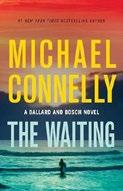
Renée Ballard’s latest outing with the LAPD’s Open-Unsolved Unit begins in the most embarrassing way imaginable before the stakes rise higher and higher. While Ballard is out surfing one morning, someone gets into her car and makes off with her phone, gun, wallet, and badge. Fearing that she’ll get tossed off the unit she loves if word gets out, she doesn’t report the theft, a decision that considerably complicates her ability to do her job. That’s especially awkward because of the cases just over the horizon. Fresh evidence indicates that the Pillowcase Rapist, who murdered his last victim in 2005, may be Superior Court Judge Jonathan Purcell, a man nobody wants to cross. The lifting of Ballard’s stuff fits into a larger pattern of thefts from surfing beaches by a pair of lowlifes who were particularly interested in a police badge this time because the guy they worked for had clients who were planning something big and bad. The biggest case of all is landed by Madeline Bosch, the daughter of Ballard’s retired mentor Harry Bosch, who uncovers a lead in her very first day as a volunteer on the unit that might just close the most famous unsolved case in the history of Los Angeles by identifying the Black Dahlia killer. Everything will work out fine if Ballard can only hold the emerging details about the Pillowcase Rapist close to her chest, keep her fibs about following established procedures
and direct orders from being found out, prevent her boss from tossing Maddie Bosch off the unit when her cold case turns red-hot, and recover her credentials without letting anyone know they’re missing.
A Hawaiian coda provides the best news of all: This distinguished series has plenty of miles to go. Aloha, and hooray.
De Robertis, Caro | Atria (320 pp.)
$28.99 | Aug. 13, 2024 | 9781668035238

A deity and a mortal fall in love in this queer mythology retelling. The latest from Kirkus Prize finalist De Robertis is a gender-bending and feminist retelling of the Greek myth of Psyche and Eros. Psyche, the youngest of three daughters, is wild, loud, and uninterested in taking a suitor. As tales of her beauty spread through the kingdom, crowds of leering men begin to flock to her home to see if the rumors are true: Could Psyche really be more beautiful and interesting than Aphrodite, the goddess of love and beauty? Furious and jealous, Aphrodite asks her daughter Eros, who reigns over love and desire, to destroy Psyche. As a devastating drought plagues the land, Psyche’s father gives her up to her fate by tying her to a cliff so her “monstrous” marriage can begin. Instead, Psyche is carried to a palace beyond her wildest dreams. Created by Eros, who has fallen for this human girl, the beautiful and bountiful home is shrouded in
secrecy from gods, goddesses, and humans alike. Within the palace, they can be together—as husband and wife (or something in between)—just so long as they are always cloaked in total darkness. As Psyche realizes all the ways her dream home still falls short, she makes a decision that changes the trajectory of their lives—and the mythical world—forever. The novel deftly explores gender and power dynamics within and between the mythical and mortal realms. As Eros describes how their love is dangerous because of their rule bending, Psyche realizes that “cages” can and do “apply to women and goddesses alike.”
Though the pacing suffers at times under the weight of the subverted mythology, De Robertis’ prose is as sharp and beautiful as ever. Their meditations on gender, desire, and freedom soar off the page. The author’s retelling provides a space to dream of a world where those “born perfect yet outside the rules” of their time may find ways to step out of the shadows and into the light.
A vulnerable, sensual, and joyous journey about living and loving in one’s truth.
Despentes, Virginie | Trans. by Frank Wynne | Farrar, Straus and Giroux (304 pp.)
$28.00 | Sept. 10, 2024 | 9780374611613

A provocative French writer and filmmaker explores #MeToo, the fate of aging actresses, and addiction.
“Dude, screw your apologies, screw your monologue, screw everything: there’s nothing about you that interests me.”
This is the opening line of Rebecca Latté’s email response to Oscar Jayack, a novelist who’s trying to apologize for a (since deleted) post in which he excoriated her for no longer being the same person—the same body—that boys like him once fantasized about.
Despite her claim that Oscar is boring, Rebecca continues to reply to his emails, and the two develop a relationship that is vital to both of them and shaped not just by their shared working-class childhood, but also by the fact that Oscar’s older sister was Rebecca’s best friend back in the 1980s. There is a third party in this story: Zoé Katana, a feminist blogger who has publicly accused Oscar of sexually harassing her while she was assigned by his publisher to work as his publicist. This is an epistolary novel shaped by contemporary modes of communication, but it’s still an epistolary novel, which is not a forgiving form—or even a believable form, much of the time. Opinions about whether or not Despentes pulls this off depend largely on how much the reader enjoys listening to three hyperverbal, theory-inclined people talk to and at and over each other. That said, Despentes gives readers plenty of reason to stick around, beginning with Rebecca’s refusal to put up with Oscar’s shit. His response to being canceled after he’s outed as a sex pest is predictably self-serving, and his new confidante will have none of it. At the same time, Rebecca comes to see Oscar as a role model in sobriety. Meanwhile, she serendipitously connects with Zoé while Paris is locked down because of Covid-19, which complicates her relationship with Oscar. What makes this novel work as a novel—rather than a collection of rants presented as a novel—is that Rebecca, Oscar, and Zoé come across as real people and their interactions with each other manifestly change them.
Confrontational and often abstract, but grounded in real human emotion and experience.
Enríquez, Mariana | Trans. by Megan McDowell | Hogarth (272 pp.) | $28.00 Sept. 17, 2024 | 9780593733257

A dozen pitchblack Argentinean stories laced with body horror, selfincrimination, and existential dread.
Enríquez’s Our Share of Night (2023) earned her a prominent place among innovative South American writers, and the stories here deliver the same squelchy charms. The stories, mostly from the POV of women, offer some new perspectives in an already rich genre, while the horrors within range from pedestrian to Lovecraftian to surprisingly equal effect. Opening with a ghost epidemic and closing with dead-eyed children, in between Enríquez examines the human condition through a spattered lens of body horror and grotesque surrealism. Following the ethereal “My Sad Dead” and its portrayal of a lonely doctor looking after lost souls, things tend to bounce back and forth between the ordinary and the phantasmagoric. In the first of many everyday nightmares, the title tale tackles the story of Elisa Lam, a Canadian student whose body was discovered in a water tank on the roof of the Cecil Hotel in Los Angeles circa 2013. Twisting a real-life tragedy into a mystery involving suicide and a death cult only makes it that much worse. Some entries are more notion than narrative—“Face of Disgrace” extends the concept of faceless victims to its literal conclusion, while “Night Birds” and “Metamorphosis” both twist Kafka’s themes of transformation to their own
purposes. “Hyena Hymns” takes the form of a ghost story of sorts, unearthing eerie imagery from the ruins of a wealthy landowner’s domestic zoo. Ironically, the stories are much more devastating when they don’t delve into the supernatural. Two childhood friends are marked by a game gone awry in “The Refrigerator Cemetery,” giving off vibes from Stephen King’s short story “The Body.” Meanwhile, a search for dresses results in unexpected self-discovery in “Different Colors Made of Tears,” and a painter’s obsession spirals into madness in “A Local Artist.”
An uneven collection that nonetheless solidifies Enríquez’s reputation as a purveyor of haunting and thoughtprovoking tales.
Fawkes, Jen | Overlook (288 pp.)
$27.00 | July 9, 2024 | 9781419772474

In 1862, Sylvie Swift leaves the Kentucky farm where she was raised with her twin brother, Silas, for Nashville, where her life takes an otherworldly turn. Following her older sister Marina’s abrupt departure years before and Silas’ decision to join the Confederate army, Sylvie finds herself alone. When an obscure play called Apocrypha mysteriously shows up on her doorstep, she begins translating it from ancient Greek. As the project develops, she begins to feel compelled to track down the anonymous sender of the script. Her instinct takes her to Nashville, which is entirely different from her bucolic home. Against the backdrop of a city struggling to control a syphilis outbreak, feed the poor, and fund the Civil War, Sylvie meets Evangeline Price, the proprietor of a brothel whose clientele includes politicians, military officers, and high-society gentlemen—and who has a curious connection to Marina. Eventually it becomes clear that there’s far more going on at Evangeline’s establishment—and,
indeed, in Nashville—than it appears. As Sylvie’s translation takes shape with the help of Evangeline’s multitalented workforce, she begins to make connections between the Ephesus of the play (inspired by Aristophanes’ Lysistrata) and the Nashville underworld she becomes increasingly tangled up in—finding parallels between the Greek women (mortals and gods alike) seeking to undermine the male violence surrounding them and the women of the American South. Based on the true story of Nashville’s attempt to exile its prostitutes during the Civil War, Fawkes’ novel layers found texts—including journal entries, letters, and play scenes— to create an enchanting, immersive narrative interweaving the everyday with the fantastical and Civil War history with Greek mythology. She prompts us to question familiar notions of history and reminds us of the quiet, adaptable power of women through the ages. Sylvie learns the often-dangerous ancient ways of female rebellion but is preoccupied not by the peril of her situation, but by the absence of Marina, whose presence she feels everywhere. A riot of lust, secrets, gods, and mythical creatures make this a thoroughly entertaining novel, rich in detail and lavish prose. Fawkes shines a light on women troublemakers through time in this dazzling feminist tale.
Kirkus Star Syndicate
Francis, Felix | Crooked Lane (256 pp.)
$29.99 | Sept. 10, 2024 | 9781639108596
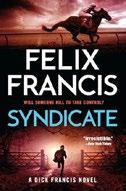
Life isn’t safe even for a syndicate manager in the upper echelon of British horse racing. Chester Newton is worried how Potassium, the current star of his syndicate, Victrix Racing, will run in the Epsom Derby. When Potassium wins by a nose, Chester breathes a sigh of relief and turns to the party planned for the
25th anniversary of his wedding to Georgina; the 21st birthday of their son, James; and the 19th birthday of their daughter, Amanda. That’s where signs of trouble pop up. Darren Williamson, the undesirable older boyfriend Amanda’s brought to the party, reports that she’s gone missing after a row, and DS Christine Royle, of the Thames Valley Police, doesn’t share Chester’s anxiety about her return. Royle turns out to be right, sort of, since Amanda is shortly found doped with ketamine, unable to remember anything about how she disappeared. The punchline—a phone call from an anonymous person with a squeaky voice who points out how easy it would be to snatch Amanda again—sets the plot in motion, as Squeaky Voice repeatedly calls Chester to demand that several of Victrix’s favorites, including Potassium, lose their races. Chester can’t figure out what the motive for these calls is, who’s behind them, whether he should do their bidding, or how he can fix the races if he decides to give in. His nondecision to play it by ear, taking each threat as it comes, and his seduction by younger American Toni Beckett make each step in the story less predictable, and the customary insider details about the racing scene set up the denouement with commendable precision. Perhaps the strongest installment of this venerable franchise since Francis took the reins from his jockey father.
Kirkus Star
Fresán, Rodrigo | Trans. by Will Vanderhyden Open Letter (360 pp.) | $17.95 paper Oct. 8, 2024 | 9781960385161

A brilliant evocation, by Argentinian novelist Fresán, of the star-crossed family history of a canonical American writer.
“Call me Herman.” Such a commandment could come from only one writer, Herman Melville,
who stands at the center of Fresán’s narrative. Occupying much of that space, too, albeit in sometimes spectral form, is Melville’s father, Allan Melvill (the -e a typo that his son, the victim of a bureaucrat’s pen, stuck with, even as, later in the novel, he notes ruefully that his obituary in Harper’s Monthly Magazine, where several of his stories appeared, will render his name as Henry). Allan, born to a Scottish family famed for “swords and shields and maces brandished in the name of savage monarchs whose castles were just giant stones,” is frequently revisited at a climacteric moment, when, desperately poor, he walks across an iced-over Hudson River to return to his starving family. It’s an image that haunts the grown-up Herman, who, Fresán conjectures, cast his father as a confidence man on a paddle wheeler, a lowly sailor on a whaling ship, an indifferent clerk who refuses to do his job. “It turns out to be almost as exhausting and distressing to trace his downward spiral as, I suppose, it was for my father to know himself pursued and persecuted,” Herman sighs. Fresán imagines Melville’s life as a quiet repudiation of his father’s, who was so proud that he refused to allow his wife, Herman’s mother, to borrow money from her aristocratic family. In the end, though, Allan accompanies his son’s every waking moment and haunts his dreams:
“The ice is the unknown,” Herman, that great explorer of mysterious places and mores, says. Fresán’s fictional evocation of Melville’s youth is as convincingly realized as Frederick Busch’s The Night Inspector (2000), which neatly bookends it.
An elegant, meditative story about storytelling—for lives are, Fresán writes, “really, books of stories.”

Kirkus Star
Glass, Ava | Bantam (320 pp.) | $18.00 paper Sept. 3, 2024 | 9780593972212

Third in a fast-moving British spy series featuring a woman in MI6.
The G7 meets in Scotland in a few days, and the prime minister’s office is “terrified that something is going to go wrong with the gathering.” MI6, the secret intelligence service, learns that a Russian assassin plans to murder a head of state there. But who’s the killer? Who’s the target? And what’s to be done about it? MI6 assigns Emma Makepeace to prevent disaster. Against her wishes, she’s partnered with homicide detective Kate Mackenzie. But their chemistry works. They make an effective team, with Emma (not her real name) as the leader. They start by looking into a Russian émigré named Nick Orlov, whom they see talking on his cell phone, flatly refusing to do something. He’s visibly frightened, so Emma approaches him on a ruse and begins wheedling her way into his confidence. Soon she agrees to his dinner invitation, and—well, she’s never seduced anyone before, but it may be necessary to set a honey trap in service of king and country. Bond—James Bond— wouldn’t have thought twice, of course, that martini-drinking alley cat. Speaking of whom, not since 007 has there been such a worthy spy as Emma Makepeace. She’s tough and smart and has a particular talent for faking emotion. “Being able to cry on cue is a vastly underrated skill,” she notes, and she uses it when she’s in a tight spot with Orlov. The latter’s enemies are setting him up, luring him into their own trap. She wants to get him out of it, both because it’s her job and because she’s come to like the guy.
And she has other quirks: “Some people meditate to deal with stress. Emma picked locks.” Fans of Ian Fleming’s work are sure to enjoy Emma Makepeace. No, she isn’t a Bond clone, although they could be cousins. Near the culmination of a bloody fight with a mortal enemy, she declares, “His Majesty says hello.” How very British. Raise the Union Jack for Emma Makepeace!
Grant, Linda | SJP Lit/Zando (288 pp.)
$28.00 | Oct. 1, 2024 | 9781638931683

In this offbeat historical epic, a prosperous Jewish family from Latvia reinvents itself when it’s divided by 20th-century realities and differing dreams of success.
The catalyst for the Mendel family’s uprooting is an encounter 14-year-old Mina has in the woods, where she goes to gather mushrooms. In fairy tale–like fashion, she encounters instant danger in the form of a group of Bolshevik boys whose cocky presence excites her. After her older brother Jossel learns that she kissed one of them, he whisks her away from Riga, leaving the rest of their family behind, to keep their father from forcing Mina into an arranged marriage. Jossel and Mina hope to go to America, but after World War I thwarts those plans, they settle in a mostly friendly Jewish community in Liverpool, by which time Jossel has been roped into marriage by a
woman he met on the ship that took them there. Soon enough, Jossel leaves his wife for another woman, and lonely Mina impetuously marries a bland fellow whose life her brother saved while off fighting the war. We then follow Mina’s daughter, Paula, as she attempts to hide her Jewish identity, act like a privileged Brit, and lose her virginity. Only belatedly, we learn what became of Mina and Jossel’s bad-sheep brother, Itzik, who embraced the USSR in his quest for power, and their ill-fated parents. Shifting styles to reflect shifting times, Grant flirts with soap opera and R-rated noir. Acting as a leitmotif, the story of Mina’s adventures in the forest gets passed down as oral history, ultimately becoming a movie. Those looking for romance in this saga, or much in the way of reflection as the nonstop narrative motors on, will be disappointed. But the undercurrent of menace and refusal to indulge in sentimentality should appeal to readers looking for something different. A novel that makes up for its lack of depth with sharp storytelling.
Greathead, Kate | Henry Holt (272 pp.)
$28.99 | Oct. 8, 2024 | 9781250351029

A novel about the fragility of millennial masculinity. Greathead’s novel chronicles the eponymous George’s life from childhood to early middle age. The book begins with George’s
A novel about the fragility of millennial masculinity.
THE BOOK OF GEORGE
mother criticizing his father’s spending habits at 12-year-old George’s graduation from a drug-abuse-resistance program. George is aware of his father’s financial shortcomings as well as his mother’s contempt. While he watches Jackass with his sister, he can’t help but feel “implicated in his mother’s disgust with lowbrow contemporary culture, as though he were somehow responsible for it by being a member of the generation it was directed toward.” This disgust for lowbrow culture is also a disgust for performances of masculinity that are neither nice nor successful. When his father dies a few years later of a stroke, George is suspicious of people who exude naïveté or optimism. “Their cheery innocence,” he reflects, “was like an abrasive on a wound.” As George comes of age, he develops an on-again, off-again relationship with a woman named Jenny, who loves him openly, though he will not, at first, say it back. He exhibits outbursts of anger and is so critical of others that Jenny tells him, “Some people go through life trying to build others up….You like to poke holes.” Though George can be unlikable, he is self-aware. “George had been feeling like a loser recently,” Greathead writes toward the end, though he’s been behaving like one for some time. Ultimately, it’s unclear what George wants out of life or how he plans to succeed without leaning on his girlfriend, sister, or mother financially and emotionally. Greathead’s portrayal of an aggrieved white man struggling to find his place in the world is as much a portrait of an unsuccessful artist as a young man as it is a portrait of our times.
A mordantly wry examination of one disgruntled man’s life.

Harris, Robert | Harper/HarperCollins (304 pp.) $30.00 | Sept. 17, 2024 | 9780063248052

A World War I novel of love, politics, and a continent gone mad.
In 1914, British prime minister H.H. Asquith, a 61-year-old married man, carries on an affair with 26-year-old Venetia Stanley. Those surrounding the two know of their friendship but not of its depth, though some wonder. Asquith harbors an obsession with Venetia—when they’re apart, he writes her letters up to three times a day, expecting and generally receiving prompt responses. Meanwhile, DS Paul Deemer investigates the accidental drowning of Asquith’s son. Since Venetia was listed as a witness, he questions her. But with a war in the offing, he’s told by higher-ups at Scotland Yard to also quietly investigate the odd relationship that some suspect. “Prime,” as Venetia calls her lover, feels the constant need to tell her what’s happening at the office. When war breaks out, he shares secret information with her: troop requirements, battle losses, ammunition shortages—all by regular mail, reminding her not to share what she learns. “The enclosed telegram from our Ambassador at Petersburg wh. came on Friday night will interest you,” one note says. The narrator notes: “A thin sheet of Foreign Office paper was a poor exchange for sweet verbena, but it was the only bouquet he had. What greater proof could he offer of his love, of his dependence on her, of his absolute confidence in her loyalty and discretion?” Never mind dependence; the man is nearly driven to distraction. Meanwhile, Deemer steams open the intercepted envelopes, reports to his boss, and sends the letters on their way. German spies are thought to be everywhere in Britain. Fortunately, Deemer is not one of them. A grisly war is on, to which politicians and
A foolish affair and a horrible war that will grab and hold readers’ attention.
Hawk, Anne | Biblioasis (312 pp.) $16.95 paper | Oct. 1, 2024 | 9781771966535

A vivid portrait of a young girl growing up on a Caribbean island in the 1960s. Wheeler’s mother has departed for England in search of a better life. Left in the care of their two aunts, Innez and Celeste, young Wheeler and her older sisters Adele and Hesta have stayed behind on the unnamed island. Also in the house are Innez’s sons: Donelle—Wheeler’s age, and her playmate—Jonathan, and Floyd, the eldest, whose wicked temper and mean spirit terrorize the whole family. Wheeler desperately misses her mother and waits impatiently for her to send for the three of them to join her. Often alone, she feels uncared for by her bossy older sisters and her fierce, mysterious aunts: “She in hav no farda, she in hav no mudda. She in hav nobody…dey mudda in sending f’dem.” Even Donelle disappoints her—his loyalty is fickle. Wheeler struggles to understand the world, her island, and her family without her mother: “Having not troubled her before, time these days seemed all the while to be shoving Wheeler
>>> generals send young men to die by the tens of thousands, to the benefit of no one. Over 100,000 soldiers on both sides perish at the Dardanelles in Turkey because of Churchill’s insistence on attacking there. The world has indeed gone mad, but Venetia hasn’t. She wants to become a frontline nurse, but to do that she must extricate herself from her needy lover. The pair are real historical figures, while Deemer is fictional. The letters from Asquith are genuine, while the author invented those from Venetia. Asquith apparently burned them.
The collaboration will hit shelves in 2025 or 2026.
Viola Davis and James Patterson are joining forces to write a novel, Deadline reports.
Little, Brown will publish the book by Davis, the celebrated actor, and Patterson, the bestselling crime novelist, in 2025 or 2026. The novel, as yet untitled, will tell the story of a judge in the southern U.S. who must make a decision that will change the course of her life and, possibly, the country.
Davis, known for her roles in films including Doubt, The Help, and Fences, and the television series How To Get Away With Murder, is
the author of two previous books: the children’s book Corduroy Takes a Bow, co-written with B.G. Hennessy and illustrated by Jody Wheeler, and the memoir Finding Me. The audiobook version of the latter book won Davis a Grammy, giving her “EGOT” status, meaning that she has earned Emmy, Grammy, Oscar, and Tony awards.
Patterson, the author or co-author of more than 200 books, has collaborated with celebrities before. He wrote two thrillers with former President Bill Clinton, The President Is Missing and The President’s Daughter, and a novel with country music star Dolly Parton, Run, Rose, Run.
“I’ve long admired Viola as an actress, producer, and writer,” Patterson said in a statement. “Her memoir, Finding Me, was among the most insightful and uplifting I’ve ever read. Her gift of storytelling in film and beyond, as well as her generous spirit, is without peer.”
—MICHAEL SCHAUB





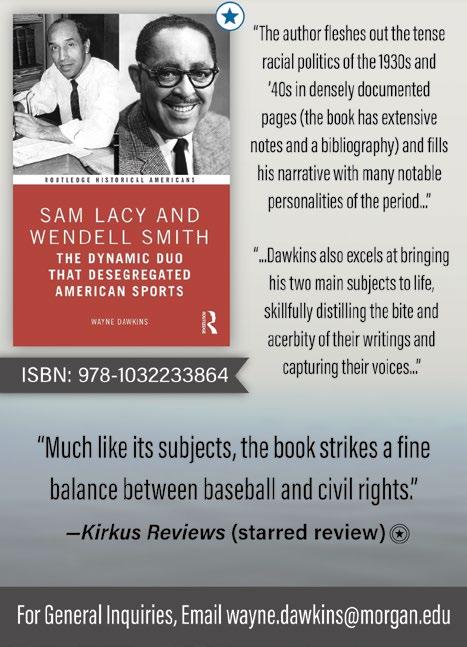

Emily Henry will write the screenplay for a movie based on her new rom-com.
Emily Henry’s Funny Story is headed to the big screen, Variety reports.
Henry’s romantic comedy novel, a No. 1 New York Times bestseller, was published in April by Berkley. The book follows Daphne, a librarian who has been recently dumped by her fiancé, Peter, and becomes roommates with the ex-boyfriend of Peter’s new girlfriend. In a starred review, a critic for Kirkus wrote of the novel, “Henry fans, rejoice: This is her best yet.”
Henry will write the screenplay and will serve

as an executive producer on the film.
The movie is one of several adaptations of Henry’s novels in the works. A series based on Happy Place is being developed by Jennifer Lopez at Netflix, and a film based on People We Meet on Vacation will be directed by Brett Haley. Book Lovers is also headed to the big screen, as is Beach Read, which has Yulin Kuang on board as director.
Henry announced the Funny Story adaptation news in her Substack newsletter, writing, “I have a draft of a script, and as soon as I finish this letter to you, I’m diving back into it, because we’re all chomping at the bit to get this made.”
She mentioned it on her Instagram account, too, writing, “also just read there’s gonna be a shrek 5, so a big day all around.”—M.S.

SEASON OF THE SWAMP
around.” She strives to uncover the secrets behind her family’s dysfunction, attempting to grasp the “darkness [she and Donelle] sensed in big people’s lives.” Hawk’s novel grapples with the simultaneous, oft-overlooked wonder and terror of being a young person experiencing things for the first time. Wheeler confronts the full gamut of emotions with a charming stubbornness. Hawk’s prose is beautiful, a lyrical and loving portrayal of an island and its people; much of the dialogue is written in dialect, which can be both challenging and rewarding.
A unique, scrappy, tender bildungsroman.
Herrera, Yuri | Trans. by Lisa Dillman Graywolf (160 pp.) | $26.00 Oct. 1, 2024 | 9781644453070

One of Mexico’s greatest political leaders enters his wilderness years in the rough streets of New Orleans just before the U.S. Civil War.
In an abbreviated but essential preface, Herrera explains how future president of Mexico Benito Juárez came to live in New Orleans for two years beginning in 1853. Having already served as governor of his home state of Oaxaca but long before he will hold off an invasion by France, he’s been sent into exile by political rival General Santa Anna, along with his brother-in-law Pepe Maza. No one living knows what happened to Juárez in the Big Easy, so Herrera’s suppositions are
well grounded between history and creative license. Asked by a new friend what brings him to town, Juárez replies drily, “A slight diversion, a delta, you might say.” Even though Juárez is intimately familiar with Mexico’s brand of corruption, he’s unprepared to be beaten and robbed by the police upon arrival. He’s even less prepared for the realities of an American slave trade at its height. “These people farm people, they breed humans captured at birth,” Herrera writes. “These people fatten up their children, their own children, and then sell them.” The narrative is populated with real historical figures like fellow reformers Melchor Ocampo and Ponciano Arriaga, with one memorable scene featuring a concert on 10 pianos by American composer Louis Gottschalk. In fact, there’s a surprising richness to the milieu of a story mostly about meetings and letter writing. The New Orleans depicted here is carnivalesque, and the surreal spectacle of bear fights, spontaneous parades, and clandestine meetings, added to Benito’s colorful dreams about liberation and justice, give the story a vibrant, almost hallucinatory feel. Meanwhile, Herrera’s portrait of a leader in exile—rolling cigars, printing pamphlets, and plotting a revolution from the sidelines—depicts the frustrating dichotomy Juárez experiences between his lowly circumstances and his dreams of a better nation.
A thoughtful portrait of one revolutionary’s remarkable resilience, far from home.

Hiiragi, Sanaka | Trans. by Jesse Kirkwood Grand Central Publishing (224 pp.)
$28.00 | Sept. 17, 2024 | 9781538757437

The quiet story of a man who works in the staging area where people who have recently died spend time reflecting on their lives before moving on to the next stage.
Hirasaka works in a photo studio—one of many, he assumes— where his job is to await deliveries of one photo for every day of a person’s life; then, when that person appears, he helps them come to terms with the fact that they’ve just died. During their time in his studio, he treats them to whatever snacks and beverages were their favorites and gives them space to reflect on their life through photographs. Their job is to choose one picture from every year they were alive; once that task is done and Hirasaka has built a lantern to hold them all, the newly deceased will sit and watch it spin. If a photo looks faded, that means it’s a memory that has been revisited so often it has become worn with use. In those instances, Hirasaka and his guest can travel to the 24 hours of that day to retake the picture so it’s just as rich and vibrant as it was when the memory first f ormed. That picture is the last thing the person will see in the lantern as they head off to the next stage. The story is told in three richly drawn vignettes, each focusing on a different person being helped by Hirasaka. A bittersweet picture emerges of complicated people from different walks of life impacted by hardships who nonetheless survived— until their ultimate passing, that is, either from natural causes or at the h ands of others. As kind, or mean, or nondescript, or memorable as each person is, their strongest memories— perhaps of helping others, or making a wrong choice—are held up as
experiences that made them who they are in life, impacting their future selves and who they become in this world and the next.
A complex tale of humanity and how small interactions can change the course of a life.
Khoury, Elias | Trans. by Humphrey Davies Archipelago (473 pp.) | $24.00 paper Sept. 3, 2024 | 9781962770064

A Palestinian exile recalls his ordeals as a child and young adult. This work by the acclaimed Lebanese author Khoury is a follow-up to his novel Children of the Ghetto: My Name Is Adam (2019). While that novel considered the life and death of its title character in a fragmentary fashion, here Khoury’s approach is more straightforward, if still suffused with irony and anguish. Adam grew up in Lydda, a ghetto formed by Israel during the 1948 expulsion of Palestinians known as the Nakba. As a teenager in the 1960s, Adam escapes his abusive stepfather, finding odd jobs in a garage and a restaurant, eventually landing in Haifa and pursuing the study of Hebrew literature. But he cloaks his Palestinian identity to get by, tweaking his last name slightly (from Dannoun to Danoun). On a class trip to Warsaw, he meets a participant in the Jewish ghetto uprising there, provoking a debate between him and his teacher about whether it’s best to stand one’s ground or live in exile. Khoury has
long been focused on the aftereffects of the Nakba, most notably in Gate of the Sun (2006), emphasizing the cruelty of the forced expulsion and the confusions of statelessness; Adam satirizes the bureaucratese that makes him a “present absentee” in Israel. But though death and loss are key themes (major plot points involve murder and suicide), romance is also central to the novel, as Adam recalls his intense, hopeful, and difficult relationships with women. That doesn’t soften the harshness of the events Khoury chronicles, but it does add lyrical and deeper elements to what’s ultimately a tragic story.
A powerful chronicle of the search for peace and identity amid constant disruption.
Kracht, Christian | Trans. by Daniel Bowles Liveright/Norton (192 pp.) | $25.99 Oct. 22, 2024 | 9781324094562

The belated second installment of the Swiss novelist’s semiautobiographical remembrance of his wealthy family’s Nazistained past.
In Kracht’s Faserland (1995), the young author of a novel with that title wandered across Europe, kissing off the 1980s with his aimlessness and addictions. Picking up where that book left off, Kracht’s sequel begins in Zurich, where the fictional novelist, Christian, goes to care for his 80-year-old mother, newly released from a mental institution. Subsisting on vodka and barbiturates, she is, “like Miss
A middle-aged New York writer loses herself to romantic obsession.
Havisham, caught in a spider web of resentment, fury, and loneliness.” So, in his cynical fashion, is Christian, still grappling with childhood abuses. His mother’s malicious bag of tricks included feigning death on the laundry room floor. When not dancing to Dietrich in women’s clothing, his father lived to torment and debase others. And Christian’s maternal grandfather was an active Nazi sympathizer. Christian, who loves his mother despite everything, decides to take her on a long road trip in a hired car before putting her back in the mental hospital. During the journey, we learn that he wore makeup from the age of 13 to 27, wishes he had David Bowie’s crooked teeth, and prefers spy thrillers to the intellectual classics his mother tries to force on him. He uses the trip to give away her vast savings, “money we had swindled from arms factories,” and she hopes to see an edelweiss flower for the first time. A leading figure in European postmodernism, the 57-year-old Kracht offsets Christian’s rock-generation disillusionment with charged language. As entertaining as that is, this novel feels incomplete. It needs to be read with its short predecessor—and its possible successor(s)—to achieve lasting power. Set largely during a long car trip, a mother-and-son novel with compelling psychological gear shifts but not enough traction.
Minot, Susan | Knopf (320 pp.)
$28.00 | Oct. 15, 2024 | 9780593802441

A middle-aged New York writer loses herself to romantic obsession with a handsome musician. Loving someone who doesn’t love you is bad. Everyone in Ivy Cooper’s life keeps telling her that, and at 52, divorced from the father of her young son, now fixated on a younger man named Ansel Fleming who explicitly rejects any possibility of commitment from day
one, she doesn’t really need to be told. And it doesn’t matter anyway because she’s a goner, as fatally obsessed as any bunny-boiling love addict in life or literature. Minot is an elegant writer, her sentences and paragraphs stylishly cropped, her dialogue quotation mark–free, her epigraphs chosen from classic sources: Rilke, Emerson, Lao Tzu, Oscar Wilde, Henry James, Rumi. In pellucid prose she captures each of the emotional states Ivy cycles through on the roller coaster of erotic fascination, delusion, bliss, mania, devastation—while also buffeted by the emotions and responsibilities of motherhood and of a career as a writer. While its individual parts are spare and polished, as a whole the book is ungainly. It’s divided into three sections, each of which has three chapters. The last section, which occurs after we have the sense that we already know everything we need to know, begins with an overly arty chapter about seeking help in “the rooms”—the Brown Room, Pink Room, Red Room, White Room, etc.—revealed to be a therapist’s office, yoga studio, 12-step meeting room, movie theater, lecture hall. In the next chapter, Ivy’s son has a brush with a very serious illness, an inherently suspenseful topic, but which at this point raises the question, “What are we doing here?”
When the final chapter begins with, “She felt she ought to be at the end of this by now. She looked back and saw that what she had thought was close to the end was more like only halfway through the middle,” it’s almost as if author and reader are sharing a private joke.
Almost as painful to read about as it is to experience, which is both a complaint and a compliment.

LOVE CAN’T FEED YOU
Slaughter, Karin | Morrow/ HarperCollins (464 pp.) | $32.00
Aug. 20, 2024 | 9780063336728

Georgia Bureau of Investigation agent Will Trent and medical examiner Sara Linton honeymoon at a family lodge that includes breathtaking landscapes, varied guests, troubled family dynamics, and murder.
McAlpine Family Lodge manager Mercy McAlpine has been an outcast within her family ever since Dave McAlpine, an orphan whom her parents adopted, got her pregnant at 15. To her enduring shame, her relatives, from her aunt Delilah to her own brother, Christopher, took Dave to their hearts even as they squeezed her out, snatching baby Jon from her to be raised mostly by Delilah. Sixteen years later, when her father, Cecil, plans to sell the lodge whose operation Mercy’s poured herself into, she’s had enough, and evidently so have they. Hours after she announces her intention to ruin the lives of any family members who vote with Cecil to sell the place to Max Brouwer and Sydney Flynn for $12 million, Will finds her fatally stabbed near Lake McAlpine, and she dies in his arms. The half-dozen other guests are icing on the cake, since every one of Mercy’s relatives had a powerful motive to kill her. The honeymoon isn’t exactly over, but Will tells Sara he’d be committed to investigating even if Chuck, the fellow guest who tormented Will in the orphanage
where they both grew up, weren’t on hand as Christopher’s lecherous best friend. The high-octane story inevitably lags when Faith Mitchell, Will’s partner in the GBI, arrives to question the suspects, but the shattering climax reveals that the McAlpine family is even more dysfunctional than you imagined. One character nails it: This is “an Agatha Christie locked-room mystery with a VC Andrews twist.”
Sy, Cherry Lou | Dutton (336 pp.)
$28.00 | Oct. 8, 2024 | 9780593474549

The American dream proves to be elusive for one Filipino Chinese immigrant family in this debut novel. After a turbulent flight from the Philippines, 17-year-old Queenie, her 10-year-old brother, Junior, and their elderly Chinese father land at JFK International Airport to be reunited with Ma, who has been working as a nurse in New York for the past five years. Queenie immediately sees a change in her 37-year-old Filipina mother. “She looks sleek and expensive. Like a woman we see on television.” The family’s new home, a small one-bedroom apartment in Sunset Park, Brooklyn, is a letdown. “No white people in sight. This was not what we expected.” Also unexpected is Ma’s command that Papa and Queenie, who had her heart set on going to college, find work immediately to help Ma pay back the
loan that brought the family to the U.S. For Queenie, that means becoming a temporary caregiver for an old woman. As tension between their parents escalates, Junior retreats to his video games and Queenie finds solace with her friend Yan. The author excels at portraying the domestic and cultural stresses that eventually fracture this immigrant family; part 1 is the novel’s strongest section. Unfortunately, the rest of the book is weakened by a meandering narrative that ends abruptly with no resolution. Like her frustratingly passive protagonist, who makes questionable choices for no discernible reason, Sy doesn’t know where she wants her novel to go. She introduces potentially dramatic conflicts—for example, a $500 tip Queenie earns from caregiving is stolen by a family member—and then fails to develop them. There’s a very good novel struggling to emerge from this one.
Weingrad, Michael | Paul Dry Books (135 pp.) | $16.95 paper Sept. 17, 2024 | 9781589881938

A novel in verse inspired by Pushkin’s classic Eugene Onegin , with dungeons, dragons, Yiddishkeit, summer camp, and a 1980s soundtrack. Weingrad, a professor of Judaic studies at Portland State University, has followed his American Hebrew
Literature: Writing Jewish National Identity in the United States with a horse of a different color: a tribute to his Philadelphia childhood following the form of Alexander Pushkin’s verse classic, 389 14-line stanzas of iambic tetrameter with the rhyme scheme aBaBccDDeFFeGG and a storyline that’s a takeoff from the original. The poem itself offers a sage assessment of this effort: “I will say this: check any shelf, you / Won’t find a better novelette / In Pushkin sonnet form that’s set / In early 80s Philadelphia.” Though it’s a bit surprising that this unusual work managed to find its way outside the author’s circle, now that it’s here, it may well amuse those with connections to the period and/or the milieu and those who appreciate literary wordplay, though only those with a serious background in Dungeons & Dragons will be able to make heads or tails of Chapter 2, “The Duel.” In Weingrad’s version, Eugene Nadelman falls in love with a brown-eyed girl he meets at his cousin’s bar mitzvah; falls out with a friend while trying to impress said lady with his skill at battle; has some key comingof-age experiences at a Jewish summer camp in the Poconos (“Among the mountains day is dawning. / Within the bunk twelve kids are yawning. / The PA starts up with a crash / Then warbles Crosby, Stills & Nash”); and ends with an exhortation to the reader to recall and enjoy the memories of their own adolescence. In the middle, an “interlude” addressed to the author’s brother (“But, Aaron, know / I’m thinking of you. Love you, bro”) emphasizes the friends-and-family vibe of the work.
A clever party trick.
A pharmaceutical sales rep has a side hustle that’s somewhat less therapeutic. THIS GIRL’S A KILLER
This Girl’s a Killer
Wells, Emma C. | Poisoned Pen (432 pp.) $16.99 paper | Oct. 29, 2024 | 9781464218620

A Baton Rouge pharmaceutical sales rep has a side hustle that’s somewhat less therapeutic. Life can be stressful for Cordelia Black. She’s still haunted by the way her relationship to clingy Joanie Brown turned out all those years ago. She’s not happy that the FDA has pulled Bosephan, the medication that’s been her biggest seller, off the market. And she instantly takes against her best friend Diane’s new boyfriend, Simon, a nurse who works at Mercy Hospital, where Diane is in the accounting department. On the bright side, Cordelia has a happy place she goes to whenever life is too much to bear: She stalks and kills sex abusers and sells their remains to Clarence Elgin of Spirited Gifts, an immoral but entirely legal broker for body parts. Luckily, she possesses a finely honed moral sense—“I had a code. I only killed monsters,” she confides—along with a strong will and a gift for organization that keeps her complicated life on track. When she realizes that the Feds may be curious about the samples of Bosephan that have gone missing from her possession because she’s been using them to dope her most recent victims, she comes up with a plan. But when she thinks Christopher, the local cop Diane has set her up with, may be getting a little too close for comfort, she must come up with another plan. Then, when something suddenly does go wrong, leading to a cascade of scrapes, misfortunes, and crises, Cordelia must plot anew if she’s going to survive this pitch-black comedy for the promised sequel.
Rated R for clinically detailed accounts of murder, dismemberment, and body disposal, but sadly, no sex. Maybe next time.
Cahoon, Lynn | Kensington (288 pp.)
$8.99 paper | Sept. 24, 2024 | 9781496740809

Shenanigans at a beauty pageant in a community of magicians and mortals lead the organizer to investigate despite everything else she has going on. As fall approaches Magic Springs, Idaho, change is in the air. Mia Malone, who’s preparing to host the Miss Magic Springs Harvest Pageant, feels the frustrating pressure of her dual lives. In her day job, she’s catering director of the Lodge, working under the increasingly difficult Frank Hines. She also runs Mia’s Morsels, a fledgling concern that relies on her income from the Lodge until it can support her full time. These dueling priorities echo other stressors. Mia’s everyday life and her responsibilities as a magic practitioner often butt heads as she strains to navigate the pressures of her local coven, the Magic Springs Society for Magical Realism. But then, no one promised life as a witch would be easy. There’s a bee in Frank’s bonnet because Mia’s Morsels beat out the Lodge to organize the pageant, in part because of its ability to detect spells and offer other upgraded magical services. How could a mortal company compete? As the pageant gets underway, it seems as if the magical upgrades might have been worth it, since magic may well have played a role in bringing down some of the contestants and their stage moms, and Mia has to figure out who’s sabotaging the road to the next Magic Springs Harvest Queen. Once again, though, she’s got to find the balance as she deals with her past love Isaac Adams’ lingering interest and the social pressures to marry current boyfriend Trent Major. An untrained Hellhound named Cerby adds some spice.
A millionaire California singer/songwriter meets a bad end in 1929.
THE TULE MARSH MURDER
The heroine’s conflicting priorities lead to a densely plotted series entry that’s not for newbies.
Major, Tim | Titan Books (304 pp.)
$25.99 | Sept. 3, 2024 | 9781803366418
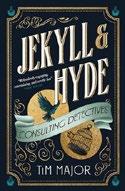
Major launches a new series featuring the world’s most intimately connected detective duo. The starring role, however, goes to Muriel Carew, the former fiancee of Dr. Henry Jekyll, who suspects charitable fundraiser Simeon Courtenay of major fraud. That’s why she’s on the scene at Anderlins, Courtenay’s palatial home, at a reception where she discovers the body of barrister Benjamin Hardy, his body slashed and his throat cut. Her meetings with Jekyll, whom she runs into at Anderlins after a separation of 10 years, disclose other important information. Hardy is only one of a group of missing persons whom Jekyll, under the operating name Hyll Investigations, has been engaged to search for. Every one of those people has been photographed, quite a rare distinction in Victorian London. The photographs, as Muriel’s friend Phillip Fitzmaurice informs her, have all been taken in the same studio, presumably by the same photographer. And Muriel, who slips into the thankless role of Jekyll’s
assistant, learns something she’d never realized before: Edward Hyde is Jekyll’s alter ego, a personality he changes into more or less involuntarily every couple of nights. As in Robert Louis Stevenson’s 1886 novella, the solution to the mystery is even more horrifying than the mystery itself. Major does such an admirable job with the heaviest lift here—coming up with a case that fully engages Jekyll/ Hyde’s double nature without being overwhelmed by it—that it’s hard to imagine how he’ll manage it again. But expectations are high. Sit back, relax, and enjoy—both of you.
Mavity, Nancy Barr | American Mystery Classics (288 pp.) | $25.95 Sept. 3, 2024 | 9781613165829

A millionaire California singer/ songwriter meets a bad end in 1929, courtesy of the author who covered the real-life story her murder is based on.
When wealthy heir Don Ellsworth tells Dr. A.G. Cavanaugh that his wife, musician Sheila O’Shay, went missing a week ago, the two questions Cavanaugh has are why he hasn’t reported her disappearance to the police, and why it’s taken him so long to mention it to Cavanaugh, “the greatest psychiatrist in America.” It turns out that Ellsworth and his wife were less close than most couples married only a year, maybe because Sheila had already been married
before, maybe because she never divorced her most recent husband, David Orme, maybe because Ellsworth broke his engagement to Barbara Cavanaugh, the psychiatrist’s adopted daughter, and married Sheila only when she threatened him with a breach-ofpromise suit. When a bit of scalp and hair from a corpse is retrieved from Tule Marsh, Ellsworth refuses to help Cavanaugh determine whether it’s Sheila’s by giving him a strand of her hair. So does Nellie Kane, Sheila’s dresser. After the police identify the remains as Sheila’s and arrest Orme for her murder, Cavanaugh supplies a crucial piece of evidence at his trial, but it’s up to insouciant Evening Herald reporter James Aloysius “Peter” Piper, who’s sweet on Barbara himself, to identify the killer in the first of his six recorded cases. Oakland journalist Mavity (1890–1959) keeps the list of suspects nearly as short as the body count, relying on brightly written dialogue to move the story along. Randal S. Brandt’s introduction makes it clear that her modest inaugural mystery is based on a real-life case she covered. It’s a safe bet that you’ll finger the culprit before the hero.
The Grey Wolf
Penny, Louise | Minotaur (432 pp.)
$30.00 | Oct. 29, 2024 | 9781250328137

A routine break-in at the home of Sûreté homicide chief Armand Gamache leads slowly but surely to the revelation of a potentially calamitous threat to all Québec.
At first it seems as if nothing at all triggered the burglar alarm at Gamache’s home in Three Pines; it was literally a false alarm. It’s not till he receives a package containing his summer jacket that Gamache realizes someone really did get into his house, choosing to steal exactly this one item and return it with a cryptic note referring to “some malady…water ” and “Angelica stems .” Having already refused to meet with Jeanne Caron, chief of staff to Marcus Lauzon, a powerful politician who’s already taken vengeance on Gamache and his family for not expunging his child’s criminal record, Gamache now agrees to meet with Charles Langlois, a marine biologist with ties to Caron who confesses to a leading role in stealing Gamache’s jacket. Their meeting ends inconclusively for Gamache, who’s convinced that Langlois is hiding something weighty, and all too conclusively for Langlois, who’s killed by a hit-and-run driver as he leaves. The news that Langlois had been investigating a water supply near the abbey of Saint-Gilbert-Entre-les-Loups sends Gamache scurrying off to the abbey, where the plot steadily thickens until he’s led to ask how “an old recipe for Chartreuse” can possibly be connected to “a terrorist plot to poison Québec’s drinking water.” That’s a great question, and answering it will take the second half of this story, which spins ever more intricate connections among leading players that become deeply unsettling.
One of those rare triple-deckers that’s actually worth every page, every complication, every bead of sweat.
One of those rare triple-deckers that’s worth every page, every bead of sweat.
THE GREY WOLF
Swann, Leonie | Trans. by Amy Bojang
Soho Crime (352 pp.) | $27.95
Sept. 3, 2024 | 9781641295802

T he group of retirees collected by Agnes Sharp at Sunset Hall head for an even more dangerous destination. When Edwina Singh wins a vacation to the Eden, a luxury eco-hotel in Cornwall, the housemate she chooses to accompany her is Lillith, whose ashes have been packed in a tin ever since her murder. Stung by this rejection, Agnes announces that Charlie, Winston, Bernadette, and Marshall will all book rooms at the Eden, even if they can only afford it if they double up. Bernadette’s snoring, it turns out, is the least of their problems. Agnes is one of four witnesses to what looks like a fatal plunge from a scenic, distant hill. Although no one reports finding a dead body, the glimpses of corpses—“The Yellow Hood,” “The Man Behind the Scenes,” “The Wet Woman”—keep piling up after a convenient storm cuts off the posh resort from the less civilized but more law-abiding world beyond. It’s not until “The Bookworm” is confirmed dead by the discovery of the victim’s actual remains that the quest begins to identify the rumored victims with the roster of guests and staffers at the Eden. The (eventually) high body count of utterly forgettable victims is leavened by the relentlessly facetious tone with which Swann presents both the Sunset Hall group’s characteristic foibles and the sporadic and often uncoordinated attempts Agnes and the others make at detection. Television fans may think of The White Lotus with an all-senior cast, a laugh track, and a shower of exclamation points inside and outside the dialogue. The protagonist concludes, “If you thought about it, it really had been a very special holiday indeed.” Agreed.
Kirkus Star
Cousens, Sophie | Putnam (368 pp.) $19.00 paper | Nov. 19, 2024 | 9780593718902

A recently divorced woman lets her kids set her up with eligible men, only to find herself falling for someone unexpected. British magazine writer Anna Appleby has sworn off love. After the depressing and drawn-out end to her marriage, she doesn’t believe in romance—and she’s definitely not into online dating. But when Will Havers, a younger, way-too-cocky fellow writer, starts angling to take over her column, Anna needs to step it up. So she pitches a new column idea: She’ll go out on dates with men chosen by her children. Will, meanwhile, will write a companion column about his adventures in online dating. Anna’s kid-chosen dates—with everyone from a dad at their school to the mail carrier to a celebrity—end up charmingly awkward or downright disastrous. (Who knew a fishing date could end with a hook to the face?) Meanwhile, Anna has to deal with the frustration of seeing her ex-husband move on. It’s only when she spends more time with Will that she starts to feel the sparks she never thought she’d experience again—but he’s her office rival, and isn’t he trying to take her job? That’s difficult to remember, though, when the sexual tension between them is driving her to distraction. Cousens has a wellearned reputation for writing delightful love stories, and this one more than delivers. The enemies-to-lovers chemistry between Anna and Will is both believable and steamy, and Cousens deftly plays with rom-com tropes while crafting a journey of self-discovery in the wake of divorce. It’s also refreshing to read
a slightly older heroine—Anna is in her late 30s, an age that often seems nonexistent in romances—with an established life, career, and children. A supremely satisfying love story with all the charm readers have come to expect from Cousens.
Darling, Olivia Rose | Delacorte (384 pp.)
$28.99 | Sept. 17, 2024 | 9780593873892

In this debut fantasy romance, a princess in hiding teams up with an unlikely ally to take back what’s rightfully hers. Elowen Atarah is not your average princess. When dragon eggs hatched for her, she was proclaimed to be “forged from the fire of the gods.” But instead of celebrating her dragon bond, her father put her in chains, seeing her as a threat. Elowen escapes after years of torment— but without her dragons. Exiled but finally free of her father’s cruelty, Elowen learns to fight and becomes a deadly force with the intention of getting her dragons back. This opportunity arrives in the form of Cayden Veles, commander of the neighboring kingdom. Cayden and Elowen have a common enemy—her father. An alliance is forged, and with the help of Cayden and her most trusted friends, Elowen seeks her chance at revenge and rebirth. Darling combines the thrill of the heist à la Leigh Bardugo’s Six of Crows with the dragon lore of Samantha Shannon’s The Priory of the Orange Tree while throwing in a lot more violence and sex. The premise of battling kingdoms fighting a revenge-seeking exiled dragon queen flies close to Game of Thrones territory—but this is romance at its core. Worldbuilding and warmongering take a back seat to the fire building between Elowen and her ally turned lover. Cayden is quick to use the threat of murder to protect Elowen as proof of his love—“Even if a man even hardly touches you, it’ll be the last thing he
does in this life.” While the gratuitous violence may be a turnoff—heed the author’s note on trigger warnings—the first-person narration eliminates much of the discomfort factor. Elowen’s perspective is clear: Cayden’s darkness matches her own. For the first time, the dichotomies within herself make sense and she feels seen. The one thing more unbelievable than how quickly Cayden starts calling Elowen “love” is how often Elowen denies their relationship is anything more than an alliance. Clunky attempts at building tension aside, Darling deserves credit for managing to resolve this power struggle in a way that celebrates Elowen’s return to confidence and strength.
Quippy and crass with lots of passion but far from a light read—expect some emotional whiplash and the desire for more.
Hawley, Sarah | Berkley (448 pp.)
$18.99 paper | Aug. 13, 2024 | 9780593547960

An anxious werewolf finds himself bound to a vampire succubus who’s determined to earn her freedom by any means necessary.
Ben Rosewood is Glimmer Falls’ resident plant dad, owning a successful garden emporium that serves the bustling community. He’s also a single werewolf approaching 40. His biggest form of excitement is drinking a little too much and doing some online shopping, which is how he winds up with a magic crystal with a cranky vampire succubus trapped inside. He didn’t think his winning bid of 99 cents for a possessed crystal would actually deliver the real thing. Eleonore Bettencourt-Devereux is a woman with quite a pedigree, a rare vampire succubus hybrid sired by two prominent European bloodlines. Having been trapped in a crystal by an evil witch since the Middle Ages would make anyone cranky, but it
The existence
may be debatable, but this book is a sure bet.
LOVE AND OTHER CONSPIRACIES
stings much worse knowing that she was put on eBay and sold for less than a buck. She’d like nothing more than to enact vengeance on Ben, but the spell that keeps her bound to the crystal also prevents her from harming its owner— however, the woman who cursed her in the first place might be fair game in her quest for revenge. Unfortunately, Ben doesn’t seem like the bloodthirsty type; he’s a sensitive soul whose anxiety disorder is exacerbated by the presence of incoming full moons. Eleonore is his opposite, almost feral, a caged woman who hasn’t known freedom in centuries. This spicy, slow-burn romance feels one-sided, though, since Eleonore is literally trapped with Ben as the new owner of her cursed crystal. Ben’s needs don’t feel as dire and are often overshadowed by Eleonore’s sometimes explosive personality. Hawley does maintain the quirkiness of small-town Glimmer Falls, with its host of paranormal citizens as established in earlier books such as A Demon’s Guide to Wooing a Witch (2023), but the twee magical elements of the environment don’t work as well with these characters.
A lopsided romance whose enchanting plot is stretched a bit thin.
Marlowe, Mallory | Berkley (368 pp.)
$19.00 paper | Aug. 20, 2024 | 9780593640081

Hallie Barrett doesn’t believe in cryptids or conspiracy theories, but her new web series co-host might get her to believe in love.
After her toxic ex boots her from the show they were working on together, Hallie has to come up with a new series to produce if she wants to keep her job at Skroll, a multimedia conglomerate. While watching a late-night docuseries about conspiracies, she’s compelled by the handsome guest star, Hayden Hargrove, host of the podcast The Out There. Hallie is a skeptic, and if he can make even her interested in his cryptid hunting, she knows he could be a web series star. Through trial and error, though, they realize Hayden is much better on camera when he has Hallie alongside him to banter and argue with, so she becomes not just producer but co-host. As the series’ viewings soar, Hallie’s feelings for kindhearted Hayden grow stronger, but with her ex still constantly tearing her down, her anxious thoughts stand in the way. Told solely through Hallie’s point of view, this quirky and appealing debut is for anyone who believes in love, but will especially appeal to those fascinated by the tales of cryptids and aliens. The conspiracies add a lot of entertainment to the story, but it’s grounded and made heartfelt by the real emotions the characters are dealing with—not just their developing romantic feelings for each other but also Hallie’s self-doubt and Hayden’s loneliness and grief. The existence of Bigfoot may be debatable, but this book’s charm is a sure bet.

Romanoff, Alexandra | 831 Stories (160 pp.) | $14.99 paper Sept. 10, 2024 | 9798893310146
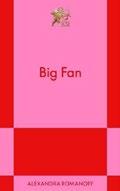
For more romance reviews, visit Kirkus online.
A woman fresh off a painful, public divorce falls in love with a rock star on the comeback trail. Maya McPherson was right where she wanted to be in her career as a high-powered Washington campaign operative. But when her husband was caught up in a sex scandal, it tanked not only her marriage but also, unfairly, her reputation and career prospects. Maya finally has a chance to get back in the game when a Massachusetts gubernatorial candidate offers her a position as the campaign’s policy specialist for universal basic income. At the same time, Maya receives an interesting offer from her past. As a teenager, Maya and her best friend organized and ran the fan club for the wildly popular boy band Mischief. Charlie Blake, one of the band members, has been out of the music business for years. Currently in D.C., he sends Maya a cryptic message asking for a meeting. Charlie reveals that he’s working on a solo album and wants to hire Maya as part of the PR team that will manage his comeback. Even though Maya is flattered, she refuses, since a condition of her new campaign job is keeping a low profile. Maya and Charlie are attracted to each other and begin a coy, flirtatious texting relationship that spans several months. When Maya discovers that Charlie has a personal belief in UBI, she recruits him to be a spokesperson for the campaign. When they meet in person to plan his remarks, Maya finds it impossible to resist the attraction between them. Romanoff successfully portrays Maya’s struggle to recover from the emotional devastation of her divorce in the punishingly sexist world of the D.C. political scene. Charlie’s character is generically good and underdeveloped by comparison. Earnest and thoughtful, this romance highlights a woman’s brave decision to love again.


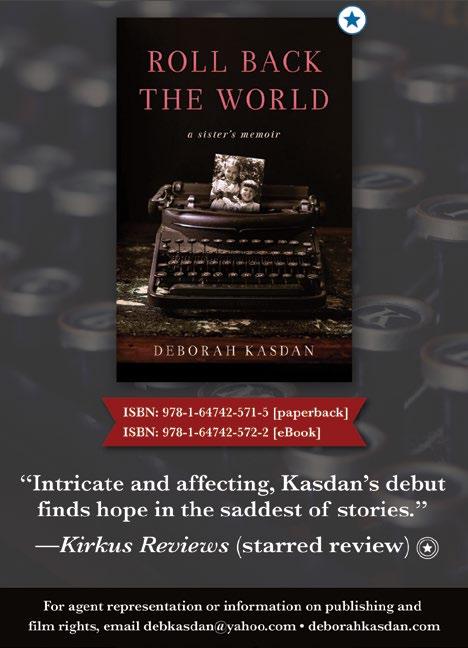

America’s resurgent right wing gets plenty of attention in fall books about Christian nationalism, small-town battles over vaccination, the Trump family, and Ronald Reagan. Loss and grieving are the subjects of several memoirs, a genre that also includes the usual batch of celebrity reminiscences. And two books offer multiple cases of justice miscarried and then restored.
Kirkus Star
Abramsky, Sasha | Bold Type Books (288 pp.)
$30.00 | Sept. 3, 2024 | 9781645030430

A view of the MAGA-wrought culture wars as they play out in small towns. Abramsky, author of The American Way of Poverty and The House of Twenty Thousand Books, chronicles his visits to red islands in mostly blue states, such as Sequim, Washington, which was torn apart by antinomian politics during the pandemic. The county’s medical officer tried to head off the virus by requiring masks and restricting bars and restaurants to vaccinated patrons. It worked, and in the capital, officials “extended the proof-of-vaccination mandate to include the entire state of Washington.” Her strategy earned death threats, propelled by people who make significant money spreading lies. Abramsky ranges to places such as deep-red Shasta County, California, where locals seriously discuss secession when things like virus-control mandates arrive from the faraway capital and where political action is often a reaction to progressivism, such that “a half-century-plus of social change was being litigated and litigated again on a daily basis.” It’s in small-town America where the culture wars are being fought the most fiercely: where experts come under attack, where books are banned, where school boards are taken over by people intent on dismantling public education. More than that, as Abramsky illustrates at numerous points, in those small towns, where progressives are most often a distinct minority, those wars are being fought between right-wingers and farther-right-wingers, complete with litmus tests of ideological purity. Fortunately, it seems that more moderate forces are in the ascendant. After the pandemic, writes the author, many voters
returned to the center: “The majority… wanted their local public officials to be laser-focused on issues such as housing rather than going down rabbit holes about QAnon, about the evils of public health responses to a once-in-a-century pandemic, about stolen elections.”
An excellent, fearless work of political reportage in the face of America’s violent discontents.
Allen, Roland | Biblioasis (416 pp.)
$19.95 paper | Sept. 3, 2024 | 9781771966283

A celebration of the joys of putting pen to paper. British publisher and diarist Allen brings his love of notebooks to a lively, wide-ranging history of bound blank pages. Notebooks, he writes, “interest me as a technology that has had tangible effects on the world around us.” The author started keeping a journal in 2002: “Writing a diary made me happier; keeping things-to-do lists made me more reliable (which in turn made those around me happier), and I learned never to go to a doctor’s appointment, or a meeting of any kind, without taking notes of what I heard.” Wondering how and when notebooks were invented and why their use spread, he decided to fill a historical gap with the results of his own sleuthing. After an overview of record-keeping in the ancient world—diptychs, papyrus, and parchment—Allen begins in 13th-century Florence, where ledgers, first on parchment and later on paper, a superior product imported from Provence, became indispensable for business. Books of paper became indispensable for many artists, as well, who developed their techniques in sketchbooks. Notebooks grew in popularity, finding uses in the home to keep track of accounts or compile personal anthologies of entries such as prayers, medical recipes, riddles, and poems.
Those anthologies evolved into commonplace books, favored by Erasmus and W.H. Auden, among others. Ships’ logs, travelogues, recipe books, and naturalists’ findings are just a few of the many uses for notebooks across the centuries. Isaac Newton, Swiss naturalist Conrad Gessner, and Charles Darwin recorded their discoveries in notebooks; Leonardo da Vinci worked out inventions. In treating chronic pain or PTSD, physicians have found that for patients, keeping a diary has “proven therapeutic value.” As an intimate repository for thought, notebooks, Allen amply shows, are essential. An enthusiastic, informative cultural history.
Beiser, Vince | Riverhead (288 pp.)
$32.00 | Nov. 19, 2024 | 9780593541708

A disturbing study of the high cost of the secret machinery embedded in our myriad digital devices. It is easy to think of electric vehicles, green energy, and other advanced technology as surefire ways to save the planet, but award-winning journalist Beiser, author of The World in a Grain, advises us to look at the issues more deeply to assess the true costs. The author focuses on the metals required to power new-gen tech, which include huge amounts of copper and nickel as well as cobalt, boron, lithium, and less familiar substances like gallium and germanium. These elements are necessary for batteries and chips that support everything from EVs and smartphones to wind turbines and solar panels. A critical problem is that mining and refining these metals can, if not done carefully, create horrifying environmental and humanitarian problems. The key players in the global business are China and Russia, which deliberately chose to accept the damage in order to cut costs and corner the market. Both countries have shown themselves willing to leverage
their positions for geopolitical advantage. Other countries have acknowledged the danger and are trying to catch up in the marketplace, but there is a long way to go. Beiser also investigates the global market in scrap, noting that the recycling of the metals in tech devices is useful but often exploitative to laborers. The U.S. has huge mineral resources, but to develop them without damaging the environment would be expensive. Beiser argues that the higher costs must be borne and that the cheap ride enjoyed so far is not really so cheap. This is a message that many people might not want to hear, but the author underlines the point that there is no real alternative. Beiser’s research is alarming and his evidence sobering, but his well-informed conclusions are difficult to deny.
Kirkus Star
Bock, Charles | Abrams (208 pp.)
$26.00 | Oct. 1, 2024 | 9781419774423
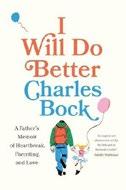
A widowed father struggles with the challenges of single-parenting his toddler in New York City. Bock, the author of the acclaimed novels Beautiful Children and Alice & Oliver, the latter of which fictionalizes his experience of losing his wife to cancer, turns to memoir to document the challenging period after her death. Diana died three days before her daughter Lily’s third birthday. “I concentrated on the tasks at hand: making calls to a woman who ran a funeral home out of her Brooklyn apartment (for a reasonable price she handled the cremation); following up with a Ninth Avenue bakery (confirming the color of the iced letters, the birthday message on the double-chocolate cake).” The interplay between grieving and child rearing continues throughout, and Bock holds himself to a high standard of honesty and self-revelation, per the Montaigne
A uniquely forthright and powerful addition to the literature of fatherhood.
I WILL DO BETTER
epigraph that opens the book. In general, his literary references are well chosen and interestingly deployed. He finds inspiration in the memoir of Beat poet Diane di Prima, who refused to cave to pressure from Jack Kerouac to blow off the promise she’d made to her babysitter to stay at a party. Bock’s analysis of Sylvia Plath’s famous poem, “Daddy,” centers on pointing out, “If you are a father… this poem is an absolute terror.” In his distinctive prose style, both lyrical and muscular, Bock evokes a chaotic kaleidoscope of tones—irony, anger, literary ambition, fierce parental protectiveness, loneliness, toxic masculinity—as he handles topics from simultaneously dating two women who don’t know about each other to his and Lily’s experiences during Hurricane Sandy. Bock doesn’t mention his relationship with writer Leslie Jamison, who documented their brief, stormy marriage in her recent memoir, Splinters Given the tone of that book, this seems like an admirable choice.
A uniquely forthright and powerful addition to the literature of fatherhood.
Boot, Max | Liveright/Norton (880 pp.)
$45.00 | Sept. 10, 2024 | 9780871409447
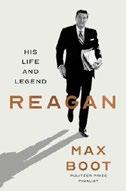
The historian and foreign-policy analyst presents an unabashed revisionist history of the 40th president of the U.S. Boot, a senior fellow at the Council on Foreign Relations and the author of The Road Not Taken and Invisible Armies, sets out to present
Ronald Reagan (1911-2004) in full: the enigmatic man of contradictions who had a singular talent for connecting with millions of constituents while being a conflict-avoiding introvert little known to his own family as well as associates who famously eluded and “flummoxed” official biographer Edmund Morris, whose Dutch was “an experimental, quasi-fictional book that was widely criticized.” The amount of research Boot conducted is immense, and his portrait of Reagan is enhanced not only by the passage of time since Reagan’s administrations, but by the author’s 100+ forthright interviews and the availability of more archival materials. Boot brings to light the familial, social, and religious influences that shaped Reagan’s Midwestern childhood; the skills he honed as a sportscaster and actor, which reinforced the all-American persona that he would display on the world stage; and his intriguing work as an FBI informant during the Hollywood blacklist era. The author also produces a no-holds-barred account of Reagan’s terms as California governor and U.S. president. Boot’s account of the life and times of Reagan is, as promised, no hagiography.
Occasionally, however, the author overreaches in his attempts to demonstrate his independence with odd quips and obvious points that diminish the quality of the text. Yet Boot goes further than any other biography—with the exception of H.W. Brands’ 2015 portrait—in completing the story of an essentially unknowable individual who was “hiding in plain sight” yet whose ideological metamorphosis was fundamental to understanding the political and social transformations of the U.S. in the second half of the 20th century. A prodigiously researched, satisfying presidential bio.
Kirkus Star
She-Wolves:
Bren, Paulina | Norton (352 pp.)
$29.99 | Sept. 17, 2024 | 9781324035152
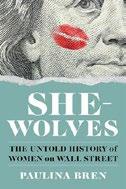
A significant study of the trailblazing women who broke through the Wall Street barrier. In this illuminating account of a collection of important women in the financial industry, Bren, author of The Barbizon , focuses primarily on Wall Street from the 1960s to the present day, noting how the finance sector retained its sexist culture even as American society was changing around it. During this era, the first generation of women worked as secretaries and typists, laying the foundations for the next wave of women who had graduated from business schools. They took jobs as researchers and analysts, but most found themselves locked out of the big-money trading jobs in the male-dominated industry. Bren tracks the careers of several women who, through ability and persistence, managed to move up. Still, it was a constant battle against tokenism, excuses, and unapologetic sexism, and women found themselves working twice as hard for half the recognition. Legislation prohibited discrimination in hiring and promotion, but the more insidious problem was the old-boy networks, fueled by boozy lunches and post-work outings to strip clubs. “The female pioneers of Wall Street… pushed into uncharted territory not knowing what awaited them there other than men, lots of men, few of whom were going to roll out a welcome mat.” Nevertheless, progress continued, and some women went on to establish their own trading firms. Throughout this fascinating business and cultural history, Bren fleshes out the story with instructive anecdotes,
and she provides a series of biographical sketches in an appendix. While the situation has markedly improved, there are still far too few women in positions of power and leadership in the finance industry. We might hope that Bren returns to the subject in another decade or two for a further assessment. Writing with flair and passion, Bren salutes the courage and talent of true groundbreakers.
Chung, Connie | Grand Central Publishing (352 pp.) | $32.50 Sept. 17, 2024 | 9781538766989
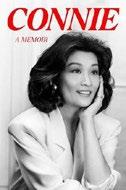
The dizzying highs and nauseating lows of a landmark broadcasting career. She was the only one of her siblings to be born in the U.S. after her parents arrived from China in 1945. By her twenties, Chung tells us, she had morphed from a meek youngest who “never uttered a peep” into “someone who was fearless, ambitious, driven, full of chutzpah and moxie, who spoke up to get what she wanted.” Convinced that she was the equal of her white male colleagues in journalism, she would need every bit of that gumption in the decades that followed, as she smashed through barriers of sexism and racism with stints at each of the three networks. Sentences like this one—“I thought the Gingrich controversy was the worst incident I would face while coanchoring the CBS Evening News, but what was to come made Bitchgate pale in comparison”— lead us from one crisis to the next. The most humiliating occurs in the wake of the Oklahoma City bombing, when Dan Rather (of the many people who come off badly in this book, he is the worst) sabotaged her career in a way she could never fully recover from. As for narcissistic divas Barbara Walters and Diane Sawyer: “Each time I’d pop my
head up, Barbara or Diane would whack me with a spongy hammer.” Her personal life is full of juice; she and husband Maury Povich had a long-distance open relationship for many years before they married, allowing her exciting interludes with characters like Ryan O’Neal. (She jumps in her sports car, tells him to follow her, and... “Feel free to use your imagination.”) At the end of this long road come sweet signs of her impact on the culture: a Connie Chung rest stop on the Garden State Parkway, a strain of marijuana that bears her name, and, most movingly, a whole generation of Chinese American girls named Connie.
An irreverent, inspiring chronicle of a great life.
Danticat, Edwidge | Graywolf (160 pp.)
$26.00 | Sept. 3, 2024 | 9781644453025
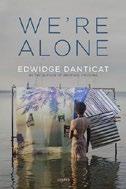
The acclaimed author discusses influential authors, her native Haiti, and the challenges of life in America. Danticat begins this short but powerful collection of essays by quoting Haitian-born poet Roland Chassagne. The cited work includes the phrase the author chose for her title. “We’re alone is the persistent chorus of the deserted, as in no one is coming to save us,” she writes. “Yet, we’re alone can also be a promise writers make to their readers, a reminder of this singular intimacy between us. At least we’re alone together.” In 1963, Chassagne was taken to dictator “Papa Doc” Duvalier and disappeared. His experience encapsulates the two themes around which Danticat groups these essays, the first devoted to writers who have influenced her and the second focusing on Haiti. In these pieces, the author chronicles the memories conjured by a 2018 visit for the opening of a new library; her Miami speech in which she advocated for prolonged protected status for Haitians displaced
by hurricanes; the influence on her life and writing of such authors as Lorraine Hansberry, Audre Lorde, and Toni Morrison, the last of whom “turned pain into flesh and brought spirits to life”; her terror upon arriving at a Miami shopping mall during a mass shooting that turned out to be a hoax; and the frightening activities of a Haiti gang known as 400 Mawozo, which kidnapped 17 missionaries in 2021. This collection, like many, has a grab bag quality to it; the pieces don’t cohere as well as they should. Still, the author offers an elegant commentary on injustice and the mixed feelings one’s home can engender. As Danticat writes, “things sometimes go differently than planned or hoped for, and though home can be a safe place, we shouldn’t always rush back there.”
Moving essays on Haiti, literature, and life’s vicissitudes.
Dawkins, Richard | Yale Univ. (360 pp.)
$35.00 | Sept. 17, 2024 | 9780300278095

The famous evolutionist meditates on his favorite topic.
Dawkins, bestselling author of The Selfish Gene, The God Delusion, and numerous other landmark books, argues persuasively that every living creature’s body and behavior can be read as a book. Confronted with a hitherto unknown animal, a future biologist could decipher its entire evolutionary history. Today’s scientists lack the technology and fossil record to deliver a detailed account, but few are more qualified than Dawkins to make the effort. Demonstrating more good sense than many of his colleagues, he makes generous use of photographs and Lenzová’s expert illustrations. The author emphasizes that every individual’s genes came to be the way they are over many generations through random drift and mutation guided by natural
selection. Sexual recombination ensures that the gene pool is stirred and shaken, while mutation sees to it that new variants enter the pool. Natural and sexual selection determine the shape of the average genome changes in constructive directions. Individuals, species, and the physical DNA die, but the information in the DNA can last indefinitely. Having laid the groundwork, Dawkins proceeds with several dozen mind-bogglingly fascinating anecdotes describing animals, often wildly disparate, dipping into the ancient history of their DNA to solve problems in similar ways. A mole is a mammal, and a mole cricket is a bug. Adapted to life underground, they have evolved to look nearly identical. The same applies to marsupial and modern placental mammals, who have evolved separately for more than 150 million years. The cuckoo learns nothing from its parents, whom it never encounters, yet its DNA provides everything it needs to know from the species’ long history, including its song and its eggs, the design of which invariably changes to resemble eggs in the nest it parasitizes. Ingenious stories in the service of deep natural history.
Eve with Kathy Iandoli | Hanover Square Press (320 pp.) | $29.99 Sept. 17, 2024 | 9781335081155

The pioneering, multihyphenate female rapper traces her odyssey from vulnerable teenager to fierce superstar. Eve (born Eve Jihan Cooper) recounts her childhood raised poor in West Philadelphia’s Mill Creek housing
project. She had an early affinity for music and eschewed college to pursue a career as a rap artist. After relocation to New York City, Eve endured a brief, “pretty sobering” stint as a topless dancer. She started rapping for customers, one of whom turned out to be newly discovered talent Ma$e, who ushered her into the industry. As “Eve of Destruction,” complete with her signature paw print chest tattoos, she rose to fame amid industry manipulation, misconception, and cutthroat competition. It didn’t help to be condescended to by stars such as Jay-Z, who offered congratulations on her 1999 Billboard chart–topping debut album, Let There Be Eve…Ruff Ryders’ First Lady, yet foresaw its inevitable failure “because female hip-hop albums don’t really do that well” within the predominantly male-dominated rap music industry. On the contrary, to date she has produced four successful albums, not to mention her numerous film and television credits. Co-authored by hip-hop journalist Iandoli, her earnestly written memoir shares many memories: the melodrama of creating songs and albums with numerous producers and co-writers; a collaboration with Prince; becoming the new “it” girl in hip-hop; the downside of touring at 21 “trapped in a hurricane of my own making”; and becoming the first artist to win a Grammy for best Rap/Sung collaboration. She also reveals the intimate details of her relationship with husband Maximillion Cooper and the numerous fertility challenges she faced before their first child, Wilde Wolf, was born in 2022. Eve fans will have a lot of behind-the-scenes details to savor in this inspirational and heartfelt self-portrait.
A potent, passionate celebrity autobiography grounded in authenticity and fearlessness.
A potent, passionate celebrity autobiography.
WHO’S THAT GIRL?
Kirkus Star
Framed: Astonishing True Stories of Wrongful Convictions
Grisham, John & Jim McCloskey
Doubleday (352 pp.) | $30.00 Oct. 8, 2024 | 9780385550444

Ten cases of egregious miscarriages of justice and their aftermaths.
Bestselling novelist Grisham teams up with McCloskey, the founder of an organization that works to free the wrongfully convicted, to spotlight 10 cases in which innocent people were falsely accused of a crime, went through trials marked by various sorts of bias and misconduct, and were unjustly incarcerated. Grisham and McCloskey alternate the book’s 10 chapters to show guiltless suspects being victimized by corrupt police officers and detectives, dishonest government officials, racist and/or unsympathetic jurors, untrustworthy witnesses, incompetent doctors, and underprepared lawyers. Grisham’s cases include the story of the Norfolk Four, Navy sailors browbeaten by detectives into confessing to a rape/murder in 1997, and the ordeal of three men convicted of killing a 70-year-old woman, based on the testimony of a police informant saving himself from doing time and despite all three being exonerated by DNA testing. McCloskey’s chapters profile individuals he has worked with, among them Clarence Brandley, a Black janitor convicted by an all-white jury of murdering a white 16-year-old volleyball player; and Ellen Reasonover, a witness who became a suspect in the murder of a gas station attendant when the police basically pressured two women to testify that she had confessed to them. Many of these cases were brought in front of judges based on police hunches, which they buttressed by manipulating uneducated and impressionable witnesses and defendants, suppressing evidence, and in some cases coercing confessions.
The list of perpetuated wrongs is endless, and the co-authors are empathetic to the plight of people who had nothing to do with the crimes they were accused of committing. The truth eventually came out in these cases, but that does little to lessen the impact of this sobering look at what happens when we turn a blind eye to injustice.
A powerful and infuriating must-read about ineptitude and injustice in America’s legal system.
Hammad, Isabella | Black Cat/ Grove (80 pp.) | $18.00 paper Sept. 24, 2024 | 9780802163929

A speech delivered by the author in September 2023 at Columbia University, with an afterword on Gaza.
“The Palestinian struggle for freedom,” writes British Palestinian novelist Hammad, author of The Parisian and Enter Ghost, “has outlasted the narrative shape of many other anticolonial liberation movements that concluded with independence during the twentieth century, and it is becoming more difficult to hold fast to the old narratives about the power of narrative.” The author opens by referencing Edward Said’s 1975 book, Beginnings, addressing her choice to begin in the middle of stories, specifically “the shifting narrative shape of the Palestinian struggle in its global context.” She views Said, primarily, as a literary scholar, crediting his “engagement with fiction as an heir to a particular kind of humanism…that commits itself to crossing boundaries between cultures and disciplines.” Acknowledging that most of her own writing has been about Palestine, Hammad illustrates this with a story that also demonstrates anagnorisis, which Aristotle described as “a movement from ignorance to knowledge.” She interweaves her thoughts on narrative structure and aims—e.g., “The material
we draw from the world needs to undergo some metamorphosis in order to function, or even to live, on the page”; “Literary anagnorisis feels most truthful when it is not redemptive: when it instead stages a troubling encounter with limitation or wrongness”—with examples of comparative literature as well as Palestinian history, including her great-grandfather’s life and the continued persecution of Palestinians by Israel. “Narrative shape can comfort and guide our efforts,” writes Hammad, “but we must eventually be ready to shape-shift, to be decentered…in the project of human freedom, which remains undone.” The anti-Zionist afterword addresses Israel’s attack on Gaza nine days after the author’s speech and the ongoing war: “Do they really believe they can obliterate the Palestinian will to life?”
Simultaneously scholarly and righteously impassioned.
Heath, Chris | Schocken (640 pp.)
$40.00 | Sept. 3, 2024 | 9780805243710

This chillingly meticulous chronicle of a dozen escapees from a Nazi extermination camp underscores the mechanics of heroism and the fallibility of memory.
Journalist Heath, a National Magazine Award winner, ably narrates the disturbing story of the camp at Ponar, Lithuania (“never a work camp”), where 70,000 Jews were rounded up, shot, and dumped in pits, beginning in July 1941, only to be disinterred and burned to hide the evidence. Throughout, the author expertly highlights the grisly contradictions and trauma of the Holocaust. Although what happened at Ponar had been documented by the end of World War II, the story was
relegated to a footnote for the next 30 years. The author masterfully resurrects the events, tracing accounts of the 12 men who miraculously escaped through a tunnel they dug at the killing pits on the night of April 15, 1944. As Heath recounts, they had been among 80 Jewish prisoners who were sent to the pit site to perform the grisly duties of digging up the decomposed corpses and burning them on towering pyres—so that, in the “magical thinking” of the Nazis, no trace of the crimes would be left as the Soviet troops advanced. However, not only did the 12 men escape and tell their stories— many not believed, though one testified at Nuremberg—but some of the inhabitants of the forest town also saw what was going on, including a journalist neighbor who documented the activity in a diary that was later found and published in 1999. Heath painstakingly sifts through the conflicting accounts over the decades, analyzing discrepancies, details, and contradictions. Ultimately, he learned, just like the survivors, “of how great the distance could be between speaking out and being heard.”
Utterly absorbing in its powerfully detailed horror and inspiring redemption—a must-read in Holocaust studies.
Henion, Leigh Ann | Algonquin (336 pp.)
$30.00 | Sept. 24, 2024 | 9781643753362

A lyrical, fascinating story about exploring the secret world of darkness and the remarkable creatures within it.
In today’s hectic, digitally focused world, writes Henion, we have become too used to an excess of illumination: the unblinking screen, the persistent streetlight, the overbright room. Furthermore, we have lost a sense of the
presence of darkness and an understanding of what happens there. The author explored this idea in her 2016 book Phenomenal: A Hesitant Adventurer’s Search for Wonder in the Natural World , but in her latest, she dives deeply into a world that is unknown to most readers. She begins with fireflies, which are plentiful in the mountains of North Carolina, where she lives, as well as glowworms and night-traveling salamanders. She chronicles her travels through her area and further afield, encountering guides and naturalists who are studying nighttime creatures. The animals and birds that come out at night can be difficult to spot, but Henion finds that her eyes and spirit can slowly adapt to the darker, more natural world. She also describes the plants that bloom under the moonlight, often with strange structures and rich perfume to attract moths and insects. In a striking chapter, the author examines the luminous fungi known as foxfire, which has a beauty all its own. She recounts her experience of making fire from natural materials as evening gathered and how she felt connected to the long line of humanity. There is a sense of renewal throughout, and she realizes the importance of occasionally escaping from the world of unrelenting, artificial light: “It is only by the power of light and the grace of darkness that we’re able to rest and rise, then rest and rise again.”
Henion writes with poetic grace, blending her journey of discovery with the natural wonders in our own backyards.

For another work of lyrical natural history, visit Kirkus online.
Ives, Lucy | Graywolf (336 pp.) | $20.00 paper Oct. 15, 2024 | 9781644453117
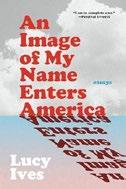
Five essays weave together myriad topics, connecting personal experience to culture and history. Ives, the author of many well-received works of fiction, poetry, and criticism, including Loudermilk and Life Is Everywhere, harnesses her extraordinary intelligence, knowledge, and background in a collection that radiates from her experience of pregnancy and childbirth at 40. The first, “Unicorns,” offers a deep dive into the history of unicorn iconography, as the author ties it to her passion for a childhood toy in sentences such as these: “The My Little Ponies seem to lack the sorts of mnemonic affordances (e.g., writing or social institutions) that would allow them to retain intergenerational memories, and, in any case, although baby My Little Ponies exist, the My Little Ponies appear to be immortal, unaffected by death”; “The unicorn, nickering behind bluish trees, is so natural, so much a part of what is natural, which is to say so much not a part of what is human, that it does not exist. It fades into the mist of a human fantasy about the natural world.” In the titular essay, Ives puzzles out the mystery of her heritage and discovers a surprising connection to an essay she wrote in college, and she also discusses her obsession with museum period rooms and the Assyrian genocide. “Earliness, or Romance” is an illuminating examination of the “cursed” film Seven Brides for Seven Brothers, while “The End” is an abecedarian as well as a record of a nervous breakdown, a beautiful collage proceeding through the alphabet with Kafka,
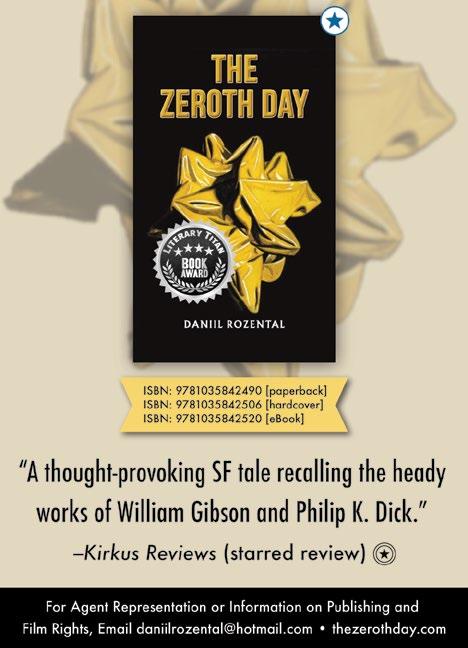
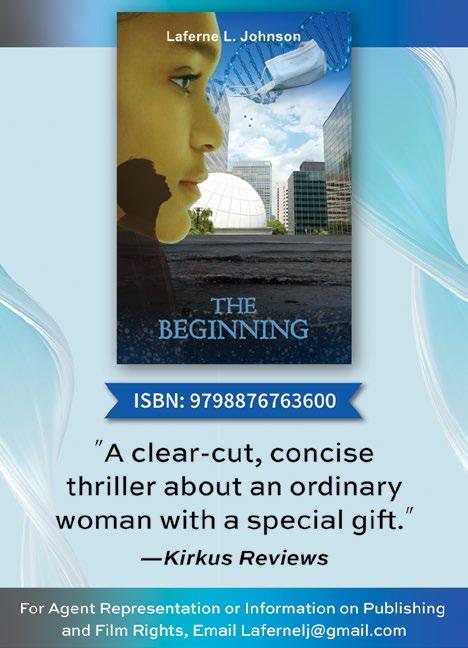


AYANA ELIZABETH JOHNSON
Author of What If We Get It Right?
AYANA ELIZABETH JOHNSON is a marine biologist, policy expert, and writer. What If We Get It Right?: Visions of Climate Futures (One World/Random House, Sept. 17) compiles her interviews with experts who are successfully combating climate change, resulting in “an exuberantly hopeful read,” according to Kirkus’ starred review (see p. 50). Johnson answered our questions via email, and the responses below have been edited for length and clarity.
What, briefly, is What If We Get It Right? about?
It’s about envisioning the climate future we want to create and getting clear on how we inflect from here to there. That imagining part is key, because while scientists, writers, filmmakers, and artists have shown us—repeatedly and in great detail—the climate apocalypse we will trigger with business as usual, there is very little in popular culture showing us a future worth running toward.
It’s going to take a massive transformation to secure a reasonably safe climate future. I think of this book as a “show me it’s worth it” pitch. The material is presented somewhat casually, via essays by me, abridged transcripts of interviews with experts, plus poetry and commissioned art. The book is an attempt to guide us through solutions and possibilities at the nexus of science, policy, culture, and justice—taking climate change seriously but definitely not taking
ourselves too seriously. There’s gobs of jokes and silliness.
What inspired you during the writing of the book?

The first and foundational answer to this is always: nature. Biophilia, my love of and reverence for the wonders of biodiversity and ecosystems, is an endless source of inspiration.
The title question—“what if we get it right?”—inspires me, but it’s really intimidating. Instead of paraphrasing and quoting experts, I thought, why don’t I just interview them so readers can hear from them directly? The heart of the book is 20 interviews with visionary farmers and financers, scientists and culture makers, activists and journalists, and others who have helped me to see the way forward.
My third and perennial inspiration is music. The very last page in the book is my Anti-Apocalypse Mixtape.
What was most challenging about writing this book? And most rewarding?
First, distilling the two-hour-long interviews to their essence was very hard. I was literally cutting and pasting with scissors and tape to create these abridged versions.
Second, there are lists of 10 problems and 10 possibilities that open six sections of the book. I thought that would be a quick project I’d do with my research assistant, but curating those lists, finding compelling and up-to-date stats, was hilariously time-consuming.

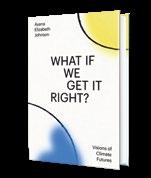
Third, I was the art director for this book and figuring out how best to present the many different elements was a really fun puzzle.
Will you be touring for What If We Get It Right? this fall?
We have a 20-plus-city tour across the U.S. from mid-September through the end of October. It’s a wild thing for an introvert to embark on, but here we go! I’m also looking forward to the climate variety shows I’m producing in Brooklyn and L.A. They will be livestreamed.
What fall release(s) are you most eager to get your hands on?
Justice Ketanji Brown Jackson’s memoir [Lovely One].
Interview by Nina Palattella.
Richard Rorty, Winona Ryder, and many others in attendance. Finally, in “The Three-Body Problem,” Ives connects Liu Cixin’s sci-fi novel to the matters of pregnancy and childbirth. A dazzling display of knowledge, wit, ratiocination, and prose style, though possibly blinding at times for lesser mortals.
Kirkus Star
Johnson, Ayana Elizabeth | One World/ Random House (400 pp.) | $28.00 Sept. 17, 2024 | 9780593229361
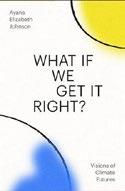
Interviews with experts who are successfully combating climate change. Marine biologist Johnson traces her love affair with the ocean to a family vacation in 1986, when her parents took her on a glass-bottom boat ride in Key West, Florida, where she got to marvel at what was left of the area’s coral reefs. Today, she is the founder of Urban Ocean Lab, “a policy think tank for the future of coastal cities.” Despite the fact that her job exposes her to some of the world’s worst environmental catastrophes, Johnson is also hungry for optimism, specifically, for proof that by working together people can mitigate the effects of climate change and undo the damage we’ve so carelessly caused. She writes, “We need something firm to aim for. Something with love and joy in it. And we need the gumption that emerges from an effervescent sense of possibility.” This desire for practical, joy-based approaches to climate change led Johnson to conduct a series of interviews with environmental activists, thinkers, and scientists who move conversations away from litanies of what we’ve done wrong and toward the question, “What if we get it right?” These wide-ranging interviews span issues ranging from artificial intelligence as a tool for
preventing climate change to racial justice in homestead farming to divestment as a means of redirecting capital away from fossil fuels and toward sustainable solutions. In addition to asking perspicacious questions and curating a diverse and brilliant set of voices, Johnson leads us through the material with a witty, brainy frankness that renders this often dense, potentially depressing material into an exuberantly hopeful read.
An inspiring compilation of voices from the environmental justice movement.
Kenny G with Philip Lerman Blackstone (302 pp.) | $28.99 Sept. 24, 2024 | 9798200756674

A distinguished musician talks about how a “skinny, white, nerdy guy” named Kenneth Gorelick became one of the bestselling artists of all time.
As Kenny G (b. 1956), a Seattle native, relates, his love affair with the saxophone began in fourth grade when he first saw it played on The Ed Sullivan Show. After his parents rented one for him, he became “hypnotized by the physicality of it.” A natural musician, the author quickly learned to read music and play the instrument. Only after the high school band rejected him during his freshman year, though, did he begin the daily “intense practice regimen” that transformed him into a first-chair player and dedicated musician. His life changed forever when Jim Gardiner, the school’s Black composer in residence, introduced him to Grover Washington, whose work the author studied with the meticulousness that became one of his defining musical characteristics. “One session doesn’t do it,” he writes. “You have to come back to it over and over and over. Which is another reason that I still practice three hours every day.”
Later, at around the time the author took up his trademark soprano
saxophone, Gardiner recommended him to R&B superstar Barry White, who needed a replacement sax player “with a soulful feel” for his band. From that point on and for the entirety of the college career that followed, the author played professionally. He joined Jeff Lorber’s jazz fusion band, where he became known as “Kenny G” and met producer Clive Davis, who offered him the chance to record as a solo artist. Warm, thoughtful, and upbeat, this candid memoir about a life dedicated to—and enriched by—music will appeal to Kenny G’s many fans and to music aficionados with an interest in the rise of the smooth-jazz sound. Feel-good reading from a feel-good musical artist.
Lavin, Talia | Legacy Lit/Hachette (288 pp.) $30.00 | Oct. 15, 2024 | 9780306829192

A full-bore attack on Christian nationalism’s crusade to remake America. A reader of her book, warns peripatetic journalist Lavin, is “an enemy combatant in a war of the spirit that began before your birth and is being waged every day by determined, ordinary people you wouldn’t look twice at if they passed you in the street.” Those people, Lavin asserts, are a small minority; evangelicals represent just 14% of the populace. Still, that’s nearly 50 million people, and they have an unshakable goal for which they’re willing to play a long game: namely, to establish “a Kingdom of Christ on Earth ruled by his elect.” That kingdom would make possible scenarios worthy of The Handmaid’s Tale : women, in the Christian fundamentalist order, are definitively second-class beings, meant to bear children and do the dishes. Children are meant to be obedient, and if they’re
not, they’re subject to severe corporal punishment. On that point Lavin lingers too long, repeating assertions that “obedience to God requires doing violence to children” and its variants for page after page. Nonetheless, her analysis of where home schooling figures into the equation is disturbing: some children reject the indoctrination, but most, she holds, “live to be the future of the faith militant.” The unremittingly alarmist tone makes Lavin’s book a chore to read at times. Still, her overall points are well worth noting, particularly when it comes to looking at the long game: the evangelicals, allied now with supremacists and nationalists, have been concentrating quite effectively on transforming key aspects of American governance, especially the judiciary, into which the Trump administration has rushed to appoint lifetime judges committed to preserving “religious liberty,” which according to Lavin means “anything they did or said came under the stamp of morality, because it was they who were saying it.”
Often repetitive, but with a point: the culture war is a real war, and the fundamentalists have their eyes on the prize.
Kirkus Star
Leavitt, Sarah | Arsenal Pulp Press (152 pp.)
$24.95 paper | Sept. 24, 2024 | 9781551529516
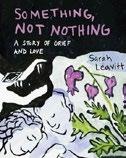
A powerfully intimate graphic memoir of a partner’s assisted suicide.
“On April 21, 2020, my partner, Donimo, died.
She had a medically assisted death beside a rushing river with people she loved holding her tight. She was 54.” So begins Leavitt’s extraordinary record of loss, with a brief handwritten prologue describing Donimo’s character, suffering, and diagnosis with a series of debilitating illnesses. The author labels the art that follows “a collection of comics,” but that phrase barely begins to describe Leavitt’s formally innovative artwork: freehand panels and full-page images that combine poetic text with illustrations and abstract images and textures, realized in watercolor, ink, and colored pencil. She chronicles the couple’s progress toward the decision to end Donimo’s life, as well as her own deep resistance and terror, taking us literally to a place beyond words. Along the way, there is dark humor (“The 73rd stage of grief generally coincides with March 31”), anguish, tenderness, engaging storytelling, and philosophy. In the final section, Leavitt writes about when she and Donimo learned about the Jewish concept of Olam Habah, the world to come: “The rabbi said, ‘I have learned that there is something—not nothing—out there waiting for us. Something wonderful and loving and peaceful and joyous.’” Leavitt wondered if that could possibly be true, and this incredibly moving and beautiful book documents her journey toward an answer. It is a fitting follow-up to the author’s debut, Tangles, a graphic memoir about her family’s experience with Alzheimer’s, which is being adapted into a film with an all-star cast. “Donimo continues,” writes Leavitt, “whether it’s in an afterlife where she races through the sky or hovers above me to the left…. And I continue also in my alive body. I think it’s the continuing that matters.”
A uniquely gorgeous chronicle. Full box of tissues recommended.
Leone, Marianne | Gracie Belle/ Akashic (232 pp.) | $25.95
Sept. 3, 2024 | 9781636141923

An actor, screenwriter, and essayist reflects on how caring for five small dogs helped her come to terms with the death of her quadriplegic, nonverbal son.
Canines became a fixture in Leone’s life in 1994, when her then-6-year-old son, Jesse, made it clear he wanted a dog. The author and her husband bought him a bichon frise puppy named Goody, and they nicknamed him the “Prince of Dogs.” Twelve years later—and a few months after Jesse passed away in his sleep and Leone was diagnosed with cancer—Goody died. Mourning her son and struggling to regain her health, the author realized that she also grieved for Goody. Seeking a way to heal, she adopted two quirky, cage-traumatized bichons, Lucky Dog and French Fry. Leone loved them deeply and pampered them with everything from the freedom to roam and play and $1,500 dog beds to filet mignon steaks brought home from fancy dinner parties. The bichons warily returned Leone’s affection while she wrestled with maternal grief by writing a memoir about Jesse. Like her son, the dogs were loved unconditionally, but their emotional scars would “be there forever, like mine.” Their deaths during the pandemic spurred the author to find two new rescue dogs, Titi and Sugar, to whom she wanted to reintroduce “their innate dog joy.” While Leone came to understand that all the dogs she cared for embodied some part of Jesse and his love, she also came to accept that her grief, the very thing that had brought the dogs to her, was something she would carry for the rest of her life. Candid and bighearted, this book about the healing power of animal companionship will warm the hearts of animal lovers and general audiences alike.
Joyful, affecting reading about love and family.
Masters, Ben | Tin House (336 pp.) | $18.95 paper | Oct. 1, 2024 | 9781959030812

Literary son seeks to connect with his outdoorsman father by exploring the latter’s lifelong fascination with butterflies.
Masters, who teaches English literature and writing at the University of Nottingham, is a devotee of American popular culture, while Dad, “steeped in natural history,” spent his life in the fields and woods of rural Northamptonshire. In this moving memoir, Masters cares for his terminally ill father while taking a crash course in lepidoptery. His “butterflying journey” goes beyond “trophy butterflies up in the canopies” to encompass poetic descriptions of their various forms of beauty, such as the “tiny white bit of punctuation on each hindwing of the Commas, short breaths for dead clauses.” Masters alternates passages of his lessons in natural life with stories from the lives of famous literary lepidopterists such as Vladimir Nabokov and Virginia Woolf. Nabokov advanced methods for classifying butterflies and identified a new species; Woolf portrayed her fellow novelist E.M. Forster as a pale blue butterfly. But for all of the entomological references Masters finds in great books, nature poetry, and pop culture, his memoir really resonates when he gets personal and describes the deepening of the father-son relationship in the face of imminent death. Along the way of his transformation “from butterfly-ignorer to butterfly-obsessive,” Masters brings his writerly skills to bear, such as
when he describes the silver-washed fritillary as “an ingenious piece of orange origami powering above and disappearing into the hedgerow.” There are paeans to great insects like the purple emperor with its “owlish eyespot” and the white admiral with its “leopardish underside.” His recollections of his naturalist father and their late-in-life connection is replete with butterfly themes and imagery, but ultimately it is the humanity of their story that compels. A heartfelt remembrance.
Posnanski, Joe | Dutton (384 pp.)
$30.00 | Sept. 17, 2024 | 9780593475522

The author of Why We Love Baseball gives us 100 reasons to look forward to football season. Posnanski is a practiced sportswriter, but here, following his top-50 treatment of baseball, he’s an enthusiast with an uncommonly broad grasp of football history. He opens with a splendid anecdote about Dick Butkus, renowned for smacking into his opponents hard enough to send them into the next zip code. When Raquel Welch, whom Butkus played alongside when he became an actor, professed wonder that people called Butkus mean, a crewmember replied, “Don’t pick up a football.”
The author, old enough to remember when football was a Sunday-only televised sport, connects to the game at a fan’s level, sometimes elevating it to a religion. As he writes, while biblical scholars credit Jesus with somewhere between 37 and 40
miracles, “football, miraculously, has more.” One, ranking 14th on Posnanski’s 100 list, was the famed “Hail Mary” that Roger Staubach pulled off in December 1975—a pass that, while Staubach didn’t necessarily invent it (Posnanski inserts a brief history that stretches back three more decades), was a last-ditch, desperate temptation of fate that actually worked. Voilà: a miracle, just as when Joe Montana lured an opposing Dallas line into coverage that left his receiver wide open to make a game-closing touchdown after San Francisco came far from behind, all of which Posnanski sets up with the offhand opening, “Joe Montana was on the smaller side, and his arm didn’t wow you, and he seemed a little bit frail”—and yet, a miracle, and pick no. 11 of 100. It would spoil the fun to reveal the No. 1 moment, but suffice it to say that those readers who witnessed it will surely share Posnanski’s appreciation.
A learned but lightly delivered pleasure for fans of the gridiron and its history.
Radclyffe, Oliver | Roxane Gay Books/ Grove (352 pp.) | $28.00 Sept. 17, 2024 | 9780802163158

A transgender man comes to terms with his identity. Born into a wealthy English family, Radclyffe began life as a girl in denial about her crushes on other women. After coming out as gay, the author visited the Bluestockings bookstore in New York City, a short train ride from the Connecticut home where Radclyffe was masquerading as a housewife despite suffering from hair and weight loss and random moments of pain associated with gender dysphoria. At Bluestockings, the author met and began dating a woman. When they slept together, Radclyffe imagined having a phantom penis, which, in retrospect, he recognized as a
possible sign that he was transgender. However, only after getting a divorce and falling in love with another woman did he come out as a man. Although his relationship didn’t survive his transition, Radclyffe found acceptance among his chosen family, his parents, and his children. Perhaps most importantly, he discovered self-acceptance and learned that his identity didn’t negate his ability to be a loving and effective parent. “The world had tried to tell me that I couldn’t care for myself,” he writes, “and also for my children, that I couldn’t be trans and queer and be a source of stability.… Whatever my failings as a parent—and I knew there had been many—my children would walk out into the world armed with all the tools I’d once lacked: courage, curiosity, the confidence to form their own opinions and trust their own instincts.” This book is consistently frank, vulnerable, perspicacious, and insightful, covering an impressive variety of aspects of the transgender experience in intimate, lyrical language and dry, compassionate humor. The author’s analysis of privilege is particularly refreshing, as is his description of transitioning as a parent.
A stunning memoir about discovering one’s identity late in life.
Schulte, Brigid | Henry Holt (384 pp.)
$31.99 | Sept. 17, 2024 | 9781250801722
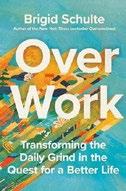
An alarming study of how work pressures are making us sick, exhausted, and miserable. There was a time when work stayed in the workplace, but that era is over, writes Schulte, whose previous book, Overwhelmed, investigated the social dynamics of work. In this follow-up, she paints a grim picture, showing how office work has followed employees home, where they are expected to continue answering emails and solving problems
into the night and on weekends. The situation is equally dire for those employed in the service industry or manufacturing, where hours and duties have increased but wages have remained stagnant for years. The pressure is even greater for those who are juggling family responsibilities, caring for young children or elderly parents. Schulte provides statistical data to back up the anecdotal evidence, noting that the result of all these interrelated factors is an array of physical and mental health problems, especially depression and chronic anxiety. There are, however, companies that have brought in better arrangements, including greater performance flexibility and shorter workweeks. In some cases, these policies have led to a better bottom line, although many variables are in the mix. Schulte believes there are policy lessons to be learned from other countries around the world, including legal protection for family time and acknowledgment of the value of (unpaid) domestic work. Some of her proposals would be difficult to implement, but her overall view that work is not working is valid. Even though the author does not answer all the questions she raises, she presents a solid contribution to a crucial debate. Two epilogues address “How To Change” and “The Problem With Work Stress and How To Solve It.”
Writing with energy and passion, Schulte shows how work has come to dominate our lives and outlines options for change.
Silverstein, Larry | Knopf (368 pp.)
$35.00 | Sept. 10, 2024 | 9780525658962
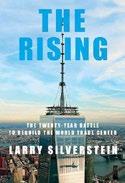
9/11. In this first-person account of his business success and navigation of the bureaucratic maze known as the Port Authority of New York and New Jersey, the author explains how he used his knowledge, authority, and acumen to follow through on his nearly instantaneous decision to rebuild and revitalize the site and properly memorialize those murdered in the atrocity. In addition to amply demonstrating his entrepreneurial and political adroitness, Silverstein displays a talent for making the complex and high-stakes game of New York City commercial real estate—and the associated legal and insurance wrangling that 9/11 made even more difficult—surprisingly interesting. His seemingly good and decent nature shines through his prose, as does considerable wisdom gleaned from a wildly successful career that many times looked as if it would plunge beyond the precipice—but was bolstered by loyal friends, associates, and, most of all, his devoted and tough-as-nails wife, Klara. Silverstein’s poignant and heartfelt description of what was lost—and what endured—in the wake of 9/11, including the anguished resolve to keep moving forward and weighing whether to rebuild or consecrate the entire site as hallowed ground, will resonate with anyone who experienced that tumultuous period. “The precise details are buried deep in my mind,” he writes.
“Even decades later they are apparently too painful to relive fully.” At the same time, the author provides a deeper perspective and understanding to younger readers who did not experience it. Throughout, Silverstein writes with panache, wit, and grace, and his is a story worth savoring.
One of the nation’s most successful real estate magnates details what it took to rebuild and revitalize the 9/11 site.
As he recounts, Silverstein had secured a 99-year lease on the Twin Towers less than two months before
A compelling personal account of a uniquely American comeback.

Kirkus Star
Slepian, Dan | Celadon Books (224 pp.)
$30.00 | Sept. 3, 2024 | 9781250897701

A TV producer’s journey into the hellish landscape of wrongful convictions.
Slepian, a veteran producer of Dateline, narrates his involvement in a series of outrageous cases of wrongful conviction and long-term imprisonment. “My innocence work,” he writes, “had become a way into understanding the tragic consequences of America’s system of mass incarceration—for the innocent, the guilty, and all of society.” Beginning with the notorious Thanksgiving 1990 murder of a Palladium nightclub bouncer, the cases illuminate how, during New York’s high-crime years, authorities would overlook exculpatory evidence and dubious prosecutions. This investigation led the author to Sing Sing Prison and to “JJ Velazquez, the soul of this book,” who was jailed following witness misidentification in the murder of an ex-cop running a gambling parlor. “When I first met JJ in 2002” while working on a story for Dateline, writes the author, “I’d gone into my investigation skeptical of his innocence. By 2011, I was certain of it.” His focus intensified as he learned about more inmates at Sing Sing, including the “Bronx Six,” railroaded for two 1995 murders: “So many lives ruined, and for what? As I looked at the case, all I could see were bumbling cops hell-bent on making arrests as quickly as possible.” As he continued his investigation, Slepian encountered resistance, as damning information emerged about the NYPD bowing to political pressure for convictions. In addition to chronicling the plights of his subjects, the author includes his own perspective and self-deprecating background as a lifelong
TV nerd turned outsider advocate, yet the narrative voice is brisk and punchy, contrasting with depictions of New York’s “bad old days” and the nightmarish circumstances of the wrongly convicted. The result is a gripping, highly effective true-crime synthesis. An excellent addition to the body of work documenting a pervasive societal injustice.
Smarsh, Sarah | Scribner (352 pp.)
$29.99 | Sept. 10, 2024 | 9781668055601
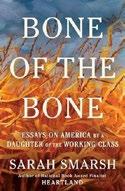
The author of Heartland returns with a collection of pieces that illuminate the plights and humanity of her workingclass subjects.
“The White, rural, working-poor people about whom I most often write—they are your people too,” writes Smarsh in the introduction to this compendium of 36 essays, the majority of which originally appeared in a range of publications. The author possesses a distinct style, one simultaneously personal and political, with the aim of navigating “the space where storytelling might be at once factual in content and artistic in form.” In her essays, which range from two to 18 pages, she makes frequent references to her own experiences. “I am bone of the bone of them that live in trailer parks,” she writes in a 2014 essay about “the teeth of poor folk,” which criticizes America’s costly dental care system and humanizes those who are unable to afford treatment. She calls for the American dream “to put its money where its mouth is” with different laws and “individual awareness of the judgments we pass on people.” Another essay describes Smarsh’s brother, a first-generation college graduate who “had no connections in the professional world, and no one to tell him that
communications and history degrees were bad bets to begin with.” As she recounts, he regularly sold his plasma over the course of a decade to make ends meet. In a piece about growing wheat in Kansas, the author writes, “The greater divide in America today is not between red and blue but between what is discussed in powerful rooms and what is understood in the field.” Even though these essays were shaped by more than a dozen editors, this collection’s impact is staggering, and Smarsh’s voice is constant, studied, and compassionate. This powerful reckoning with the costs of being poor should be required short-form nonfiction reading.
Thompson, Wright | Penguin Press (496 pp.) $35.00 | Sept. 24, 2024 | 9780593299821

A native son dissects one of Mississippi’s most shocking racist crimes. With deep roots in Clarksdale, “one of those faded Delta farm towns,” Thompson, author of Pappyland , grew up not far from the place where a farmer named J.W. Milam and a storekeeper named Roy Bryant kidnapped Emmett Till, who had allegedly made suggestive remarks to Bryant’s wife. The sadistic killing took place in the barn of Thompson’s title, which for a long time afterward “was just some guy’s barn , full of decorative Christmas angels and duck-hunting gear…hiding in plain sight, haunting the land.” When a sign was erected, years after Till’s murder, white racists tore it down; a second one was shot full of holes. The barn still stands. Ironically, Thompson notes, the town where Till was murdered was named for the daughter of one of the founders of the Ku Klux Klan—but for all that, he adds, the KKK never gained much of a
foothold among white Delta families, the racist murder notwithstanding. Thompson ranges widely in telling Till’s story, with one character a Black sharecropper who saw the boy’s freshly spilled blood on the floor of the barn and left the state, returning 50 years later when the Department of Justice reopened the murder case. The author’s story, intended for readers “everywhere the poison of the Lost Cause has spread,” offers hope for a more racially equitable Mississippi. Eventually justice did arc the right way, at least after a fashion: Till’s mother noted that her son’s killers were shunned by the white community after the killing, no one would rent land to Milam, and, she concluded, “before long, cancer got both of them. They lost their lives for what they did to my boy.”
A profoundly affecting, brilliantly narrated story of both an infamous murder and its unexpected consequences.
Kirkus Star
Trump, Mary L. | St. Martin’s (288 pp.)
$29.00 | Sept. 10, 2024 | 9781250278470

A second tell-all memoir from the former president’s niece.
Mary Trump, a clinical psychologist, expands her vehemently critical assessment of her family outward after the first memoir, Too Much and Never Enough, skewered Uncle Donald. With raw authenticity and bracing detail, she painstakingly reveals the devastating psychological impact of the Trump clan’s outraged reaction to her first tell-all, which forced her to check herself into a treatment program utilizing experimental ketamine therapy. Three years prior, she’d had treatment for “intensive trauma” and a dissociation condition, all exacerbated by the fact that “Donald Trump is my uncle.”
Looking inward, she peels back the traumatic layers of her early life growing up in Jamaica, New York, with parents Freddy, a commercial airline pilot, and Linda, a flight attendant. Sadly, her parents’ idyllic romance curdled beneath the constant mockery and “stifling control and blanket disapproval” of her grandfather, real estate mogul Fred Trump, the “unaffectionate” family patriarch. Eventually the author would grieve for her parents, who each suffered with personal demons, particularly her father, who succumbed to alcoholism and died prematurely at age 42. Ordeals with chronic asthma attacks (which were ignored by her dismissive mother), sexual harassment from a neighbor, and an indifferent family forced her to shut out the world around her and “turn inward.” With blistering frankness, Trump elaborates on the melodrama surrounding her grandfather’s will and the numerous lawsuits (“my family’s love language”) that ensued after Donald and his siblings calculatedly stole her and her father’s inheritance from her grandfather’s estate. Trump, who is openly gay and a mother to a grown daughter, doesn’t skimp on the jarring, revelatory details of her toxic family, telling her truths with lucidity despite the narrative’s relentlessly despondent tone and texture. She unpacks the baseline origins of her debilitating stress, self-loathing, and self-isolation in a heartless clan that apparently couldn’t care less about her. Another scathing exposé of the enduring fallout from a poisonous, dysfunctional family dynamic.
Walker, Jerald | Amistad/HarperCollins (176 pp.)
$29.99 | Sept. 10, 2024 | 9780063161078
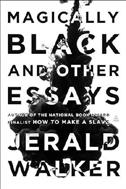
Shadows, was a child, his parents became enthralled with the Radio Church of God, accepting their dubious biblical evidence that Black people were inferior to white people. “Along with accepting the myth of white supremacy,” he writes, “I had been denied meaningful exposure to Black traditions and culture.” This strange inheritance led to the author’s complex relationship with his Blackness. The essay “Master of the Lawn” is a second-person, choose your own adventure–style story that begins with a decision about whether a passing motorist yelled a racial slur or a benign pleasantry. Walker urges readers to “beware of racists, paranoia, self-pity, anger, and white privilege,” all of which the author examines in “Lost,” which describes how his son’s tardiness caused the author to spiral with visions of his possible death at the hands of white police. Walker contends with these feelings in less serious situations as well. In “Combat Mode,” another second-person essay, the author writes about how he and his wife decided whether to kill a cockroach before potential buyers visited their house. “This is not to say that the presence of one or more roaches means the presence of one or more Blacks, or vice versa,” he writes. “Nor is it to say that the presence of Black homeowners means the presence of neglect and disrepair. But these are persistent stereotypes that, with so much at stake, you cannot risk falling victim to.” Walker’s humor is cuttingly circumspect, and his observations are poignant and insightful. The author’s talent for identifying small but powerful moments is sometimes overshadowed by over-the-top self-deprecation. Nonetheless, Walker is a witty, talented writer.
A funny and perspicacious essay collection about Black life in America.
A Black professor analyzes the ways in which race shapes his life. When Walker, the author of How To Make a Slave and Other Essays and Street

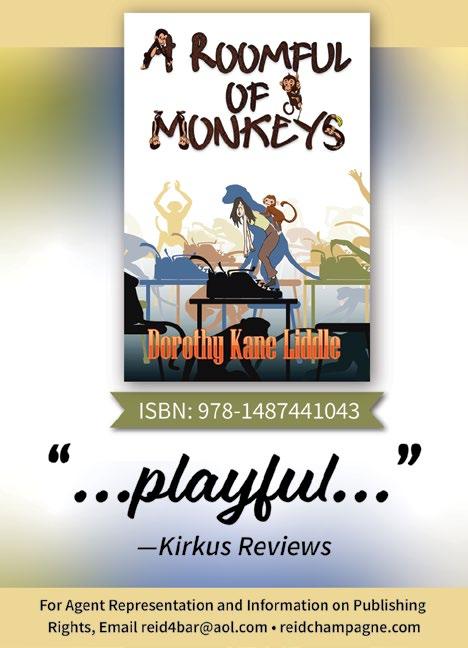
















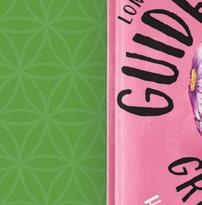










Author of Frighten the Horses
COMING-OF-AGE stories traditionally focus on the teenage years. Not so for Oliver Radclyffe, whose painstakingly assembled life as a wealthy English-born housewife in Connecticut began to unravel in his 40s. In Frighten the Horses (Roxane Gay Books/Grove, Sept. 24), Radclyffe examines the constraints that class, gender, cultural scripts, and heterosexual marriage placed on his pre-transition self—and the world as we know it. In a starred review (see p. 52), Kirkus calls this memoir “vulnerable, perspicacious, and insightful.” Radclyffe answered our questions by email.

Leslie Feinberg’s Stone Butch Blues opened the floodgates for me, but after reading it I made the conscious decision to avoid reading any more trans books while I was drafting, because I wanted to stay very close to my own personal experience. I knew if I read other people’s descriptions of their transitions it might influence the language I used. As soon as I finished the first draft I inhaled trans literature like a drowning man coming up for air: Jack Halberstam, Kate Bornstein, Daniel Lavery, Susan Stryker, Paul Preciado, Julia Serano, Grace Lavery, Andrea Long Chu, Jules Gill-Peterson…all these writers saved my life and my sanity.
Where do you do most of your writing?


When did you know you wanted to write a memoir about your transition?
I wrote the first draft of the first chapter the day after [my transition] happened. Although at the time I didn’t know I was writing a memoir, I found myself writing in story form, almost as if I were writing in the third person. After a couple of years of writing this way I got hooked on writing narrative—as opposed to journaling—so I started trying to learn more about structure and technique. Now I can’t imagine not waking up and writing every day.
What books, particularly transgender literature, did you read while writing Frighten the Horses?
Because I’m a solo parent with four children, I’ve been largely confined to the Connecticut suburbs for the last decade and a half, so writing is how I escape. I like to start early, so my mind is completely clear. From this small corner of my office I then get to go anywhere I want: London, New York, the past, the future, you name it. It’s a very cheap way to travel, and I don’t have to worry about offsetting my carbon emissions.
Who is the ideal reader for your book?
Transition is such a mysterious and complex subject, even for those of us who’ve been through it, so I try to write for the kind of reader who has an open heart and mind but lots of unanswered questions. I want them
to know that it’s OK if they’re struggling to understand what the hell gender is.
What fall releases are you most eager to get your hands on?
I’m looking forward to Alan Hollinghurst’s new novel, Our Evenings , which is about class, queerness, and race in England, subjects that are obviously very close to my heart. I’m also dying to get my hands on Women’s Hotel by Daniel Lavery, who transitioned around the same time I did. He’s one of the few authors who makes me cry laughing.
Interview by Sasha Fox Carney.
HEADLINE this fall’s nonfiction—from stellar celebrity memoirs to elegant essays by authors who should be household names.
A celebrity book that doesn’t dish is a letdown. Thankfully, Connie Chung’s new memoir is a banquet. Connie (Grand Central, Sept. 17) depicts “the dizzying highs and nauseating lows of a landmark broadcasting career,” Kirkus writes in a starred review. Born in Washington, D.C., to parents who immigrated from China in 1945, Chung transformed from a “meek” child to the “fearless” young woman who “smash[ed] through barriers of sexism and racism at each of the three major networks.” This delectable volume details everything from professional sabotage by Dan Rather to her long-distance open marriage with Maury Povich.
Not unlike Chung, the Grammy-winning rapper and singer Eve “rose to fame amidst industry manipulation, misconception, [and] cutthroat competition,” our reviewer writes of Who’s That Girl?, a memoir written with Kathy Iandoli (Hanover Square Press, Sept. 17). From humble West Philadelphia beginnings to hip-hop “it” girl status, Eve
shares stories of being ushered into the industry by Ma$e, collaborating with Prince, and journeying toward motherhood. Kirkus calls this powerful memoir a “potent, passionate celebrity autobiography grounded in authenticity and fearlessness.”
Rounding out our celeb recommendations is the sweet and satisfying story of a soprano saxophonist. Life in the Key of G by Kenny G with Philip Lerman (Blackstone, Sept. 24) tells “how a ‘skinny, white, nerdy guy’ named Kenneth Gorelick became one of the bestselling artists of all time,” Kirkus writes. The Seattle native’s life changed forever when his high school’s composer-in-residence introduced him to the music of Grover Washington. Gorelick played sax for Barry White and Jeff Lorber— becoming Kenny G along the way—before superproducer Clive Davis helped guide him to solo stardom. Life in the Key of G offers pure “feelgood reading from a feel-good musical artist.”
Whenever Edwidge Danticat puts pen to paper—novels, short stories, nonfiction, young readers’ literature—you’re in for a transformative reading experience. Her latest
collection, We’re Alone: Essays (Graywolf, Sept. 3), contemplates the multifarious meanings of home. “The acclaimed author discusses influential authors, her native Haiti, and the challenges of life in America,” Kirkus writes. “[A]n elegant commentary on injustice and the mixed feelings one’s home can engender.”
Sarah Smarsh, the author of Heartland , a 2018 Kirkus Prize finalist, returns this fall with Bone of the Bone: Essays on America by a Daughter of the Working Class (Scribner, Sept. 10). This set of 36 pieces ranges from a consideration of America’s costly dental care system to the widening divide between citizens and lawmakers. “This powerful reckoning with the costs of
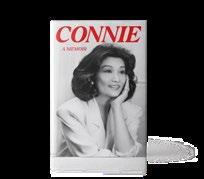

being poor should be required short-form nonfiction reading,” according to our starred review. And don’t miss this excellent memoir with breakout potential from a bold new voice: Oliver Radclyffe’s Frighten the Horses (Roxane Gay Books/Grove, Sept. 17) is a later-in-life coming-of-age story that’s “consistently frank, vulnerable, perspicacious, and insightful, covering an impressive variety of aspects of the transgender experience in intimate, lyrical language and dry, compassionate humor,” our critic says in a starred review. (Read an interview with the author on p. 57.)
Editor at large Megan Labrise hosts the Fully Booked podcast.


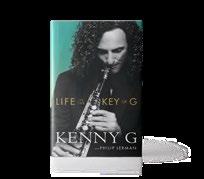

The author of Homo Deus considers the future of information networks. His international bestseller laying out ideas on human destiny is a hard act to follow, but Harari manages. The first part examines past information networks, leading with the intriguing declaration that “most information is not an attempt to represent reality.…What information does is to create new realities by tying together disparate things.” What that means is that “errors, lies, fantasies, and fictions are information, too.” Information is often wrong, and more information does not necessarily improve matters, so it’s essential that institutions contain self-correcting mechanisms. Our Constitution receives high marks for allowing amendments; holy books considered
infallible, like the Bible and Quran, create problems and “hold important lessons for the attempt to create infallible AIs.” The second part deals with governments whose information networks maintain a balance between truth and order, arguing that just as sacrificing truth for the sake of order comes with a cost, so does sacrificing order for truth. Modern technology enabled largescale democracy as well as large-scale authoritarianism and totalitarianism. Harari deplores the conception that democracies operate through majority rule. In fact, he argues, democracies guarantee everyone liberties that even the majority cannot take away. This is a sophisticated concept that current events suggest is not universally accepted, and

recent advances in ar tificial intelligence may be an additional destabilizing force. Harari warns that modern societies controlled by carbon-based life forms (us) must deal with inorganic, silicon-based networks (AI) that, unlike the printing press, the radio, and other inventions, can make decisions and create
ideas by themselves. AI’s ability to gather massive amounts of information and engage in total surveillance “will not necessarily be either bad or good. All we know for sure is that it will be alien and it will be fallible.”
Confronting the avalanche of books on the prospects of AI, readers would do well to begin with this one.
THE ISLAMIC MOSES
Kirkus Star
The Islamic Moses: How the Prophet Inspired Jews and Muslims to Flourish Together
Akyol, Mustafa | St. Martin’s Essentials (304 pp.)
$30.00 | Sept. 10, 2024 | 9781250256096

The largely untold story of Jewish and Islamic cooperation. Akyol continues to challenge modern, divisive religious views by highlighting what he calls the “Judeo-Islamic tradition.” In this work, the author asserts that Jews and Muslims often had a cooperative, even collaborative relationship until the end of the Ottoman Empire in the early 20th century. Emulating the approach of his earlier book, The Islamic Jesus, which described largely ignored ties between Islam and Christianity, Akyol uses the figure of Moses to explore ties between Islam and Judaism. Arabs in cities such as Medina, he states, were open to Islam in part because their Jewish neighbors had introduced them to the concept of monotheism. Beginning during the lifetime of the Prophet Muhammad, Jews aided and even encouraged the burgeoning Muslim movement. Similarly, as Islam spread, it gave Jews a protected and equal status. As Islam continued to advance westward with the conquest of the Ottoman Empire, Byzantine Jews who had long suffered under the remnants of Roman rule found far more freedom and tolerance under Muslim governance. Some “even saw the advent of Islam as the beginning of a Messianic age.” In contrast with
Russia and Europe, where Jews lived in separation and fear, Ottoman Jews were protected. In fact, the empire often welcomed persecuted Jews from areas such as Spain. Akyol goes so far as to refer to this relationship as a “Muslim and Jewish symbiosis.” However, with the conflicts of the first half of the 20th century and the advent of Zionism, culminating in the state of Israel, this symbiosis rapidly unraveled. Nationalism, rather than purely religious issues, Akyol argues, has been behind the conflicts that ravage Jewish-Muslim relations to this very day.
A timely, accessible, and eye-opening new approach to a centuries-old story.
Aldridge, David, John Hollinger & The Athletic NBA Staff | Morrow/HarperCollins (752 pp.)
$40.00 | Nov. 26, 2024 | 9780063329126

Portraits of the hundred best players in the history of the National Basketball Association. Veteran sports journalists
Aldridge, a fixture in NBA arenas since the late 1980s, and Hollinger, author of the well-regarded series Pro Basketball Prospectus, oversaw the compilation and ranking of the 100 greatest players in NBA history to date as determined by the staff of The Athletic. As with a previous title, The Football 100, the players are ranked in descending order, accompanied by vividly written entries that chronicle their on-court exploits and offer a broader look at their personalities, social consciences, and shortcomings. The stories are composed by some of the finest basketball
writers around, including Jared Weiss, Sam Amick, and Aldridge and Hollinger themselves. Each seamlessly weaves the history and evolution of the league into the player portraits. In any such exercise of ranking players over a long period of time, it is difficult to balance objective and subjective factors when judging players of different eras and different rules. Hollinger has gamely attempted to mitigate this by introducing his newly minted metric, GOAT points (“Greatest of All Time, duh”), which guided the decision-making of The Athletic staff and is detailed in full. Aldridge adds a fascinating essay that convincingly argues that the installation of the 24-second shot clock in the 1954-55 season saved the league. While it may be the case that contributor Jon Greenberg’s assertion that Michael Jordan’s ranking as the greatest player in NBA history “is not in dispute,” there is plenty for NBA fans to argue about. The editors and Athletic staff did as well as could be expected to avoid recency bias, though some players—most notably Larry Bird—are horribly underrated. The book includes a foreword written by player turned broadcaster Charles Barkley in his inimitable style. An engaging and fun must-read for any basketball fan.
Barrat, James | Avery (288 pp.)
$30.00 | Sept. 3, 2024 | 9780593539156
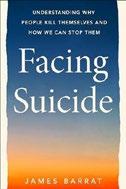
Su icide has become an epidemic with despair and loneliness at the core, says this touching, disturbing study. Journalist and filmmaker Barrat starts with an alarming statistic. Over 45,000 Americans kill themselves each year; suicide causes more deaths than car accidents or homicides. And the number continues to climb. For every person who dies by suicide, there are 10 who try but fail, an astonishing figure. Barrat has
covered this territory before; the book draws on a documentary he made for PBS in 2022. He delves into the reasons for suicide, finding that poverty, substance abuse, financial uncertainty, and loneliness are key drivers. Older white men in rural America are the group most at risk, although Barrat also looks at suicide among teens and veterans and in Black communities. Access to the means of suicide, especially firearms, is a key component. Suicide numbers spike after media coverage of a celebrity suicide, such as that of comedian Robin Williams. It sometimes runs in families, suggesting a possible genetic connection. Barrat devotes a large section of the book to suicide prevention, looking at some of the organizations working in the field. Self-isolation and depression are worrying signs, and giving away possessions is an important red flag. In many cases, a visit from a friend, a family member, or even a stranger with a sympathetic ear can make a huge difference, offering a crucial sense of connection. However, professional help is usually part of the long-term solution. Some of the material here is inspiring, some takes excursions into darkness, but Barrat tackles both aspects of his subject with empathy and intelligence, relating human stories that need to be told. An important, well-considered contribution to a critical topic.
Berger, John & Yves Berger | Pantheon (104 pp.) $25.00 | Nov. 12, 2024 | 9780553387575

A father and son wax euphoric about art. This slight collection of illustrated, wide-ranging letters between noted art critic John Berger (1926-2017) and his painter and poet son, Yves, invites readers into an intimate world of father and son. Yves writes they made “drawings with the same joy and hope we felt when playing ping-pong.” Initiated by John with a response by Yves, the correspondence
bounces back and forth in a reflective, free-flowing manner. John references works by Rogier van der Weyden, Van Gogh, and Goya, among many others, reflecting on their similar spatial perspectives that bring observers directly into the work. Yves responds with a print by Chaïm Soutine, which “offers itself like an open book too.” That observation makes John think of Watteau’s “players and clowns,” while Yves thinks of Max Beckmann, his faith, and his woman wearing a carnival mask. John then brings up Kokoschka, for whom “light is a parting touch” and whose “gaze was like of a migrant bird about to leave.” Yves writes about Giacometti and Schjerfbeck’s self-portraits, closing with a photo of “our beloved Käthe Kollwitz next to one of her self-portraits,” and John compares and contrasts landscapes by Poussin and Zhu Da, especially how each questions the “notion of eternity.” John also invokes the “mystery that art strives to present to us,” while Yves affectionately writes about his father addressing the masters as comrades. Each author reflects on their processes when making art, as well as how to emotionally interpret them. John wonders if painting is the “recuperation of the invisible. Am I that far out?” Yves: “No, Papa, you’re not far out.” The book closes with a number of their drawings, including one Yves drew of his father when he was 10. Whimsical, playful, and ruminative—a testament to the authors’ love of art and each other.
Third Gilmore Girl
Bishop, Kelly | Gallery Books/ Simon & Schuster (288 pp.) | $28.99 Sept. 17, 2024 | 9781668023778

Unassuming show-biz memoir by Broadway and screen veteran Bishop. By her account, Bishop—nee Carole, now
Kelly because, as it happens with so many actors, “Carole Bishop” was
already listed with SAG—has lived a long life with just a few modest scandals: an affair here, a drink or puff too many there. Her best-known credit was courtesy of Amy Sherman-Palladino, who cast her in a role she cherished for years: Lauren Graham’s mother on the beloved TV series The Gilmore Girls , a rulebound patrician who becomes less uptight as the years roll on. Bishop herself played strictly by the rules, at least on screen: she holds that her job as an actor is “to learn my lines and make them work exactly as written,” with no ad libs allowed, thank you. Her dedication to craft is evident, her credentials undeniable, and if the memoir doesn’t have a lot of interior drama, it’s simply because Bishop kept her nose down and worked. She wasn’t particularly lucky in love until finally meeting her soulmate, living happily until cancer took him, on which she writes, affectingly, “Friends who’ve been right by your side through the crisis head home and get back to their lives as they should.…The silence becomes deafening, and the full force of ugly, excruciating, inescapable grief crashes into you.” Rescuing her from grief was old friend Sherman-Palladino, who brought her in for a brief recurring role in The Marvelous Mrs. Maisel . Her agreeable memoir is sprinkled with fun facts, as when she asked Michael Bennett why A Chorus Line (she was in the original cast) was not simply Chorus Line : “Because,” he patiently explained, “when an alphabetical list of Broadway shows is published in newspapers and trade magazines, A Chorus Line will come first.”
Catnip for fans of the title series, and a revealing look at the craft of character acting.

Block, Frederic | The New Press (256 pp.) $27.99 | Sept. 17, 2024 | 9781620978870

A fair-minded federal judge revisits six convictions to see whether he and the system got it right. Block, on the bench for decades, has seen two large movements come and go: in the first, in the 1980s, Congress mandated no-discretion guidelines for sentencing for federal crimes; in the second, after the Supreme Court held in 2005 that those sentencing guidelines were no longer mandatory, federal judges were permitted “to reconsider the appropriateness of a previously imposed sentence and to reduce that sentence, even if the original sentence was lawful.” In some instances, the reduction was permitted because the original crime had been reclassified to be less harshly punished; in others, it was up to Block and his colleagues on the bench to weigh all the facts in the matter and reevaluate. The cases considered and reconsidered here involve murder, drug trafficking, and child pornography; the most notorious, though, is that of Justin Volpe, a New York police officer sentenced to 360 months (it could have been life) for torturing Abner Louima in an incident of official abuse Block sees as a clear precursor to the murder of George Floyd more than 20 years later. Block’s reconsiderations are weighty, revealing a complex and justice-oriented legal mind at work, and some of his determinations will come as a surprise, Volpe’s case in particular. Because only 10% of prison inmates are in for federal crimes, Block urges individual states to establish sentence-review programs of their own. Moreover, he concludes, the entire system must be overhauled so that a sentence does not dog a person for the rest of his or her life. “It is not in anyone’s best interests,” he writes, sagely, “to consign ex-offenders to a
permanent second-class status. Doing so will only lead to wasted lives, ruined families and more crime.”
Of particular interest to prison-reform activists and civil libertarians.
Bone, Eugenia | Flatiron Books (320 pp.)
$28.99 | Oct. 22, 2024 | 9781250885654
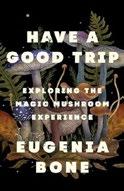
A n intriguing dive into the history and future of magic mushrooms. Food and nature writer Bone begins this book with a disclaimer, saying that it “should not be construed as advocacy for the use of any illegal substance.” It quickly becomes clear, however, that she must have had her tongue firmly in her cheek when she said that. She has consumed a considerable number of magic mushrooms, and her book is essentially about their positive attributes and uses. Although public attitudes toward mushrooms and their active chemical ingredient, psilocybin, have recently become more liberal, there still has not been much scientific inquiry, so Bone depends largely on reports from users and her own experiences. She provides advice on how to induce enjoyable trips and avoid bad ones, examining hallucinations, trance states, and ego dissolution. She devotes a section to obtaining mushrooms, either by harvesting them in the wild or cultivating them from spores, which are readily available. There has been some success in treating PTSD and related mental health issues with psilocybin, she notes, but research is still sketchy. Another potentially valuable use of mushrooms she covers is a procedure called microdosing, which involves taking small, calibrated amounts; it does not send users on trips but can be helpful in easing depression, anxiety, and other ills. There are, according to Bone, many other possible therapeutic uses for psilocybin, but she
believes that “the magic in magic mushrooms is their potential to put you in tune with your true self.”
An interesting and informative guide, replete with insights, knowledge, and even flashes of humor.
Brown, Craig | Farrar, Straus and Giroux (672 pp.) | $32.00
Oct. 1, 2024 | 9780374610920

Fond mosaic of the far-reaching life of the late Queen Elizabeth. A keen observer of the royals, British humorist and prolific author Brown offers a roaming, disjointed collage of Elizabeth II, who died at age 96 in 2022. A symbol, a cypher, and an icon, the queen was the country’s obsession as well as a mirror to its people over her long life. “There are even times I wonder if I know more about the Queen and her family than I do about myself,” Brown writes. Her entire life from birth in 1926 was open to public scrutiny; the first biography about her was published when she was four. “Hers was the most familiar, most photographed face in human history,” he adds. The author devotes many of his short, breezy chapters to encounters with the queen recorded by Kingsley Amis, Jacqueline Bouvier Kennedy, Philip Larkin, Cecil Beaton, and Hillary Mantel, among others: what it felt like to be in the presence of this formidable face, shake her hand, and get caught in terrifying, platitudinous exchanges with her. In her presence, people were often tonguetied or star-struck or got woozy, records Brown, even those as famous as she. Her natural reticence made much conversation awkward, outside of discussing her beloved horses and corgis, but she was dogged in the meet-and-greet until her dying days.
Complimented on her acting in a movie cameo with Paddington Bear in the last year of her life, she replied, “Well of course, I do it all the time.”
Brown does not omit the royal family’s well-publicized scandals, but the tone here overall is appreciative and nostalgic.
A gently satiric reflection, even including dreams, of how the world went gaga for Queen Elizabeth.
Brown, Karen | MIT Press (208 pp.)
$29.95 | Oct. 15, 2024 | 9780262049085
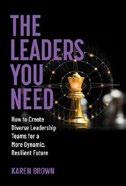
The most effective teams are those with a wide range of faces around the table, says an expert in the field. Brown is a highly experienced consultant who has advised a wide range of companies about implementing programs for greater diversity, equity, and inclusion at the top. In this pithy book she brings together her lessons and gives useful advice on how to develop leadership teams that include women, people of color, and people from the LBGTQ+ community. She acknowledges that in the past creating such teams often failed to improve the company’s bottom line or do much to change the organizational culture. The central problem, says Brown, is that creating a diverse team is often seen as an end instead of a means. There needs to be a deliberate alignment with a business’s growth objectives, which can mean reaching out to untapped customer groups in marginal parts of society. A diverse team at the top also
allows for the building of connections with new stakeholder groups, and custom-designed data systems can be used to track DEI progress and connect it with financial results. One problem with a diverse team is that conflicts can emerge, but it is up to the team leader to ensure that the focus on common objectives prevails. Brown continually emphasizes practical outcomes rather than feel-good gestures, and she accepts that the journey will not be easy. “There is no silver bullet,” she says. Leaders and managers will need to commit to seeing changes through and adapting their approach as the workplace evolves.” The future, she says, is about cultural diversity, and only those companies that embrace it will thrive.
With an eye on what works, Brown provides a map for tying DEI objectives to the bottom line.
Talkin’ Greenwich Village: The Heady Rise and Slow Fall of America’s Bohemian Music Capital
Browne, David | Hachette (400 pp.) $32.50 | Sept. 17, 2024 | 9780306827631

Reviving New York’s spirited music scene.
Browne, a senior writer at Rolling Stone and biographer of many music notables, including Crosby, Stills, Nash, and Young, draws on a wealth of interviews and archival sources to create a teeming history of Greenwich Village from 1957 to the 1980s. By the late 1950s, venues like the Village Vanguard, Cafe Bohemia, the Five Spot, and the Half Note already were famous for jazz, while folk singers drew crowds in
TALKIN’ GREENWICH VILLAGE
Washington Square Park. Soon, Odetta and Dave Van Ronk, Tom Paxton, and Judy Collins, among many others, took the stage in coffeehouses and clubs, drawing throngs of fans. On a snowy night in 1961, a “funny, fumbling, somewhat chubby kid” who called himself Bob Dylan appeared at Cafe Wha?, one of many young upstarts hoping to make a name for himself in New York. “As disparate as the talent in the Village was—oceans of difference between Van Ronk’s gruffness, Dylan’s bristling wheeze, Collins’s purity, and Paxton’s smoothness, to cite a few—one thing bound them together,” Browne writes. “Theirs was music neither as stuffy nor as straitlaced as that of the balladeers who’d preceded them” on those same stages. Dylan was especially influential, with original compositions that inspired others to write their own pieces rather than rework traditional songs. Browne recounts the genesis of groups (Peter, Paul, and Mary; the Roche sisters); the agents who managed them; and the rivalries, love affairs, and musical hits that transformed their careers—in turn, transforming the Village. He recounts, as well, the “wall of segregation” that kept folk music largely white and the government surveillance that threatened the community. Steeped in music culture and lore, Browne offers a detailed, abundantly populated chronicle of a storied place and its creative, outspoken, driven inhabitants. Animated social history.
Bull, Bartle | Atlantic Monthly (576 pp.)
$33.39 | Sept. 10, 2024 | 9780802162502
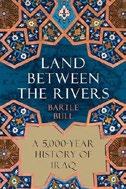
A sweeping history of the cradle of civilization between the Tigris and the Euphrates, underscoring the region’s unique gifts to humanity. As a journalist and longtime observer of the region rather than a historian, Bull conveys the
Useful as a demonstration of AI’s cut-and-paste possibilities, but little more.
DIGITAL DHARMA
excitement of uncovering new intellectual treasures for the reader as he moves from the first Sumerian civilization to the archaeological discoveries at Nineveh in the 1840s. The “land between the rivers” has benefited from but also been ravaged by its singular location between fluctuating empires, Persia to the east and Arabia and Rome to the west. Bull dwells initially on the invention of writing at Uruk around 3300 B.C.E. In the “turbulent, frustrated quest” chronicled in Gilgamesh, an epic probably based on a real Uruk king, builder, and seeker, “we can begin to see the origins of an outlook of free will.” Constant warfare seemed to follow: first with the mighty Assyrian neighbors; then the formidable empire of Cyrus the Great of Persia; followed by Alexander, who spread Hellenistic culture throughout the region. Ultimately the birth of Islam, and the subsequent split between Sunni and Shia, led to the formation of the modern Middle East. But first Bull delineates the culmination of all these cultures’ rich cross-pollination in “the glory of medieval Islam” (850 to 1150 C.E.) and the transmission of “the Iranian genius” across the region. He explains how an impecunious Briton named Austen Henry Layard finally managed to get backing from England’s ambassador to the Ottoman Empire to dig up ruins of ancient Mesopotamian civilization, which “rewrote the history of the world” in the mid-19th century. Bull fast-forwards from there to the crowning of King Faisal I in 1921, then to Iraqi independence, eclipsed by the bloody coup of 1958. Engaging research and bottomless detail by an avid observer and student of the region.
Carlin, Peter Ames | Doubleday (464 pp.)
$32.00 | Nov. 5, 2024 | 9780385546942

How four college-town scenesters became unlikely million-sellers and the center of the ’90s zeitgeist. For most of its 30-year run, R.E.M. enjoyed a charmed life. Formed in Athens, Ga., in 1980, its four members (drummer Bill Berry, guitarist Peter Buck, bassist Mike Mills, singer Michael Stipe) pursued a slow but steady climb to national attention, getting early singles to the right critics, touring constantly, and landing on a major label while controlling their egos and maintaining their artistic integrity. Stipe’s gnomic, often-mumbled lyrics were hard to parse, but the band was expert at sly, jangly hooks; by the end of the decade they’d enjoyed hit singles and topped the album charts with 1991’s Out of Time. Music journalist Carlin ably chronicles the band’s climb and thoughtfully contextualizes it within larger social and political trends in the country. (He suggests that R.E.M., as vocal progressive activists and standard-bearers for Reagan-weary Gen Xers, helped deliver Bill Clinton to the presidency.) Charmed lives don’t always make for dramatic biographies, though. Perhaps because band members declined to be interviewed for the book (Buck confirmed some details), Carlin adheres to a straightforward narrative of the band moving from strength to strength. Bumps in the road—a brain aneurysm that sidelined Berry and his departure from the band, a sexual harassment
accusation against the band’s longtime manager—are dealt with crisply and mainly as evidence of the band’s indomitability. To fill out the story, Carlin attempts to interpret Stipe’s lyrics, sometimes questionably. By the book’s end, the band still feels somewhat unknowable, and Carlin doesn’t explore their legacy following their (amicable) 2011 breakup. They started out strange and hard to interpret—and still are. A well-researched but by-thenumbers biography.
Chopra, Deepak | Harmony (240 pp.) $28.00 | Sept. 17, 2024 | 9780593797525

Another exercise in cracker-barrel spirituality from New Age guru Chopra. Why worry about AI? By Chopra’s lights, artificial intelligence “has the ability to make your thinking more intelligent and your inner life more conscious.” Marveling at the fact that AI efficiently rendered one of his YouTube videos into a Hindi translation without a lick of effort on his part—and apparently effortless enlightenment is a selling point here—Chopra sings the praises of the machine as an agent for personal growth and, moreover, an agent that, though perhaps it shouldn’t supplant sessions with “your personal therapist,” can distill the wisdom of the ages into a few guiding maxims. To his minimal credit, Chopra at least recognizes that the machine itself doesn’t have consciousness or “spiritual wisdom,” but it can create abstracts of a huge library of it “with amazing speed and distill centuries of teaching into simple, clear ideas.” Voilà: instant karma and effortless dharma, a dumbing-down that Chopra further dumbs down with his relentless cheerleading. It’s the machine that does most of the work in this book:
Chopra asks ChatGPT and other engines a question or gives it a directive such as “Give seven bullet points to indicate the major benefits of meditation.” Wait a beat, and the machine spits out a list that includes the nostrum, “Meditation can help alleviate insomnia and improve sleep quality by calming the mind and reducing racing thoughts that often disrupt sleep.” Given that half of the book is machine generated, one wonders if AI is getting a share of the royalties. The question that’s truly asked and answered is this: Since the machine can generate canned spiritual instruction for anyone who asks, it would seem that a book such as this will soon be redundant, if not already so.
Useful as a demonstration of AI’s cut-and-paste possibilities, but little more.
Downing, Taylor | Pegasus (352 pp.)
$29.95 | Dec. 3, 2024 | 9781639367542
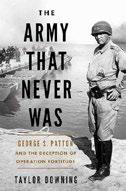
A well-researched military history about how getting your enemy to look in the wrong place can be the key to victory. Sun Tzu once wrote, “All warfare is based on deception.” This concept formed the basis of Operation Fortitude, a strange undertaking that played a pivotal role in the D-Day landings of World War II. Cambridge historian Downing, author of The World at the Brink, Spies in the Sky, and Churchill’s War Lab, among other works of military history, draws on recently released documents and ably draws all the narrative threads together. The aim was to make the Germans think that the invasion would take place in Pas-de-Calais, not Normandy. The Allies built fake tanks, trucks, and airplanes from wood and canvas; troops marched back and forth, pretending to be a large army, and soldiers pushed out radio
signals. The most convincing piece, however, was the “commander,” Gen. George S. Patton. He had established himself as a brilliant tactician but had caused serious problems for Dwight Eisenhower when he slapped several American soldiers suffering from battle trauma. Threatened with exile, he threw himself into the new role with gusto, making speeches and swaggering around with his pearl-handled revolvers and polished helmet. Even when the invasion was underway, some German generals still believed that Normandy was a diversion and the real attack was yet to come at Pas-de-Calais. Downing has a good time with his cast of colorful characters, but he sometimes seems surprised that the ruse was so successful: “A small group of men and women in a few top-secret planning departments, supported by a few hundred model-anddummy-tank, aircraft-and-landing-craft makers, several hundred signallers, a top American general and his staff… managed between them to keep a German army of 140,000 kicking their heels in the Pas de Calais.”
A remarkable war story told with clarity and wit.
Dunak, Karen M. | New York Univ. (368 pp.) $30.00 | Nov. 12, 2024 | 9781479830565

Sociological attempt to situate the different “Jackies” amid the country’s hopes and fears during a fraught time.
Historian Dunak (As Long As We Both Shall
Love: The White Wedding in Postwar America) takes an academic approach to the nation’s obsession with Jacqueline Bouvier Kennedy Onassis (JKO, as she is generally called), seeing her as a mirror of how American ideals of womanhood evolved over the decades. The author’s thorough coverage moves through stages starting from JKO’s days as an “Inquiring Camera Girl” at the Washington
Times-Herald , to her years first as a senator’s wife and then as first lady, to her time as a tragic widow and national icon, to the second marriage that made her a “Fallen Queen,” and into her final decades as a professional woman in her own right. “JKO often served as a barometer for articulated and idealized views about American women— how they should behave, what they should value,” Dunak writes. Drawing on a wealth of research and archival sources, the author combs media coverage and private and public accounts of JKO over her lifetime (1929-1994) and reveals how she “met expectations of…womanhood, and then she subverted them.” For example, she was ultrafeminine and stylish as Kennedy’s wife yet had worked before marriage, preferred riding horses to campaigning, and smoked cigarettes, rather scandalously. She was nothing like previous matronly first ladies, such as Mamie Eisenhower, embodying instead the youthful cultural elegance emerging in the 1960s. Kennedy’s team soon learned that her common-man touch could be Kennedy’s best political asset. After the assassination, she was universally admired for the majestic way she handled the aftermath and funeral. Yet her resistance to taking up the liberal causes of the dead president, her seeming recession into the life of a rich, frivolous socialite, eroded public sympathy. Marriage to Ari Onassis shortly after Robert Kennedy’s assassination shocked the nation, yet it was the beginning of JKO’s emergence as her own person. Although always a symbol of the nation’s cultural expectations, she claimed her right to her autonomy. Astute observations on an iconic figure who is apparently of perennial interest.
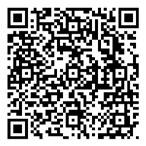
Fingersh, Julie | Rowman & Littlefield (264 pp.)
$28.95 | Oct. 15, 2024 | 9781538195284
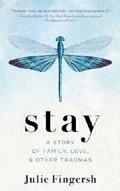
At 50, an aspiring writer confronts painful challenges in her past and present. Fingersh’s memoir weaves together three topics—memories of her younger brother’s mental illness and death at 26, her bitter sense of failure and struggle to reconnect with her lost promise, and the serious health problems that emerge for her 18-year-old daughter during her freshman year of college. From the start, our ability to get into her account is hampered by her self-presentation, which alternates between dramatic intensity and not-that-funny self-deprecation. On the first page of the first chapter, for example, she announces, “For almost twenty years, I thought I’d been a pretty great parent. But in the past several months, I’d ventured into new and ugly territory—so ugly that it was polluting my psyche, so shameful I hadn’t told a soul.” Did she murder someone? No, actually, she felt pangs of jealousy when her daughter scored a cool internship. Putting this inner torment about her lost potential as a writer in the foreground of a book-length memoir creates a somewhat off-putting focus on how the sausage gets made. Repeatedly telling us that she is a cliche (“ I am a walking cliché,” “I was like a literal cliché,” etc.) doesn’t help. Fingersh admires people with great chosen names, like Cheryl Strayed, Bob Dylan, and Lady Gaga, but
won’t change hers: “Personal principle,” she explains. “Self-deprecation had grown around my bad last name like a birthmark.” Like a birthmark that grows, perhaps. The more effective storylines in the book are the moving, carefully told narratives involving her brother and daughter, where Fingersh is able to push her fraught self-concept to the side a bit. Fortunately, it all makes sense in the end, thanks to revelations found in EMDR therapy.
If you do what the title asks, which takes fortitude at times, the ending is uplifting.
Kirkus Star
Fisk, Robert | Harper360 (672 pp.)
$40.00 | Oct. 8, 2024 | 9780007255481

Journalism morphs into history in this collection of the late Irish writer’s essays on the Middle East.
“I met Osama bin Laden three times,” writes Fisk, “once in Sudan and twice in Afghanistan, and he became a kind of albatross for me.” Called on frequently after September 11 to comment on the founder of al-Qaeda, he laments not having given more credence to bin Laden’s pledge to reduce the U.S. to “a shadow of itself.” Still, Fisk, who reported on the Middle East for The Independent and other UK publications for nearly half a century, allows that bin Laden had a point: the democracy-touting West came storming in after 9/11, overturning the
An incisive view of the Middle East that won’t please the Pentagon or veterans of the Bush and Blair administrations.
regional balance of power. As it did so, according to his account, its actions lost any claim to the moral high ground. Fisk was one of the first to document atrocities on the part of U.S. and U.K. forces, writing sadly, “This was us. These young soldiers were our representatives in Iraq. And they had innocent blood on their hands.” The overall effect of Fisk’s present-tense historical writing—he holds a doctorate in history and is able to make deep connections between present and past—is to underscore the dangers of making too many assumptions about a much-assumed-about region. Suicide bombers, for instance, don’t bomb for the fun of it, but neither do they do so because high on drugs, brainwashed, or insane; it’s because they are committed enough to their cause to die for it. Fisk’s overall conclusions, reached as the Syrian civil war blossomed, are glum: The Arab Spring is dead, the West lost, Russia and Iran won. But, he adds hopefully, “wars come to an end. And that’s where history restarts.” An incisive view of the Middle East that won’t please the Pentagon or veterans of the Bush and Blair administrations.
Frank, Edwin | Farrar, Straus and Giroux (480 pp.) | $32.00 Nov. 19, 2024 | 9780374270964

A history of the 20th-century novel that examines, contextualizes, and draws connections among work by more than 30 authors.
Frank, editorial director of New York Review Books, presents his essays in three parts, chronologically ordered. The text, he notes, is a working example of “descriptive criticism, as practiced by such critics as Clement Greenberg, Randall Jarrell, Pauline Kael, Elizabeth Hardwick, and Greil Marcus.” Following a preface about Dostoyevsky’s Notes From Underground (1864), which “resembles nothing so much as a swept-up
heap of broken glass,” the first section encompasses works from the last few decades of the 1900s through the end of World War I, including titles by Wells, Proust, Joyce, and Thomas Mann, whose book The Magic Mountain (1924) Frank deems “a new form of the twentieth-century novel, a form born of the war whose new significance could only be fully appreciated after the war.” The middle, beginning with Mrs. Dalloway, covers a “period of astonishing invention.” In the final section, the author examines the novels of the mid- to late 1900s, from Things Fall Apart to One Hundred Years of Solitude and beyond. Frank is a dogged enthusiast whose optimism almost always wins out, often for reasons related to positive emotions. Writing about Kafka’s Amerika, for example, he comments, “The book is one ongoing disaster, yet much of it is oddly cheery in tone.” Frank’s curiosity and scope are both admirable, and his prose style is consistently punchy, despite some repetition—e.g., “Kipling was a restless man”; “Thomas Mann…is a restless man”; D.H. Lawrence was the “most restless of writers.” The most controversial thing about this book may be the appeal that it makes for its own existence. While it may strike some as gratuitous, devoted literature fans of canonical literature will relish it. Academic yet accessible, with special appeal to avid readers of classic lit.
Gerner, Marina | Sourcebooks (416 pp.)
$27.99 | Sept. 17, 2024 | 9781728263304
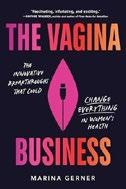
How women entrepreneurs are creating techbased solutions to enhance female well-being. Women’s health issues have long been neglected by both medical science and society, and the taboos still surrounding the word vagina make frank discussions
difficult. In this refreshingly forthright book, financial journalist Gerner explores how gutsy female innovators working in femtech—an emerging technological field that focuses on “maternity, birth, periods, sex, menopause, fertility, and contraception”—are disrupting a health care system built to the measure of men. Stigma and a lack of understanding of female bodily functions are just two of the many hurdles femtech entrepreneurs face. Perhaps the most daunting barrier, though, is finding money to fund projects, since almost 90% of venture capitalists are men. Despite these difficulties, Gerner shows that women entrepreneurs are building profitable companies that specialize in everything from smart bras, period-tracking apps, and AI-powered vibrators to a nonhormonal liquid contraceptive gel and user-friendly artificial insemination devices. Those innovators with a bent for social justice are using technology to create tools that assist rural and/or low-income females. Three who call themselves “Synergistic Sisters in Science” have developed an app to assist pregnant women of color monitor health indicators and find “resources and peer support” as more and more “maternity care deserts” emerge across the United States. Gerner’s personal passion for the subject is clear in the many interviews she incorporates throughout the book with entrepreneurs and femtech innovators from the U.S., Europe, and Asia. As it redefines the “archetype of female entrepreneurship,” her highly readable book offers hope for positive new ways of not only thinking and talking about female bodies but also improving health outcomes for women worldwide.
Energetic, thoroughly engaging reading.

Gordon, Bruce | Basic Books (528 pp.)
$35.00 | Sept. 17, 2024 | 9781541619739

A global history of the Bible.
Church historian Gordon describes for the reader a sacred book that seems to take on a life of its own. Through two full millennia, the Christian Bible has survived, thrived, and acted as both a holy object and a cultural force. Gordon notes that early Christians “would participate in a communications revolution,” a revolution that continues to this day. Adopting the codex as their chosen medium, Christians would, over the course of several generations, craft a canon of scripture that would survive cent uries of cultural fragility in Europe. From the fifth century on, Gordon writes, “the Bible itself became an object of veneration. [It was] the ultimate symbol of the sacred…Christ’s physical presence in the world.” With new technology and the Protestant Reformation, the Bible would move beyond the church and monastery and into the home. No version of the book reflected this cultural sea change more than the King James Bible, which came to dominate the English-speaking world and influence missionary activity outside of it. Spreading into Asia, Africa, and elsewhere, the Bible would be influenced by new, global voices. Gordon describes the story of the Bible as “the story of a life force” and mystically concludes that “the Bible dictates its own history, which is without end.” He has written an approachable history suitable for lay readers, but it adds nothing significantly new to the sizable corpus of works on the same subject. To mention just two examples, Karen Armstrong’s The Bible (2007) provides a more academic viewpoint; John Barton’s A History of the Bible (2019) offers a more critical reading of the Bible’s background. Serviceable but not particularly original.
Graham, Elyse | Ecco/HarperCollins (400 pp.) $35.00 | Sept. 24, 2024 | 9780063280847

Bookworms become spooks in this engaging study of wartime American intelligence. Spies aren’t always James Bond types, historian and Stony Brook professor Graham notes; some of the earliest members of the World War II–era OSS were literature professors, librarians, and researchers whose common denominator was bibliomania. Founder William Donovan, a lawyer and a passionate book collector, inaugurated a division called Research & Analysis, which “represented something new in the world of spycraft,” its scholarly staff charged with researching subjects thoroughly before action was taken. One of Graham’s heroes, a formidable woman named Adele Kibre, “dark-haired, wicked-eyed, a classicist by training,” logged time in Stockholm acquiring European publications for OSS analysis, including, thanks to her wooing various Nazi officials, plenty of books and papers from the Third Reich. All of Graham’s bookworm subjects trained in the dark arts of assassination and disguise, and while many operated in plain sight of the enemy in neutral countries such as Sweden and Turkey, others went deep undercover. Some are relatively well known, such as the assessors who examined stolen Nazi art to return masterworks to their homes. Others figure in the history of
scholarship but are little known today, such as the egomaniacal anthropologist Carleton Coon, whose racist theories gave aid and comfort to Nazi theorists but who served in the OSS all the same. Of all the figures in the book, Kibre is the centerpiece, and Graham does good service by highlighting her work and skills, which included concocting whatever persona appealed most to whomever she was dealing with. Graham closes with a note about how some of the scholars helped shape the successor CIA, and she makes a good case for studying the humanities as both an instrument of learning and a weapon of war.
Bibliophiles with a taste for cloak-anddagger work will enjoy this lively book.
Gross, Kali Nicole | Seal Press (256 pp.) $28.00 | Sept. 24, 2024 | 9781541603462

An examination of Black women taking the law into their own hands in late19th- and early20th-century Philadelphia.
Focusing her attention on a period in which justice “didn’t exist for Black women,” the author of A Black Women’s History of the United States explores “the extremities Black women used to escape total victimization.” The book is organized into five chapters, beginning with one on specific acts of revenge for physical and verbal abuse. This is followed by a study of laws that sanctioned enslavement and Black
Bibliophiles with a taste for cloak-and-dagger work will enjoy this lively book.
BOOK AND DAGGER
women’s sexual abuse and their ensuing effects. The middle of the book unpacks two cases in which Black women faced the death penalty for murder. One of them, Lillie Fisher, fatally stabbed her lover in 1900, claimed self-defense at trial, and was acquitted by the jury, which was unusual. “Black women often battled on two fronts,” Gross writes, “against direct attacks but also the legal system itself in the aftermath.” Chapter 4 turns to female thieves (aka badgers) who posed as prostitutes in order to rob the white men who hired them, thereby weaponizing stereotypes about them. The final chapter covers abortion and infanticide—the consequences, Gross argues, of “an interwoven, restrictive set of religious, social, financial, and legal realities—all of which solidified to form a near unfathomable, combustible mix of fear, desperation, and resentment.” Acknowledging that “vengeance feminism is not healing or productive in the conventional sense,” she offers a compelling case for the women who went to violent and/or criminal lengths to stand up for themselves, particularly at a time when they were offered virtually no systemic protections. “Even when our backs are up against the wall,” she writes in the conclusion, “losing is not a foregone conclusion.” While sometimes repetitive, the book’s focus is sharp, and the subject merits attention. Explosive and compelling.
Hochschild, Arlie Russell
The New Press (400 pp.) | $30.99 Sept. 10, 2024 | 9781620976463
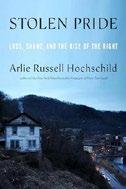
Wounded feelings give way to nationalist, supremacist politics in Hochschild’s “what went wrong with Appalachia” autopsy. Appalachia was once a region of union labor activism, progressive social programs, and an openness to working
with people from other countries. Most of the region went for Roosevelt—and Carter, and Clinton. But then, sociologist Hochschild writes, something changed: the mines closed down, the small towns died, many of the remaining residents turned to self-medication, and suddenly Appalachia was Trump country. Hochschild traces this turn in part to what she calls the “pride paradox,” by which the satisfaction in hard work well done is replaced by existential despair over losing usefulness and meaning. “People devised various ways to respond: turn shame inward, project shame outward, or find a creative solution to the paradox,” she writes. The middle proposition turns out to have been the most widespread: people in the region, and by extent people in overlooked rural enclaves across the country, now blame others—immigrants, liberals, urban elites—for their woes. This manifests in racism and fascist displays: Hochschild’s opening set piece is a pre-Charlottesville march of white supremacist radicals in a little Kentucky town seething with resentment at being seen by the world as disposable yokels. The real perpetrators, the extractivist multinationals and big pharma moguls, go unquestioned, while Trumpism triumphs because in a psychologically wounded community such as Pikeville, Kentucky, as one counselor notes, “That guy’s selling white nationalism as a quick fix to make a guy who’s down on himself feel like he’s strong and going places.” Hochschild counsels a wide-ranging solution that could use more specific grounding, but that points to a useful direction, involving rebuilding rural America “both by revising the American Dream and by equalizing access to it.”
An insightful, troubling look at political resentments in the forgotten heartland.

Howard, Jules | Pegasus (272 pp.)
$29.95 | Sept. 3, 2024 | 9781639367740

Most animals begin as eggs, and this is their story. British science writer Howard, author of Death on Earth: Adventures in Evolution and Mortality, suggests that animals are simply vehicles to produce more eggs, and then he makes an entertaining case for that proposition. Life began nearly 4 billion years ago, but eggs came late. Until about 650 million years ago, tiny organisms often walled themselves off from a hostile environment in a mostly impermeable cyst, ready to reactivate when the good times came back. Beginning at this period their fossils began to reveal tiny collections of cells that resemble embryonic structures that will develop into new life. These were the first eggs, likely from ancient jellyfish and their kin. Working chronologically, Howard writes that by the Devonian Period, about 400 million years ago, “the egg had evolved a new place to hide in the ocean; no longer only found in pouches, or glued to rocks, the egg now occupied a new, secure space, inside the body of the female fish.” Many remained long enough to hatch, and this is not a modern development; live births are common in insects and ancient sharks. Land animals flourished well before the Permian Period (roughly 300 million years ago), which also saw the appearance of the amniotic egg that contained fluid-filled membranes surrounded by a hard cell to protect the embryo, allowing it to be laid on dry land. The egg reached its epitome in the mammal placenta, “the life-giving interface between mother and offspring,” allowing passage of energy and oxygen and extraction of waste but keeping what is essentially a foreign body separate from the mother’s immune system. Animal evolution is a snap compared to the minutia of animal physiology, but Howard has done his
homework and delivers a painless but lucid education on a central feature of life. High-quality natural history.
Hunter, Robert | Hachette (304 pp.)
$32.00 | Oct. 8, 2024 | 9780306835155

Grateful Dead lyricist Hunter recounts the dawning days of 1960s San Francisco, with hippiedom still on the horizon.
In 1958, Hunter moved from the East Coast to San Francisco, where he quickly fell in with “a proto-beatnik” named Jerry Garcia who “played the guitar anywhere from twenty-four to thirty-eight hours a day,” working his way through the folk songbooks and bluegrass standards to a kind of jazz that would, in time, form the underpinnings of the Dead’s eclectic psychedelic sound. That was years off, though, and in the meantime Garcia and Hunter would carve their niches into a Beat community still very much alive, guided along by Kerouac and Ferlinghetti and company. Garcia, writes Hunter, was nothing if not single-minded about his music and his ideals, “and if he trod on toes, it was not from malice but because the concept that there were toes other than his had not fully entered his mind.”
Because the Merry Pranksters were yet to come along and drugs hadn’t entered the scene, writes fellow Beatnik Brigid Meier in a lovely afterword, “spontaneous dada zaniness was highly prized as a ‘high,’” with many goofy adventures in North Beach and Golden Gate Park ensuing. In one, a woman could announce that it was time for the gang to load up on cigars. In another, a barely 20-year-old Garcia could reveal what turns out to be a fairly innocent method of seduction: “sing, smile, and nod. Works damned near every time.” Retrieved from a long-forgotten drawer, Hunter’s memoir has a few suitably postadolescent awkwardnesses of its own,
but it’s mostly charming, a portrait of young people committed to creativity but not, unlike their later peers (and in many cases later selves), to self-destruction. An essential document in the Deadhead library, and a pleasure to read.
Kirkus Star
Wild Chocolate: Across the Americas in Search of Cacao’s Soul
Jacobsen, Rowan | Bloomsbury (288 pp.) $28.99 | Oct. 8, 2024 | 9781639733576
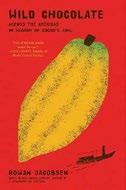
A spirited quest for the perfect cacao bean. Food journalist Jacobsen opens his comprehensive account in Oaxaca, Mexico, not far from a source of cacao and its resulting chocolate, so prized by the Aztecs that they expanded their empire far from its heartland to gain control of the Pacific coastal region where it grew. All cacao is, he writes, “ridiculously rich,” with a fat content of at least 55 percent, but some of the world’s most prized cacao, found in remote tropical forests from Mexico south to its homeland in the Bolivian jungle east of the Andes, is far richer still. These hard-to-find “wild cacao” plants fuel the gourmet chocolatiers of the world, such as the Swiss producer Felchlin, supplied by a German agronomist in Bolivia who built and lost a fortune in the chocolate trade but, for all his travails, can’t stop searching for the cacao grail. Jacobsen goes far afield himself, meeting some wonderfully weird characters and tracing their finds to chocolate makers in the U.S. and Europe. A skilled food historian with a sharp eye for the economics of the delicious, he also peppers his prose with interesting tidbits, including the boom-and-bust ways of lumpen chocolatiers like Hershey, which once commandeered the entire cacao output of Belize but then, when market conditions changed, left growers
holding the proverbial bag. Of particular interest to budding entrepreneurs is the fact that several of Jacobsen’s subjects are young women who have carved a place for themselves as brokers for the organically grown, sustainable cacao whose growers are paid a premium. There’s plenty of adventure left in the game, Jacobsen writes: “In all likelihood, the Amazon and other remote corners of Latin America harbor other unique families of cacao waiting for their big moment. The search continues.”
A treat for literate, adventure-loving foodies, best accompanied by a bespoke chocolate bar.
Jaffe, Sarah | Bold Type Books (400 pp.)
$30.00 | Sept. 10, 2024 | 9781541703490

Labor journalist Jaffe delivers a searching meditation on grief and its misapprehensions. The world is burning—literally, with climate change remaking the planet and pandemics and political violence upending the nations. Against this backdrop, Jaffe posits, her private griefs are not lessened, but they stand in a kind of communion with the grief experienced by so many others: grief born of the death of loved ones, of injustice, of the need to leave one’s country and flee to another. Such griefs, Jaffe writes, constitute “a sudden, abrupt, even violent break from the status quo”—and if there’s anything capitalism hates, it’s a departure from the status quo and the demands that owners make on the worker bees’ lives, without time allotted for grieving but “only to attend a funeral.” Though her musings never quite cohere into a manifesto as such, Jaffe’s book constitutes an informal set of philosophical propositions: Capitalism wants us to be monads, easily separable, in a society that “hasn’t been set up to understand collective decisions”; because grief is
universal, it is definitively collective; therefore, as one therapist tells her, “We’re communal beings. We should be heartbroken for each other.” Whether that sense of broadly distributed grief can do anything to lessen individual sufferings is a point of debate, but certainly it invites the reader to summon more empathy upon learning of the death of a friend’s pet, the loss of a job, the failure of a marriage. All of this hinges on a perhaps unexpected outgrowth of grief, namely hope in the form of the realization that we have no control over the world—but, even so, “changing the world is a process that will require many of us imagining and struggling together.”
A fresh way to look at the psychic pains that we bear mostly alone—and unnecessarily so.
Janovy, John | Sourcebooks (336 pp.)
$17.99 paper | Aug. 20, 2024 | 9781728292526
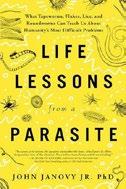
An academic explores the science and relevance of parasitic invaders. Janovy, emeritus biology professor at the University of Nebraska-Lincoln, believes these “animals that live in and on other animals” can be studied for the lessons to be learned from their biological and behavioral activity. He expounds on a “general theory of infectivity” in chapters introducing a team of parasite hunters who study the life cycles, transmission, and resilience of parasites, predominantly ones not found in humans. Among them is a microscopic fluke found in the ovaries of buffalo fish in a lake in northern Texas and southern Oklahoma that has persistently baffled and subsequently outlived generations
of scientists. Elsewhere, Janovy compares the plains killifish and the free-swimming larval worms that follow it to social media platforms such as Tik Tok, all of them successfully dealing with—and seeming to thrive on—constant change. Janovy’s professional research is impactful and relevant; having spent “many hours with mosquitoes and starlings,” he equates their official designation as detrimentally “invasive” and predatory to the ostracizing of queer, immigrant, and ethnic communities. Other studies correlate human behavioral aberrations with infectious agents like Covid-19. Janovy introduces parasitologists who scrutinize the parasitic life cycle, and he draws correlations between the invasive activity of biological agents and the “parasitic ideas” that can infect cultural ecosystems with “perceived economic and cultural threats.”
Drawing on previously published resource material, a half century of biological scientific experience, and academic observational research, Janovy attempts to make “mental extensions” connecting his research to the influence of biological (and social) parasitism on everyday human life in terms of abundance, diversity, and methods of survival. Readers intrigued by the intersection of science and society will be particularly interested in this verbose but generally cohesive study connecting the biology and behavior of parasites to human nature. Dense with digressions but intermittently fascinating.

For more by John Janovy, visit Kirkus online.
Lemann, Nicholas | Princeton Univ. (168 pp.) $22.95 | Sept. 17, 2024 | 9780691246765
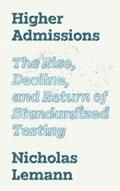
Rethinking educational opportunity. New Yorker staff writer and journalism professor Lemann, author of a previous title on the SAT (The Big Test), contributes to Princeton’s “Our Compelling Interests” series by addressing the problem of access to higher education. With some selective colleges and universities reinstating the standardized SAT as an admissions criterion (after dropping the requirement during the Covid-19 pandemic) and with the Supreme Court ruling against affirmative action, his examination is timely. Lemann’s detailed history of the development of the SAT, first administered in 1926, depicts the test’s creators as aiming to create “a more democratically selected educated elite.” But he cites many studies to show that test scores are highly influenced by socioeconomic status, therefore reinforcing class differences. Furthermore, the SAT serves as a poor indicator of college success, adding little to what is learned from the high school transcript. The SAT’s predictive ability, he reveals, is highest for the short term, falling off over the full length of college. While arguing for tests that reflect learning and achievement rather than the SAT, Lemann raises two overarching questions: What is meant by merit? What is the purpose of access to education? Only a minority of students go to selective colleges, Lemann reveals: “The widespread administration of the SAT to millions of people in order to identify a relative
handful to admissions officers at highly selective colleges” makes no sense. “The most obvious problem in American higher education today,” he argues, is “its failure to produce a more widely successful experience for most students.” Fulfilling that goal requires enacting aggressive reforms in the K-12 years geared to equipping “as many people as possible for as broad a set of life circumstances as possible.” Lemann’s cogent argument, along with three responses from educators, offers thoughtful reading for teachers and policymakers.
A well-informed critique.
Lewis, Sarah | Harvard Univ. (400 pp.)
$35.00 | Sept. 17, 2024 | 9780674238343
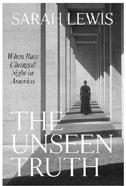
A n art and cultural historian spotlights racial propaganda fueled by willed blindness. Drawing on abundant scholarship, Lewis investigates images that contributed to Americans’ conception of race from the Civil War through the Jim Crow era. She focuses particularly on the connection made between whiteness and the Caucasus, a region that waged a war against Russian incursion from 1817 to 1864. Americans were hugely sympathetic to the Caucasus, which a prominent 18th-century German naturalist had argued was the “homeland of racial whiteness.” In a society consumed by “the urgent need to shore up the idea of race,” Caucasian came to be conflated with white, a concept that persisted despite stark visual evidence to the contrary. Lewis examines a range of images—paintings, sculpture, and photographs—to reveal how “the tactics of unseeing” enabled this racial fiction to be “hardened into foundational fact.” Women from the Caucasus, for example, were reputed to be the most beautiful in the world, a belief that P.T. Barnum
I’M SORRY FOR MY LOSS
exploited by exhibiting “Circassian Beauties” in his various venues. Images of the Caucasus circulating after the Civil War revealed a racially mixed population, and by 1876, another conflict, which Americans called a “Mahomedan revolt,” recast the region as Muslim and Asian, “a place filled with ‘alien racial elements.’” Nevertheless, the definition of Caucasian as European white, at the pinnacle of the racial hierarchy, was underscored by many, including Woodrow Wilson. This arch-segregationist’s racist policies were abetted by what Lewis terms visual “racial detailing…assessment filtered through brutal stereotypes and narratives” and a malignant precursor to today’s racial profiling. A fresh, authoritative historical inquiry.
Little, Rebecca & Colleen Long Sourcebooks (496 pp.) | $28.99 Oct. 1, 2024 | 9781728292755
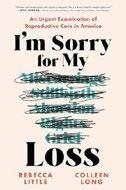
Two journalists examine the meaning of pregnancy loss in American culture and their own lives. Giving birth to stillborn babies taught authors Little and Long one very painful lesson: “America is bad at talking about pregnancy loss.” It also showed them that pregnancy loss silence concealed other interconnected issues like miscarriage, abortion, and grief that profoundly impacted maternal lives. In this book, Little and Long use their experiences—and those of the many individuals they interviewed—as launching points into a larger discussion about reproduction and reproductive care
in the United States. They argue that the great wall of silence they and others encountered derives from language that does not adequately do justice to the multifaceted nature of pregnancy loss. Indeed, any words that do exist “are strictly clinical or infused with stark political baggage.” They further observe that the overwhelming sense of failure that often accompanies such loss can be attributed to a system that—even in the more liberal Roe v. Wade era—emphasized the idea that “all kept pregnancies were wanted.” Miscarriage, like abortion, was therefore and implicitly a mother’s fault, an idea that kept women from speaking out about both for fear of being stigmatized. Now, in a hyperpunitive post-Roe era, discussion of miscarriage and abortion as part of the same reproductive spectrum is especially fraught, even though one might look like the other and be treated by the same methods. The authors point out that people are still finding the courage to share their experiences and grief through social media, but post-loss mourning is still viewed as a “malady” rather than a natural process. Sobering and well researched, this book lays bare major fault lines in a maternal reproductive care system in dire need of radical transformation. Necessary, thoughtful, and heartfelt.
Lockwood, Matthew | Norton (176 pp.)
$22.00 | Oct. 15, 2024 | 9781324073871

An examination of the travels of both famous and lesser-known individuals that seeks to redefine the meaning of exploration. The impulse to explore is as “universal” as it is key to understanding history and the human condition, avers
Lockwood, a history professor at the University of Alabama. Yet history has too often flattened exploration narratives to focus on specific individuals (white males) and motivations (economic gain and/or political interest). Analyzing Sumerian, Sinhalese, Greek, Hopi, and Aztec legends, Lockwood suggests that all these imagined journeys echo humanity’s original travels out of Africa. But even when explorations such as those undertaken by Venetian Marco Polo to China and Uyghur monk Rabban Bar Sauma to Europe are documented, the actual explorers tend to “become legends themselves.” Those legends in turn inspired both European and Chinese explorers to embark on voyages across open seas that would lead to what Lockwood calls “the age of convergence.” Some, like Christopher Columbus, dreamed of New World riches and glory; others, like naturalists Alexander von Humboldt, sought to understand the natural world of the Americas. While the knowledge gained and exchanged on these journeys led to narratives that “were used to justify imperialism and exploitation,” Lockwood argues that counternarratives emerged from explorers who used travel “to interpret the world and its peoples in altogether different ways.” Lady Mary Wortley Montagu, for example, used her insights into Middle Eastern culture and health practices to refute stories of Eastern salaciousness and to help Europeans fight smallpox. And Matthew Henson, the African American sharecropper’s son who accompanied Robert Peary to the Arctic Circle, transformed the act of journeying into the ultimate statement of freedom and self-determination. As it thoughtfully demystifies and democratizes the concept of exploration, Lockwood’s book reminds readers that discovery itself is “not unidirectional and never belongs to a single group of people.”
Engaging and thought provoking.

For another unconventional history of explorers, visit Kirkus online.
Maxwell, Abi | Knopf (320 pp.)
$28.00 | Sept. 17, 2024 | 9780593535844

Being different in America.
In an affecting memoir, novelist Maxwell recounts years of frustration, rage, and sadness as she and her husband fought for support—from schools, neighbors, and the community— for their transgender child. The couple was living in the idyllic New Hampshire town of Gilford when their son was born. The difficult infant grew into a “brilliant but angry” young boy, whose tantrums and behavior problems finally led to a diagnosis of autism. The Maxwells faced bureaucratic obstacles in finding special services at school, and soon more challenges arose: their son chose pink sneakers and opted for a witch’s costume on Halloween, inciting malicious gossip in a town that held to rigid gender conventions. Even more shocking was the full transition that their child made in first grade. She was now Greta, and, for the conservative community, she was a problem. Maxwell testifies to responses that ranged from condescending to belligerent, as parents and school administrators focused on bathrooms for transgender students, eligibility for sports teams, and controversy over adopting policy to end bullying. At one point, the superintendent ruled that the word transgender could be used only in private conversation with Greta, but never in a public setting. Interwoven with Greta’s story is the plight of Maxwell’s younger, gay brother, who attempted suicide because of the homophobia he faced. To protect their daughter from that mental anguish, the Maxwells planned to move to Montana, which they thought would provide a more accepting environment—until they discovered that the state, like many others, offered no protection against hate crimes, school bullying, or public accommodations for transgender individuals. With bigoted legislation
being enacted nationwide, the Maxwells stayed in New Hampshire. They found a welcoming town, where, at last, they can watch their growing girl thrive. A disheartening chronicle of intolerance.
Milford Jr., Stanley | Morrow/ HarperCollins (256 pp.) | $28.99
Oct. 1, 2024 | 9780063371057

A former Navajo Ranger turned paranormal investigator reflects on personal and professional encounters with the supernatural. The son of a Navajo educator and his Cherokee Irish wife, Milford grew up with a deep connection to Native American culture. His attachment to Navajo culture deepened after his parents’ divorce, especially during the summers he spent at his father’s house learning about—and encountering—Navajo spirit entities like skinwalkers. As an adult, Milford trained to become a Navajo Ranger, a job that required a “holistic” blend of policing skills and intuition to bring “the individuals I encountered into balance with their surroundings and community.” His open-minded approach became especially important when working cases involving dead sheep that had been slit from throat to groin and drained of all their blood and sightings of flying objects that moved at “otherworldly speed.” Milford’s willingness to treat all incidents—and the people who reported them—with respect earned him the distinction of investigating all Navajoland reports of Bigfoot sightings, ghosts, and extraterrestrials. As he recounts his experiences, Milford interweaves colorful stories from Navajo mythology that illuminate cultural beliefs about the origins of life, monsters, and the spirit world. For him no distinction exists between the supernatural and reality. “Paranormal
hotspots”—including places like Gettysburg, where 51,000 Confederate and Union soldiers died during the Civil War—are simply spaces charged with human negativity while Navajo stories about “terrifying monsters” are records of the “tormented places [created] through our division and strife.”
Engaging reading for adventurous minds.
Miodownik, Mark | Mariner Books (304 pp.)
$28.99 | Sept. 17, 2024 | 9780358157151

Gases seen as our technical, physiological, and emotional life-support systems.
As light(hearted) as helium and as focused as an argon laser, Miodownik’s exploration of gases and our dependence on them takes a whiff of their behavior and finds them extraordinary. Gases compose a universe of the invisible, from the oxygen we breathe to the methane that heats our homes to the atmosphere that protects all living things on Earth. The author details how we have gone from bequeathing gases with supernatural properties and intents (the caprice of the gods) to understanding the science. In the process, we have harnessed their power to our needs, devising technologies that sustain us and our civilizations. But at a cost.
“Like the sorcerer’s apprentice, we have employed these powerful spirits without properly understanding how to control them,” he writes. Offering a wealth of surprises, his fascinating survey is as entertaining as it is eye-opening.
Miodownik, a materials scientist, engineer, broadcaster, and professor at University College London, never lets hard science get in the way of an engrossing narrative, but neither does he scrimp on substance. It would be hard to imagine a more comprehensive guide to gases for the lay reader, or one that made their crucial, interactive role in
and inspiring proof that one person can make a difference.
Earth’s history more apparent.
RETURN TO THE SKY
Miodownik blends top-drawer expertise with a sprightly style that commands the reader’s attention first word to last, opening most chapters with illustrative anecdotes from his childhood. But his examination of the causes that are accelerating global warming, of the double-edged quandary some gases represent, and of what humanity must do to reverse the damage is deadly serious. He does not preach, knowing all too well the practical and political complexities involved in weaning humanity off harmful gases, or even mitigating their impact.
The periodic table was never so interesting.
Morris, Michael | Thesis/Penguin (336 pp.)
$30.00 | Oct. 1, 2024 | 9780735218093

An anthropologist examines ways in which ingrained notions of belonging and difference can be put to work for the good.
The notion that humans are by nature tribal beings fell into some disrepute after World War II, before which it was common to essentialize: Germans are naturally warlike, Americans naturally forward-looking. “These approaches reduced cultures to stable patterns,” writes Morris, but cultures are instead in constant change, especially with globalization. So to with tribes—around the world, a sort of default form of social organization,
bound by associations of families and clans into larger but still manageable polities. “In these nested groups our forebears first felt the exciting and empowering experience of connection to myriad individuals and ideas, the ongoing experiment that we call ‘society,’” Morris writes. Some of those ideas yield “in-group” pressures to conform, while others help create traditions, formal or informal, that are often quite revealing. In this last regard, it’s interesting to learn that sales of macaroni and cheese skyrocketed after 9/11, a reversion to comfort food in the wake of catastrophe. Given that in-group pressures can turn deeply negative in some instances, such as the current anti-immigration impulse sweeping the U.S. and Europe and indeed the inability of “red” and “blue” constituents to talk with each other, Morris counsels seeking ways to make room for other tribes, altering, as he puts it, a “culture fit” stance to a “culture add” policy. While such talk is sure to rile the anti-DEI crowd, Morris urges readers to remember that, again, cultures evolve to adapt to new situations and can do so positively—as when, in one of his examples, Catalonians figured out a way to incorporate Muslims into a traditional festival that featured local pork sausage by broadening the celebration to include locally made but also halal cheeses. Somewhat repetitive, but with useful lessons on cultural accommodation and coexistence.

Morris, Tina | Chelsea Green (208 pp.)
$28.00 | Oct. 3, 2024 | 9781645022633

A memoir by the Cornell student who helped restore the endangered bald eagle.
In 1976, as the United States celebrated its bicentennial, Morris found herself alone on a hilltop at the Montezuma National Wildlife Refuge near Seneca Falls, New York, playing “Mother Eagle” to two bald eaglets. She had been selected to participate in a program to reintroduce bald eagles into the state. Following the ravaging effects on the species by hunting, habitat destruction, and DDT, “restoring the eagle was symbolic of a nation seeking to right a wrong by avowing its commitment to the environment and to the bird who manifested freedom and resilience.” The bald eagle in the lower 48 states had declined from about 400,000 birds in the 1800s to only 417 nesting pairs by midcentury. As Morris notes, “The 1970s were a time of awakening when environmental threats to water, air, and wildlife became rallying cries across college campuses and in the halls of government.” Although she had fantasized about an opportunity such as this, she found herself emotionally unprepared for it; she shares the fear and uncertainty that plagued her during this time. Following the success of the program, Morris describes the joy she felt when she was honored by the Iroquois during a meeting with the chiefs of the Six Nation Confederacy for her efforts to bring back the bald eagle. Morris goes on to detail events since those two summers on the hilltop, after which her life took a different trajectory: the uncertainty that has continued to haunt her and the circumstances that kept her away for the next 45 years. She closes with a moving account of her return to Montezuma in
2022, finding the eagles firmly established as “the iconic brand of the refuge.” Emotional and inspiring proof that one person can make a difference.
Mulcahy, Susan & Frank DiGiacomo
Atria (560 pp.) | $32.50
Oct. 8, 2024 | 9781982164836

Two former staffers of one of the world’s most notorious tabloids present the story of how an Australian media magnate changed American media.
Former New York Post writers and editors Mulcahy and DiGiacomo interviewed more than 240 past and present Post staffers, competitors, media watchers, and even story subjects to compile an oral history of the tabloid. They focus primarily on the owner, pugnacious and business-savvy Australian media mogul Rupert Murdoch, who took over the flailing newspaper in the mid-1970s. Interviewees describe how Murdoch, a veteran newspaperman, combined his knowledge of bylines, deadlines, and most of all bottom lines to alter how the American media present the news. Delivered by excellent reporters and prima donna columnists, shaped by Murdoch’s political bent, the paper gained notoriety and circulation due to the gossip peddled on the infamous Page Six and the antics of an eccentric New York real estate operator named Donald Trump, astutely identified by Murdoch as someone who made good copy and would sell papers. While the book’s “inside baseball” accounts of newsgathering, the goings-on in the often-debauched Post newsroom, and the New York scene may bore some readers, the book is catnip for anyone interested in the evolution (or, depending on your point of view, devolution) of the Post in particular and U.S. media in general. For laypeople who
may not know the newspaper terminology that peppers the language of many of those interviewed, the authors include a glossary that is both informative and entertaining. The commentary from the candid interviewees, like the Post itself, has it all, from delightfully sublime and critically incisive to completely nonsensical. Mulcahy and DiGiacomo have organized their research and interviews well to craft an interesting and rollicking narrative that will stand as a significant contribution to the history of mass media. Raucous and enlightening fun.
Nagle, Rebecca | Harper/ HarperCollins (352 pp.) | $32.00 Sept. 10, 2024 | 9780063112049
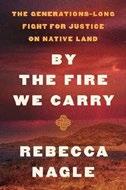
A Cherokee journalist unpacks the landmark 2020 Supreme Court case that recognized the eastern half of the state of Oklahoma as Indian country. In 1832, almost 200 years before McGirt v. Oklahoma, the Supreme Court held in Worcester v. Georgia that the Cherokee nation was a sovereign power. Andrew Jackson ignored it, forcing the Cherokee, Choctaw, Chickasaw, Muscogee (Creek), and Seminole nations—collectively called the Five Tribes—to leave their ancestral lands in what is now the southeastern United States and go west of the Mississippi to Indian Territory. Nagle gracefully carries readers back and forth through time, explaining the history of the Five Tribes before and after the Trail of Tears, the evolution of U.S. policy toward Native Americans, and the unique peculiarities of Indian law, thornily complex in part because “US courts kept bending the rules, and not to the benefit of tribes.” She is just as careful to elucidate the technicalities of court procedure, helping readers understand how a death-row appeal on
jurisdictional grounds led to “the largest restoration of Indigenous land in US history.” The legal arcana are dense, but Nagle’s writing is not. With restrained passion she exposes one injustice after another. Following a recitation of the greed and lawlessness prompted by the discovery of oil on Muscogee land, she observes that the “origin story of the great state of Oklahoma contains a vast criminal conspiracy to rob Native people of their land and money.” Of Justice Ruth Bader Ginsburg, considered the swing vote in the case, Nagle writes: “After everything our ancestors sacrificed, our land was in the hands of this one person—who knew a fraction of our history, if that. The feeling was powerlessness.”
Gripping, infuriating, and illuminating—a valuable corrective to our national ignorance.
Nairn, Kristian | Hachette (272 pp.)
$30.00 | Sept. 24, 2024 | 9780306834899
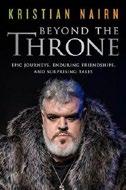
A Northern Irish actor delves into the complex life story that helped him transform an aphasic character on HBO’s Game of Thrones into a beloved hero.
When a Belfast talent booker urged the 6-foot-10 author to go to a television casting call for a “strong, tall character” who spoke just one word, Nairn reluctantly agreed. The ultimately successful audition—and the character of Hodor—changed his life. In this thoughtful, moving memoir, Nairn explores a painful past growing up during the Irish Troubles. Abandoned by his father and ridiculed for his height, Nairn grew up an outcast, a situation rendered even more excruciating by being a closeted gay man in still-homophobic Ireland. His journey to self-acceptance began with explorations of homosexual
identity through his drag queen alter ego, Revvlon Miguel. His forays into the gay club scene inspired him to pursue jobs as a drag queen, then as a DJ. Yet it was only after he landed a role on Game of Thrones that Nairn felt called to take his career as an entertainer seriously. Perceived at first as little more than a “lumbering half-wit,” Hodor became the vehicle through which Nairn learned the subtleties of the acting craft. The character also offered him unexpected opportunities to develop deep friendships with people like 10-year-old co-star Isaac Hempstead Wright (whom Nairn was at first determined not to like) and to overcome the emotional demons that kept him from speaking his mind and fully connecting with others. Fans will no doubt enjoy the behind-the-scenes details Nairn offers about the meticulously crafted world of Game of Thrones But the real delight of this book lies in its honest, sensitive portrayal of a man who comes into his own through the unexpected convergence of art and life. Compelling and richly satisfying.
Olson, Parmy | St. Martin’s (336 pp.) $30.00 | Sept. 10, 2024 | 9781250337740

How the pursuit of artificial intelligence has unfolded and what it means for humanity. Technology journalist Olson explores here the pioneering efforts of two CEOs, OpenAI’s Sam Altman and DeepMind’s Demis Hassabis, as they have led the development of revolutionary AI technologies. The book tracks their ascent to positions of extraordinary power, along with the gradual erosion of their idealism about the roles they might play in ensuring that the products they helped create would be devoted to ethical aims and the advancement of human welfare. We gain a jarringly clear sense of the radical social and economic changes already being brought about by AI and of
at least some of the risks posed by them. Reckless greed and ambition, the author demonstrates, are driving innovation in this immensely lucrative field, and very little regulatory oversight exists to curb dangers that range from economic collapse spurred by the disappearance of industries taken over by machines to the even more sensational prospect of human annihilation at the hands of superintelligent robots. High-tech firms, we learn, have “cut corners and misled the public about their products, putting themselves on course to become highly questionable stewards of AI.” One immediate consequence of such deceptions, rendered vividly in discussions of notorious examples of racist and sexist results generated by AI, is that the technology reproduces the toxic prejudices of the data that trains it. As Olson ominously concludes of Altman and Hassabis: “They joined a long history of innovators who tweaked their ideals to stay in a race and build power. The result is some of the most transformative technology we have ever seen. Now to find out the price.” An accessible, insightful exploration of the history and evolving impact of AI technologies.
Oppert, Claire | Trans. by Katia Grubisic Greystone Books (216 pp.) | $24.95
Oct. 8, 2024 | 9781778400803

Music therapy is opening a new frontier in medical treatment, avers this classical cellist and art therapist. The idea that “music has charms to soothe a savage breast” (first voiced by playwright William Congreve in 1697) is the principle behind this touching, lyrical book. After working in the field of art therapy for 20 years, Oppert has collected stories, ably translated from French by Grubisic, of the people she has treated. They range from patients with severe
autism to those suffering from neurodegenerative diseases, including dementia. In many cases there were dramatic changes, with violently autistic patients becoming more placid and catatonic patients becoming interactive. Some of the most moving stories are about people with chronic pain, who found a measure of peace and relief. Finding the right piece of music for each patient was often difficult, says Oppert, but always worth the effort. The therapy is coordinated with treatment from medical specialists, and Oppert notes that she is also involved in clinical research on music as a means to reduce pain, anxiety, and stress. Strangely, recorded music does not seem to have the same effect as in-person performances, and the cello seems to be the best instrument for the therapy. Although Oppert admits that she does not fully understand how the process works, she has no doubt about its value. Along the way, she offers her reflections about the meaning of art and the need for human connection. “Music is a redeeming interruption that calls forth something from deep within us, unchanged and radiant,” she concludes. “It shines in us, between us, through us.…It holds life aloft.”
Compassionate, intriguing, often uplifting vignettes delivered in crystalline prose.
Pamuk, Orhan | Trans. by Ekin Oklap Knopf (384 pp.) | $40.00 Nov. 26, 2024 | 9780593801246

Pictures of a writer’s days. From the many notebooks in which Nobel Prize–winner Pamuk wrote and drew from 2009 to 2022, he has assembled an intimate volume revealing glimpses of his life and work. Because he puts pages into “emotional” rather than chronological order—emotions that range from melancholy to exhilaration—readers
may find it helpful to consult the appended chronology, which contains details of Pamuk’s worldwide travels, teaching, lecturing, and publications. Between the ages of 7 and 22, he recalls, he thought he was going to be a painter, influenced by pointillists like Seurat. Although he gave up artwork in favor of writing, he still finds pleasure in combining both, as did William Blake. In waiting rooms, on trains, in cafes and restaurants, Pamuk makes sketches, sometimes painting them with watercolors when he returns home. “The loveliness of this landscape,” he notes of one, “is a call to respect the world and the whole universe.” Some illustrations, glowing with pinks, greens, and yellows, evoke Matisse. In slashes of black and grey, Pamuk captures the dark mysteries of seascapes; in other drawings, he tries to convey the quality of his dreams. “The only way to transpose the mood of a dream onto paper,” he writes, “is to paint it in watercolor.” Throughout, Pamuk reflects on the challenge of constructing his Museum of Innocence, an exhibition space that he conceived as a companion to his novel of the same name. “Sometimes,” he writes in 2009, “I think of this notebook as a museum,” a repository of memories. “When I draw in my journals,” he writes, “the poetry of the world seeps into my day-to-day life.” In 2019 he adds, “To live is to see.”
A lyrical illuminated memoir.
Powell-Ingabire, Neesha | Hub City Press (264 pp.) | $17.95 paper
Sept. 24, 2024 | 9798885740388
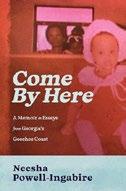
Personal essays about the complicated identity of coastal Georgia and its people.
Powell-Ingabire grew up in coastal Georgia, a land with a rich but layered, sometimes troublesome past, both for her personally and within the
American context. In her debut, she searches for the link between her ancestral history in the region, her own childhood, and the area’s rich connection to Black resistance, from the suicide-by-drowning of West Africans bound for slavery in the Americas to the protests following the murder of Ahmaud Arbery. (He was killed just miles from where the author grew up by one of her former classmates.) As a queer Black American activist and organizer who came late to appreciate her hometown, Powell-Ingabire has distinct lenses through which to scrutinize the particular shape of systemic racism and misogyny in a persistently mischaracterized area. Even as luxury tourism has boomed and the enduring culture of the Gullah Geechee has gained wider recognition, notable events in regional Black history have continued to be overlooked, underreported, and intentionally omitted. As the author sheds light on the oppression and resistance woven into the foundational fabric of her homeland, including effective Black uprisings, land ownership, and advocacy, she offers striking, unsettling insights into how this heritage has impacted her own sense, criticism, and acceptance of self. A studied formality and timid care in both prose and structure indicate the author’s humility and sympathy before her subject matter but also keep the reader at a distance; each idea seems only to scratch the surface of the author’s connection to, knowledge of, and empathy with the region and its Black people. Though it can feel stilted, this may be central to the author’s point; Powell-Ingabire knows well the danger of a co-opted narrative and has traveled a path to demand control of her own.
An interesting and worthwhile, if somewhat restrained, memoir.

Kirkus Star
Purnell, Sonia | Viking (448 pp.)
$35.00 | Sept. 17, 2024 | 9780593297803

Grit and glamour. British journalist Purnell, award-winning biographer of Clementine Churchill, turns her attention to Churchill’s cherished daughterin-law, Pamela Harriman (1920-97), somewhat condescendingly called, “the most powerful courtesan in history.” Drawing on newly released material, including an extensive interview conducted by a previous biographer, Purnell creates a vibrant portrait of an influential political player in her native England and her adopted America. At 19, two weeks after her first date with Randolph Churchill, the couple were engaged, much to the dismay of her friends and parents. “Wherever Randolph went, scandal ensued,” Purnell reports, and Pamela soon realized she had married “a drunken, offensive adulterer.” At an emotional breaking point, overwhelmed by Randolph’s mounting debts, she turned to Lord Beaverbrook, her son’s godfather, for financial help. He agreed, provided she work for him in procuring information about America’s plans for intervention in the raging European war. Pamela proved a star player in Operation Seduction USA; her conquests included Roosevelt’s emissary Averell Harriman and broadcaster Edward R. Murrow. Purnell recounts Pamela’s “strategic” sex life, which included affairs with Prince Aly Khan and Fiat mogul Gianni Agnelli. Later, marriage to Hollywood agent Leland Hayward gave her access to a new circle of celebrities, but it was politics that compelled her. Within a year of Hayward’s death, she reconnected with Harriman, married him, and became an American citizen. In Washington, Purnell reveals, she cast her spell, as she
always had, over influential and wealthy men, working tirelessly and strategically for Democratic candidates, successful in getting many of them elected. In 1980, she was named Democratic Woman of the Year—an accolade typically bestowed on first ladies. In 1993, appointed by her friend Bill Clinton, she became the first female envoy to France, the pinnacle of a storied career. Meticulous research informs a captivating biography.
Quinn, Josephine | Random House (592 pp.)
$38.00 | Sept. 3, 2024 | 9780593729793
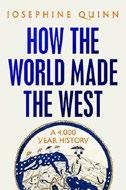
A world history, from ancient times to the discovery of America, emphasizing the contacts between disparate regions. Quinn, a classics professor at Oxford University, begins by noting the conventional wisdom that “Greece and Rome are the roots of Western Civilization.”
Arguing that this formula “impoverishes our view of the past,” she shows how many of the ideas and technologies we associate with Greece and Rome were borrowed from Mesopotamian, Egyptian, Phoenician, African, and East Asian sources. Even in the earliest times, she points out, hunter-gatherers traveled widely in pursuit of game, inevitably meeting others from different parts and trading useful objects and ideas. The pioneering cities of Egypt and Mesopotamia relied on imported building materials and new means of transportation such as donkeys and wheeled vehicles. Ships were important from the outset, as revealed by artifacts from all over the ancient world found in the ruins of port cities on the Levantine coast. The book traces the stories of an imposing array of different early cultures, always focusing on their relations with others and how each of them drew on their predecessors and
contemporaries. Quinn makes a point of reexamining many of the familiar landmarks of ancient history—notably the wars between Greece and Persia and between Rome and Carthage, with an emphasis on the “other” side. Even readers with a fairly good knowledge of history are likely to learn something new about, for example, the Etruscans or Phoenician colonies on the Iberian peninsula. This is probably not the first world history one should read, but to those already familiar with the conventional narrative, it adds an important new dimension.
A fascinating look at world history from the broadest possible perspective.
Rifkin, Jeremy | Polity (360 pp.)
$29.95 | Sept. 3, 2024 | 9781509563739

Recognizing the importance of the hydrosphere is the key to adapting to climate change, according to a leading public intellectual.
Rifkin, a prominent adviser to a host of governments, corporations, and organizations, has somehow found the time to write 20 books on technology, energy, and environmental issues. He continues the theme examined in The Age of Resilience: Reimagining Existence on a Rewilding Earth (2022)—how to adapt to a changing climate—this time with a focus on the world’s water resources. He argues that the story of civilization is essentially about the control of water, what Rifkin terms “the domestication of the hydrosphere,” from irrigation to electricity generation. The pressures of climate change, he avers, mean that this has to change. There must be a new emphasis on adaptation, regeneration, and technological innovation to deal with rising sea levels and altered weather patterns. He acknowledges that he is talking about fundamental changes to social organization, moving away from life in cities supported by fixed infrastructure and fossil fuels and toward a form of neo-nomadism. He veers between
doomsaying and optimism, and his tendency to jump between subjects makes the book hard to follow in places. Sometimes he gives the impression of having seen too many science fiction movies: his proposal to rename Earth Planet Aqua is not something that many people would support. Despite the hyperbole, Rifkin has many interesting ideas, and no one could doubt his passion. “There is only a single agenda before us,” he concludes. “It is making peace with a rewilding hydrosphere and finding new ways to flourish along with our fellow creatures. All else is a distraction.”
An energetic, urgent call for imaginative, radical responses to environmental crises.
Rosenlicht, Nicholas | Pegasus (336 pp.)
$29.95 | Oct. 1, 2024 | 9781639367306

A veteran psychiatrist casts a spotlight on America’s failing mental health care system. Rosenlicht untangles the knot that is health care in America and proposes a framework for a new system that embraces physical and mental health as one. Throughout the book, he immerses readers in today’s mental health crisis, providing shocking statistics about the nation’s homeless population, who are seen and yet go unacknowledged. “As I negotiate bodies and human feces on our downtown sidewalks, endure petty crime, and see people who cycle in and out of jail, I can only shake my head in disgust,” he writes—and his disgust is not for the hapless people roaming the streets because they don’t get the help they need. He blames the divide of physical and mental health care defined by insurance companies that focus on increased profits over improved lives. In a for-profit health
care system that is ready to drop the seriously ill due to the cost of coverage, he’s not surprised that mental health care has turned into a morass of inadequate coverage, insurmountable costs, and zero follow-through for those most in need. “I’ve seen a constant rotisserie of scams, evasions, contracts, rule bending and obfuscation as health insurers avoid paying for care, pharmaceutical companies charge the most they can get away with, and healthcare systems compete for healthy and wealthy clients who need little care…all while doing everything they can to avoid the poor, and the truly sick, especially the mentally ill.” The very titles assigned to people—caregivers or doctors as “providers” and patients as “clients”— reveal that the health care system is so rooted in a business model that it seems impossible to find a way out. But Rosenlicht offers glimpses of hope, reminding readers that people continue to fight for a better system in America that encompasses all citizens, with emphasis on care, not profit.
A scathing look at a crisis that can no longer be ignored and a heartfelt call to demand change.
Rousseau, Paul | Harper Horizon (256 pp.) $29.99 | Sept. 10, 2024 | 9781400247950

Unsettling, episodic memoir exploring a young man’s bout with traumatic brain injury.
On April 7, 2017, just before graduation, college student Paul Rousseau’s life changed dramatically and terribly. In their college room he was accidentally shot in the head by Mark, his best friend and roommate, who possessed way too many guns. The pistol’s bullet pierced two walls, ricocheting off Paul’s head. What happened afterward is debut author Rousseau’s story, written in short spurts as a “buffer” against his
A powerful, gut-wrenching tale of pain, suffering, and recovery.
FRIENDLY FIRE
traumatic brain injury. Told in sharp, clean prose, with a hard-earned sense of humor, his memoir proceeds in brisk chapters that alternate between those about the accident and aftermath and those about his life, his girlfriend Anna, and his devotion to the Timberwolves basketball team. The bullet drove bone fragments into his brain. In the hospital, facing a craniotomy, he thinks, “I am only just beginning to understand the irreversibility of what happened, the unknown of what’s to come.” He describes his brain as a “supercomputer disguised as ground beef molded into a fist”; during the operation “the surgeon picks debris out of my head like weeds in a garden.” When he’s tested after surgery, “I don’t know the desired outcome. Is it a pass-fail exercise?” He worries about everything, is confused, stutters, and experiences memory loss and brain headaches; his prefrontal cortex is irreparably damaged. Two months later, he graduates. Rousseau narrates his ensuing navigation of the legal issues that arose over his suit against Mark, who took two precious hours before calling for help; expensive insurance bills; frustrating personal injury litigation forms; and therapy sessions. The author does a fine job discussing his challenges and how he overcame them. “Metaphorically,” he writes, “everyone gets shot in the head.…It was my challenge, my duty to heal.”
A powerful, gut-wrenching tale of pain, suffering, and recovery.

For another memoir of recovery from trauma, visit Kirkus online.
Apprentice in Wonderland: How Donald Trump and Mark Burnett Took America Through the Looking Glass
Setoodeh, Ramin | Harper/ HarperCollins (272 pp.) | $32.00 June 18, 2024 | 9780063139909

T he co-editor-in-chief of Variety gets Donald Trump talking—a lot—about the reality TV show that led to his leap from New York media character to president of the United States. Much of the credit for the remaking of Trump from tabloid clown into America’s most famous businessman and a viable presidential contender lies with Mark Burnett, a Brit who arrived in the U.S. in the 1980s with $600 in his pocket and rose to become king of reality television with his creation of the genre’s first megahit, CBS’ Survivor Burnett (who mostly eluded Setoodeh’s grasp for this book) conceived of The Apprentice as “Survivor in the City.” As the first season progressed, Trump got bitten by the ratings bug; a page from Variety recording the show’s season 1 finale beating all comers for the night is proudly displayed on memento walls at both Trump Tower and Mar-a-Lago. It’s an important document in Trump’s world, “something that seems to carry as much value to him as the U.S. Constitution, if not more,” Setoodeh suggests. Trump repeatedly boasts to Setoodeh that The Apprentice was more culturally significant than it actually was; in fact, it steadily declined in ratings, as most shows do from season to season. (The author fact-checks Trump’s exaggerations and flat-out falsehoods throughout.) In addition to
Trump, Setoodeh interviewed former contenders, Trump organization staffers, and network execs to capture the show’s controversies and gossip-page scandals. Setoodeh is an amusing guide on this tour of Trump’s and the nation’s descent down the rabbit hole into a wonderland where politics and entertainment blend into each other and lies become truths, if you only believe. A vivid portrait of Trump as self-made (and made-in-the-editing-room) alpha male, both two-dimensional and larger than life.
Shoatz, Russell with Kanya D’Almeida Bold Type Books (400 pp.) | $30.00 Sept. 3, 2024 | 9781645030492

A prisoner testifies.
Award-winning journalist D’Almeida met Russell Shoatz (1943-2021) in 2013 at a state penitentiary in Pennsylvania, where he was an inmate. The purpose of her visit: to audition to be his biographer, to turn his disorganized 280-page memoir into a salable book, and, his supporters hoped, to free him from decades in solitary confinement. They worked together for nine years, and she completed the manuscript shortly before his death. The result is a brisk first-person narrative that reveals a life steeped in violence. Suffering what he called “quiet neglect” as a child, Shoatz hated school, where teachers bullied and demeaned him. Gang culture became his world, and by the time he was a teenager, he was “like someone trapped inside a revolving door,” repeatedly in and out of prison, “each time a little more
hardened than before.” Energized by seeing Malcolm X at a Nation of Islam rally in 1963, he became a political activist, first joining the Black Unity Council in Philadelphia and soon the Black Panthers and Black Liberation Army. Militant, with arsenals of weapons, he was intent on “dismantling a system of white oppression and winning freedom for Black people in America.” Involvement in a raid, however, changed his life forever. Accused of killing a Philadelphia park guard, he was captured after two years underground and sentenced to life imprisonment. Two daring escapes from prison earned him the nickname Maroon, an epithet for a runaway slave, of which he was proud. Describing himself as “a politically motivated individual, who had been officially affiliated with a group that had declared itself at war with the US government,” Maroon continued bearing witness to injustice and racism in his writings from prison. Tense, fast-paced chapters ably capture his fire and anger.
A raw, unvarnished memoir.
Smee, Sebastian | Norton (384 pp.)
$35.00 | Sept. 10, 2024 | 9781324006954

Art from chaos.
Pulitzer Prize–winning art critic Smee draws on a wealth of historical and biographical sources to examine the birth of impressionism during a time of ferocious political and social upheaval in France. Smee focuses closely on three
artists—Edouard Manet, Berthe Morisot, and Edgar Degas—who, unlike many of their contemporaries, stayed in Paris during the “military and civic catastrophes of 1870-71,” which Victor Hugo called “The Terrible Year.” A siege by the Prussian army took down Napoleon III and left the city’s population starving, its buildings burned to ruins. Isolated, Parisians depended on hot-air balloons to deliver mail to the rest of the country. Although Napoleon’s scandalous monarchy had ended, France’s Third Republic itself was assailed: the Paris Commune, “a hastily improvised urban government,” was composed of rebels who wanted “to dismantle any structures of power—governmental, financial, religious, military—that held people back.” They were quashed in a bloody rout that left the city reduced to rubble. Smee vividly conveys the terror of the times, the tense military standoffs and plotting, and the inflamed passions. The aftermath of the terrible year left the nation deeply unsettled. For the artists Smee portrays, the future seemed bleak, portending “the imminent death of the republic, the likely restoration of a monarchy, and a conservative Catholic revival.” Impressionism, he argues, was the aesthetic response to their heightened perception of the “existential fragility” of life. The paintings in the first impressionist exhibition of 1874 “idealized transitions and contingency, even as it attempted to dispel grief.” Despite being illustrated with color plates, Smee’s work devotes less space to the history of artistic creation than to war, but his depiction of impressionists’ works is discerning, as is his sensitivity to the complicated relationships among the artists. Deft, vibrant cultural history.

Smolar, Piotr | Trans. by Anthony Roberts
Other Press (256 pp.) | $16.99 paper Sept. 3, 2024 | 9781635424249

A French Jewish journalist examines his uneasy relationship with Netanyahu-era Israel.
“Judaism and Zionism are no longer aligned. I don’t mean Zionism in the sense of a legitimate right to statehood, but its disfigurement by the aggressive agenda of Israel’s political Right.” So writes Smolar, a Middle East correspondent for Le Monde. As his subtitle suggests, Smolar’s family arrived in Paris following pogroms in Russia, but that did not diminish what he calls his family’s alternate religions: his grandfather’s communism, his father’s devotion to once-democratic Poland, his own commitment to journalism. His title is ironic, but not so far off the mark in the eyes of the conservative forces that have taken hold in Israel. The overarching mood there after Oct. 7, 2023, has been to destroy Hamas, which, Smolar argues, does nothing whatever to solve the problem of what to do with the Palestinian people once the smoke clears—if it ever clears, for current conditions in Gaza, he warns, “will combine to produce a new generation of Palestinians driven by hatred of Jews.” Smolar notes that mounting antisemitism in Europe and the U.S. complicate the possibilities of peace by contributing to Israel’s us-against-them siege mentality. He combines big-picture views with small, revealing scenes, as when he visits a once-illegal Jewish settlement on the West Bank, founded by religious extremists, that the Netanyahu government is now pressing to annex: “A project that was frankly marginal, eccentric, and inaudible ten or twenty years ago has been polished and normalized.” Against this, Smolar portrays peace activists, ethicists, and anti-Netanyahu activists who urge that Israel remember its leftist roots and truly live up to its
self-proclaimed status as “the only democracy in the Middle East.” Solid on-the-ground reporting combines with memoir to offer a revealing look at life in a deeply conflicted Israel.
Spiegel, Rebecca | Milkweed (256 pp.)
$18.00 paper | Sept. 10, 2024 | 9781571311962
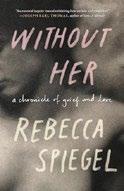
First-time author Spiegel documents her experiences and anguish after her sister Emily died by suicide at the age of 21. Spiegel, three years older than her sister, was teaching in a special education classroom in a high school in New Orleans when she got the call that Emily, then in college in Colorado, had died on campus. She records her own responses and actions over the next hours, days, and weeks with rigor, precision, and compassion, as she flies to Philadelphia to make funeral arrangements with the parents who had split up when she was six and their current spouses. The memoir follows the author through the first few months after her sister’s death with occasional looks back at Emily’s childhood and adolescence to reveal the mental illness that afflicted her, which manifested as severe eating disorders (which the author had also experienced) and bipolar disorder. It moves back to the year before Emily’s death, before moving into the present. The description of the last year Spiegel and Emily had any time together, mostly consisting of occasional brief visits and calls and long chains of emails, is quietly devastating and guilt drenched, as the author wonders what she could have done differently. As the years go by and Spiegel remains locked in grief—dropping job after job, one boyfriend and then another, before enrolling in graduate school to write the story published here—the memoir, perhaps inevitably, loses a certain amount of focus. To the author’s credit, she doesn’t force her experience into a narrative arc.
Although years after the death she is coping, she is still devastated on a frequent basis by the loss of “the person I loved the most in the entire world.”
A stark study of grief and a touching tribute to a beloved sibling.
Sullivan, Jared | Knopf (384 pp.)
$30.00 | Oct. 15, 2024 | 9780593321119

An environmental catastrophe and its human consequences. Environmental disasters are, regrettably, far from uncommon, but the calamity around the town of Kingston in Tennessee in 2008 was particularly awful for its scale and reverberations. The incident was caused when an embankment holding back a huge amount of coal sludge broke, resulting in a wave of muck that eventually covered and contaminated 300 acres and resulted in more than 50 deaths. Sullivan, an experienced journalist, focuses on the lengthy legal case brought by lawyers representing the community against the gigantic Tennessee Valley Authority and one of its contractors, Jacobs Engineering. The issue was initially considered to be one of property damage, but it did not take long for serious health problems to appear, especially among the cleanup workers who inhaled coal ash. Sullivan delves deep into the background of the event, examining the technical issues as well as the legal aspects of the civil action suit, which was eventually successful. He makes no real attempt to be impartial; he is clearly on the side of the plaintiffs. He states at the outset that “Jacobs Engineering and TVA dispute much of my reporting” but elaborates on this primarily in a Notes section at the end. He amasses a huge amount of information, and while this helps him build a strong case, it also
bogs down the narrative in places. Another problem is that the book’s three long parts each cover a lengthy period, making it at times a difficult read. Nevertheless, the overall impact of the story remains strong, thanks to Sullivan’s careful research and empathy for the disaster’s victims. Of particular interest to readers interested in environmental issues and public liability law.
Valderrama, Wilmer | Harper Select/ HarperCollins (256 pp.) | $29.99 Sept. 17, 2024 | 9781400336579
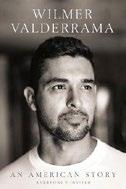
A respected actor/ social activist reflects on how being the American-born son of two South American immigrants has influenced his life and career.
Born in Miami, Valderrama was 3 when his family moved to Venezuela. He spent time riding his horse, watching TV, and dreaming he was Zorro while his father worked the farm he had bought. After Hugo Chavez came to power several years later, Valderrama’s family fled to Los Angeles. “You’ll need to learn English,” the father warns his son, who was flunking that subject in school. In LA, his parents struggled financially while the author faced the daunting task of learning a new language as he navigated school, a part-time job, and an environment that sometimes judged immigrants unfairly. Yet these difficulties only made him more determined to succeed and to assist his parents. A straight-A student by high school, Valderrama poured his energies into acting and began auditioning for commercials and television bit parts. His junior year he unexpectedly landed the part of the foreign exchange student Fez on That 70s Show, a role that fueled his steady rise to fame and helped him support the family he loved. Yet even as Valderrama lived professional dreams of
developing successful TV shows like Yo Momma and Zorro and starring in successful films like Fast Food Nation and Larry Crowne, he found himself equally drawn to activism in support of causes that empowered the Latinx community and that “creat[ed] a national celebration of democracy.” Recapping Valderrama’s star-studded accomplishments, this book is no different from other celebrity memoirs. Its greater interest lies in his presentation of his life as a demonstration of the fact that America’s greatest strength lies in its diversity and in the immigrants it at times underestimates or undervalues. Candid and outspoken.
Weber, Nicholas Fox | Knopf (656 pp.) $40.00 | Oct. 22, 2024 | 9780307961594

A deep dive into the art and times of the Dutch-born modernist painter. In this exceptionally well-crafted and researched biography, cultural historian Weber explores the intimate connection between Mondrian’s austere yet exuberant paintings and his life. Born Pieter Mondriaan to a neo-Calvinist Protestant teacher and his wife, the painter became a leading light of the early-20th-century avant-garde. He both “mirrored…and reacted against” the rigidity and religious absolutism of his parents; where they taught him to hold fast to his spiritual convictions, his more worldly uncle Frits introduced him to the unabashed “pursuit of visible beauty.” Frits schooled his beloved nephew in the commercially popular “Hague school” style that focused realistic natural scenes; as Mondrian grew older, he gravitated to the candid modernism of Van Gogh and, in particular, to deploying light, lines, and color in ways that created “the energy and robustness that would become Mondrian’s hallmarks.” As a young man, he left the Netherlands for France, where he abandoned his uncle’s traditionalism and
committed to a more radical aesthetic; Frits retaliated by insisting Piet drop one “a” from his last name so he would no longer be associated with his “depraved nephew.” Moving among the patrons, artists, and art dealers in Paris and, later, New York who helped define the modernist era, Mondrian immersed himself in the geometric, perspectival playfulness of cubism. Near the end of the First World War, he co-founded the influential De Stijl arts movement, which emphasized the absolute rectilinear abstraction and primary color “purity” that Mondrian believed created art that transcended “the small issues of everyday life” and offered “spiritual grace.”
Written with a scholarly precision that revels in the nuances of Mondrian’s remarkable life and work, Weber’s book offers an immersive, if lengthy, biographical experience for lovers of both art history and modernism. Passionately rendered and richly detailed.
White, Shad | Steerforth (272 pp.) | $29.00 Aug. 6, 2024 | 9781586423865

How a Mississippi state auditor and a small team of investigators uncovered a scandal that made national headlines and cast a beloved sports hero as a villain.
In 2019 White first learned from Governor Phil Bryant about a kickback scheme involving John Davis, the director of the Mississippi Department of Health Services. What he did not know was that his investigations would bring to light a $100 million welfare fraud scheme that involved misuse of federal Temporary Assistance for Needy Families funds in that poverty-stricken state. For the next two years and often at great personal cost, White and his colleagues followed a money trail
through a maze of government corruption that led to a host of shady characters. One, a charismatic Toshiba copier salesman and drug addict, convinced Davis to fund his various companies with TANF dollars for work that had nothing to do with serving low-income families. Another, an ex-teacher turned campaign donor, misused a nonprofit community education organization to collect millions in TANF funds, which she used in part to fund a wealthy lifestyle. Still another was football legend Brett Favre, who used his own nonprofit to launder TANF money he then donated to his alma mater, the University of South Mississippi. White’s scrupulous attention to the details of this case is as admirable as his goal of demonstrating that some public servants can and will stand up to powerful forces bent on abusing their power. In his words, “returning the public’s faith in the idea that the entire edifice of American life operates for their general welfare…is a twenty-first-century requirement for a healthy republic.”
Illuminating and disturbing.
Wiley, Maya | Grand Central Publishing (336 pp.) | $32.00 | Sept. 10, 2024 9781538739938
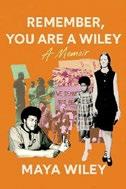
The making of an activist lawyer. In a forthright memoir, Wiley, an attorney, a New York City mayoral candidate, and a former legal analyst for MSNBC, pays homage to her parents, both civil rights activists whose examples served
her as she navigated racism, sexism, and personal trauma. Her father, George Wiley, was a charismatic Black organic chemistry professor and civil rights and economic justice activist; her defiant white mother, Wretha Whittle, left her Southern Baptist family to enroll at Union Theological Seminary and mentor girls in East Harlem. The couple met at Syracuse University, where George was a newly hired faculty member and Wretha, a graduate student. Together they worked at the Syracuse chapter of CORE, tackling racial discrimination in housing, jobs, and schools. In 1964, James Farmer asked George to serve as associate national director of CORE in its New York City headquarters, an opportunity undermined by rivalries and ideological conflicts within the organization. The family—now including Maya and her older brother—relocated to a gentrifying Black neighborhood in Washington, D.C., where their home became a center of civil rights activity. Maya’s life was upended at age 9 when her father fell off their recently acquired cabin cruiser and drowned. Only she and her brother were on board, unable to save him. Beset by anger, fear, and guilt, she was later diagnosed with PTSD. As a biracial student, Wiley struggled to fit into “the color palette” of Washington’s public schools, Georgetown Day School, the Field School, Dartmouth, and Columbia Law School. She never lost sight of her parents’ ideals: doing an internship in the Philippines investigating human rights violations and serving a federal clerkship and positions at the ACLU, the U.S. attorney’s office, and the George Soros Open Society Institute, all confirming her commitment to progressive change.
A candid self-portrait of a determined woman.
Yu, Gene | Little A (228 pp.) | $28.99
Oct. 8, 2024 | 9781662510564
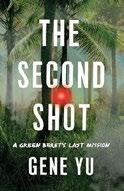
A former Green Beret reflects on how engineering an unsanctioned rescue mission in the Philippines helped him come to terms with a fractured, complex past. Born to Taiwanese parents in Boston, Yu spent his childhood trying to be “the perfect American boy,” only to get treated like a foreigner in return. Later the family moved to the San Francisco Bay Area, where Yu suddenly found himself surrounded by other Asian Americans. Feeling alienated and rebellious, he grew his hair long, wore a black coat, and shoplifted books. In an ironic twist, one of the novels he stole, which centered on an Asian American graduate of West Point, gave him the direction he lacked. He set his sights on attending West Point, but by the end of the year, the academy had ranked him lowest in his class. Despite obstacles throughout college and later, during his distinguished service as a Green Beret, Yu always managed to get “second shots” that pushed him to excel and succeed. Questions about his ties to an uncle he barely knew but who happened to be the president of Taiwan eventually forced Yu to leave the military for a civilian career in Asia. A series of setbacks not long afterward sent his life into a tailspin, until a family friend named Angela Chang asked Yu to help find her kidnapped sister, Evelyn. Yu made a near-fatal error in judgment during the intrigue-filled rescue operation that followed, nearly costing Evelyn her life. Forced once again to confront failure—this time as a soldier and a good Chinese son—Yu not only succeeded in freeing the hostage from her terrorist captors but also himself from the lifelong internal “war” that raged between both sides of his identity. Inspiring, provocative reading.
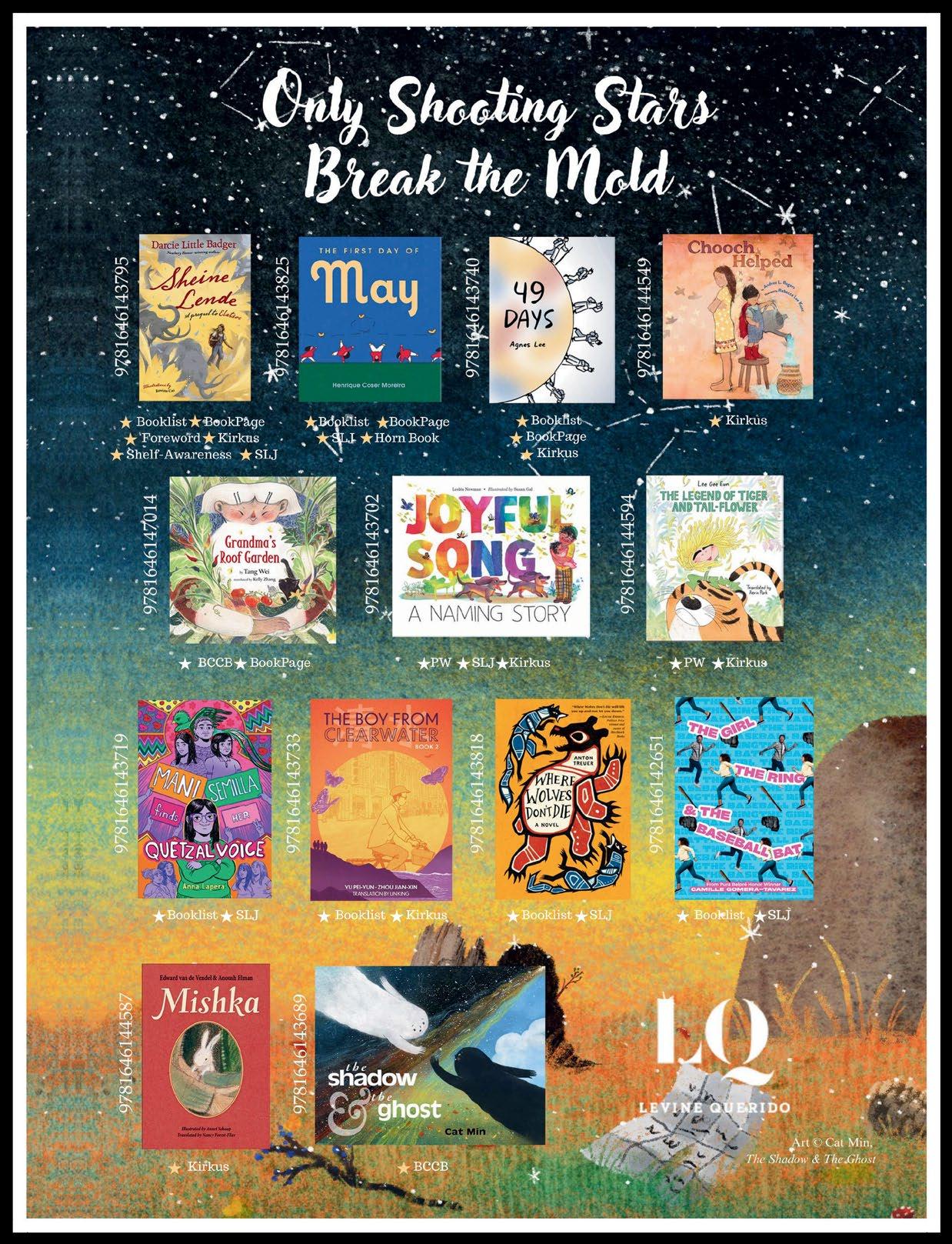

Autumn brings with it changing leaves, a return to school, and picture books galore. You’ll find something to keep every young reader in your life spellbound, from gently reassuring tales that help little ones manage big emotions to innovative works that will have them pondering the very nature of the universe.
Abrams, Stacey | Illus. by Kitt Thomas Harper/HarperCollins (32 pp.) | $19.99 Sept. 24, 2024 | 9780063271876

Voting rights activist and former gubernatorial candidate Abrams’ latest picture book sees her younger self taking a stand against injustice.
The delight of “TacoPizza Fryday”—a special lunch that the whole school voted on—turns sour for elementary schooler Stacey when she notices that some students are excluded because they can’t pay. Sympathetic school librarian Mr. McCormick explains that the “complicated” rules about who qualifies for free lunches leave some children out; he gently suggests that she and her friends address the school board rather than starting with a demonstration. Initially reluctant to speak in public, Stacey decides to lead a petition drive instead. She eventually nerves herself to stand up at the meeting to plead for a policy change, and when the board puts her off, she joins her friends in gently pressuring her principal every Friday with a list of kids who were left out that week. Thomas fills the illustrations with exaggeratedly wide eyes and open mouths; the crowds of diverse cheering, sign-waving students present rousing images of collective action and, at the end, collective triumph. “Imagine what else all their voices could change…together,” the author concludes pointedly, cogently adding in her closing note that sometimes “you feel like you’re fighting only for yourself, until you look around and realize that others are simply waiting for someone to go first.” Though the story is fictional, backmatter references real-life examples of Abrams learning to “speak up and take action.”
A blueprint for effective social action: simple, savvy, and tried and often true. (child hunger resources) (Picture book. 7-9)
A stirring child’s-eye view of an all-too-common struggle.
Bingham, Winsome | Illus. by Rahele
Jomepour Bell | Abrams (48 pp.)
$18.99 | Oct. 29, 2024 | 9781419761553

Momma hasn’t been the same since returning from her deployments to Iraq, Afghanistan, and Africa.
The Momma who twirled to Beyoncé and loved gardening is gone, and in her place is a Momma who can’t always manage to get out of bed, who has explosive outbursts, and who’s lost “the sunlight spotlight smile” her child once found so much comfort and joy in. The attentive young protagonist tries to help, dragging a bucket of dirt into the house and opening the curtains to remind Momma of who she was. Momma’s quiet, but she digs her fingers into the dirt, and things slowly begin looking up. Momma makes it clear that none of this is the child’s fault, and the next day, the two smile as the wildflowers bloom and Beyoncé plays in the background. Bell’s masterfully rendered, digitally edited ink and charcoal illustrations depict a Black mother and child whose love for each other is palpable even during moments of anguish. Scenes of them in the garden on Momma’s good days are bright and lively. In contrast, the hard days are illustrated with a surrealistic quality that demonstrates the impact of Momma’s pain on the whole family. Bingham’s text is honest yet child-friendly; laudably, she makes it clear that the burden of resolving a parent’s PTSD shouldn’t fall upon a child and that grappling with mental-health issues takes time.
A thoughtful, empathetic, and stirring child’s-eye view of an all-too-common struggle. (author’s note) (Picture book. 4-9)
Kirkus Star
Bingham, Winsome & Wiley Blevins Illus. by Jason Griffin | Neal Porter/ Holiday House (56 pp.) | $19.99 Oct. 1, 2024 | 9780823456420

T he story of a table belonging to two different families. A poor white family owns a wooden kitchen table. It holds the biscuits that Meemaw bakes, as well as the plate of peas the child narrator leaves after devouring cornbread and pork-fat pinto beans. The table also holds a book that the child reads aloud to Meemaw, who’s illiterate, along with bills that Mama can’t pay. The mines that have made Grandaddy sick have also left Papa unemployed, and the family soon loses their house. Since the table won’t fit in their next home, they leave it on the side of the road, where a Black carpenter and his family pick it up.
“This a good table right here,” Daddy tells his child, the narrator of the book’s second half. And once it’s cleaned up, the table holds beef stew, which this youngster dislikes as much as the other child hated those dreaded peas. As the story draws to a close, the youngster wonders about the previous owners of the family’s new-old table. Bingham and Blevins write with a mixture of melancholy and hope, using masterfully chosen details to draw rich portraits of two different families, each united in their love for one another. With his stunning use of textures,
Griffin’s ingenious mixed-media illustrations show only the characters’ hands—an intriguing choice that leaves readers to fill in many gaps. A moving, elegantly constructed celebration of differences sure to foster empathy and stir the imagination. (creators’ notes) (Picture book. 4-8)
Burleigh, Robert | Illus. by Wendell Minor
Christy Ottaviano Books (32 pp.) | $18.99
Oct. 1, 2024 | 9780316560498

Winter gets distilled into some of its signature components. “I am Winter,” the text declares, while the accompanying image depicts a “silvery snowflake” landing on a pale-skinned child’s nose. A page turn reveals more seasonal signs: “a cardinal “chirping in the bush” and a snowball “flying high—whoosh!” Each subsequent element is introduced through the same “I am” sentence structure and linked through rhyme. The illustrations include both single- and double-page spreads, as well as occasional pages that are bordered with patterns. Often, elements transform: Snow becomes a snow angel, then a “jolly snowman,” then the residue on red woolen mittens. Winter is ice, too, whether on the grass or under ice skates—flying with a “flash!” Wreaths adorn doors. Cocoa steams in a child’s hands. Gingerbread cookies wait to be eaten. The carefully constructed scenes end on a contemplative note, comparing winter to a “very old story / or a beautiful poem” and “a walk in the woods / and then back home.” Aside from “candles in the window” (paired with an image of a menorah) and cookies decorated with the Star of David, the illustrations heavily favor Christmas symbolism. Though characters are diverse and some cityscapes are depicted, Minor’s gouache and watercolor art evokes holiday cards from bygone eras; the images accentuate the nostalgia with warmth and soft textures. A cozy poem to celebrate the winter season. (Picture book. 4-8)
Carlstrom, Nancy White | Illus. by Claudia McGehee | Eerdmans (44 pp.)
$18.99 | Sept. 24, 2024 | 9780802855701

It’s a counting book. It’s a winter animal book. It’s a just plain beautiful book!
“One red fox walks / across the white snow / quietly / stalking winter.” Meanwhile, the fox looks boldly at readers, a single paw raised. Though weather and color palettes may change from page to page as the book counts to 12, the one thing that remains the same is the sense of awe readers will feel while observing these animals in their native Alaskan environments. Each animal’s relationship to the season is described in evocative verse, whether they’re “talking winter” or “tracking,” “riding,” “hiding,” “facing,” “racing,” “naming,” “taming,” “feeding,” or “meeting” it. The final animals on display—human kids of various skin tones—slip and slide on ice that’s rapidly melting as spring arrives. With lines such as “Four red squirrels feast / at their midden full of cones / hungrily / cracking winter,” Carlstrom’s writing deftly sets this title apart from other counting books. Meanwhile, McGehee’s art conjures up both the silly side of nature and its incredible dignity and variety. Backmatter consists of animal profiles, with fun facts about each one pictured. In her author’s note, Carlstrom reminisces about observing wildlife while living in Alaska; in an illustrator’s note, McGehee discusses researching the animals she drew. A little scratchboard, a little watercolor, and voilà! The prettiest nondenominational winter book seen in ages. (Picture book. 3-5)
A
Kirkus Star
Carranza, Leonarda | Illus. by Erika Medina | Annick Press (32 pp.) $18.99 | Sept. 17, 2024 | 9781773219011

A boy’s anger literally buzzes to life and runs amok in the shape of words. When Ali notices his cousin Ama mistreating his insect book, he moves to snatch it from her hands. During the skirmish, a page gets ripped out. In anger, Ali lets loose a yell; scrawled letters unexpectedly fill the air. His rage builds until he screams, “I HATE YOU!!!” The anthropomorphized letters quickly jump into action, attacking Ama and tearing up the couch and Abuelita’s special cushions. Despite Ali’s objections, the letters continue their fiendish assault. Soon, the devious letters go outside, smashing bushes and flowers. One letter even attempts to hurt a bee! Inspired by his insect book and joined by Ama and Abuelita, Ali rushes to stop the letters with a net, learning how best to release his anger along the way. Adopting a refreshingly empathetic perspective, Carranza adroitly depicts Ali’s transformation. The child’s wrath turns to observation—of the impact of hurtful words uttered amid a cloud of pain—and then to a recognizable potential to undo unintended emotional wounds while still acknowledging that initial anger. Overall, it’s an excellent message to potential anger-prone readers, wrapped in an understanding tone. Medina’s brisk, dynamic artwork whisks the action from page to page, boasting humorous creature letters with mean smiles and gruff frowns. The brownskinned characters read as Latine.
BARNABY UNBOXED!
A perceptive consideration of the effects of anger—and a much-needed blueprint for how to deal with them. (Picture book. 4-7)
Kirkus Star
Jonty Gentoo:
Adventures of a Penguin
Donaldson, Julia | Illus. by Axel Scheffler | Scholastic (40 pp.)
$18.99 | Oct. 1, 2024 | 9781546134206
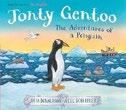
Jonty Gentoo, a brave, determined zoo penguin, embarks on an epic journey. When Jonty Gentoo hears about penguin colonies at the South Pole, he yearns to go there. Eventually he escapes, leaving his loving aunts (no parents are mentioned) and caring keepers in search of adventure. Unclear on the concept of a geographic pole (he’s initially confused when he encounters a flagpole, a barge pole, and a tent pole) and tired of walking, he jumps into the sea and delightedly swims through sparkling, food-filled waters. But when he emerges onto the ice, he finds no penguins, even after weeks pass. Bearded seals threaten to eat him, and the polar bear who saves him breaks the news: Jonty has traveled north. A tern accustomed to globe-spanning migration offers guidance, and “the bird in the sea and the bird in the air” travel south. Exhausted, Jonty lucks onto an Antarctic expedition ship and is taken aboard. On land he sees emperor and Adélie penguins and finally a “heartwarming huddle of gorgeous gentoos.” The story is heartwarming, too, and the rhythms rock us through the miles of migration with reassuring and spot-on rhymes. Jonty and the bear are accurately depicted, though slightly anthropomorphized. Scheffler’s firmly
outlined art gives humans (who vary in skin tone) flat profiles but depicts whales, swordfish, owl, seals, and more in beautiful color and detail.
The small hero’s grit and happy ending guarantee another success for this popular author and illustrator duo.
(Picture book. 4-8)
Fan, Terry, Eric Fan & Devin Fan
Tundra Books (80 pp.) | $19.99
Sept. 3, 2024 | 9781774882436

Reprising The Barnabus Project (2020), the Fan brothers revisit the reopened Perfect Pets store, which sells
adorable boxed creatures with engineered, interactive personalities. Barnaby, “half mouse and half elephant, with just a dash of flamingo,” is anxious about the exciting new Perfect Pets on offer. As the last Barnaby on the shelf, will he ever be chosen? Then, a light-skinned little girl does just that. At first, the pair are inseparable. She reads him bedtime stories; he helps her with chores. And every Saturday morning, they watch Barnaby and Friends (our hero is a branded tie-in to this popular TV show). Everything changes one day when they tune in to find that Barnaby’s been replaced by new “Rainbow Barnaby.” When the girl’s father won’t buy the colorful new Pet, the girl’s interest in plain pink Barnaby wanes. As her father walks him one rainy Saturday, Barnaby slips his collar, intending to run away just “long enough for people to miss him.” Days become months. Barnaby escapes a feline “orange beast,” discovers other lost Pets in a dumpster, and encounters his Rainbow doppelgänger, who disparages Barnaby’s dirty, now-gray fur. In the park, squirrels
teach Barnaby their wild ways, sheltering him all winter. Spring brings a reunion with the searching girl, who reawakens Barnaby’s memories. The Fans’ deft pictures combine intricate details and ground-level perspective, conveying empathy for children and the even smaller creatures that populate their world. Human characters are diverse. Joy, despair, reunion, community— delightfully, all here. (Picture book. 4-9)
Gad, Josh | Illus. by Marta Kissi Putnam (32 pp.) | $19.99
Sept. 17, 2024 | 9780593463123
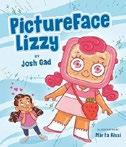
Broadway and film actor Gad tells the story of a child who needs the hottest new electronic device to fit in—or so it seems.
Eve has many material possessions, family members, and pets, including a hedgehog named Snoop Hog, a threelegged lizard, and a puppy named Bluster. But, alas, Eve’s life is still a “tragedy,” because the child doesn’t have a PictureFace Lizzy electronic toy. Eve has asked for one 12 times, and while Mom and Dad haven’t said no outright, their non-answers haven’t yielded Eve’s desired outcome. A shopping trip with two friends who do have PictureFace Lizzy toys is another reminder of what Eve doesn’t have. Even gymnastics—where Eve is top of the class—makes the child feel left out when everyone dances to pop songs played by a PictureFace Lizzy. At birthday parties, sleepovers, and in school, Eve’s always the odd one out. Finally, Eve asks again and…best surprise ever: Eve gets a Lizzy! While the new tech brings Eve up to speed with the class, everyone actually has the most fun when they put their Lizzys away and experience life screen-free. This wholesome, funny tale tackles themes of consumerism and technology trends, while Kissi’s full-color cartoon art complements the first-person narration, capturing Eve’s flair for the dramatic. Eve’s cued as biracial, with one brown-skinned parent and one
lighter-skinned parent. The Lizzy toys are customizable to resemble their owners. A humorous yet balanced take on a hot topic. (Picture book. 4-8)
Kirkus Star
Marina Abramović
Turned Herself Into Art and Wasn’t Sorry.
Gilberti, Fausto | Phaidon (56 pp.)
$17.95 | Oct. 15, 2024 | 9781838668822
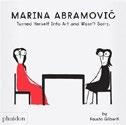
A portrait of a particularly venturesome performance artist. In the latest of his “…Wasn’t Sorry” artist profiles, Gilberti assumes first person to explore early experiences and people who shaped Marina Abramović’s very personal approach, from her loving grandmother to an unconventional art teacher who threw paint onto a canvas and then set fire to it. The author/illustrator then describes how his subject went from painting flowers, dreams, and clouds to creating edgier artworks—for example, scrubbing a mountain of bones to express her response to the war in her native Yugoslavia and using her body to stand naked while facing her longtime collaborator Ulay in a gallery doorway so that visitors had to “squeeze between us” to enter. So matter-of-fact is the tone that the works all come off not as bids to be outrageous or sensational, but as natural reflections of a creative impulse; not only will young artists with unconventional visions of their own feel validated, but audiences of all sorts should come away with expanded perspectives on what art can be. In the minimalist but moving illustrations, pop-eyed figures with sticklike limbs, clad (when clothed) in solid black or, at times, red and white as the page beneath, stand or sit in stylized poses against unfilled backgrounds. Possibly the most effective image of all is a closing photo of the artist during her 2010 The Artist Is Present performance at New York’s Museum of Modern Art, locking eyes with an equally intense young child. Revelatory and perceptive. (list of
FALL
A mighty mouse displays the right stuff once again.
MOUSETRONAUT SAVES THE WORLD
mentioned works, afterword) (Picture-book biography. 7-10)
Kelly,
Mark | Illus. by C.F. Payne | Paula Wiseman/Simon & Schuster (48 pp.)
$19.99 | Sept. 10, 2024 | 9781665910224
Series: Mousetronaut

In senator and former astronaut Kelly’s latest, NASA’s smallest space traveler undertakes his third, and so far most important, space mission. News of a huge asteroid hurtling toward Earth sends Meteor the Mousetronaut—at the head of a likewise furry crew from MASA (the Mousetronaut Advanced School of Aeronautics)—blasting into space for a try at nudging the massive rock away from its deadly course. The mission is successful but takes a suspenseful turn when damaged heat shields necessitate an unplanned landing on the moon and a rescue mission from Earth. As on previous missions, Kelly loads his astrotale and its lengthy afterword with astronomical and technical data related to solar system dynamics, Mars (where the expedition lands for a quick refueling) and other planets, plotting trajectories, and actual missions and plans designed to cope with both the problem of orbital debris and with the all-too-real threat of a major meteor strike. Payne adds an overview of the planets and their orbits to realistically detailed views of mice in spacesuits and racially diverse groups of human space experts and government officials, including the white-presenting president herself in her oval office.
A mighty mouse displays the right
stuff once again. (further reading, websites) (Picture book. 7-9)
Kirkus Star
Khwaja, Maham | Illus. by Daby Zainab Faidhi | Lee & Low Books (48 pp.) | $21.95 | Oct. 8, 2024
9781620149577 | Series: New Voices

A child escapes a war-torn country. The young protagonist’s father first pockets his house key, then decides to leave it by the door, signaling that the family is unlikely to ever return. The family ends up at the sea, where they wait under a dock while the child uses a stick to trace an image of home into the sand. The next day, the picture of the house has washed away, but there are boats willing to take the family to their next destination—a refugee camp. Making new friends renders the family’s instability and anxiety slightly easier to endure. Eventually, the family starts a new, more hopeful life in America, but they never stop missing home. Though the main characters are brown-skinned, their country of origin isn’t identified; in an author’s note, Khwaja discusses how her family, forced to leave Kashmir because of famine and flooding, moved to Pakistan and then, years later, emigrated to the United States. Written in verse, her powerful book captures both the terror of displacement and brief but meaningful moments of tenderness. Never shying away from the harsher details of migration, neither does she reduce the story to its trauma, creating a nuanced tale that will both inform those lucky enough to enjoy geographic stability and feel familiar to those who aren’t.
A luminous call to think about what is and to envision what might be.
Popping with vivid colors, Faidhi’s illustrations have a sweetness that tempers the story’s bleaker moments. A moving and enlightening depiction of the refugee experience. (Picture book. 4-8)
Ed. by Latham, Irene & Charles Waters
Illus. by Mercè López | Carolrhoda (40 pp.)
$18.99 | Oct. 1, 2024 | 9781728492100

Poets weigh in on childhood boo-boos and faux pas that still haunt them.
“My mother used to tell me, / ‘Think before you do.’ / I wish I would have stopped and thought / before I used the glue.” If readers are more disquieted than soothed by the notion that they, too, may wind up agonizing over flubs years, even decades, later, most of the poets at least try to point to positive life lessons learned. Not that they’re always convincing: Allan Wolf, for instance, claims that he learned to forgive himself for a soccer own goal he nonetheless still remembers scoring in fourth grade, and Tabatha Yeatts’ memories of performing well on a summer camp stage despite blowing off the rehearsals comes off as more of a humblebrag. Still, Linda Sue Park’s embarrassment at mispronouncing a word in class, and Jaime Adoff’s for insisting on pitching when he could barely get a baseball to the plate, had salutary results on their respective self-images, while Margarita Engle learned the value of thinking for herself after cutting off her braids at a
schoolmate’s suggestion, as did Kim Rogers (Wichita) after playing the role of a white settler in an Oklahoma Land Run Day celebration. López reflects the multiracial cast of the contributors in her bright and energetic views of young people amid diverse family or other groups.
Comforting reminders that nobody’s perfect, infused with lessons large and small. (about the poets) (Picture book poetry. 6-9)
Kirkus Star
Limón, Ada | Illus. by Peter Sís Norton Young Readers (32 pp.) $18.99 | Oct. 1, 2024 | 9781324054009
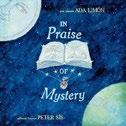
In U.S. Poet Laureate Limón’s debut picture book, soaring images and lyrics invite contemplation of life’s wonders—on Earth and perhaps, tantalizingly, elsewhere.
“O second moon,” writes Limón, “we, too, are made / of water, // of vast and beckoning seas.” In visual responses to a poem that will be carried by NASA’s Europa Clipper, a probe scheduled for launch in October 2024 and designed to check Jupiter’s ice-covered ocean moon for possible signs of life, Sís offers flowing glimpses of earthly birds and whales, of heavenly bodies lit with benevolent smiles, and a small light-skinned space traveler flying between worlds in a vessel held aloft by a giant book. Following the undulations of the poet’s cadence, falling raindrops give way to shimmering splashes, then to a climactic fiery vision reminiscent of
Vincent van Gogh’s Starry Night before finishing with mirrored human figures made of stars. Visual images evocative of the tree of life presage what Límon writes in her afterword: that her poem is as much about “our own precious planet” as it is about what may lie in wait for us to discover on others. “We, too, are made of wonders, of great / and ordinary loves, // of small invisible worlds, // of a need to call out through the dark.”
A luminous call to think about what is and to envision what might be.
(Picture book. 7-10)
Kirkus Star
Lukoff, Kyle | Illus. by Julie Kwon Dial Books (32 pp.) | $18.99 Aug. 27, 2024 | 9780593462911

An epistolary tale told mostly in drafts as a boy completes a teacher’s requirement to write an apology. Ripped and crumpled notes tell most of the story as Jack, a brown-skinned boy with straight brown hair, grumps through the school day. An early draft reads, “DEAR ZOE, I’M SORRY YOU GOT SO MAD!!! JACK.” Light-skinned, dark-haired Ms. Rice, who looks over his drafts, writes back, “Dear Jack, Please try again. Love, Ms. Rice.” As each subsequent draft makes incremental progress, the story of what happened emerges (“I’m sorry FOR REAL that your castle got knocked over”). Kwon’s charming art, rendered in ink, then colored and collaged digitally, tells a parallel emotional story as Jack goes from angry to chastised, then back to angry (a wonderful spread shows him expressing his rage while taking part in the day’s art assignment: “Paint Your Feelings!”), and finally thoughtful. Meanwhile, the classroom activities with their own small dramas continue around him. In a late draft, the crux of the issue becomes clear. Jack had wanted to play with Zoe and her castle, but two boys told
him that castles were for girls. Ms. Rice replies, “Dear Jack, I’m sorry that happened to you. I’ll talk to Ben and Jeremy… You’re almost there.” Ms. Rice’s gentle and kind voice guides Jack to a most satisfying apology and ending. Jack’s class is diverse.
A master class in apologies and in storytelling through words and art. (Picture book. 4-8)
There’s
Maclear, Kyo | Illus. by Katty Maurey
Enchanted Lion Books (56 pp.)
$18.95 | Oct. 22, 2024 | 9781592704057
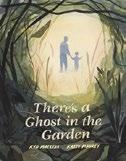
There are ghosts all around us if you look hard enough. When a child stays with a beloved grandparent, the two spend their time working in the garden. The youngster, who narrates, notes that there’s at least one ghost residing in their green space, evidenced by overturned pots and little trinkets left behind. As Grandpa and child, both light-skinned, continue to work, they reflect upon the whereabouts of these phantoms, on times gone by (“at the back of the house…there was an old bathtub…I would sit in…enjoying the sun like a sleepy turtle,” Grandpa tells the child), and on the beauty of just being. As the child’s visit comes to an end, the pair re-create the bathtub from Grandpa’s past using the very flora they so lovingly tended to; they sit in it and contemplate together. This quiet yet powerful book perfectly captures the emotional resonance of fleeting moments and the imprints they leave behind. Maclear’s stunning text is lengthy yet deliberately
paced (“memory has a geography just like the world”), suggesting the meandering feeling of revisiting memories. Rendered in a light, earthy palette, Maurey’s dreamy gouache illustrations are a natural complement to the text, further evoking feelings of stillness, remembrance, and the strong yet gentle bonds of family. A subtle but potent look at the ephemeral nature of life—and a reminder to cherish memories. (Picture book. 5-8)
Matula, Christina & Erica Lyons
Illus. by Tracy Subisak | Quill Tree Books/ HarperCollins (32 pp.) | $19.99
Sept. 10, 2024 | 9780063254718

A family observes two autumn holidays in this multicultural celebration. Ruby’s family is preparing for the Mid-Autumn Festival and Sukkot. Ruby and Nainai go to the Chinese market to buy fresh fruit, flowers, lanterns, and mooncakes filled with lotus seed paste and sweet red bean. Then Ruby and Zayde go to the Jewish grocer for fruits mentioned in the Torah such as figs and dates, plus the four species used in a Sukkot ritual. The family builds a sukkah, a hut made of plywood and evergreen branches, and decorates it with lanterns, including one that represents the jade rabbit from the Mid-Autumn Festival legend. Next, Ruby comes up with a perfect plan to combine both holidays: whipping up mooncakes that incorporate the traditional flavors of Sukkot and are festooned with Stars of David. The recipe is included at the book’s conclusion. While the mooncakes bake, the family briefly shares the stories of both holidays, which
A subtle but potent look at the ephemeral nature of life.
often occur simultaneously due to the lunar calendar. The colorful digital illustrations include Chinese brushwork—a lovely touch. The authors and illustrator effectively convey the fundamentals of both holidays to newcomers while also providing readers of Chinese and Jewish descent with a wonderful mirror that reflects their experiences. A much-needed exploration of the intersection of two significant Chinese and Jewish holidays. (authors’ and illustrator’s notes, information on the holidays) (Picture book. 4-10)
Medina, Meg | Illus. by Brittany Cicchese | Candlewick (32 pp.)
$17.99 | Sept. 3, 2024 | 9781536219449

A child prepares to say goodbye to a beloved babysitter. In the morning, Ana and Mami walk upstairs to apartment 4C, where señora Mimí awaits. As Mami heads off to work, Ana begins the day with señora Mimí, a “two-tooth baby” named Nelson, and Pancho, a “no-tooth dog.” Señora Mimí hurries Ana to school, but Ana’s nearly exploding with excitement. After all, Abuela plans to move in with Mami and Ana later that night. Now Abuela can babysit Ana while Mami works! After patient señora Mimí drops off Ana at school, Ana eagerly tells the entire class about Abuela’s imminent arrival. During class, Ana suddenly realizes that these treasured days with ever-present, dependable señora Mimí might end. How will señora Mimí be there for Ana now? A compassionate consideration of caregivers, Medina’s careful, playful text blends spare dialogue with telling details that, piece by piece, build up Ana’s tender friendship with señora Mimí. Hints of other everyday adventures shared between child and caretaker believably tease out the central conflict, which comes to a suitably upbeat conclusion. Cicchese’s artwork boasts a rich palette of warm shades of yellows, oranges, and browns. The main

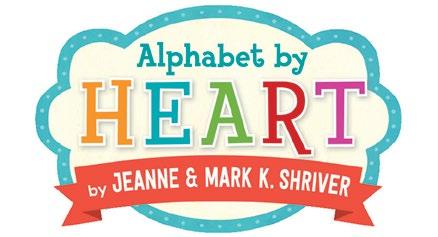
While exploring letters, little readers also discover big values to help them grow!

New York Times best-selling author Mark K. Shriver and Jeanne Shriver deliver a lively alphabet book that teaches letters and words while building positive values in the littlest minds!
LEARN MORE HERE:


Author of Mamá’s Magnificent Dancing Plantitas
JESÚS TREJO’S FAMILY members aren’t just his biggest supporters—they’re his literary inspiration. His debut picture book, Papá’s Magical Water-Jug Clock (2023), illustrated by Eliza Kinkz— about a young boy who spends the day helping his gardener dad—was a love letter to his father, while his newest, Mamá’s Magnificent Dancing Plantitas (Minerva/Astra Books for Young Readers, Oct. 10), also illustrated by Kinkz, is a tribute to his late mother. (See the review on p. 96.) In the story, young Jesús attempts to care for his mother’s plants—with hilarious results. Trejo answered our questions about the book via email; his answers have been edited for length and clarity.
What inspired you during the writing of the book?
The inspiration was my mother’s favorite gigantic pothos plant. I’m pretty sure this plant and I are the same age! I have vivid memories of her watering and caring for it with love, the plant wrapping throughout our apartment on Magnolia Boulevard in Long Beach, California. My mom said the plant was giving our home a big abrazo [hug]. I listened to music my mother enjoyed— mariachi, ranchera, and banda songs—which helped me channel her positivity, vibrance, and joy into the book.
How have family members responded to your books?
The coolest thing ever was when my parents got to see themselves as characters in Papá’s Magical Water-Jug Clock. My mother really liked the way she was illustrated. My father, on the other hand, said, “That doesn’t look like me!” Then later, “That does look like me! I remember wearing an outfit like that!” It was funny to see my dad come around and realize how Eliza Kinkz had nailed it.
You’re also a comedian. How do you incorporate your sense of humor into your picture books?
I try to tap into my beautiful upbringing and incorporate my little-kid logic and my sense of humor. In Papá’s Magical Water-Jug Clock , I included a joke from my debut appearance on The Tonight Show : “If you think about it, muffins love wearing corduroys.” Still one of my favorites! It feels great to see it in my debut book. I love seeing how the jokes land at live readings in schools and libraries. Who’d have thought you’d find hecklers in classrooms and libraries, too?
What was most challenging about writing this book? And most rewarding?
When Pap á’s Magical Water-Jug Clock was released last June, my mom was still alive. We had a beautiful moment in my parents’ living room, and my wife, Adria (who consulted and did the translation for



Mamá’s Magnificent Dancing Plantitas
Trejo, Jesús; illus. by Eliza Kinkz Minerva/Astra Books for Young Readers 48 pp. | $18.99 | Oct. 10, 2024 9781662651069
the Spanish edition), read the Spanish edition to my parents. Knowing that my mother isn’t around to see the completed copy of Mamá’s makes it a bit difficult for me. My amazing editor, Maria Russo, was patient and vital in bringing this special story to life during one of my most difficult times.
Last month we were in San Diego for the American Library Association’s annual meeting, where both Eliza and I received Pura Belpré honors. It was so rewarding to have my wife and dad there. Our hearts skipped a beat whenever someone mentioned how excited they were for Plantitas.
Interview by Mahnaz Dar.
characters are Latine; Ana’s community is diverse, and one classmate uses a wheelchair.
An affectionate shoutout to sitters. (Picture book. 4-8)
Kirkus Star
Griso:
Mello, Roger | Trans. by Daniel Hahn Elsewhere Editions (38 pp.) | $19.95 Oct. 1, 2024 | 9781962770088

A unicorn traverses the world, searching for another of his kind.
Translated from Portuguese, this Brazilian import, from a prolific master of the imaginary realm, zigzags through time and cultures to track the rare beast. When readers first glimpse Griso, his black body is edged with white and blue dots. The third-person narrative explains that “the last of the unicorns…was galloping all across the plains in search of another…just like him.” A chart at the book’s end notes that this portrayal is based on seventh-century Germanic art. The animal transforms in each mesmerizing spread, appearing in the color/style of the new art form: a Persian bas-relief, ancient Greek vase painting, a Tang dynasty mural. Mello trusts viewers to make these visual leaps as the shapeshifter interacts with horned whales, buffalo, and, at the height of danger, a medieval knight on a horse whose armored head bears a spike. The text unites the disparate compositions into a brilliantly cohesive story, presenting context about the time of day—e.g.,
bedtime—or the unicorn’s feelings of terror or loneliness. While Griso’s goal is unmet in one sense, in a scene set in Egypt, he does connect with another unique creature—the last of the winged horses, who is also weary, “having flown all across the plains in search of… another just like him.” Claudia de Moraes’ musings on unicorn sightings provide concluding inspiration. An evocative, enchanting tale of the quest for community. (Picture book. 4-8)
Moolani Mehra, Namita | Illus. by Beena Mistry | Kids Can (40 pp.) | $21.99 Sept. 3, 2024 | 9781525307355

A child’s world is upended during India’s Partition. Veena loves her family’s kitchen, a place “full of warmth and words.” She especially adores the buttery, round rotis that the women in her family make using local grains. She practices, and although her first attempts are misshapen, she’s soon able to make perfectly round rotis. Everything changes when India wins its independence from Great Britain and is subsequently partitioned into two countries—India and Pakistan— divided along religious lines. While many believe nothing will change, her father presciently declares, “India will no longer be the same.” Sure enough, Veena and her family are forced to flee their home in the middle of the night. They end up in a refugee camp, where they eat strangely hard, red rotis. Veena heads to the camp kitchen, where she finds a sense of belonging as she makes
rotis. When Veena and her family finally relocate to Delhi, India, she brings her rotis and the memories they hold into a brand-new kitchen and life. Inspired by the author’s grandparents’ experiences, this picture book provides a tender, optimistic look at one of the subcontinent’s darkest chapters. Though the book includes a map, readers may initially find it unclear whether Veena and her family are crossing into Pakistan or India. Still, the tale has a strong, specific emotional core, enhanced by gentle earth-toned images that leaven the often difficult subject matter.
A moving celebration of cultural and personal resilience. (Picture book. 3-7)
Odeh, Maysa | Illus. by Aliaa Betawi Henry Holt (40 pp.) | $19.99
Oct. 22, 2024 | 9781250896704

A young girl turns to her family members to help her answer the question, “Why isn’t Palestine on the map?”
Falasteen and her schoolmates sit around a world map searching for their countries of origin. When Falasteen asks why she can’t find Palestine, her teacher responds, “I think there’s no such place.” A concerned Falasteen goes home after school, eager for answers. Her grandfather, grandmother, and mother each provide a response that tells her family’s story and strengthens her sense of identity. Drawing inspiration from her own grandmother’s experience of displacement in 1967, the author tells a poignant story of longing and sadness mixed with a persistent hope for a return to a historic homeland and reunification with family. The book is notable for both its honesty and its sensitivity on the topics of “settler colonialism” (a term defined in the backmatter) and expulsion. Incorporating cultural touchstones such as spinach
pies and the winding branches of olive trees, Betawi’s delicately beautiful illustrations evoke nostalgia for a place dear to Falasteen and her family’s hearts. Odeh walks a fine line, framing her story in a way that young readers will readily understand while never sugarcoating difficult realities. Her book fills a gap in representations of the Palestinian diaspora, offering a muchneeded insider’s perspective. The author’s note provides vital personal and historical context, making this an invaluable teaching tool.
A haunting, powerful, and crucial tale of culture and identity. (resources for adults) (Picture book. 5-10)
Kirkus Star
Chooch Helped
Rogers, Andrea L. | Illus. by Rebecca Lee Kunz | Levine Querido (48 pp.)
$18.99 | Oct. 8, 2024 | 9781646144549
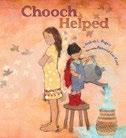
A young Indigenous girl attempts to get along with her infuriating little brother.
Sissy has a mischievous 2-year-old brother called Chooch—an affectionate nickname based on the Cherokee word for boy or son. No matter what the usdi (baby) does, he “just gets away with everything”—from painting streaks through Elisi’s mural to making a mess of Edutsi’s grape dumpling flour. Each transgression is followed by the same refrain: “Chooch helped.” Sissy has less tolerance for her brother’s “assistance,” and the last straw comes when Chooch damages her clay pot. After the fed-up narrator screams at the little boy, her parents yell at her, bringing the beleaguered sister to tears. But Chooch shows up to do what he always does—with his arms around a sobbing Sissy, “Chooch [helps].” Sissy comes to understand that young children learn by watching others and that her patience helps Chooch grow. Author Rogers and illustrator Kunz, both members of the Cherokee Nation, portray Sissy’s older sisterhood with
tenderness; illuminating backmatter explains the links between the story and the creators’ own heritage. The touching narrative and its universal lesson are brought to life through Kunz’s powerful images, which make stunning use of collage to illustrate the children’s rich familial and cultural webs. Readers’ hearts will be warmed by Sissy and Chooch’s relationship and by the moving representation of Cherokee traditions. Native life and language are at the center of this beautiful sibling story. (author’s and illustrator’s notes, instructions for creating a pinch pot, glossary) (Picture book. 4-10)
Seeger, Laura Vaccaro | Neal Porter/ Holiday House (32 pp.) | $19.99 Oct. 1, 2024 | 9780823448678

Bold graphics with “I spy” die cuts deliver a compelling call to save endangered and threatened species.
Seeger is well established as a master of the concept book, and her latest offering lives up to this reputation for excellence. It reads like a mashup of her earlier titles The Hidden Alphabet (2003) and Green (2012); she adopts a layout similar to the former and an ecological ethos like the latter while presenting the numbers 10 through one. The first spread shows the word ten on the verso in sans serif knockout type against a murky backdrop, while the facing page depicts the numeral 10 organically formed by the hazy background, revealed through a die-cut window in a brown gatefold page. When the gatefold is lifted vertically, the 10 appears as part of a reflective, watery setting where 10 sea otters huddle, adorably gazing out at readers. Ensuing spreads continue this pattern, showing nine elephants (the 9 formed by a pachyderm’s trunk), eight giraffes (the 8 appearing in markings on the animal’s fur), and so on. Seeger’s
choice of a count down provides a subtle message about the dwindling numbers of the portrayed animals, all of which, according to the backmatter, are “threatened or endangered, some critically.” Thumbnails with additional facts about the animals round out this artful, necessary picture book. Count on Seeger for powerful, accessible art for young readers. (further reading) (Picture book. 2-6)
Simpson, Tonya | Illus. by Delre é Dumont | Orca (32 pp.) | $21.95 Sept. 17, 2024 | 9781459836099

An Indigenous child falls asleep to the sacred sounds heard across the land.
“This land is a lullaby your heart already knows. / You carry the song from a lifetime ago,” begins this gentle story, narrated by a Native parent. Accompanied by Dumont’s (Onion Lake Cree Nation) richly textured, pointillist images, Simpson’s (Pasqua First Nation) simple rhymes offer an ode to the youngster’s ancestral homeland, the prairie and plains. As the child drifts off to sleep each night, the animals, plants, rain, and spirits—all as much a part of the land as the Indigenous family itself— create a tender symphony of care and connection. Laced with references, from the swirling grasses to the falling rain to the loon swimming beneath Grandmother Moon, the land’s lullaby reminds the slumbering child that “you are a sacred wonder” who should always listen for “the song your ancestors sing just for you.” These elements of the story are powerfully conveyed by Dumont’s vivid illustrations, which depict, with luminous intensity, lightning striking, galloping horses, shimmering lakes, and the nighttime sky. The book’s lexical simplicity and visual dynamism will engage even the youngest readers, providing a beautiful glimpse into the unbreakable bond between Indigenous
people, their lands, and their ancestors who are still a part of them. Like a stirring song, this tale will move readers with its tranquil, reverent tone. (Picture book. 3-6)
Slice, Jessica & Caroline Cupp | Illus. by Kayla Harren | Dial Books (40 pp.)
$18.99 | Sept. 24, 2024 | 9780593529904

W hether they “sing, learn, sign” or “stim, dance, crawl,” families who are diverse in terms of ability—all based on real people—enjoy a fun-filled day.
A grandpa cheers as a child who uses a prosthetic leg plays basketball; a child explores the boardwalk with Mama, who drives a mouth-controlled wheelchair; kids play puppets with an aunt who appears to be developmentally disabled and lives independently with a nurse’s help—all amply demonstrating the refrain: “With love and adaptation, this is how we play!” A father signs a bedtime story, and the families’ busy day winds down: “With love and adaptation, this is how we… // ZZZZZ ….” Though the rhyming text occasionally feels forced, Slice and Cupp, themselves disabled, realistically acknowledge challenges while keeping an upbeat, reassuring tone. They note that sometimes “bodies are not much fun. / They hurt and ache—can’t jump or run.” The accompanying image shows a child and an adult who uses a walker and takes medication; the two, on “days like this…love to cuddle. / Read our stories, nap and snuggle.” Harren’s detailed portrayals of myriad physical, sensory, and developmental conditions warmly embrace disability’s broad spectrum, and characters’ faces radiate love and enthusiasm. Backmatter includes a glossary of depicted conditions (unfortunately describing Braille as a language rather than a writing
Soontornvat, Christina | Illus. by Isabel Roxas | Knopf (48 pp.) | $18.99 Sept. 3, 2024 | 9780593644263

Young Leo learns that every vote counts.
Leo couldn’t be more proud of Dad, who just became a U.S. citizen and earned his right to vote—and Leo gets to go with him when he casts his vote for the president. At school, there will be a mock presidential election, and Leo’s excited. But when Cousin Ray announces that he’s not voting (“Do you really think one person is going to make a difference?”), Leo feels discouraged. Cautiously bolstered by reminders that people are still fighting for the right to vote in the U.S. and abroad, Leo casts a vote. When Leo’s teacher tallies the results, it all comes down to one ballot! Later, when the polling place is nearing closing time, Leo encourages others to stay in line, knowing that every vote matters. Soontornvat conveys a timely and accessible message of the power and importance of participating in the democratic process. Roxas’ mixed-media illustrations depict a community diverse in terms of age, race, and religion. Leo’s family is brown-skinned, though we don’t learn about their heritage. Facts about the U.S. voting process are integrated throughout the story; practical backmatter expands on that information. In a callback to Leo’s mock
election, Soontornvat details several states’ House of Representatives elections in which one vote decided the outcome. Publishes simultaneously in Spanish. An invaluable addition to any young citizen-in-training’s bookshelf. (Picture book. 5-9)
Trejo, Jesús | Illus. by Eliza Kinkz | Minerva/ Astra Books for Young Readers (48 pp.)
$18.99 | Oct. 10, 2024 | 9781662651069

Little Jesús assumes his most significant role yet: caring for his Mamá’s beloved plantitas. While Mamá watches her novela, a bored Jesús does chores, resulting in a mess. So Mamá comes up with an idea. Can Jesús be a big brother to her plants while she enjoys some TV time? Jesús is thrilled; an only child, he welcomes the idea of having plant siblings. With the self-appointed title of Chief Plant Officer, Jesús gets to work the next day. He cleans up the soil around the snake plant, chills out with the bunny ear cactus, and checks in with the Swiss cheese plant. When Jesús notices that Mamá’s cherished golden pothos plant looks a little sad one afternoon, he throws an impromptu dance party to cheer it up. Unfortunately, he knocks the plant over. “Ooooh noooo! Man down!” With Papá’s assistance, Jesús and Mamá come together to ensure her plantita looks better than ever. A companion to the resplendent Papá’s Magical Water-Jug Clock (2023), Trejo and Kinkz’s latest collaboration amuses with similar madcap humor and shenanigans, focusing on the supportive mother-son relationship briefly glimpsed system) and tips for caregivers on addressing disability with children. Characters are racially diverse. A wonderfully inclusive celebration of disability and family. (Picture book. 4-8)
An invaluable addition to any young citizen-in-training’s bookshelf.
LEO’S FIRST VOTE!
in the earlier book. As always, the miniature scamp’s hijinks and wry observations bring the laughs—though the antics feel a little over-the-top this time—to the forefront, matched in zany intensity by the bright, frenetic illustrations and abundant speech bubbles that break up the main text. Characters are Latine. Publishes simultaneously in Spanish. Another enthusiastic romp. (Picture book. 4-8)
Tullet, Herv é | Chronicle Books (56 pp.) $16.99 | Oct. 8, 2024 | 9781797232584

Art making is distilled into simple steps—and a whole lotta fun.
Black “dots, lines, smudges, and scribbles” appear on a white background. An unseen narrator instructs readers to place their hands on the page to feel it “vibrate.” On the next page, the patterns have formed the shape of a hand—the “drawing hand”—as if the dots and lines are reacting to the actual hand that’s touched them. In typical Tullet fashion, subsequent pages allow readers to interact with the book and to make art by following simple instructions. First, kids are invited to use their fingers to drag and drop red, blue, and yellow dots onto little marked x’s to make “a whole dance of dots!” and, later, a flower. Readers are asked to draw lines and then scribbles. Each prompt ends with bold, black lines transforming the project into a flower—even after some surprising twists. Encouraging phrases such as “Brilliant!” and “Bravo, bravo!” cheer readers on throughout. The inclusion of smudges and other imperfections beautifully provides nonverbal support for the affirmations. Tullet has molded a familiar formula into something both fun and meaningful. By starting simple and moving on to more abstract techniques, the book represents a scaffolded lesson at its best. The open-ended conclusion brilliantly takes
art out of flower territory and opens a Pandora’s box of creativity. A call to action that’s sure to make an artist out of anyone. (Interactive picture book. 3-6)
Weatherford, Carole Boston | Illus. by Ekua Holmes | Candlewick (32 pp.) | $18.99 Sept. 3, 2024 | 9780763697945

Two acclaimed creators have teamed up for an unqualified and unapologetic ode to Black hair. An opening double-page spread of colorful planets, aligned in a star-spangled night sky, is followed by a depiction of Black women wearing crowns and beaming. (The backmatter explains that in 2019, Black women all over the world “made history as the titleholders of five major beauty pageants.”) In rhyming verse, Weatherford pays tribute to the textures, styles, and intricate patterns of Black hair, as well as adornments, coverings, and products used to care for it. Metaphors and similes abound (“Like waterfalls, our hair cascades,” “each strand a story without end”). Accompanying Weatherford’s potent words, Holmes’ stunning collage illustrations, in a plethora of textures, colors, and patterns, accentuate characters’ beautiful brown skin. Many scenes highlight the important role that hair care plays in bringing Black women and girls together, including a depiction of a dark-skinned mother reading a story to her baby; both sport matching Afros, with a bright yellow sunflower adorning each head. An especially striking image depicts a rainy day, bathed in blues and purples, with three women wearing a hijab, a headwrap, and a gele and carrying yellow and orange patchwork umbrellas, alongside a woman
wearing a patchwork wide-brimmed hat—a stirring tribute to Black women’s beauty and verve. A breathtakingly gorgeous book that no reader should be without. (glossary) (Picture book. 4-8)
Willems, Mo | Illus. by Dan Santat Union Square Kids (40 pp.) | $18.99 Dec. 3, 2024 | 9781454951483
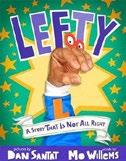
Willems continues his forays into the world of informational texts with an unusual overview of our left-handed history.
Two hand puppets (actual hands, there’s no felt here) named Lefty and Righty appear on a makeshift stage to present a story to the reading audience. They deliver shocking news: Historically, a person could get in “really, really BIG trouble” for being left-handed. As far back as ancient times, people would hide their left-handedness to fit in. Otherwise, “you might be fired or arrested or teased or thrown out of your village!” While incorporating the occasional choice callback to other Willems books—for instance, the phrase “Hubba Whaaaa!?!?” from The Duckling Gets a Cookie (2012)—the book empowers left-handed children to understand that “you can’t be born WRONG…RIGHT?” It takes very little to extend such a lesson to other groups forced to conform to society’s norms. As Lefty says, “If you’re hiding who you are, you feel rotten.” Meanwhile, Santat (clearly having a ball) draws historical sections in the style of Puritanical pamphlets, Greco-Roman friezes, and 1950s ad campaigns. Our main characters are real hands with illustrated glasses perched on top, allowing the artist to portray all kinds of emotions through their little drawn eyes. Humans depicted are diverse; the hands are light-skinned.
A handy message goes down smooth when delivered with a little history and a lot of shameless silliness. (Informational picture book. 4-7)





From rising star Tony Weaver, Jr. a witty and comedic graphic memoir for anyone who’s ever felt like they don’t belong From rising star Tony Weaver, Jr. a witty and comedic graphic memoir for anyone who’s ever felt like they don’t belong
★ “A powerful , poignant reminder that you are always worth fighting for.”
KIRKUS REVIEWS, starred review
rising star Tony Weaver, Jr. a witty and comedic graphic memoir for anyone who’s ever felt like they don’t belong Get Weird 9.17.24

★ “A touching story of belonging.”
PUBLISHERS WEEKLY, starred review
“Weirdo empowers readers to celebrate their own identities.”
JARRETT J. KROSOCZKA , National Book Award finalist for Hey, Kiddo
“A powerful story filled with empathy.”

Dan Santat, 2023 National Book Award winner for A First Time for Everything






Fall means saying goodbye to endless summer days—and hello to a fresh crop of new books. Tweens will lose themselves in our Fall Preview selections, from a “fiercely feisty and unapologetically goofy” adventure to a moving meditation on family, from the story of an aspiring surgeon in 15th-century London to the tale of a skeleton learning what home means.
Kirkus Star
Aguirre, Jorge | Illus. by Andr é s Vera Martínez | First Second (256 pp.) $22.99 | Oct. 1, 2024 | 9781250749741
Series: Monster Locker, 1

A locker in a middle school basement leads to world-ending trouble.
Sixth grade isn’t looking too good for friendless Pablo Ortiz, who still has no cell phone. Prepping for his sister’s quinceañera is no fun, either. “New year, new school, same crap.” Then Pablo pries open his locker to discover that Obie the Evil, a blobby, tadpolelike monster, resides inside. Obie wants Pablo’s help in unleashing “the world’s most loathsome monsters,” who will conquer and enslave all humans. After Pablo (who’d prefer to fly under the radar) refuses repeated requests, the persistent Obie tricks him into opening a portal to the realm of monsters, summoning Coatlicue. The vindictive Aztec Earth goddess releases frightening creatures in her wake that first attack Pablo’s school and then head out into Columbus, Ohio, transforming captured people into animals. Joined by his newfound friends and guided by his feisty, wise abuela, Pablo must step up to become an unexpected hero who saves the day in an unanticipated way. Centered on an amusing premise, this tale of ancient monsters and one very irate goddess serves up heaps of goofy humor thanks to its reluctant, pint-size Latine hero, comically antagonistic baddies, and frequent breaking of the fourth wall. A rich cast of culturally diverse characters, seamlessly inserted social commentary, and bustling, snappy artwork contribute greatly to a briskly paced adventure that teases a sequel. A simply smashing monster bash. (visual Nahuatl glossary, character sketches) (Graphic adventure. 10-14)
All the heart. None of the pablum. Sisterhood at its finest and freshest.
STELLA & MARIGOLD
Kirkus Star
Barrows, Annie | Illus. by Sophie Blackall | Chronicle Books (108 pp.)
$15.99 | Oct. 1, 2024 | 9781797219707
Series: Stella & Marigold

In this newest series starter from Ivy & Bean creators Barrows and Blackall, two loving sisters navigate the twists and turns of childhood.
From the moment Marigold was born, her 3-year-old sister, Stella, was her world, and vice versa. Seven short chapters relate the adventures of imaginative second grader Stella and spiky preschooler Marigold. Barrows plunges readers into the joys, certainly, but also the deep and abiding frustrations of being a kid. Whether Marigold has a bad time at the zoo or Stella fears that she’s losing her best friend, the two are always there for each other. The book homes in on distinct and familiar childhood moments with near-surgical skill; Barrows’ description of apple juice no longer tasting quite right when Stella is sick is particularly apt (“It tasted like throat”). The stories are certainly in the vein of Ramona Quimby (which the art directly references), in that no one in this book is saintly, beyond reproach, or so perfect that you can’t identify with them. Barrows also channels preschooler logic to an eerily accurate degree. Complementing the text, Blackall’s superb, digitally rendered art renders Stella and Marigold (who both present white) with fairly simple designs, then
brings to life their imaginings with incredibly detailed images featuring everything from magnificent lions to rooster heads.
All the heart. None of the pablum. Sisterhood at its finest and freshest. (Early chapter book. 6-9)
Beattie, Andrew | Illus. by Elena Dall’Aglio Sweet Cherry Publishing (304 pp.) | $8.95 paper | Sept. 24, 2024 | 9781802635539
Series: Tales From the Middle Ages, 1
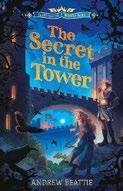
A lowly 12-yearold apprentice aspiring to become a surgeon in 1480s London is an oddity; even stranger is one who resembles an imprisoned royal. Amid the
ongoing Wars of the Roses, King Richard III has entered London with his troops, prepared to keep Henry Tudor from claiming the throne. Jack Broom, who lives with his apothecary aunt, Old Mother Broom, overhears adults speaking of chilling terrors. Many believe that Richard stole the throne from the deceased King Edward’s sons—two boys he locked in the Tower of London. Jack becomes acutely aware of the controversy when Richard’s soldiers, mistaking him for one of the princes, threaten him in a terrifying encounter: With his gray eyes and shock of blond hair, he’s a double for Richard Plantagenet. Even though people of his class don’t usually study with famed surgeons, Jack had previously hoped to enter the Tower to apprentice with Dr. Argentine. Now, as a child who knows nothing of the
parents he can’t remember, he seeks entry to uncover the truth about both Edward’s sons and his own lineage.
Jack’s goals align when courageous new friend Alice asks for his help with treating an unnamed patient in the Tower. Well-drawn characters populate this tightly plotted, strongly paced page-turner, which features intriguing reveals about secret identities and plentiful details about the deadly intrigues of the time.
Gritty and exciting: Readers will be hooked by the ruthless historical elements and compelling mystery. (map, historical note) (Historical adventure. 8-12)
Kirkus Star
Sylvia Doe and the 100-Year Flood
Beatty, Robert | Illus. by Jennifer Beatty Disney-Hyperion (320 pp.) | $16.19 Oct. 8, 2024 | 9781368007580
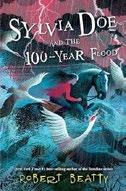
W hen Hurricane Jessamine assaults North Carolina, the Highground Home for Children is threatened by a once-in-alifetime flood.
Thirteen-yearold Sylvia Doe, who has brown skin and black hair, is a runaway who’s fled yet another foster home to once again return to Highground, a transitional institution that offers equine therapy for children awaiting foster placement. But this time her journey back to Highground is driven by different concerns. As the hurricane batters the valley, unprecedented flooding threatens the horses, home, and people Sylvia cares about. She secretly hitches a ride in a logging truck, risking her life to save her beloved horses. She also helps Jorna Grant, a mysterious 13-year-old Black boy. Jorna is strange, and Sylvia can’t quite figure him out, although he, too, seems “like a runner. And every runner has a reason.” Her social worker tries to figure out a new placement where Sylvia will stay
put, but Sylvia longs to remain at Highground permanently, even though North Carolina state rules won’t allow it. She also has another goal: to find out where Jorna came from and help him return home. She’s also convinced there’s “something much more happening” with the flood. Adventurous and suspenseful, this story pairs environmental science content with a genre-blurring mystery. Field guide–style illustrations of the animals that Sylvia encounters on her journey add a valuable learning component that emphasizes the ecological themes present throughout the book.
A page-turner that creatively explores resonant themes. (author’s note) (Mystery. 10-14)
Bolden, Tonya | Illus. by David Wilkerson Abrams Fanfare (128 pp.) | $15.99 | Sept. 10, 2024 | 9781419752698 | Series: Black Lives, 1

Profiles of nine Black men and women who have made significant contributions in scientific or technical fields.
With this work of graphic nonfiction, Bolden has two goals: introducing potentially lesser-known achievers while offering readers suggestions for professional careers. In lively language, the author traces the careers of five women and four men: beginning with Matilda Evans (1872-1935), a South Carolina physician who founded multiple clinics and hospitals, and ending with marine biologist Ayana Elizabeth Johnson (b. 1980). In between, Bolden presents scientists in several fields, as well as a commercial airline captain and a self-taught inventor. All smile encouragingly at viewers from Wilkerson’s squared-off scenes when not standing in thoughtful, dignified poses in characteristic settings, and though the panels aren’t sequential, a few of them feature direct quotes in dialogue balloons. Each
entry closes with a timeline and an inset box with additional names or facts; source notes at the end include references to exchanges between the author and some of her subjects. Tightly overlapping pictures and detached blocks of text battle with one another for space on many pages, which makes the narrative hard to navigate at times. Still, as role models, these nine are well chosen for their range of professions and backgrounds and are almost certain to be new to young readers.
A promising series kickoff, sure to stir the imaginations of burgeoning scientists.
(Collective graphic biography. 9-12)
Bowles, David | Illus. by Charlene Bowles Cinco Puntos Press (80 pp.) | $15.95 paper Oct. 29, 2024 | 9781947627697
Series: Tales of the Feathered Serpent, 2

Twin demigod brothers endeavor to fulfill their destinies despite familial troubles. Shirking their responsibilities, One Hunahpu (the demigod of maize) and his brother, Seven Hunahpu, wander into dark and glum Xibalba, the Underworld. A trick by the cruel King and Queen of the Dead leads to the brothers’ deaths.
One Hunahpu’s skull is placed on a tree branch in Xibalba as a gruesome reminder. There, Lady Blood—Underworld daughter of Duke Pooling Blood and Duchess Peeling Scab—meets and falls in love with the maize demigod’s soul. Soon pregnant with twin boys destined to “change the world forever,” Lady Blood flees to the Overworld to escape the wrath of the Xibalba rulers and finds refuge at the house of One Hunahpu’s goddess mother, who cares for his eldest (and abandoned) sons, Hun B’Atz’ and Hun Chowen. Once born, Hunahpu and Xbalanke gradually learn to wield the magic of song to free their father and uncle. But first, the heroic twins must deal with their angry and
envious older half brothers. This latest installment in David Bowles’ series devoted to Mesoamerican folklore weaves demigod-filled bombast with fanciful hijinks, star-crossed romance, and heaps of humor. Charlene Bowles’ artwork continues to leverage bold lines, earthy tones, and fluid action to further delight. An ominous cliffhanger hints at more intriguing exploits in the next volume. An engrossing tale of fledgling heroics. (author’s note) (Graphic fantasy. 8-14)
Burch, Ciera | McElderry (272 pp.)
$17.99 | Sept. 17, 2024 | 9781665930574

Preteen Naomi likes learning about nature from books and the internet, not from firsthand experience. But Naomi’s parents need some time to figure out their divorce, so she’s going off with her younger twin brothers, Aman and Omar, to Camp Twisted Pine in the New Jersey Pine Barrens. Camp is just as miserable as she predicted, but Naomi manages to make friends with (and maybe develop a hint of a crush on) Jackie, a hard-of-hearing girl who uses both English and ASL. Naomi’s logical, rational mind makes it hard for her to bond with her other cabinmates, especially when they start telling stories about the Jersey Devil. But maybe the Jersey Devil is real—and maybe he’s kidnapping campers. Or maybe the oddly young head counselor has something to do with the mysterious disappearances? Then there’s the highly invasive and subtly unnatural kudzu that’s growing throughout the forest. Naomi is a lovable, nerdy protagonist who resides in a world where the adults, though often well meaning, aren’t listening and it’s up to the kids to save the day. The story is fun and gently spooky with no real scares, and it’s likely to spark readers’ interest in ecosystems and conservation. A
genuine love and knowledge of the Pine Barrens is evident in the details of the setting. Naomi presents Black, and the supporting cast is racially diverse. Part campfire tale, part eco-fable, all charm. (Paranormal. 8-12)
Chan, Ruth | Roaring Brook Press (288 pp.)
$22.99 | $14.99 paper | Sept. 10, 2024 9781250855336 | 9781250855343 paper
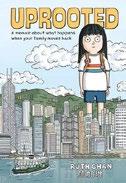
Leaving everything behind and starting anew requires courage, perseverance, and patience. It’s 1993, and Ruth loves her life and friends in Toronto. So when her parents decide to move back to Hong Kong, she can’t help but focus on the negatives. Not only will she leave her school and friends behind, but she has only vague, unpleasant memories of visiting Hong Kong when she was younger, and she understands but barely speaks Cantonese. On top of that, her older brother, who’s a year from graduation, will be staying behind to attend boarding school, and her dad will be traveling extensively for work in China. This is a coming-of-age immigrant memoir with a twist that highlights the complex nature of migration: While many such stories take the characters somewhere new, Ruth and her family are ultimately returning to her parents’ home, albeit one that’s unfamiliar to Ruth. A story-within-a-story retelling of Ruth’s father’s family’s flight during the Sino-Japanese War in the 1940s provides further depth and context. Chan illustrates the stories with her signature humor and wit. The panels, colored in a soothing palette, feature clean lines and vividly express the characters’ range of feelings. Many of Ruth’s reflections on her extended Chinese family will ring true to those with Asian or immigrant
families: A family tree that starts with Poh Poh and Gong Gong and ends with “NOT EVEN GONNA TRY” and an unwelcome encounter with a dish of chicken feet will have readers laughing in recognition.
Earnest, funny, and evocative. (language note, author’s note) (Graphic memoir. 8-14)
Clements, Andrew | Illus. by Brian Selznick | Random House (224 pp.)
$17.99 | Aug. 27, 2024 | 9780399557637

Clements’ last book, a posthumously published sequel to his beloved Frindle (1996). Sixth grader Josh Willett loves all things to do with computers—coding, creating, even doing his homework on his school laptop and submitting it online. But his hopelessly outdated English language arts teacher, Mr. N, requires students to bring physical books to class, uses a chalkboard instead of the SMART Board, and continues to insist that all assignments be handwritten, in “blue or black ink.” And neatness counts! When Josh’s search for an actual pen uncovers an old one of his mother’s from when she was in sixth grade, marked “Frindle,” Josh looks up the unfamiliar word online and finds a photo of 11-year-old Nicholas Allen, who looks a lot like a young Mr. N. Josh and his friend Vanessa investigate the mystery—and quickly discover that Mr. N. doesn’t want his past revealed. Written with Clements’ trademark humor and featuring his classic straightforward, persistent protagonists, this work takes on the modern digital world, both good and bad, while paying homage to E.B. White’s Charlotte’s Web and Strunk and White’s The Elements of Style. This volume lacks Clements’ sure touch and isn’t quite up to par with his best, but it’s nevertheless a fitting final work
BUFFALO DREAMER
from a master storyteller. Central characters present white; names cue ethnic diversity in the supporting cast. Final art not seen.
An engaging tale for the latest generation of Clements fans. (illustrator’s note) (Fiction. 8-12)
Drozd, Jerzy | Iron Circus Comics (248 pp.)
$15.00 paper | Sept. 3, 2024 | 9781638991434
Series: The Inscrutable Doctor Baer
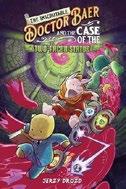
Ursine occult scholar Doctor Baer lives in gloomy seclusion with his many wards, demonic creatures who are under his stewardship.
When dastardly sorcerer Gallus Lugubrious attempts to steal Baer’s precious Stone Guardian statue and it shatters, he must team up with kindhearted Pickles (a pig) and cynical Taft (a giant tortoise) to retrieve the pieces. The uptight little brown bear, who wears a blue suit and an impassive expression, has never had reason to venture beyond his front door. He faces a steep learning curve that includes encounters with a cavalcade of supernatural horrors, strange adventurers, and a talking magic staff. But the demons have secrets relating to past traumas, and as the group makes their way through unforgiving natural landscapes, Baer begins to learn how a listening ear can heal. The phantasmagorical trip takes readers to a lost city in the jungle, across snowy peaks, and to the bottom of the sea, all rendered in luscious detail. This is
a story built on lore and one that’s well suited to the graphic format. While the breathless backstory details can be overwhelming, the care taken in portraying the environment and Drozd’s magnificent command of layout balance it out. Drozd clearly draws on a tradition of older fantasy adventure comics in a way that’s too rarely seen today. The energetic action sequences make good use of the dynamism inherent in scenes of anthropomorphized animals using complicated magic.
A creative odyssey. (excerpts from Doctor Baer’s files, map) (Graphic fantasy. 8-12)
Duncan, Violet | Nancy Paulsen Books (128 pp.) $17.99 | Aug. 27, 2024 | 9780593624814
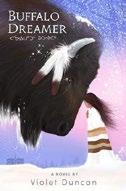
Drawing inspiration from her own family’s experiences, Duncan (Kehewin Cree/ Taino) tells the story of an Indigenous girl who confronts hard truths one summer. Twelve-year-old Summer, her brother, Sage, her mother, who’s Cree, and her father, who’s Apache, are visiting Summer’s maternal grandparents, who live on the Cree reservation in northern Alberta. Though Summer enjoys her time with her extended family—picking sweetgrass, fishing, listening to stories— she’s been having strange dreams about an Indigenous girl named Buffalo Dreamer fleeing in the night. Unmarked graves of children have been found at a nearby residential school, and many members of
the community are grappling with the abuse they faced there—including Summer’s Mosom (grandfather), who rarely talks about the experience. Summer learns more about how Indigenous children were forced into residential schools by the Canadian government. Are her dreams connected to this painful history? At a community rally and, later, a powwow, survivors acknowledge their wounds and begin to help one another heal. Duncan shines a light on a devastating aspect of Indigenous history, never sugarcoating the topic yet leaving readers with hope. Her writing is seamless, tight, and immersive, making stellar use of sensory descriptions, and she braids important truths into her captivating narrative: “We are the living proof of our ancestors’ resilience and the strong spirit of our people.”
Compelling yet heartbreaking—and essential reading for all young people. (glossary, author’s note) (Fiction. 10-14)
Gilligan, Paul | Tundra Books (240 pp.)
$14.99 paper | Oct. 15, 2024 | 9781774880463

A graphic memoir presenting a humorously disarming look at machismo and personal responsibility. It’s 1975, and 10-year-old Paul is enjoying a summer vacation with his Fantastic Four comics, military toys, and best friend, David Chu. The harmony is disrupted when Swain, an older boy, wins over both David and Bernie Dias, the youngest kid in the group. “Playing with” friends becomes the more mature “hanging out.” The guys are also fixated on the new blockbuster horror movie, Jaws. But the film traumatizes Paul to the point that he has conversations with an imaginary shark who pressures him into expressing the most toxic version of masculinity. Irish American Paul’s parents mostly talk over him, leaving
him to his internal monologues, particularly whenever his dad tries to teach him about cars. Between the shark and Swain’s influence, Paul briefly becomes a more callous version of himself, dispensing insults, throwing crabapples, and going along with Swain’s shoplifting dare. Paul is usually so gentle that he prefers to play baseball with a tennis ball; he ultimately tunes into his inner compass and resists being a jerk for the sake of impressing others. Elaine, Bernie’s sister, punctures male egoism on the spot, modeling maturity, and Paul and his friends ultimately demonstrate genuine growth. The simple but dramatically expressive artwork plays to Gilligan’s strengths with deadpan humor, and the text and illustrations work in harmony to convey complex insights and feelings with clarity. An authentic and funny look at masculinity and growing pains that resonates across the decades. (1975 Time Capsule) (Graphic memoir. 10-13)
Hoffman, Alice | Scholastic (304 pp.) $19.99 | Sept. 17, 2024 | 9781338856941
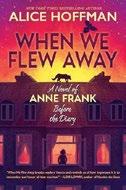
T he story of Anne Frank and her family before the diary that would become an iconic work of the 20th century. Hoffman imagines the Frank family in Amsterdam—their conversations, feelings, and interactions—during the terrifying time that led up to their hiding and Anne’s writing of her diary, which was published posthumously in 1947. Anchored in historically accurate details, this story portrays Anne as both hopeful and scared, clinging to her girlhood and normality even while her personhood was being systematically stripped away. Hoffman examines Anne’s complex relationships with her mother and older sister, Margot, in heart-wrenching scenes that show them to be typical of many
mothers and daughters. Historical information woven into the narrative serves as time stamps as the Franks move ever closer to their life in hiding. This context is helpful for readers and offers a startling reminder of the terror that took over Europe during World War II. Ultimately, Hoffman portrays Anne and Margot as the children they truly were, gripped with fear and telling each other stories for comfort but still eager to go for bike rides, celebrate birthdays, and try to live their lives fully. This novel serves as an insightful companion for Frank’s own diary or as a stand-alone entry into a terrifying and unforgivable time in history. Deeply moving and beautifully written. (afterword, further reading) (Historical fiction. 9-12)
Janowitz, Jessie | Sourcebooks Young Readers (368 pp.) | $16.99 Sept. 3, 2024 | 9781728272504
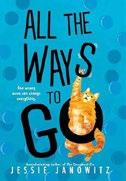
A New York City boy whose stress over winning chess matches takes him out of the zone intentionally throws an important match—but losing a chess camp scholarship as a result changes his world.
Milo and his mom end up spending the summer in Princeton, New Jersey, with a girl named Roxie, her philosophy professor mother, Nava, and their cats. The two women met through an online group for single moms; both used sperm donors to conceive. Milo, 12, and Roxie, 10, attend a day camp that’s filled with younger children, but fortunately, the two are designated counselors-in-training. After the kids meet some grad students who are playing Go, they become intrigued by the complex Asian strategy game. Obsessed, they visit a university library to do research (“free-range” Roxie shows Milo how to sneak in at night after hours) and persuade the counselors
to let them teach simplified Go to the campers. Milo, who’s longing for his grandma and best friend Henry, and Roxie, who’s very intelligent but struggles with social cues, grow closer, devote themselves to Go, and figure out various personal issues. Milo’s humorous first-person narration focuses on the philosophical intricacies of Go and his growing relationship with Roxie. Comical interludes show texts between Milo and his grandmother and Henry. Milo and his mom present as Ashkenazi Jews; Roxie and Nava are Persian Jews. A sweet story about friendship between an unlikely pair and the intrigue of an ancient strategy game. (author’s note, information about Go, resources) (Fiction. 8-12)
Laan, Triinu | Illus. by Marja-Liisa Plats Trans. by Adam Cullen | Yonder (64 pp.) $19.95 | Oct. 1, 2024 | 9781632063700

The things we fear don’t seem so scary once we get to know them. John is a classroom skeleton who, after years of helping students learn about science, is retiring to a new home in Grams and Gramps’ outdoor summer kitchen. After John inadvertently scares shoppers at the grocery store, Gramps repairs a few of his broken bones, and Grams dresses him up in an old coat and hat. He looks quite handsome. John fits right into his new family, saving the village from crooks and becoming a part of the stories that Gramps tells the grandchildren. He even takes part in an art exhibit in the city. More importantly, John offers quiet support to Gramps on difficult days and comfort to Grams on worried days. Translated from Estonian, Laan’s vignettes of life with John the Skeleton complement the illustrations— simple yet profound. Plats’ art is quirky but not scary. Her grayscale images make deft use of cross-hatching;
JOHN THE SKELETON
mood-busting hot pink punctuates the illustrations, from a scene of John making a snow angel to a depiction of the grandchildren rescuing snails in the garden. His presence feels symbolic, an acknowledgment that aging and death are facts of life; the story will encourage readers to care for one another and to appreciate the little things. Characters have paper-white skin.
A magical book that allows death to become a beloved part of life. (about John) (Fiction. 6-12)
Lemon, J.S. | Farrar, Straus and Giroux (208 pp.) $17.99 | Sept. 10, 2024 | 9780374392178

Middle school is a time of change for everyone, but especially for Greta, who undergoes a major transformation. Everything feels different in seventh grade. Greta Goodwin’s classmates seem obsessed with their developing bodies and having boyfriends. Meanwhile, Greta’s dreading an upcoming move to a new house that’s farther away from her best friend, Lotti Messina. When a boy named Derek invites Greta to a party, she’s excited about the attention but nervous about what the experience will entail. When Lotti quickly pairs off with a different boy, Greta is left alone with Derek, and everything turns sour. In the aftermath, Greta doesn’t feel right in her body, but then she starts to transform, shedding her skin and turning orange…and that’s just the beginning. At first, the experience is scary and embarrassing, but she gradually begins to feel powerful, beautiful, and at
ease with herself. This peculiar tale is a pitch-perfect encapsulation of middle school. Lemon demonstrates a deep understanding of the richness and intensity of adolescent friendship. The narrative is ripe for discussion; its unique direction might be too mind-boggling for some, but for others it will land perfectly and resonate deeply. Sexual assault is sensitively handled, and the backmatter offers further guidance. Most characters appear white. Friendship, healing, and being at peace with one’s self are at the heart of this moving and original story. (Fiction. 10-14)
McKinnon, Kate | Illus. by Alfredo Cáceres | Little, Brown (256 pp.)
$17.99 | Oct. 1, 2024 | 9780316554732
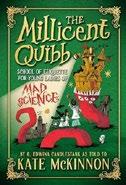
T hree young girls are tasked with saving their town from a vicious worm. This romp from actor McKinnon introduces the three Porch girls: Gertrude, age 12 and three-quarters, Eugenia, age 12 and one-eighth, and Dee-Dee, age 11. Cared for by Aunt Desdemona and Uncle Ansel (along with their seven cousins, who are all named Lavinia), they’re forced to live in a ramshackle shed at the edge of the property. In a classic turn of events, the sisters are invited to a new school run by a certain Millicent Quibb. Under Quibb’s eccentric tutelage, the trio learn that the nefarious Krenetics Research Association, hoping to release
their founder, Talon Sharktūth, from his vault, has bred a Kyrgalops, a vicious stone- and puppy-chomping worm, which may destroy their entire town.
McKinnon’s middle-grade debut is grandiosely silly, reminiscent of Lemony Snicket’s A Series of Unfortunate Events in both its sesquipedalian language and tone and in relying heavily on its bespoke lexicon, verbal gymnastics, and cheeky footnotes to deliver jokes.
Interspersed throughout are bits of visual interest—poems and songs, schematics, and bits of correspondence. Though the action rockets along at a Pixy Stix–fueled pace, many questions are left unanswered or unaddressed, making this series opener exposition heavy and a bit frustrating. Still, readers will ultimately be left hopeful that subsequent volumes will offer something meatier. The illustrations cue some diversity of skin tone among the characters.
Fiercely feisty and unapologetically goofy. (map, afterword, appendices) (Adventure. 8-12)
M é ndez, Yamile Saied | Algonquin (336 pp.) $16.99 | Sept. 17, 2024 | 9781643753980

A 12-year-old soccer star contends with joining an all-girls soccer team for the first time. Valeria “Magic” Salomón is used to standing out as both the only girl in the league and the best player on the team in her Utah hometown. But the news that Tía Antonella has passed away in Argentina arrives just as Magic gets her first period and embarrassingly bleeds through her white shorts in front of everyone during a State Cup match. This perfect storm of calamities throws Magic off her game. After they lose, she’s kicked off the team. Worse, her grandfather is the coach; Valeria has been raised by her paternal grandparents (she doesn’t know her birth mother, and her father, who was 17 when she was born, lives in Argentina). Though she knows Abuelo
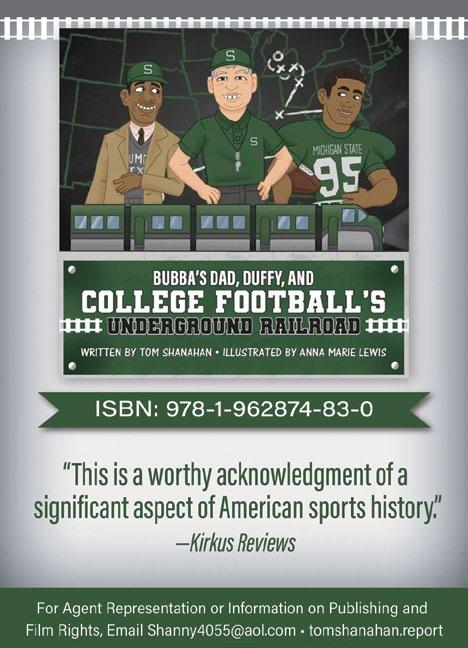




KAO KALIA YANG
Author of The Diamond Explorer
KAO KALIA YANG’S The Diamond Explorer (Dutton, Sept. 17) is one of her most ambitious books yet. The novel assumes multiple perspectives as it follows Malcolm, a Hmong American boy who takes part in a spiritual journey. Yang, a Hmong American author who was born in Thailand’s Ban Vinai Refugee Camp, is known for her compelling refugee stories. This latest, her first foray into middle-grade literature, is a resounding success; a starred Kirkus review (see p. 111) calls it a “profoundly moving musing on grief, connection (and lack thereof), and identity.” Yang responded to our questions by email; her answers have been edited for length and clarity.
What inspired you in writing the book?
My biggest source of inspiration and frustration was to accept that love cannot protect the beloved from the realities of our world, or the reaches of worlds beyond our own. I researched Hmong shamanism in texts, on YouTube, and via conversations with family and community members. I visited Minnesota’s historical sites and the contemporary ones, places of both genocide and genesis. I remembered what it was like to be young and uncertain; I know what it’s like to be older and to love young people and see how they’re hurt by the injustices and

inequities of our world, our individual experiences, our communal narratives, and the unknown possibilities.
This is your first time writing for middle graders. Did you approach this work differently?
I approached The Diamond Explorer cautiously. I knew the source of my inspiration, but I did not know where it would take me in the landscape of fiction. The middle graders I’ve met over the years have been clear in their request: Make this book scary. To accomplish that task, I knew the stakes had to be high and the book had to scare me first. I had to be brave in the writing process, to let the forces at play work themselves through me and onto the page.
You write from many perspectives in the book. What was most challenging?
The most challenging part about a book with many perspectives is to keep each one honest. I embraced the fact that we live in a complicated world, where perspectives contradict and counter each other, and I believe that the heart of the story is still beating within each [character]. Mrs. Bird lives in a world where her husband sees her goodness, even though she struggles to see the goodness of Malcolm [her student]; Malcolm lives in a world where Mrs. Bird is still his teacher even if, under the violence of her gaze, he shrinks and shrinks, and these things


The Diamond Explorer Yang, Kao Kalia Dutton | 208 pp. | $17.99 Sept. 17, 2024 | 9781984816337
happen even though there are people present who see these dynamics and their dangers.
Where and when did you write the book?
I wrote this book at my desk, in my office with its broken lock and white walls, my children flowing in and out. I wrote this book mostly in the evenings, in wintertime. During the writing, I felt cold, unable to retain enough heat for comfort, and yet I wrote earnestly in search of warmth. After each session, I felt a little dizzy from the experience, as if I’d traveled far from home, as if I had not fully returned.
Interview by Mahnaz Dar.
is grieving for his daughter, Valeria still feels betrayed that he’s let the assistant coach cut her, and she’s increasingly frustrated by Abuelo’s emotional distance. When Maxwell, Tía Antonella’s son, joins them in the U.S. and is given her spot on her old team, Magic has had enough. This tough and resilient protagonist is easy to root for as she talks her way onto a girls’ soccer team, despite having missed the tryouts. The narrative and action flow smoothly as Magic nervously navigates friendships with girls on her new team, adjusts to having a coach who prioritizes teamwork over relying on a hotshot, and navigates changing family dynamics at home. Fast paced and tenderhearted. (Fiction. 9-13)
Kirkus Star
Ness, Patrick | Illus. by Tim Miller
Walker US/Candlewick (208 pp.)
$17.99 | Sept. 3, 2024 | 9781536235937

Some are born great, some achieve greatness, and some have greatness thrust upon them, as this monitor lizard soon learns. Soon after Principal Wombat assures Zeke that she hasn’t selected him to be a hall monitor just because he’s a monitor lizard, he proves fairly inept at the job. He almost immediately punches local bully Pelicarnassus in the beak after a nasty encounter. Unfortunately, Pelicarnassus is the son of a supervillain, and after that fact is revealed, some of the wilder elements of this anthropomorphic school story come to the fore. For instance, because of an ancient family curse, the entire country of France appeared on Zeke’s knee after the death of his father. Ness clearly has a talent for balancing heart with mind-blowing silliness and whimsy. Such elements combine perfectly when Zeke’s mother, suffering from depression after the
passing of Zeke’s father, is followed by a literal black dog at all times. All this is punctuated by Miller’s ink drawings of the characters, perfectly matching Ness’ equally deadpan recounting of the action. Yet in the end, it’s Zeke’s slow growth into a hero that will touch readers’ hearts, gargantuan pelican robot suits and tiny fighter jets notwithstanding. Heart and weirdness in equal measure prove you should never underestimate the power of a lizard! (Fiction. 8-12)
Ed. by Oh, Ellen | Crown (208 pp.)
$17.99 | Oct. 22, 2024 | 9780593648445

We Need Diverse Books co-founder Oh follows up Flying Lessons & Other Stories (2017) with a collection of 12 interwoven, slice-of-life tales from acclaimed middle-grade authors.
In an unnamed American city stands a (potentially haunted) yellow apartment building called the Entrada, where aromas of food and loud sounds set the tone for a summer of communal living. Desirée, apparently of West Indian descent, helps Ro perform a lion dance for her Chinese school. Yaniel learns about his abuela’s history in Cuba while contemplating his feelings for Filipina American Pacy, a Star Trek aficionado with a crush on him. Many kids are first- or second-generation immigrants, and their cultures intermingle in authentic ways. Angel’s family is late on the rent, and his parents’ memories of their home city, Sephardic-founded Monterrey, Mexico, leads them to feel confident reaching out to their white Jewish landlords for help. Vietnamese American Hao discovers the ghost he’s been seeing around the building has a connection to Mr. Joe, the Italian American barber. Though each story was written by a different author—among
them Tracey Baptiste, Adam Gidwitz, and Erin Entrada Kelly—they nevertheless coalesce into a rich depiction of a loving community. With candor and sensitivity, the authors take on both lighthearted issues such as burgeoning romance as well as more serious ones, including bigotry and the harsh realities of the American dream.
A superbly rendered love letter to identity and heritage. (foreword by Meg Medina) (Anthology. 8-12)
Rundell, Katherine | Illus. by Ashley Mackenzie | Knopf (368 pp.) | $19.99
Sept. 10, 2024 | 9780593809860
Series: Impossible Creatures, 1

Two young people save the world and all the magic in it in this series opener. When tall, dark-haired, white-skinned Christopher
Forrester goes to stay with his grandfather in Scotland, he ventures to the top of a forbidden hill and discovers astonishing magical creatures. His grandfather explains that Christopher’s family are guardians of the “way through” to the Archipelago, where the Glimourie Tree grows—the source of glimourie, or the world’s magic. Black-haired, olive-skinned Mal Arvorian, a girl from the Archipelago, is being pursued by a murderer, and she asks Christopher for help, launching them both on a wild, dangerous journey to discover why the glimourie is disappearing and how to stop it.
Together with a part-nereid woman, a ratatoska, a dragon, and a Berserker, they face an odyssey of dangerous tasks to find the Immortal, the only one who can reverse the draining of magic. Like Lyra and Will from Philip Pullman’s His Dark Materials, Mal and Christopher sacrifice their innocence for experience, meeting every challenge with depthless courage until they finally
accessible tale of trauma, laced with a compelling sense of optimism.
reach the maze at the heart of it all. Rundell throws myriad obstacles in her characters’ way, but she gives them tools both tangible (a casapasaran, which always points the way home, and the glamry blade, which cuts through anything) and intangible (the desire “to protect something worth protecting” and an “insistence that the world is worth loving”). Final art not seen. An epic fantasy with timeless themes and unforgettable characters. (map, bestiary) (Fantasy. 10-16)
Kirkus Star
Kareem Between
Safadi, Shifa Saltagi | Putnam (336 pp.) $18.99 | Sept. 10, 2024 | 9780593699263

A football-loving, Syrian American Muslim boy must find the courage to confront feelings of being stuck in between the worlds of home, school, and wider society.
The start of seventh grade couldn’t have gone worse for Kareem: His best friend moved away, and Kareem was cut from the football team. His integrity is challenged when a chance for a spot on next year’s team comes with strings attached—helping Austin, the coach’s son, cheat by writing an essay for him. Kareem’s desire to fit in also affects Fadi, the Syrian Christian refugee classmate his mom has asked him to help. Tensions rise when Kareem’s mom is stranded in war-torn Syria as she tries to bring his grandparents to the U.S. Now Kareem must find confidence at school (where xenophobic Austin bullies Fadi)
and at home (where Mama’s absence is keenly felt). Safadi’s verse novel is set during the 2016-17 school year, amid the build-up to then–President Donald Trump’s executive order affecting travel from seven Muslim-majority countries, including Syria. The author uses line breaks, concrete poetry, and changes in the alignment of the text to powerfully and evocatively convey conflict between senses of identity and self and to accentuate the story’s action. She seamlessly integrates football, literary, Islamic, and Arabic language references into the plot. The book’s messages of finding the confidence to stand up against injustice and be true to one’s heritage are critically expressed without feeling contrived.
A masterfully written, deeply resonant tale. (author’s note) (Verse fiction. 8-12)
Smith, Cynthia Leitich | Heartdrum (240 pp.) $18.99 | Sept. 17, 2024 | 9780062870001

Humans and animals join forces, becoming an unexpected group of heroes working together to save the day.
Smith (Muscogee) opens with a Muscogee greeting and reintroduces characters many readers will know from her other books. Great-Grandfather Bat, a well-known ballplayer and revered elder, ponders his injured wing and its impact on the Great Ball Game. Bat catches a ride with Grampa Halfmoon from Chicago to Georgia, heading to a
rematch between the Birds and Animals. Young Ray Halfmoon, family friend Melanie, and Gray Squirrel join them. A fascinating circular structure connects the storylines, which contain expertly crafted humorous snippets, and the connection between humans and animal relatives will be evident to readers. Ray, Grampa, and Mel reunite with relatives. Grampa rekindles his connection with a former love interest. Mel faces inner turmoil as she finishes a school assignment while riding along a similar route her ancestors took on the Trail of Tears. When Grampa’s rez truck breaks down, pursuing stalkers add a mysterious twist. The novel also addresses important modern-day issues: Habitat loss, protection of the Earth and its animals, historical truths, and references to Native children’s literature are cleverly embedded in the story, and secondary characters with admirable careers support Indigenous readers in envisioning their own goals.
A unique and noteworthy tale that weaves together past and present with humor through stellar, multilayered writing. (map, glossary, author’s note) (Modern folklore. 10-14)
Smith, Heather | Tundra Books (160 pp.) $17.99 | Sept. 3, 2024 | 9780735267497
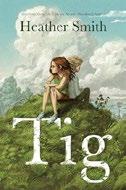
A once-neglected child forges connections.
Eleven-year-old narrator Tig (short for Tigger, a nickname her mother bestowed on the bouncy child) finds it difficult to trust the comfort and safety of her new home. Her mother abandoned the family several harrowing months before, running off with the boyfriend who physically and emotionally bullied Tig for years. Tig relied on big brother Peter, named for her late father, to figure out how to keep warm and fed in the cold, empty house. Now Peter helps her adapt to an unfamiliar situation. She’s wary, defensive, and angry as she navigates
the first weeks with Uncle Scott and his partner, Manny. The couple adopt a bull terrier for Tig and are steadfast in the face of Tig’s rage and hurt. Tig’s voice is convincing and intelligent, with notes of longing, sadness, and hope. The narrative doesn’t address whether Tig’s mother will face legal consequences and only fleetingly mentions contact with a social worker, but it’s clear that her new home with Uncle Scott and Manny is a permanent one. New friends Jacob and Jonah, Guten Morgen the dog, and Tig’s ambition to become the cheese-rolling champion of Wensleydale all help develop a sense of belonging. Jacob and Jonah are Filipino; Tig and her family are implied white. A moving, accessible tale of trauma, laced with a compelling sense of optimism. (Fiction. 9-13)
Spradlin, Michael P. | McElderry (160 pp.) $17.99 | $7.99 paper | Sept. 24, 2024 9781665947206 | 9781665947213 paper | Series: Web of the Spider, 1
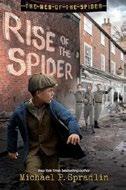
Tensions rise when a cadre of Hitler Youth arrives in a young student’s Bavarian town.
“They stood out like skunks in their brown shirts, black pants, and jackboots.” Rolf is upset to see the deteriorating relationship between his always-angry older brother, Romer, and their widowed father. But he’s more disturbed by evidence that Romer is drifting toward sinister, spiderlike Hans and the squad of uniformed thugs behind him—particularly after the distribution of recruitment leaflets is followed by arson and the beating of a local Jewish merchant as bystanders watch…some approvingly. Matters come to a head when Hitler speaks at a mass rally; Rolf comes away from the experience firm in his conviction that the Nazi takeover must be resisted. This fast-moving, stirring tale is set in 1929, but along with a timeline that begins with Hitler’s birth and ends in 1935, the author intersperses helpful flashbacks about the end of the First
World War, the 1923 Beer Hall Putsch, and other events presented as news stories. He also makes explicit the book’s cautionary purpose: “It’s common for us who live in democracies around the world to say, ‘it can’t happen here,’” he writes in his afterword. “It can.”
Clear of stance and cogent of theme. (glossary) (Historical fiction. 11-13)
Thomas, Kiah | Illus. by K-Fai Steele
Neal Porter/Holiday House (56 pp.)
$16.99 | Oct. 8, 2024 | 9780823457779

This anti-social lupine just wants to be alone.
Wolf—the sole animal in class 2B—growls at the children until they all huddle at the far end of the room. Mrs. Horsefly asks him to leave, so he visits an empty cinema. Another moviegoer arrives, so Wolf tries unsuccessfully to get rid of him, then heads for the shore. Happily, the beach is deserted, but, breaking open a bag of chips, he’s set upon by voracious seagulls, which eat his snack as he chases them. After laboring up a mountain, Wolf is briefly alone—until he’s joined by a clueless hiker intent on photographing Wolf. Wolf devises a plan: He invites everyone he’s encountered to a party at his house. They all arrive: kids, teacher, seagulls, movie theater patron, hiker. Just as Wolf had imagined, “It was horrible.” But absconding to the now-vacant theater, beach, mountain, and classroom, Wolf is “finally…alone.” Originality, mordant humor, copious, detailed color drawings, and a resolutely understated text make this tale a winner. A confirmed introvert, consistently ornery and ultimately unreformed, Wolf is a refreshing character who even becomes sort of admirable in his grumpy single-mindedness. Expressive cartoon art depicts him as doglike, though not cuddly; still, Wolf won’t scare readers, who are more likely to hope for a stuffie version. Human characters are diverse.
A charmer that’s sure to garner its protagonist a devoted following— much to his chagrin. (Early reader. 6-9)
van de Vendel, Edward & Anoush Elman Illus. by Annet Schaap | Trans. by Nancy Forest-Flier | Levine Querido (160 pp.) $15.99 | Nov. 12, 2024 | 9781646144587
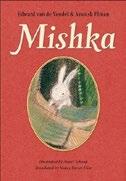
An Afghan family, having been recently granted stay in the Netherlands, decides to adopt a pet. Accompanied by her older brothers, 9-year-old Roya heads to the pet store, where she picks out a white dwarf rabbit, whom she names Mishka. The family finds in Mishka a symbol of permanence and safety. Roya, who was only 3 when the family fled Kabul, confides in the bunny, telling him that they had to leave because her father broke the law by teaching female students and because her parents were both free thinkers. Mishka’s presence helps the family cope with their pain and prompts Roya to ask more questions about their arduous journey across continents by plane, train, bus, and foot, through various Dutch refugee centers, schools, and continued denials for citizenship. Deftly weaving in moments of humor, joy, and sadness, the authors offer a gentle, child’s-eye view of the dangers the family faced, with underlying implications of trauma. Based on Elman’s own experiences and translated from Dutch by Forest-Flier, the narrative makes space for Roya’s long-delayed processing of her memories, as well as the antiimmigrant sentiment she encounters and the relief of belonging and home amid deep familial love. Schaap’s soft illustrations, set against brown backgrounds, convey warmth and calm; details in both the art and the text indicate that the family is Muslim.
Profoundly and charmingly moving. (Fiction. 7-10)
Kirkus Star
Warga, Jasmine | Illus. by Matt Rockefeller Harper/HarperCollins (224 pp.)
$19.99 | Sept. 10, 2024 | 9780062956705
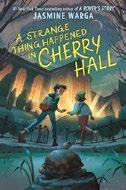
A missing painting, a floating girl, and a mustachioed man: a lonely almost-12-yearold vows to figure it all out.
Middle school has been terrible for Rami Ahmed, and now a painting has been stolen from the Penelope L. Brooks Museum, where his mother works as the cleaning crew supervisor. Only the cleaning crew, Ed the security guard, and Rami himself were in the building on the day of the painting’s disappearance. As the theft draws unprecedented interest in the small, largely overlooked museum, the pressure of suspicion starts to grow. When a mysterious girl appears to Rami in the museum—and he recognizes her as the girl who’s portrayed in the stolen painting— he’s certain that she holds the key to its whereabouts. After Rami joins forces with Indian American classmate Veda, an aspiring sleuth, he finds himself in increasingly unexpected situations. The mystery drives this exquisitely paced story that unfolds in short chapters that readers will quickly consume. The characters, though, are the beating heart of this tender, quiet tale. From Rami, the only child of a now-single immigrant mother from Lebanon, to the museum director, who “had that accent that most rich people do… fancy and well educated,” to Agatha, the sun-seeking turtle from the garden by the Penelope who observes, learns, and wants to give joy—each character is drawn with texture, depth, and warmth. Rockefeller’s evocative illustrations enhance the text. A slowly unfurling delight. (Mystery. 8-12)
Wood, Chelsea L. | Illus. by Dave Mottram | Godwin Books (176 pp.) $19.99 | Nov. 12, 2024 | 9781250833983

A parasitologist explains why no creature—including you—ever truly dines alone.
In their “flesh-gnawing, bloodsucking, poop-inhabiting lifestyles, parasites pretty much rule the world,” Wood claims, pointing to their near ubiquity in every corner of the biosphere. Along with marveling at the nearly miraculous way many of them have to pass through several species of hosts in order to complete their life cycles, she offers a highlight reel of unfailingly memorable examples—among them a nematode that coexists peaceably in the heads of white-tail deer but riddles the brains of any other species unlucky enough to ingest it, a cat parasite that can alter the behavior of both mice and humans, and the bacterium responsible for the Black Death. It’s all in good, as well as incredibly entertaining, fun, and anyway, as the author firmly notes, it wouldn’t be wrong to regard parasites as “good guys ,” considering the vital roles they play in controlling insect pests and even regulating ecosystems…not to mention the implications of alarming recent increases in autoimmune diseases in developed countries, where general exposure to parasites has been reduced. “We can’t live with them,” she sums up perceptively, “but maybe we also can’t live without them.” Mottram adds schematic views of select parasitical life cycles, livened by humorously expressive beasts and bugs.
An eye-opening, as well as stomach-churning, angle on who’s really the boss in the natural world. (glossary) (Nonfiction. 10-13)
Kirkus Star
Yang, Kao Kalia | Dutton (208 pp.)
$17.99 | Sept. 17, 2024 | 9781984816337
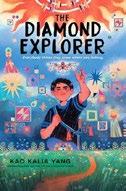
In Yang’s middle-grade debut, a Hmong American boy makes sense of his place in the world. In Part 1, readers meet Malcolm, who, through chapters written from the perspectives of his immediate family and elementary school teachers, grows from a kindergartener to a fifth grader. The youngest child of an older, working-class couple who came to Minnesota as refugees, Malcolm lives with his oldest sister, True, and her husband during the week so he can attend a private school; on weekends, he returns to his parents’ prairie home. Although this arrangement was a decision made with love, his family grapples with regrets and hopes. Meanwhile, many of his white teachers treat him differently due to their own biases. In Part 2, 11-year-old Malcolm takes over the narrative, revealing an introspective, sensitive, and lost young person. Malcolm collects family stories in order to “travel from the life I was living” and to connect with his family history. All four of his grandparents were shamans, and the shamans’ spirits are calling to Malcolm. After embarking on a spiritual journey, he finds himself literally immersed in the stories from his family’s history—stories from before he was alive, stories that aren’t without trauma. Lyrical, evocative prose deftly captures Malcolm’s longing for a sense of belonging; Yang has crafted a layered, profoundly moving musing on grief, connection (and lack thereof), and identity.
A true gem. (Fiction. 11-14)


I often think of fall as harvest time for bibliophiles; the season always brings plenty of new children’s books. This year, I’m thrilled to see collaborations from several literary dream teams, graphic fiction galore, and compelling nonfiction. Below are some highlights from our Fall Preview selections. Picture books make a strong showing this season. With Crowning Glory: A Celebration of Black Hair (Candlewick, Sept. 3), author Carole Boston Weatherford and illustrator Ekua Holmes team up again, following the awardwinning Voice of Freedom: Fannie Lou Hamer, The Spirit of the Civil Rights Movement (2015). Writing in mesmerizing verse, Weatherford sings the praises of cornrows, ’fros, Bantu knots, and more styles, conjuring up images that Holmes captures with her eye-catching digital collage art.
With the war in Gaza making headlines over the past 10 months, many young people are understandably confused and upset; Maysa Odeh’s A Map for Falasteen: A Palestinian
Child’s Search for Home (Henry Holt, Oct. 22), illustrated by Aliaa Betawi, offers child-friendly historical context for the current situation. When Falasteen can’t find her country of origin on her classroom map, she turns to her family for guidance. Their gentle but honest responses buoy her—and will enlighten young readers. Tinged with melancholy, yearning, and hope, this moving story reflects the experiences of many Palestinian refugees.
Mo Willems and Dan Santat know how to make kids laugh—and how to make them think. Framed as a conversation between a pair of hands, Lefty (Union Square Kids, Dec. 3) examines the historical stigma against left-handedness. Willems’ probing text will have kids contemplating the nature of prejudice, while Santat’s dynamic illustrations—featuring photographs of his own hands—keep the mood lively.
Middle graders are in for some treats this fall, too.
Cynthia Leitich Smith’s On a Wing and a Tear (Heartdrum, Sept. 17) offers a
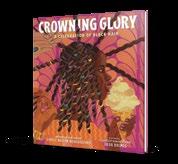



modern take on Muscogee folklore as a group of friends—both human and beast—head to the Great Ball Game for a showdown between the Birds and Animals. Smith (Muscogee) incorporates themes such as environmentalism and explores Native history; an especially noteworthy subplot sees a young Indigenous girl learning about the Trail of Tears. The result is a layered tale that’s by turns funny, poignant, and inspiring.
Known for their wildly popular Ivy & Bean stories, Annie Barrows and Sophie Blackall return with Stella & Marigold (Chronicle Books, Oct. 1), the first in a new chapter-book series about another dynamic duo. Centering on two loving sisters who support one another through sickness, school woes, and

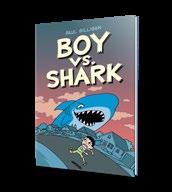
more, Barrows’ slice-of-life narrative speaks to the quiet joys and dramas of childhood. Blackall’s sweetly cartoonish art soars when it’s depicting the siblings’ wild fantasy life.
In Paul Gilligan’s graphic memoir Boy vs. Shark (Tundra Books, Oct. 15), his 10-year-old self, terrified after a viewing of Jaws in 1975, finds himself conversing with an imaginary shark who pressures him to squelch his softer side and act out to impress his peers, who have fallen under the spell of a mean older boy. With self-deprecating humor and honesty, Gilligan explores toxic masculinity, growing pains, and the challenges of staying true to oneself.
Mahnaz Dar is a young readers’ editor.
A young narwhal joins others of its kind on a long and perilous Arctic migratory round.
“You are a narwhal,” Fleming writes, “shy, / swift, / small (for a whale).” With one giant tooth that is “taller than a man,” not to mention “green with algae,” “alive with sea lice,” and still, researchers say, of uncertain function, the sleek, mottled form in So’Oteh’s glowing, light-drenched marine settings floats sociably with other members of its pod. “Side by side by side,” the whales peek out through a gap in the ice until hunger leads to a rolling dive into
darker regions for food. Lengthening days signal that it’s time to move to summer waters, avoiding predatory orcas; at summer’s end, the annual migration continues, despite the spread of ice across the water and roving polar bears that make access to the air hazardous.
Simultaneously immersive, lyrical, and informative, Fleming’s text shines, accompanied by So’Oteh’s luminous art. Narwhals may not (yet) be endangered, the author concludes, even if their Arctic habitat is definitely threatened by climate change. The species may be

of “least concern” to the International Union for Conservation of Nature, but in the wake of this sympathetic portrait and its substantially factual afterword, readers will find these real-life unicorns of “most interest.”
Rich in facts and feelings, a warm invitation to join the pod of sea mammal lovers. (bibliography) (Informational picture book. 6-9)
in love, family, and plenty of mud.
TEAM PARK
Emilio Sloth’s
Ahdieh, Ren é e | Illus. by Alea Marley Simon & Schuster (32 pp.) | $18.99 Oct. 22, 2024 | 9781534486614

A dapper sloth explains the importance of being courteous. Clad in a top hat and polka-dotted cravat, Emilio sets out to meet Neeta Swan for scones and tea. Many people believe that sloths move slowly, but Emilio has a different perspective: “I think certain things are worth taking my time.” What if Kumiko Nightingale were to sing a lovely song? The accompanying image shows Emilio happily taking in Kumiko’s music. And what if Emilio met a new friend? An illustration shows Emilio making the acquaintance of an adorable little mouse. One needs time to make a proper introduction and inquire about a friend’s day. Emilio also stresses the importance of listening: “If she is sad, I listen. If she is happy, I listen.” Remembering a new friend’s name is imperative, too. After all, “every name has a story!” The visuals depict Emilio journeying to meet Neeta, pausing to interact with others, and demonstrating respect and empathy for everyone. Ahdieh’s purposefully meandering text is filled with funny asides and sound insights alike; this tale goes beyond typical etiquette-focused stories, getting to the heart of what it means to be considerate. Marley’s cartoonish artwork anthropomorphizes the animals with quirky accessories. Readers will chuckle as the final illustration zooms out for a hilarious twist. A primer for good social graces—not just the standard “please” and “thank you”! (Picture book. 4-7)
Ahn, Angela | Tundra Books (240 pp.)
$17.99 | Sept. 10, 2024 | 9781774883433

A boy seeks himself within a family of big personalities. Ever since he broke his wrist, 11-year-old Korean Canadian Evan Park has been able to avoid his overbearing father’s questions about returning to team sports. Evan’s headstrong older sister, Lydia, has her gymnastics trophies, his little sister, Georgia, is busy being a cute 3-year-old, and Evan feels lost: “I just want to find something for me.” His physiotherapist suggests training for the junior division of the Dominator Ninja competition that’s coming up in a few months. Excited by the YouTube videos he sees, Evan feels he’s finally found something he’s chosen for himself and that he can excel at, so he starts building an obstacle course in his backyard to practice in. The straightforward, accessibly written narrative reveals the family’s sometimes fraught dynamics, as Evan’s laidback mom and traditionally hypermasculine dad each support him in their own ways. When Evan sprains his newly healed wrist, Lydia suggests the Parks enter the family team event of an upcoming “super muddy” obstacle course contest called Soiled Pants. The training process helps Evan understand what Lydia means about finding “the sweet spot” between “being competitive and doing your best, all while not being a jerk.” When Soiled Pants arrives, the Parks must rely on true collaboration. While some elements of the resolution feel pat, Evan’s dilemma is relatable, and
the story offers an entertaining look at serious issues.
A fun-filled romp grounded in love, family, and plenty of mud. (Fiction. 9-12)
Aldridge, Ethan M. | Quill Tree Books/ HarperCollins (240 pp.) | $18.99
Sept. 3, 2024 | 9780063283213
Series: A Deephaven Mystery, 2

Nev Tallow returns for another adventure at Deephaven Academy. Immediately following their previous adventure, Nev finds themself alone (but for one of the prefects) at the academy over winter break. It’s the perfect opportunity to explore the school’s spooky subbasement, which is full of strange magical items. Nev finds a human skull with scrimshaw etchings in its front teeth, but they also discover that they can’t get rid of it, no matter what they do. On top of that, bad things begin happening that seem to have been foretold by the images on the teeth. This second series entry is both tighter and scarier than the first, building on the spooky atmosphere and characters developed in the earlier book and written in the same quick-moving prose that’s full of evocative imagery. Notably, though the story revolves around the supernatural, Aldridge takes a pragmatic approach toward practices that occur in the real world, such as prophecy and astrology. Nev, who presents white, is a clever protagonist, relatable for readers who feel a little bit like outcasts. Their best friend, Danny, who reads Black, is a likable supporting character who deserves more page time. As in the first book, there are illustrations throughout that recall gothic etchings but in a modern, graphic-novel style. Though this mystery is resolved, we’re lucky that Nev has a number of school years left at Deephaven as well as a basement full of unexplored occult artifacts. Good, spooky fun. (Supernatural. 8-13)
Alexovich, Aaron | Viking (240 pp.)
$23.99 | Sept. 10, 2024 | 9780593528112
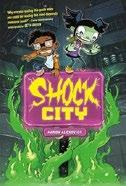
A human boy and a monster girl form an unlikely duo to save their city. Green-skinned, purple-eyed Sunny Von Shock is thrilled to have a visitor, even if anxious Milo, who has light brown skin and wavy black hair, only rang her doorbell on a dare from classmates. The lonely monster immediately embraces Milo as a friend and is devastated when he announces a few weeks later that his family is leaving Shock City; his parents believe it has a lot of “not fixable” problems. Hilariously upbeat Sunny, who loves to tinker with machines, is determined that she and Milo actually can fix everything, so Milo can stay and (crucially) come to her birthday party. As they work to rid the city of threats such as Frost Clowns, radioactive gas leaks, and undead children, Milo tries to explain to Sunny precisely why Shock City is in such a poor state. When he finally reveals that her late grandfather, Great Darkness Von Shock, wasn’t “the greatest science wizard of all time” as she believes, but rather, a corrupt and “ famously evil” tyrant, Sunny is determined to set things right and make humans change their minds about her family. Milo must brave his greatest fears to help the one friend who unconditionally embraces him. The vibrant colors and varied panels elevate the fast-paced reading experience. Against a backdrop of imaginative thrills and chills, Alexovich explores themes of friendship and perseverance in genuinely touching ways. A heartwarming and nail-biting adventure. (Graphic adventure. 8-12)
Allain, Stephanie & Jenny Klion | Illus. by Marissa Valdez | Candlewick (32 pp.)
$17.99 | Aug. 6, 2024 | 9781536226508

Children take ownership of their bodies through repeated affirmations.
A child rendered in black-and-white sees a colorful flower. “Who’s in charge?” an unseen narrator asks. Vibrant colors swirl around as the child holds the flower and stands proudly against a rainbow background: “I am!” Page turns reveal more children in nearly monochromatic settings taking charge of various body parts. “Who’s in charge of your nose?” the narrator asks. “I am!” declares another youngster as a glowing bug rests on the child’s nose. Others proudly announce that they’re in charge of their toes as they dance around the sun. Continuing to assert their bodily autonomy, children blow bubbles, wiggle their hips as they play with hula hoops, snap their fingers, and clap their hands—all examples of joyous movement. Later, the text overtly tackles consent, asking questions such as “Who’s in charge of your space?” and “Who’s in charge of your choice?” More “I am” affirmations ensue. The final spreads depict children in their own personal bubbles peacefully engaging in various activities, followed by a resounding group “I AM!” While the book’s message is a serious and important one, the playful rhymes and eyecatching art keep the tone light. Valdez’s stylish watercolor pencil illustrations feature racially diverse children; one child uses a wheelchair. A colorful and effective take on consent. (authors’ note) (Picture book. 3-6)
A heartwarming and nail-biting adventure.
Kirkus Star
Ayoade, Richard | Illus. by David Roberts
Walker US/Candlewick (128 pp.)
$17.99 | Oct. 1, 2024 | 9781536222173
Series: The Fairy Tale Fan Club

Actor/comedian
Ayoade presents a tongue-in-cheek collection of purported letters to and from wellknown fairy-tale characters from Western tradition.
Bibliophiles will love this story from the beginning, where the supposed narrator—C.C. Cecily, the Senior Secretary of the Fairy Tale Fan Club—explains how he came to compile and edit this work. He considers himself a physical coward who possesses great literary skills— supposedly in contrast to most fairy-tale folk. Less enthusiastic readers will perk up if they skip the nattering introduction and start with the hand-written letter from “Ira (aged 8)” to Little Red Riding Hood. Ira questions how Red could possibly have mistaken a wolf for her grandmother. Red’s response, which explains how much her grandmother resembles a wolf, is supported by humorous art. Cecily’s comment about Red being “literally wolfed down” is the first of many puns. The text also abounds with literary, historical, and biblical references—and even some potty humor, as when Prince Charming offers Prince Farty Pants advice on coping with gastrointestinal woes. Each epistolary set riffs on different aspects of humankind and of literature. Sleeping Beauty snarkily defends her lifestyle by expounding on sleep science. Cinderella assumes an iPad is a cleaning supply. The laugh-out-loud letter from Humpty Dumpty scrutinizes anthropomorphism. Facts occasionally surface, including the original plot of Hans Christian Andersen’s “The Little Mermaid.”
Droll sketches, rendered in pencil with bits of digital color, perfectly complement the text. Happily ever after, mortal reader! (quiz) (Fiction. 8-14)
Barnett, Mac | Illus. by Sydney Smith
Viking (40 pp.) | $18.99 Oct. 22, 2024 | 9780593524978

Even the man with the bag needs a little help getting into the Yuletide spirit. Barnett returns with yet another Christmas title, following How Does Santa Go Down the Chimney? (2023), illustrated by Jon Klassen. Prepare for some potential confusion, since the titular “first Christmas” isn’t about the first time Santa started delivering gifts, but rather the first Christmas Day he’s celebrated himself. Usually after working hard on Christmas Eve, Santa sleeps in an extra half hour and then gets right back to work. The elves and a concerned polar bear decide to take matters into their own hands, so this year they surprise Santa with breakfast in bed on Christmas morning, then plunge into other activities: trimming a Christmas tree, stringing the North Pole up with lights, baking cookies, reading stories aloud, giving Santa presents, and enjoying a feast so decadent that it would make a reformed Grinch blush. Barnett narrates with a pitch-perfect mixture of droll amusement and holiday charm: Santa initially appears to be humoring his elves, only to really get into the spirit himself. Smith’s signature illustrations rely on bright colors and shapes. This seeming simplicity is belied by each scene’s unique lighting and reflections, imbuing everything with a singular warmth. Santa is pink-skinned and rosy-cheeked; the elves vary in skin tone. Cozier than a roaring fire and sweeter than milk and cookies, this earns its “Christmas classic” stripes with flying colors. (Picture book. 4-6)
Boyd, Aaron | Whitman (32 pp.)
$18.99 | Oct. 3, 2024 | 9780807529126

A father spends quality time with his son.
On a snowy school night, a child narrator is picked up from his mom’s place. Daddy is there with his old, rusty car and telltale frayed black knit cap (“his crown”). The duo hop in the car together and head to Grandma’s house. The slightly somber car ride introduces some familial tension (“Don’t matter what he did or didn’t do. Daddy just got hit hard”), but the child focuses on love. After all, “Daddy always gives good. He always protects your feelings.” In Daddy’s room at Grandma’s, they construct model planes. It’s quiet at first, but soon the room is filled with laughter. Their precious time together comes to an end, but before dropping the child back at his mom’s, Daddy, noticing that the boy doesn’t have a hat, gives him his own cap—a tangible reminder of Daddy’s loving, generous spirit. Boyd beautifully depicts a father-son relationship weathering the difficulty of parental separation. Appropriately vague text immerses readers in the perspective of a child who lacks the full vocabulary to understand the situation. The cold tones outside of Daddy’s room contrast with the warmth inside to create a cozy, loving feeling when they share space together. The textural, photorealistic art style adds a richness to the double-page spreads. Like Boyd and his child in the author photo, Daddy has brown skin, while the child is lighter-skinned. As special as can be. (Picture book. 4-8)
Brandt, Juliana | Aladdin (352 pp.) $17.99 | Sept. 3, 2024 | 9781665948289
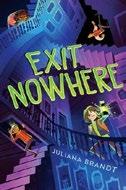
A middle schooler gets trapped with classmates in a haunted manor where they must reckon with a vengeful ghost.
After quiet loner Barret Eloise’s teacher groups her with Helena, Wayne, and Ridge for a project on local history, the unlikely foursome settles on Raithfield Manor as their topic. As part of their research, they interview a woman at the realty office that’s trying to sell the old house. She fills them in on the history of the Raithfields, who moved out during the Great Depression after four of their children died. When the kids sneak into the long-abandoned mansion around which rumors whirl (after all, their teacher wanted them to “experience history”), they end up imprisoned. The house transforms into a series of terrifying challenges—for example, the library floor becomes waves of lava— run by a tortured, power-hungry ghost. The only way to survive, the kids reason, is to triumph over every obstacle. Experienced genre fans may guess the ultimate reveals; however, the scares are safe for newbies, and the book will appeal to readers who enjoy ghost stories. Barret Eloise is a sympathetically struggling protagonist, someone who stumbles over her words, is focused on school almost to her own detriment, and sometimes misses social cues. Her relationship with Helena offers meaningful representation of fraught tween friendships, and the connections among the four classmates are special in
Cozier than a roaring fire and sweeter than milk and cookies.
SANTA’S FIRST CHRISTMAS
their own right. Helena is cued Black; other major characters present white. Well-drawn characters encounter tame spooks. (blueprints) (Horror. 9-12)
Brar, Kuljinder Kaur | Illus. by Samrath Kaur | Annick Press (32 pp.) | $18.99
Oct. 1, 2024 | 9781773219059
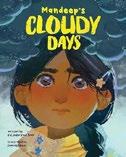
A young South Asian girl is devastated when her dad takes a job that keeps him away from his family for long periods. Mandeep loves spending time with her father. Together, the two sip cha, dance bhangra, and write jokes in Mandeep’s journal. So when Dad is hired as a long-distance truck driver, Mandeep immediately slips into a stormy sadness. At school, she runs out of the classroom when her well-meaning teacher tells her to pay attention, and at home, her mother’s suggestion to clean her room fills her with uncontrollable rage. Although her friends and family try to cheer her up, nothing works until she opens her journal and lets it all out, writing about how much she misses her father and describing all the things he wasn’t here to experience. The practice of journaling eases her turmoil; Mandeep can function once more—and even feel happiness. The author deftly portrays the signs of childhood depression, making space for the protagonist’s negative feelings. While the characters aren’t explicitly described as Sikh, the book incorporates elements of Sikh culture, such as Dad’s turban. Though the resolution feels somewhat oversimplified—such intense emotional distress would likely call for methods beyond journaling such as therapy—overall, it opens up an important conversation about grief, loss, and coping. Making use of arresting imagery and intense colors, the illustrations convey the depth of Mandeep’s anguish.
A somewhat simplified but poignant depiction of childhood depression. (Picture book. 4-8)
A relatable way to help little ones confront big feelings.
WHO TOOK MY LOLLIPOP?
$18.99 | Oct. 15, 2024 | 9781665910248

A child wants to comfort an elephant friend but doesn’t know how. Wandering around a woodsy setting, the brown-skinned youngster, in yellow hoodie and red pants, knows that the pachyderm is unhappy. What to do? Writing in second person, in rhyming couplets, an unseen narrator offers practical advice: “Do something silly to make him laugh? / Give him a scented bubble bath?” When these actions, pictured amusingly in soft gouache, pencil, and cut paper multimedia illustrations, don’t make things better, the text shifts in tone: “Your friend may want to take a walk. / You can be quiet together… / or he might want to talk… // and talk… // and talk.” With each page turn, colorful shapes explode from the elephant’s mouth, growing wilder and more frenzied. He takes on more human features as he expresses his anger. The elephant looks exhausted, and the narrator tells us, “He might have many troubles to tell. / Don’t interrupt. Just listen well.” The next page includes three vignettes depicting the elephant’s intense feelings, his gray body suffused in hues of blue, red, and yellow as he sobs, stomps his feet, and throws himself to the ground, yelling—a scene that stands out for its visual impact. Supporting social-emotional learning, this candidly reassuring book can be effectively used with young children in classrooms, libraries, and at home to encourage
discussions about friendship, sadness, and sensitivity.
Digs a little below the surface of most child-animal friendship books to explore deeper emotions. (Picture book. 4-8)
Cenko, Doug | Illus. by Shauna Lyn Panczyszyn | Feiwel & Friends (32 pp.)
$18.99 | Oct. 29, 2024 | 9781250867582

Has Squirrel’s lollipop been stolen? Squirrel admits that he has a temper, but he’s been working on managing it with yoga and breathing exercises. When his lollipop goes missing, he insists—as calmly as possible—that one of his friends must have taken it. Squirrel’s furry pals try to explain that the lollipop is simply stuck to his tail, but Squirrel, full of self-pity and accusations, won’t let them get a word in edgewise. In the end, Squirrel’s temper does get the better of him, but he redeems himself by saying sorry. His friends accept his apology and help him move on. Readers are in on the joke, watching Squirrel frantically search and point the finger at his friends while the lollipop hangs from his tail. The cutesy woodland creatures all wear little articles of clothing; Squirrel’s clad in a puffy orange vest, while Mouse wears a huge pair of pink glasses and a green jacket. Their faces are expressive; Panczyszyn deftly portrays Squirrel’s progression from anxiety to panic to an eruption of frustration and anger. The illustrations are largely set against white backdrops, with little detail, though the book has plenty to spark conversations among young readers about emotions, friendships, and self-improvement. A relatable way to help little ones confront big feelings. (Picture book. 3-6)
VIRUS HUNTERS
The Littlest Christmas Tree
Chapman, Jane | Tiger Tales (32 pp.)
$18.99 | Sept. 3, 2024 | 9781664300477

A bear cub befriends a tiny Christmas tree. Cubby tromps through the snowy woods with Daddy Bear and other forest friends to search for a Christmas tree. Cubby slips in excitement and tumbles “into a flash of fuzzy green.” Instead of Cubby finding a tree, a tree has chosen Cubby! Daddy Bear lugs it home to their den. Amid the flurry of lights and other decorations, Cubby bonds with the tree, reading it stories and attempting to share cocoa with it. (Luckily, Daddy Bear steps in before the hot liquid spills everywhere.) Cubby snuggles next to Little Tree at night and confides, “You’ve filled our home with happiness.” On Christmas Day, all the woodland friends come to celebrate. But when it’s time to take the decorations down, Cubby is sad. “That means Christmas is over. It’s the end of… HAPPINESS!” Daddy Bear shows Cubby how they can replant Little Tree outside their den to use again next year. Centering a single-parent family, this sweet tale reminds readers that they can hold a little bit of Christmas magic tight each day, not only during the holiday season. Quaint illustrations of Cubby and Daddy Bear set cozy scenes, reminiscent of those in collaborations between Chapman and author/ illustrator Karma Wilson. A nod to both Christmas excitement and post-holiday big feelings. (Picture book. 3-6)
Chen, Li | Andrews McMeel
Publishing (208 pp.) | $12.99 paper
Oct. 15, 2024 | 9781524882587

This cat is on the case!
Trench coat–clad Beans— called Jellybean by his affectionate mother—is a majorly cute tabby who takes his job seriously. As he tells Mom, he’s “a hard-boiled detective cleaning up this city one case at a time.” He abandons his current investigation (identifying the sender of his many “mysterious yet heartwarming,” affirming sticky notes) when his fedora, an essential professional accessory, vanishes. Beans questions Bird, who found the hat—and traded it away to a pair of kittens for a new TV. Next, Beans heads to Pigeon Park, where the kittens tell him they gave the hat to a magician. And so it goes, as Beans visits a magic show, a community garden, an ice cream shop, a jazz club (“The Black Cat,” of course), an antiques store, a restaurant, and more. Beans briefly regains—and then loses—the hat, and a chase ensues as the tale reaches an ever-more-exciting crescendo before coming to a thrilling conclusion. Snazzy, appealing artwork, with firm lines, stylish focus, and an atmosphere reminiscent of hardboiled, 1930s detective tales, enhances this absurdly funny and clever graphic novel, which features vivid characters, snappy dialogue, and nonstop action. Catnip to feline lovers and mystery fans alike. (Graphic fiction. 8-10)
Cheong, Peter | Henry Holt (32 pp.)
$18.99 | Oct. 8, 2024 | 9781250907578

A child embarks on a fantastical underwater adventure with mermaids. The tanskinned, black-haired protagonist befriends a mermaid, who gives the child a necklace. The youngster shows the gift to an adult, who inexplicably recoils and confiscates it. The child secretly finds the necklace, races down the dock, and dives into the water, where the mermaid awaits. In a nod to fairy-tale lore, the necklace gives the child the ability to stay underwater indefinitely. Other mermaids join the two, and the protagonist marvels at the beauty of marine life. But seeing a mermaid parent and child awakens old memories in the youngster. “I’ve had the most wonderful time,” the child says. “But I’m coming back home.” Minimal text describes the basics of the story but at times feels superfluous; the bulk of the narrative is propelled by the striking illustrations. Bold blues, oranges, and greens in textured strokes dominate the dramatic artwork. Though the characters are wonderfully expressive, readers may be confused about some elements of the plot, depending on what details they notice or overlook. Those who start reading after the title page, for instance, may wonder where the necklace came from; they’ll need to flip back to see the earlier pages that show the mermaid giving it to the protagonist. A visually compelling, though at times cryptic, homage to the lure of adventure and the promise of home. (Picture book. 4-8)

For more by Peter Cheong, visit Kirkus online.
Cherrix, Amy | Harper/HarperCollins (336 pp.) $19.99 | Sept. 10, 2024 | 9780063069541

Explains how scientists study— and learn how to predict and counter— disease outbreaks.
In six parts, Cherrix frames six different outbreaks as compelling mysteries to be solved. “The Case of the No-Name Virus” takes readers to the U.S. Southwest of the 1990s, where observations by dendrochronologists who learned from A:shiwi people and medical data from the Korean War enable an “elite corps of epidemiologists at the CDC” to crack the case and prevent further spread of the hantavirus. Next, readers travel back to the filthy London of the mid-1800s to follow John Snow as he tracks a cholera outbreak to its source, pioneering techniques that are still used today. After giving historical background on the 1918 flu, the text follows scientists over many subsequent decades as they try to learn enough about the outbreak to prevent such a pandemic from happening again. The next section covers the globally coordinated effort (by both scientists and laypeople) to defeat the “ancient enemy” smallpox. Community involvement takes center stage in the documentation of the role activists played in raising awareness and even shaping drug trials during the HIV/AIDS outbreak of the 1980s and ’90s. The final section chronicles how the unprecedentedly fast development of the Covid-19 vaccine came about thanks to years of earlier work. The straightforward language (including impressive scientific explanations) and human-focused narrative structure make for a readable book, bolstered by sidebars and extensive backmatter for credibility. Optimistic, informative, and inspiring for future scientists. (bibliography, endnotes, index) (Nonfiction. 10-18)
Cho, Lian | Harper/HarperCollins (40 pp.) $19.99 | Oct. 29, 2024 | 9780063237513

A girl receives a mysterious letter. “Dear Cutie: You are invited to the annual Pig Town Party,” reads the invitation that floats through the narrator’s mail slot. The child, tan-skinned with triangular black pigtails, a cartoonishly square jaw, and dots for eyes, agrees that she is a cutie, but she has many questions, not the least of which is, “Where is Pig Town?” The porcine mail carrier whom she asks for directions darts through a hole in a hedge, and when the girl follows, she ends up in a town populated entirely by anthropomorphic pigs. When the child finds the eponymous party in full swing, all the pigs seem to be in costume. What’s more, pigs keep complimenting her costume, even though she isn’t wearing one, just her regular blue dress. When Cutie is announced as the winner of the costume contest, the child wonders if there’s been a mistake. That’s when the real Cutie, a pig wearing an identical blue dress, appears and demands her rightful prize, a huge chocolate cake; this has all been a case of mistaken identity. But the child refuses to back down. Marked by droll humor in both the text and the images, this farcical tale stars a protagonist with outsize expressions and a big personality. The satisfying resolution sees the mischievous youngster get her just deserts. Absurdly funny. (Picture book. 4-8)
Choi, Yangsook | Carolrhoda (32 pp.)
$18.99 | Oct. 1, 2024 | 9798765610183

Halmoni (Grandmother) bursts through the door; she lives far away and typically visits only in the summer. Apparently she’s here to spend time with him, but Keo’s suspicious: “Behind her smiley face, she could be as slippery, spicy, and tingly as kimchi.” Besides, Halmoni has tons of interests—Keo doesn’t think she has time for him. Still, his imagination is sparked as Halmoni cleans a gigantic jar. He observes her digging a hole in the backyard and concludes she’s preparing her grave. But this “super senior” isn’t dead yet; Halmoni cackles and announces that they’re making kimchi. Soon after, Halmoni leaves early one morning. Time passes, and Keo digs up the jar to find some delicious kimchi. “Natural storage makes kimchi taste best,” as Keo’s mother explains. Later, he discovers a note in the jar from Halmoni—proof positive that his grandmother loves him after all. Relying on simple pastel hues and textures, Choi depicts characters with quirky expressions, bringing out Halmoni’s personality and portraying Keo’s roller coaster of emotions. The phrase “slippery, spicy, and tingly” is repeated throughout, including in the songs Halmoni sings. And though the tale is darkly humorous at times, it’s infused with real warmth as Keo realizes the depth of his grandmother’s feelings for him.
A slippery, spicy tale that tingles with wit and whimsy. (pronunciation guide, author’s note, more about kimchi) (Picture book. 5-9)
Chow, Low Lai | Illus. by Dan Kuah
Marshall Cavendish (40 pp.) | $16.99
Sept. 10, 2024 | 9789815084917
Series: Becoming Extraordinary
An eccentric grandmother whips up a special treat. Korean American Keo is startled when

A Singaporean American musician with obsessive-compulsive disorder became the world’s first toy piano virtuoso.
Margaret’s OCD “never stopped talking,” and she obeyed its orders to straighten her hair bow and count the steps on staircases. Learning piano and counting beats helped her deal with her OCD, however, and Margaret became “UNSTOPPABLE.” At 16, she left Singapore to study piano at Juilliard in New York City; after graduating in 1971, she performed across America, Europe, and Asia. But her OCD remained an unbearably loud, constant presence, and she stopped playing. Fortunately, in 1981, avant-garde musician John Cage introduced her to alternative musical techniques; she “coaxed tunes from tuna cans” and “poured music out of teapots.” After playing a toy piano in Cage’s honor after his death in 1992, she continued performing on the instrument to great acclaim. In 2002, Margaret became the first Singaporean to play Carnegie Hall’s main stage; in 2015, she earned the Cultural Medallion, Singapore’s highest artistic honor. In 2022, Margaret lost vision in one eye. But to this day, Margaret continues playing to rave reviews. Kuah’s cartoon illustrations vividly convey the emotional toll that OCD took on Margaret; a scene of Margaret screaming against a backdrop of cascading numerals is particularly moving. Though readers coping with OCD may desire more details about how Margaret managed her condition, Chow’s conversational text is uplifting. Backmatter includes further biographical information and QR codes linking to videos of Margaret’s performances. An encouraging testament to improvisation and persistence. (discussion questions) (Picture-book biography. 4-8)
Clark, Zack Loran & Nick Eliopulos Illus. by Julian Callos | Zando Young
Readers (208 pp.) | $17.99
Sept. 24, 2024 | 9781638930327
Series: The Doomsday Archives, 2
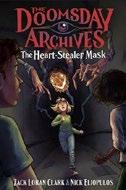
Three friends must stop a monster who’s stalking their town. Hazel is struggling to learn how to use the Magnus Crown, the artifact she chose in the first series entry. It’s especially frustrating because the crown is supposed to have alchemical powers, and Hazel and her single mother, a hardworking nurse, could really use some gold. Even though a mysterious philanthropist named Julius Worthmann has been donating large sums of money to her mom’s hospital, the impact seems to be mostly cosmetic. At the same time, Hazel and her friends Emrys and Serena realize that another monster is going after the residents of New Rotterdam—one that uses its victims’ own deepest wishes against them. Hazel suspects there’s a connection between Worthmann and the monster, but will she become the next target before she and her friends can take the creature out? Readers will read with bated breath as the trio explore the dark corners of the hospital one step ahead of the dark forces, and they’ll cheer Hazel on as she draws upon her scientific knowledge to work with her magical artifact. This installment furthers the overarching mystery of the sinister Yellow Court, who use their “collection of
A deeply satisfying illumination of the world that inspired Dickinson’s poems.
otherworldly relics” to harm the town, while also delivering an enjoyable monster-of-the-week plot. Readers will eagerly anticipate more adventures. The first volume established that Emrys and Hazel are white, and Serena is Black. Final art not seen. Satisfying thrills and chills. (Horror. 8-12)
Kirkus Star
Corry, Lydia | Godwin Books (112 pp.)
$22.99 | Oct. 15, 2024 | 9781250868213

A young Emily Dickinson excitedly explores the natural world. As familiar as the American literary giant may be, many are still stumped and stymied by her uniquely phrased poems. Even wellknown verses—“‘Hope’ is the thing with feathers” and “I’m Nobody! Who are you?”—may leave readers with questions. In this beautiful, soft-edged story full of sylvan sprawl, the poet— here an adolescent girl enamored with botany—sets out to study flora on its home turf. With her shaggy dog Carlo in tow, she ambles far from home and sets her sights on woodland wonders. She admires “how soft a caterpillar steps,” gazes in awe at an orchid, and converses quietly with a snail. Dickinson’s prolific verse is elegantly interposed with equally mesmerizing visual poetry. An image of Emily taking in the summer breeze is paired with the verse “a soft Sea washed around the House / a Sea of Summer Air”; in her imaginings, the waves of a golden ocean engulf a glistening field. As her outing ends, evening approaches and its “Vastness… Wisdom…Peace” are framed by mellow hues of purple-pink twilight. Corry’s delight in illustrating botanical imagery with soothing colors and rich textures shines through in every step Emily takes and every specimen she observes.
A deeply satisfying, accessible illumination of the green world that inspired Dickinson’s intriguing, intimate poems. (more information on Dickinson and Carlo, further reading) (Graphic biography. 7-12)
Cowell, Cressida | Little, Brown (336 pp.)
$17.99 | Oct. 22, 2024 | 9780316539081
Series: Which Way to Anywhere, 2

T he helter-skelter misadventures of the blended O’Hero-Smith family—on this and other planets—continue. While the resident trio of grown-up witches sneak out of the House at the Crossing of the Ways on a supposedly secret mission, resentful young folk Izzabird, K2, Theo, and Mabel set out themselves on a large, stolen (though Izzabird prefers to think of it as “borrowed”) interstellar hoverboard. They hope to prove themselves worthy of not being left out by traveling the Which Ways to an impossibly dangerous planet, leaving behind their sibling, Annipeck O’HeroSmith, who even at “two and a bit” can animate and control anything made of plastic. (Actually, all of the children plainly have magical Gifts, though some have not yet manifested at this point in the series.) Fortunately, Gifted or not (yet), singly or in groups, the racially diverse clan goes on to prove redoubtable enough to take on even the immensely powerful and treacherous archvillain Vorcxix the Vile. Unfortunately, their hijinks attract the attention of the ruthless Universal Government, which puts all of Earth in danger. As the sort of romp in which nearly everyone has private business, personal frictions, and conflicting agendas, this sequel to Which Way to Anywhere (2023) is actionpacked. Cowell illustrates nearly every page with exuberantly inky images of
grotesque aliens and monster robots, frantic kids, and explosive arrivals and departures. She also chucks in mind-bending notions for clever readers to wrestle with, such as ice that is simultaneously cold and hot. Clever, silly fun. (Fantasy. 8-12)
Cuevas, Adrianna | Harper/ HarperCollins (256 pp.) | $18.99 Sept. 24, 2024 | 9780063285545

T he days are bound to be interesting when your backyard is a body farm, as 12-yearold Francisca Mirabel Gonzalez well knows. Frani relishes the decomposition science her father studies at Central Texas University’s Forensic Anthropology Research Facility. Far from squeamish, she helps her dad prepare cadavers for their placement in the field so he can record data on how bodies decompose under different conditions. Frani, who struggles with ADHD, worries that Benji Tanaka, a new scientist’s son, will find her interest weird. But Benji, who’s also 12, surprises her by sharing her fascination. After several of the cadavers turn up missing, Benji and Frani come face-to-face with a reanimated corpse. Befriending the teenage zombie, they try to discover his identity before the other missing bodies wreak havoc on campus. Gruesome—and scientifically accurate—details about the dead bodies will enthrall readers with strong stomachs. Cuevas, who also has ADHD, presents the realistic reactions Frani receives to her condition: Her sister is hypercritical, but her dad is supportive, using strategies to help her stay focused. Frani progresses from self-criticism to self-acceptance, recognizing her neurodivergence as a strength as she helps the team round up the walking dead. With its mix of forensics, ADHD representation, and suspense, this novel offers a unique read
for those who enjoy spooky science fiction and heartfelt storytelling. Frani and her family read Latine, while Benji and his dad are cued Japanese American. A story with plenty of heart—and other body parts. (author’s note) (Paranormal. 9-13)
Cuoghi, Barbara | Illus. by Elenia Beretta Trans. by Genni Gunn | Greystone Kids (32 pp.)
$18.95 | Sept. 10, 2024 | 9781778401466

A beloved, witchlike figure from Italian Christmas folklore pens a letter to children. Befana has taken on a variety of roles, from searching for the Christ Child to giving gifts on the Epiphany. Here, she writes a missive to children, preparing them for her visit on the eve of January 6, a night that “hangs motionless between the final sigh of the holidays and the return to daily life.” She’s frank: “I am both benevolent and fearsome.” In a withering voice, she makes clear that she has “nothing to do with that clumsy oaf dressed in red with his herd of reindeer.” She implores readers to “examine [their] conscience,” and she adopts a schoolmarmish voice, directing them to hang their stockings properly; good children will receive sweets, while naughty ones will find coal in their stockings. Befana dishes secrets, too, like how she becomes invisible after sipping “a soup of mandrake, limpets, and giant salamanders.” Most importantly, though, she explains that with her annual visit, she brings the gift of spring and new beginnings—“gifts that are not measured in money, to which humans are attached like leeches.” Translated from Italian, Cuoghi’s poetically pleasurable narrative can be verbose, but Beretta’s shimmering gouache images surround those words with a charming, vintage cinematic feel. Four
delightful pages of backmatter delve into Befana lore and other winterwitch traditions. Befana is pink-skinned; background characters are diverse.
An intriguing, refreshingly original Yuletide tale. (Picture book. 5-8)
Dickinson, Emily | Illus. by Tim Hopgood Paw Prints Publishing/Baker & Taylor (32 pp.)
$18.99 | March 5, 2024 | 9781223188164
Series: Picture-a-Poem
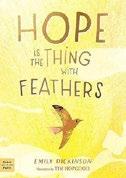
One of Dickinson’s most famous poems is brought to vivid life. A young, brown-skinned child at a window watches a brown bird, perhaps a house wren, singing colorful notes from a nearby tree. Later the bird dodges raindrops and umbrellas, emitting notes and inspiring pedestrians to look up. The bird’s song “never stops,” even as night falls over the city and a violent storm ensues. The notes become fainter, but only briefly, as the bird flies off to a warmer, brighter setting to “the chilliest land” and to a sunny harbor. Returning to the child, whose window is now open, the bird perches closer, still singing. Each page features one line of the poem, printed over full-bleed, borderless, mixed-media images. Human figures—mostly brownskinned—are simplified against brilliant abstract backgrounds. Relying on a wide range of hues, from the glowing yellow of the book’s cover to peach and fluorescent blue to autumnal oranges and burnt sienna, with touches of bright green—the color of hope—Hopgood visually conveys the poem’s theme, slowing the pace of Dickinson’s economical lines and allowing readers to take them in. Backmatter includes a brief paragraph on Dickinson’s life, a short glossary, and a suggested activity. Dickinson’s verse benefits from Hopgood’s full visual expression. (Picture book. 6-8)
Dunn, Georgia | Andrews McMeel Publishing (240 pp.) | $12.99 paper Sept. 17, 2024 | 9781524892067

Breaking news! A mysterious cat has been spotted; what’s her story?
Cats Lupin, Elvis, and Puck live with a whitepresenting family consisting of the Woman, the Man, the Toddler, and the Baby. Along with other neighborhood cats (and sometimes mice), this kitty trio broadcast the regular activities in their lives, such as the Baby’s birthday party, a potato salad heist (that also functions as a Hamilton spoof), and coverage of a storm and power outage. Sightings of an unknown orange cat keep popping up in the news cycle, until finally they meet Goldie, who’s been living outside while trying to solve the disappearance of her People. Fact: They went missing on a Tuesday, aka trash day, making Goldie suspect the raccoons were involved. With the help of new friends (and enemies), Goldie finally learns the truth. Although an overarching plot eventually emerges, it’s interspersed with many silly side vignettes befitting the work’s comic-strip origins, which are subtly denoted through changes in background page color. The episodic moments and the general storyline are accessible to those unfamiliar with the Breaking Cat News gang, but this book will appeal most to those who have some background knowledge of the many characters. Feline fanatics are in for a treat with the zany antics and big personalities of this kitty crew.
A humorous and lighthearted look at everyday life through the viewpoints of lovable, rambunctious cats. (paper dolls, applesauce recipe) (Graphic fiction. 9-13)
Edge, Clare | Harper/HarperCollins (384 pp.) $18.99 | Sept. 17, 2024 | 9781335006974
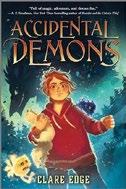
A teen reckons with navigating family magic and disability.
Bernadette Crowley’s family are an esteemed Missoula, Montana, clan of Irish American witches led by powerful and spirited Grandma Orla. But their specialty—using blood for summoning demons—has become more complicated since 13-year-old Ber’s diabetes diagnosis. Because she must prick her finger to check her glucose levels, she’s begun summoning by accident. Big sister Maeve cooks up a plan to find a demon that can serve as a glucose monitor—but the girls get more than they bargained for in the form of Finley MacIntire, a Mystery demon whose growing entwinement with Ber isn’t enough to stop a torrent of magical chaos in the wake of their arrival. Debut author Edge uses space that could have been spent building intriguing relationships among the characters or expanding on Ber’s characterization to focus on details of the complex lore of witch culture that slow the story’s momentum. Nevertheless, the ways in which Ber’s diabetes interact with her powers are resonant, and her combative, prickly dynamics with Fin are enjoyable. Ber’s world expands as she begins to come into her own in regard to being both fat and diabetic. She relishes new bonds with other magical kids, and through these interactions, Edge interrogates the prejudices inherent in a system of hereditary magic and explores how new generations can end them. The escalating adventure will leave readers curious about events to come in future series entries.
Empowering encouragement about claiming what makes you distinct. (Fantasy. 8-12)
Fishman, Seth | Illus. by Mark Fearing Penguin Workshop (32 pp.) | $18.99 Oct. 15, 2024 | 9780593662281

What would you do if you could travel back in time?
After inventing a time machine, pale-skinned, redheaded Brandon initially does the relatively expected and embarks on a time travel extravaganza: He watches animals evolve, checks out the Colossus of Rhodes, visits Alexander Hamilton, relives his favorite memories, and investigates some moments he’s always been curious about, like his own birth. Then he decides to go back to a more recent time in order to complete a failed homework assignment; after all, he now knows the right answers. But soon past Brandon gets too reliant on future Brandon and begins slacking off, secure in the knowledge that future Brandon will put things right. Frustration ensues! What’s a cheeky, work-avoidant boy to do? Sketchy, comical illustrations depict Brandon, a number of his past and future selves, and some surprise guests as they first wreak havoc, then set out to fix his admitted mistake and remedy the situation. Though there may be a few loose ends, “Brandon will deal with them…one day at a time.” Lighthearted and joke-filled, with a gently inserted moral about the perils of laziness, this flippantly funny selection will appeal to reluctant readers, mistake makers, and homework shirkers alike.
A lively lesson on the value of hard work and perseverance embedded in a wacky time travel adventure. (Picture book. 4-7)

Fournier, Jamesie | Illus. by Tim Mack
Inhabit Media (28 pp.) | $12.95 Oct. 8, 2024 | 9781772275438
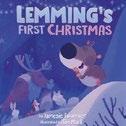
A lemming and her arctic pals search for a tree to decorate for Santa’s visit. When Avinngaq hears children singing “Santa Claus Is Coming to Town,” she’s confused. Her sled dog friend Qimmiq explains that on Christmas, people decorate trees. “Then Santa Claus comes!” So Avinngaq asks all the arctic animals to help her find a tree. Unfortunately, they turn up only vegetation such as seaweed, flowers, and arctic willow. Avinngaq is almost out of hope until she plops down on the perfect piece of driftwood. Using the flora that the animals collected, they decorate the perfect tree—and the next day, they discover that Santa has delivered plenty of gifts. All the animals go by their Inuktitut names, and a helpful pronunciation guide follows the story. The simple text is easy to follow and puts a toddlerfriendly arctic twist on the familiar holiday. Using blues, purples, and pinks, Mack captures the polar setting; the vividly hued sky is especially eyecatching. Avinngaq and her friends are sweetly drawn, with beady black eyes and expressive faces; all will appeal to little readers. The pacing of the tale, the inviting illustrations, and the opportunity for exposure to the Inuktitut language make this a shelf-worthy holiday title. A distinct and skillful take on familiar Yuletide themes. (Board book. 2-4)
Fox, Kate Allen | Illus. by Elisa Paganelli
Beaming Books (32 pp.) | $18.99
Oct. 15, 2024 | 9781506492858
For more by Seth Fishman, visit Kirkus online.

author’s home in San Diego, this tale sees a community gather together to savor the light. As the day slips by, everyone makes the most of the sun’s rays, attempting to “stretch the daylight / as much as we can, trying to make it last.” But as the sun slides down and the beach turns purple with darkening hues, neighbors gather firewood to create a bonfire (in a safe, designated fire pit). They stretch out arms and link hands, “squeezing in silent reassurance. / A reminder: / I am still here. / A promise: / I always will be.” Paganelli’s burnt orange flames lick the night sky, shimmering with specks of stardust and surrounding the group with warmth and love. The racially diverse, bundled-up crowd sings songs and casts wishes into the firelight’s glow. Fox concludes this lyrical exhortation to appreciate every moment by briefly explaining the solstice and touching on global winter solstice celebrations, all of which she explores more in her author’s note.
A bright spot of hope on a day where darkness is dominant.
(Picture book. 4-8)
Fraser, Lu | Illus. by Kate Hindley Peachtree (32 pp.) | $18.99 | Oct. 15, 2024 9781682637548 | Series: The Littlest Yak
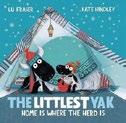
A lyrical look at the shortest day of the year. Inspired by the beachfront celebrations that occur near the
A yak learns an important life lesson.
Gertie’s mother tells her that their yak herd must move because the weather on the mountain where they reside has gotten too warm. This news unsettles Gertie because all her favorite belongings are right here. Mummy sagely tells her, “A home is much more than the things that you pack.” But a skeptical Gertie is determined to cram every item she owns onto her sled, including books, pine cones, skis, jump rope, photos, and her second-best hat. Mummy tells Gertie that no matter what, they must remember to take Dot, Gertie’s baby sister. At last, Mummy
gives the order for the herd to leave. Gertie stops to pick up more pine cones. Unbeknownst to her, one of these stopovers results in Dot plopping off the sled and rolling away! When Gertie realizes what’s happened, she’s distraught. Fortunately, Granny Yak soon comes along and assures Gertie that all’s well: She found Dot, who’s now safe. Gertie, understandably relieved, is finally convinced that mere things don’t make home a home—family does. This U.K. import, told in lyrical, bouncy verse, is a lovely story with a simple yet uplifting, empowering message that will resonate with readers. The lively illustrations, rendered in pencil and ink and colored digitally, are crisp and clear, like cold mountain air. Gertie and tiny moon-eyed Dot are adorable. Note the striking patterns on the yaks’ hats, blankets, and elsewhere.
Children will enjoy trekking along and sharing adventures with this herd. (Picture book. 5-8)
Frost, Maddie | HarperAlley (32 pp.)
$5.99 paper | Oct. 29, 2024 | 9780063306479
Series: I Can Read! Comics

A young penguin finds a creative way to postpone bedtime.
Mom knocks on Chip’s door. It’s time for bed! But Chip’s too busy. Glued to a makeshift computer screen, with a stuffed toy “assistant” looking on, Chip has emails to send. So the negotiations begin. Chip proposes switching roles with Mom. She’ll be the kid and go to bed, and Chip will be the grown-up and watch TV. Mom agrees and plays the game with great skill and definite cunning: She requires Chip to tuck her in, read her a bedtime story, bring her favorite stuffed animal, and more. She also gives “grown-up” Chip a list of chores that she usually does in the evenings. Chip completes them all and finally gets to watch TV. An exhausted Chip has had enough; it’s
time to be a kid again! This tale starts off with a quick guide to reading comics, defining terms and explaining how to read the panels in the right order. The cartoon artwork adds details and dimension, greatly enhancing the spare text. Perched on skinny stick legs, Chip and Mom are an adorably anthropomorphic pair whose home is an igloo in a frozen landscape. Frost makes great use of their body language and facial expressions to convey emotion. Young readers will be drawn into this familiar family dynamic, recognizing their own bedtime struggles and forays into independence.
A charming, funny tale of bedtime antics. (Graphic early reader. 4-9)
Gehl, Laura | Illus. by Sonia Sánchez
Paula Wiseman/Simon & Schuster (32 pp.) $18.99 | Oct. 29, 2024 | 9781665915595

A shadowy blue color scheme accented with red pairs with gentle rhyming verse in a cozy ode to snow. This book treats snow as an unalloyed joy; no shoveling, wet pant legs, or numb fingers appear here. Instead, readers follow an Asian-presenting child and father throughout a day of cavorting in the snow, accompanied by an energetic dog. The verse scans well, encompassing both abstract evocations of snowy weather (“Snow is a plop / and a flop / and a squish. / Snow is a flutter, / a swoosh, / and a swish”) and more concrete experiences (“Snow is a hoard that is set for attack. / Snow is Dad’s face… / when a snowball / goes WHACK!”). The digital illustrations have a homey, pastel-like quality that—despite the chilly subject matter—imbues the playful tableaux with warmth. With a limited palette of whites, blues, and grays, Sánchez captures the quietly luminous quality of shadows on snow, broken by pops of red from the family’s clothing. From snowball fights to fort-building to
sledding, the father and child enjoy their romp until the arrival of a second, Black-presenting adult and a bundled, brown-skinned baby, who usher the group back inside as the sun begins to set. More coziness ensues at home before child, baby, and dog pile into bed together.
A sweet wintry celebration. (Picture book. 4-8)
Giordano, Philip | Trans. by Arielle Aaronson | Greystone Kids (48 pp.)
$18.95 | Oct. 22, 2024 | 9781778400865

Friendship can be found in the most unexpected places. Iris, a dark blue swallow with a bright yellow chest, is the first to arrive at the forest every spring after her flock’s winter migration. As the wind signals cooler weather, the birds start preparing for their annual flight. Curious Iris asks, “What happens to the forest when we leave?” No one knows, so she decides to stay during the frigid season. With the emergence of a sudden snowstorm, Iris is ill prepared for this change and falls asleep in a snowdrift. Thankfully, a helpful squirrel named Sam rescues her from a cruel fate and takes her to his humble arboreal abode, where they keep warm and bond. Another year passes, and Iris decides to join her flock in their yearly winter exodus. Sam is sad yet knows that Iris must go. When Iris returns the following spring, she eagerly reunites with her forever friend; he hitches a ride on her back as they soar over their beloved forest. This is a lovely story of having the courage to stray from the crowd, chart one’s own path, and cherish the friendships made along the way. The text, translated from French, scans nicely and complements the blocky geometric patterns of the vibrant illustrations, showcasing the cool harshness of winter and the colorful emergence of spring. Welcome proof that seasons may come and go, but friendship is forever. (Picture book. 4-7)
Gravel, François | Trans. by David Warriner Orca (96 pp.) | $12.95 paper | Oct. 15, 2024
9781459839809 | Series: Orca Shivers, 1

A weekend job at the library turns into a terrifying ordeal. Matt is sent to the school library as punishment for falling asleep in class. He’s filled with uneasiness upon meeting Mr. Leclerc, the librarian, an odd man whom Matt’s never seen before. His concern subsides when Mr. Leclerc offers him a paid weekend job weeding old books. But Matt begins to regret his decision the next Saturday as they descend in a key-operated elevator into a dark, dusty basement filled with old school furnishings, taxidermied animals, and formaldehyde-preserved fauna. Matt works alone all morning, paging through creepy medical texts with descriptions of rare diseases and embalming. Lunchtime passes with no sign of Mr. Leclerc. Matt’s anxiety turns to full-blown panic when he discovers his dying cellphone has no service. Will Matt find a way to escape? And what does Mr. Leclerc have planned? Translated from French, this brief, fast-paced novel, reminiscent of Roald Dahl’s short story “The Landlady,” will hook readers from the very first page as they’re eventually plunged into a living nightmare. Matt’s anxiety and fear are palpable; readers will readily identify with his plight. Black-andwhite illustrations peppered throughout heighten the eerie mood. Physical descriptions are minimal. Satisfyingly chilling. (Horror. 9-13)
Groenink, Chuck | Tundra Books (56 pp.)
$18.99 | Oct. 15, 2024 | 9781774881064

A simple gesture vividly and profoundly transforms a Neanderthal boy’s life.
The child travels in search of shelter with his family. They find a cave, set up a hearth for cooking, and then rest. Meanwhile, the boy wistfully peers out from the cave at the vast valley outside. Before long, he’s off exploring—running, jumping, and rolling down hills with a joyous expression that will be familiar to contemporary children. An unseen narrator describes his journey with an infectious staccato cadence, drawing comparisons: “Trees big, / boy small. / Boy big, / crawler small.” These likenesses propel the narrative, as in this description of birds, woolly mammoths, and the boy: “Feathers in sky. / Feathers in hair. // Big hairies there. / Little hairy here.” Later, the child gazes across a river (“Boy here”) and sees another boy (“Boy there”)—a different kind of boy, a Homo sapiens. The Homo sapiens boy waves to the Neanderthal, and this seemingly small act seals their fateful encounter. A full-page spread sets the boys’ brown faces side by side, illustrating how much they share even though they are of different species. This affirming tale of connection is a superb marriage of text and visuals; Groenik’s muted colors, soft rounded panels, images of caves backlit by fire, wordless spreads, and endearing facial expressions throughout culminate in a resplendent final scene that sees the Neanderthal boy returning
A lyrical and beautifully imagined prehistoric encounter.
home and memorializing his experience by making art that will reverberate through archeological history. A lyrical and beautifully imagined prehistoric encounter. (author’s note, sources) (Picture book. 3-7)
Haddix, Margaret Peterson | Harper/ HarperCollins (336 pp.) | $19.99 Sept. 10, 2024 | 9780063089860
Series: Mysteries of Trash and Treasure, 3

A mysterious package left on the doorstep holds literal and figurative keys to a preteen sleuth’s shadowy past in this series closer. Detective skills gained in their two previous cases prove useful to Colin and his partner and best friend, Nevaeh. Haddix pitches the pair into an investigation that, despite Colin’s mother’s resolute stonewalling, uncovers some shocking facts about his recently deceased and previously long-absent father. Fueled by a credible mix of anger at being apparently abandoned and a yearning just to know what happened and what his dad was like, Colin’s inner odyssey makes up the emotional core of the story. But Haddix weaves in a substantial and increasingly suspenseful caper featuring clues found in documents and stored possessions, cold evidence trails to follow, startling revelations of both past misdeeds and unexpected family connections, and (to raise the stakes even more) a stash of money massive enough to put lives in danger. Some clues seem contrived, and the author repetitively makes use of characters asking themselves or others strings of questions. Still, events work out in ways that are both nonviolent and healing, as do certain issues that have formed a continuing theme through the trilogy involving the families of both young leads. Colin and Nevaeh read white, separate
members of the supporting cast are Black and Latine, and one of Nevaeh’s brothers is cued as neurodivergent. Tidy and upbeat. (Mystery. 8-12)
Hallett, Braden | Annick Press (288 pp.)
$19.99 | Sept. 3, 2024 | 9781773219134
Series: Secrets of Ravensbarrow, 2

It turns out that the series opener’s braineating hamsters aren’t the only terrifying surprises the Canadian town of Ravensbarrow has in store for a newly arrived lad with anxiety issues.
Strict warnings not to leave the marked paths around town quickly prove futile as, thanks to recklessly impulsive 5-year-old cousin Milton, Teddy finds himself stumbling into a spooky train yard guarded by an irascible dog the size of a house. He’s soon plunging to the rescue through an eldritch forest when Milton is abducted by a monstrous, shape-shifting worm that’s prone to covering its victims in goo that smells like stinky cheese before dissecting them. Along with the customary gaggle of quirky but steadfast new sidekicks—and those talking hamsters, who make a comeback—Hallett kits his quivering protagonist out with a conscience that’s present as a character in both the dialogue and the manic art. Teddy’s urgent desire to flee town wrestles with unfamiliar feelings of at last belonging to a tight circle of friends. Many readers will be drawn to the monsters, frantic chase scenes, and slime- and muck-spattered cast, but Teddy’s inner conflict and some related family issues add a substantial thematic
base. Plus, following the rush of narrow squeaks, he at last shows salutary signs of getting a handle on his tendency to freak out. The cast surrounding the white-presenting lead includes some racial diversity; Milton is adjusting to wearing hearing aids. Final art not seen. Frenetic fromage-y fun, with monsters. (Comic horror. 8-11)
Hansson, Julia | Trans. by B.J. Woodstein Orca (32 pp.) | $21.95 | Oct. 15, 2024 9781459841147 | Series: Billie and Bean, 3
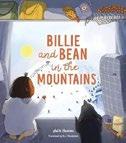
Billie experiences a moment of magic in the snow.
Billie, Mom, and Bean, their round gray dog, ride the bus to the ski slopes. Last year, Mom pulled Billie in a sled, but this year, Billie’s enrolled in ski school. Mom, ensconced in a chair on the ski lodge’s porch with a warm mug and a blanket over her knees, “has been busy at work” and “needs to rest.” Joined by Bean, she watches Billie but soon falls asleep. A cautious skier, Billie slowly snowplows all the way on her first run down. Back at the bottom of the slope, Billie doesn’t want to ride the ski lift again. A poster about dog sledding gives Bean a clever idea, and she hitches Bean to a small toboggan. At first the ride is lovely, but Bean shakes free, and Billie finds herself in a snowdrift under the dark, snow-laden branches of the trees. The way out isn’t apparent until a white-coated ermine leads the way. “How did you find your way back to the slope?” Billie’s friend asks her on the bus home. “It’s a secret,” replies Billie. The simple story, translated from Swedish, captures the uncertainties and triumphs of childhood, all of which may seem small
Billie experiences a moment of magic in the snow.
BILLIE AND BEAN IN THE MOUNTAINS
to adults but are larger-than-life to youngsters. The crisp yet gentle illustrations make terrific use of color and perspective. Billie and Mom are brownskinned; theirs is a diverse community. Another just-right adventure with this appealing duo, sure to reassure and embolden the very young. (Picture book. 3-7)
Hards, Ashley | Fabled Films (268 pp.)
$16.99 | Sept. 10, 2024 | 9781944020910
Series: Hannah Edwards, 1

In the small prairie town of Riverway, sixth grader Hannah is troubled: Her beloved farmer dad, dubbed the Canola King, has been missing for four months. Pushy uncle Fergus keeps coming over, giving unsolicited advice and cooking subpar meals. When Hannah’s best friend, Sam, claims to have seen a ghost that looked like her missing father, Hannah at first dismisses it—“My dad cannot be a ghost because he is alive.” She decides to investigate, recording her progress with the case in the grief journal her concerned mom gave her to help her cope. But Hannah discovers it’s hard to find clues when the trail has gone cold, especially with an invasive, cloyingly sweet school counselor getting into her business. Debut author Hards’ story is told through Hannah’s first-person narration, which tells more than it shows. The writing often fails to convey the depth of emotion a missing parent would be expected to evoke. One chapter is written in rhyming couplets that scan awkwardly and are organized into paragraphs of text: “Click! That’s the sound Tim’s key made as it slid into Ms. Grant’s door. Tim (previously known as Tim the Timid) was the Hall Monitor of lore!” Although she’s not given an explicit label, Hannah struggles with paying attention in class and is cued as neurodivergent; by the end of the book,
she’s being evaluated and given support and validation. Hannah and her family present white; Sam is of Filipino descent. Passable. (Mystery. 8-12)
Harrison, Lisi & Daniel Kraus
Union Square Kids (248 pp.) | $16.99
Sept. 17, 2024 | 9781454944584
Series: Graveyard Girls, 3
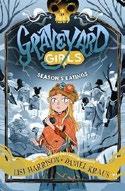
The Graveyard Girls contend with scam artists, a haunted doll, and a disappearing grave in this third series entry. Notorious local murderer Silas Hoke’s grave has vanished. It’s not just that his bones are gone—the ground itself appears completely undisturbed. As the friends attempt to solve this mystery, complete with spectral clues that they struggle to decipher, they each have other issues to contend with. Whisper is upset about her father’s recent engagement, Frannie is bored without an acting project, Zuzu is trying to communicate with the ghost of Ginny Baker (whom Hoke killed in the 1920s), and the doll Sophie’s sister gave her has come to life and is trying to hurt her. Gemma continues her efforts to save her family’s business, the Spirit Sanctuary, by convincing the Borderlyne triplets, YouTube ghost hunters with millions of followers, to film an episode of their show at the store, but the internet celebrities’ interest turns out to be more earthly in nature. It’s also Gemma’s turn to tell a creepy story at their club meeting, and she delivers a stomach-turning O. Henry–style tale. Fans of the series will be delighted to continue the girls’ adventures and will enjoy the gentle scares that are tempered by realistic family and friendship issues. Most characters read white. Zuzu’s surname cues her as Japanese American, and a previous entry depicted Sophie as Black. Unearthly thrills and chills balanced by tweens’ down-to-earth concerns. (Horror. 8-13)
Hernández Sevillano, David | Illus. by Luisa Vera | Trans. by Kathleen Meredith NubeOcho (36 pp.) | $17.99 | Oct. 1, 2024 9788410074361 | Series: Somos8

A girl has a most unusual pet. Greta’s allergic to animals, but she still wants a pet. Then she finds the perfect one—a cloud.
It’s enormous, white, and fluffy, and it continually changes shape. Greta puts a red collar on it and walks it around her neighborhood. Some people are delighted and ask Greta to visit their homes with it. The cloud waters flowers, washes off a balcony, provides shade for a garden, and even gives a giraffe a shower. Since folks are unsure when Greta and her cloud might stop by, they begin carrying umbrellas—just in case. Not everyone likes Greta’s pet, though. Some neighbors grumble when the cloud rains on their drying laundry, ruins their barbecues, and sinks their paper boats. Neighbors soon split into pro- and con-cloud camps. Greta tries to teach her pet not to rain indiscriminately, but it is a cloud, after all—one shrinking with each expended raindrop. Eventually, the cloud’s collar falls off, and it floats higher into the sky, leaving Greta “one last gift” as it departs. Hint: The gift is arc-shaped and lights up the sky with seven beautiful colors. Originally published in Spanish, this story has a quirky, comical, and appealing premise. The colorful, goofy illustrations heighten the whimsy. Pale-skinned Greta is very expressive; background characters are diverse. Quirky fun. (Picture book. 4-7)

Ed. by Herz, Henry | Whitman (288 pp.) $18.99 | Sept. 5, 2024 | 9780807531211

An opening triolet poem by Lesléa Newman retells the Hanukkah story in eight lines, setting the stage for the stories to come.
For more by illustrator Luisa Vera, visit Kirkus online.
Sixteen acclaimed authors offer their varied perspectives on this joyous holiday of light and miracles. The common thread weaving through the entries is the celebration of Jewish religious and cultural traditions. Recurring themes include passing down recipes, uncovering family secrets, testing and forming friendships, dealing with loss, encountering paranormal spirits, and navigating complex family histories that shape the present. Many stories delve into the nuances of Jewish identity, in times of both crisis and joy, addressing issues such as bullying, grief, good deeds, and quintessential Hanukkah traditions, like eating potato pancakes, lighting candles, and playing dreidel. The collection is touching, funny, awkward, food-centric, and sometimes painful, collectively illustrating that Judaism is not a monolith. Ashkenazi and Sephardic families are highlighted, with featured backgrounds spanning Polish, Irish, Moroccan, Russian, and Ukrainian origins. The main characters are mostly white Jewish middle schoolers. While there are clearly more stories to be told, this anthology serves as an accessible introduction to a range of Jewish experiences. Variability in plot and character development make some of the entries flatter and more one-dimensional, limiting the anthology’s potential to attract wide audiences, however. Still, the chance to read about celebration and coming together is invaluable.
An overall positive reading experience despite some inconsistencies in quality. (glossary) (Anthology. 9-13)
Hirst, Daisy | Candlewick (40 pp.)
$17.99 | Oct. 22, 2024 | 9781536238891
Series: Natalie and Alphonse

Preschool monster twins devise a play in this latest series entry. As they prepare for an overnight visit with Granny, siblings Natalie (who’s red) and Alphonse (who’s blue) each pack the necessities. After a rainy walk to Granny’s with their parents, the youngsters greet the treasure box, funny clock, and “bump bump bump bump stairs” they so love. Mom and Dad say goodbye so they can have a night at the theater. The siblings initially feel left out until Natalie gets the bright idea to collaborate with Alphonse on their own DIY show. Alphonse is skeptical at first, but the promise of yogurt with sprinkles at intermission seals the deal. Relying on various household objects, the duo assume the roles of Little Lost Bear and All the Frogs and practice and practice. But rehearsal doesn’t go according to plan, and sibling spats ensue. With Granny’s encouragement, they decide to wait until tomorrow so Mom and Dad can see the show, too. Surprise, surprise: Rest and a larger audience make the performance a smashing success! Hirst’s trademark bold, screen-printed illustrations accentuate this childfriendly tale. Comic panels cleverly abridge the rehearsal process into spot-on dialogue, allowing the siblings’ personalities—and disagreements—to hilariously shine through. As an added touch, endpapers depict hand-drawn posters that suggest the siblings have produced many plays since. A creative ode to imaginative play with familiar characters. (Picture book. 3-6)

A creative ode to imaginative play with familiar characters.
ALPHONSE, YOU’RE RUINING THE SHOW!
Hood, Susan | Simon & Schuster (272 pp.)
$17.99 | Oct. 8, 2024 | 9781665943246

Nazi bombs are falling on London.
Hunter, Erin | Harper/HarperCollins (400 pp.)
$20.99 | Sept. 3, 2024 | 9780063357365
Series: Warriors Super Edition
For more by Daisy Hirst, visit Kirkus online.
Trapped in the shelter, 15-year-old Bess feels under attack from bombers on the outside and bullies on the inside. She convinces her parents to apply for a program that will evacuate children to Canada, and she and little brother Louis are accepted. They set off on the SS City of Benares accompanied by a convoy of armed ships. Their escorts and the crew are kind, but the life jackets and lifeboat drills are reminders that danger is always lurking. Bess befriends fellow passenger Beth, and when a German torpedo strikes and the ship sinks, they help one another to safety but feel overwhelmed by stormy weather, loss, and despair. Is there any hope of finding Louis? Bess narrates her tale in free verse that uses short, staccato lines to describe the unfolding events in sharp detail. Hood intersperses verses narrated by the sea, and others that follow Louis’ experiences. Bess’ stream-of-consciousness style expresses all her doubts, fears, and hopes, bringing readers along on her torturous adventure. The girls are ultimately rescued by the HMS Hurricane and find Louis, but only a few of the other children survive. This verse novel is inspired by unforgettable real events that will leave a lasting impression on readers.
A hopeful story about devastating events written in clear, accessible verse. (author’s note, Lifeboat 5 facts, poetry notes, sources, appendix, photographs) (Verse historical fiction. 10-14)

Profound grief and ominous visions of a river of blood spur ThunderClan cat Ivypool and four companions to undertake a dangerous quest. In an episode punctuated by disturbing dreams and visions, Ivypool, who’s caught between hope and despair after the recent loss of Bristlefrost, her kit, leads a multiClan expedition into unknown lands. They face battles with weasels and foxes, encounters with wildcats both friendly and hostile, and probes into the diverse realms of the afterlife. Lighter moments, such as one cat giving another dating advice or a glimpse of a Twoleg eating something inscrutable (“two white things, Ivypool realized, with something colored brown and yellow between them. He put the whole thing into his mouth and took a bite”), occasionally relieve the overall heaviness of the story’s tone. By the quest’s end, not only has Ivypool at last moved past denial to acceptance, but the expedition has made a remarkable discovery. What the collective author doesn’t do here is offer even a hint of what that river of blood actually portends for the Clans beyond some vague, fearful threat—curious readers will have to stay tuned. A setup volume, ending abruptly in midcourse with dangers aplenty faced and more, plainly, to come. (Clan membership list, map) (Animal fantasy. 9-12)
Jacob, Catherine | Illus. by Hoang Giang Candlewick (40 pp.) | $17.99 Oct. 8, 2024 | 9781536238815

A child becomes Doctor Fairytale, providing care to well-known figures from classic stories. As it turns out, beloved fairy-tale characters sustain plenty of injuries. Cinderella’s feet are covered in blisters; the big bad wolf suffers burns after tumbling into the fire at the three pigs’ house; Snow White falls fast asleep after biting into the poisoned apple. Doctor Fairytale comes to the rescue, tending to their ailments with tenderness and consideration. After a long and busy day, the physician gets caught in the rain and falls ill—but gets a surprise visit from all the other characters who have received medical care along the way. This charming story riffs on favorite childhood stories while slightly altering many of their endings in clever, inspired ways. Cinderella takes some time off to rest her feet; Snow White is revived while also dodging the prince’s attempt at a kiss. The rhyming text keeps the pace moving and adds to the timeless feeling of the source material. The warm, soft illustrations alternate between small, framed vignettes and full, two-page layouts. Doctor Fairytale and Snow White are pale-skinned; Cinderella is Black. Other human characters vary in skin tone. A whimsical spin on all things fairy tale. (Picture book. 4-8)
Caregivers will relate to Santa as he endures a seemingly endless barrage of questions. He is asked everything from “Did you read my letter?” to “Is your belly button innie or out?” St. Nick never replies—he can’t get a word in edgewise—but the child is cheerfully undeterred. Still asking question after question, the youngster joins Santa as he delivers more gifts and then heads to the North Pole. The text rhymes, though the rhyme scheme is inconsistent, making for a well-paced if slightly bumpy reading experience. The illustrations have a soft, smudged effect that evokes the feeling of a hazy memory or a fantasy—an apt pairing for the text, since at the book’s end, the child isn’t sure whether the experience was real or just a dream. The combination of warm yellows and deep blues conveys both winter’s cold and the holiday’s warmth. Jarvis incorporates fun details, such as a miniature Santa in a snow globe, curious pets looking on, and an elf directing the reindeer landing when Santa returns home. Clad in traditional garb and a pair of small spectacles, Santa is light-skinned, while the child is brown-skinned. The young protagonist’s dogged curiosity makes for a wholly original Yuletide tale, infused with the magic and wonder of Christmas. Holiday enchantment. (Picture book. 3-7)
Jones, Dan SaSuWeh | Scholastic Focus (304 pp.) | $19.99 | Sept. 3, 2024 9781338889475 | Series: Scholastic Focus
when she was just 4, government officials stole her from her family and drove her a great distance away by wagon for boarding school. Ponca Tribe members had already been forcibly relocated from their Nebraska homelands by the U.S. government to Oklahoma. Jones explains how the boarding schools erased Native culture from students’ lives to assimilate them into dominant white society. He details the cultural genocide and displacement of Native peoples, describing the poverty and other lingering effects through subsequent generations. Throughout the text, which combines general historical background with his family’s story, readers learn about the abuse of and systematic attacks on American Indian people over the century that the boarding schools were in existence. The density of the information included requires some patience from readers, but Jones also offers hope, describing the revitalization of Native culture and people’s ability to live in two worlds despite the U.S. government’s history of legal restraints on sovereign Native nations. Text boxes provide extensive context, but their placement can distract from the flow of the narrative. Jones’ truth-telling and the family experiences he weaves throughout will surely ignite a fire deep within the souls of Native youth today. Presents harsh realities and thought-provoking content critical to understanding U.S. history. (bibliography, photo credits) (Nonfiction. 9-14)
Santa
Jarvis | Candlewick (32 pp.) | $17.99
Oct. 1, 2024 | 9781536238839
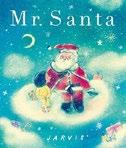
A child wakes to find Santa delivering presents, then spends the night peppering him with questions.

Relays the heart-wrenching experiences of the American Indian boarding school era. This comprehensive and complex text by Jones (Ponca) follows four generations of his family’s education at Chilocco Indian Agricultural School, starting with the experience of his grandmother. In 1885,
Khan, Rukhsana | Illus. by Chaaya Prabhat | Tundra Books (32 pp.)
$17.99 | Sept. 17, 2024 | 9781774882641

A young child goes on a noisy trip around town. Ibraheem and Mitu the cat join Baba as he makes a delivery in his autorickshaw. Baba attempts to maneuver the vehicle into traffic while oncoming cars speed past with impatient beeps. He sticks out his
leg and beeps his own horn. A car behind them responds with a honk: “Okay, fine! Go ahead.” The drivers have a language all their own, communicating through beeps and toots. Baba reminds Ibraheem that “big and small, short and tall, everyone shares the road”—words that serve as a refrain throughout. As the vehicles drive along a river, the truck driver spots a toad on the road and comes to a screeching halt. The others stop, too, and Mitu chases the grateful toad off the road. The fast-paced story comes alive with jam-packed illustrations that depict the hustle and bustle of a busy city. Brightly embellished art on buses and trucks, clothes drying on a balcony, street vendors hawking their wares, curvy electricity wires, and people playing cricket on the street all add to the lively backdrop. Though the location isn’t specified in the story, hints in the art imply a South Asian setting, and in her author’s note, Khan mentions drawing inspiration from many countries, including Pakistan, where she was born. A playful and fun slice of life story that underlines a lesson in road safety. (Author note) (Picture book. 3-8)
Rebecca: The Forgotten Life of Dr. Rebecca Lee Crumpler, America’s
King, Shani Mahiri | Illus. by Nicole Tadgell | Tilbury House (64 pp.)
$19.99 | Oct. 15, 2024 | 9781958394083
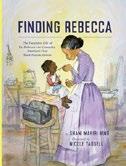
The story of the first Black American female physician is lifted from obscurity. Rebecca Lee Crumpler was born in 1831 to free parents in Delaware. Little is known about her childhood except that, early on, she went to live with an aunt in Philadelphia who raised her. When Rebecca was 17, she enrolled in the West Newton English and Classical School in Massachusetts. In Boston, she worked as a nurse, both with doctors and in her own practice. Rebecca received letters of
commendation from doctors and was the first Black student admitted to the New England Female Medical College, completing her medical degree in 1864. In 1865, Rebecca married Arthur Crumpler, and together they relocated to Richmond, Virginia, where she worked for the Freedmen’s Bureau. In 1869, the couple returned to Boston, where she maintained a nursing practice. Upon retirement, she continued to teach, and wrote a book, Medical Discourses, published in 1883. The book’s introduction provides much of our knowledge about her life and work. With this intriguing look at a woman who made great strides, King demonstrates the difficulty of finding information about lesser-known historical figures. He seamlessly incorporates quotes from Rebecca’s book and uses what is known about the times and places she inhabited to craft his detailed narrative. Rebecca’s support and care for her community come through clearly in Tadgell’s warm watercolor illustrations.
A study in perseverance—both that of the book’s subject and the author who unearthed her story. (more information on researching Rebecca Lee Crumpler, activity, select sources) (Nonfiction. 7-10)
Kuhlmann, Torben | Trans. by David Henry Wilson | NorthSouth (64 pp.) | $22.95 Sept. 17, 2024 | 9780735845541

In this Swiss import, translated from German, rudimentary color science and a few good friends help the new girl in town end a plague of grayness.
Robin—light-skinned and apparently preadolescent—stares at her new town and realizes that it’s devoid of color. In protest, Robin decides to wear her yellow raincoat everywhere. On her first day of school, that decision lands her in detention, where she meets brownskinned Alani. They quickly become friends and resolve to resist the status quo. Robin encounters adult resisters
who play music—outlawed along with color—and is menaced by a man all in gray. A fearful librarian loans Robin a book about color, inspiring a plan to transform the Gray City for the better. Robin, Alani, and the alienated musicians decide to sabotage a factory responsible for rendering everything gray. Oddly, as color returns, the children receive only a minimal reprimand from the factory managers, and not one citizen counter-protests. Relying more on telling than showing, the extremely short chapters are full of adverbs and awkward turns of phrase— perhaps because of translation issues. Nevertheless, suspense builds with each new scene—and, importantly, readers are treated to outstanding, detailed watercolor illustrations. Despite the somewhat clumsy prose, this story might work as a read-aloud in elementary or middle school classes that are being introduced to color theory; it could also spur conversation about conformity and societal norms. A discussion starter for readers who can look past the clunky writing. (additional facts about colors) (Fiction. 8-11)
Kurpiel, Sarah | Rocky Pond Books/ Penguin (40 pp.) | $18.99 Oct. 15, 2024 | 9780593697658

A child who uses a motorized wheelchair loses a beloved figurine. The nameless narrator can’t stand uncomfortable hats, thick coats, stiff boots, and cold wind. The youngster especially dislikes new places. But today the child must endure all these things: Mom and the protagonist are going to watch ice sculptors building in the park. The unimpressed narrator doesn’t see the point of making sculptures that will ultimately melt. Worse, the child loses a comforting horse figurine. Reluctant to revisit the park the next night without it, the child is now more confident: “I know the way, so it’s okay.” And visiting the
completed sculptures, from whale to goldfish, feels magical; the cold and the crowds “melt away.” Then, in a moment of serendipity, the narrator spies the horse figurine beneath an ice foal’s feet, cementing the child’s newfound appreciation. As seasons pass and another winter nears, the narrator dreams of icy creatures and smiles as a cold wind blows outside. The narrator realizes that though the sculptures melted, they “never went away. Not entirely.” In rhythmic text, Kurpiel gently demonstrates that ephemeral moments should be treasured and that venturing outside one’s comfort zones can be richly rewarding. Fluid illustrations clearly convey the narrator’s emotions; eye-catching blue and white hues immerse readers in the wintry atmosphere. The narrator and Mom have skin the white of the page; background characters are racially diverse. Whimsical and thoughtful. (Picture book. 4-8)
Kirkus Star
Radar and the Raft: A True Story About a Scientific Marvel, the Lives It
Lantos, Jeff | Illus. by Alan Marks Charlesbridge (192 pp.) | $18.99 Sept. 24, 2024 | 9781623543457

Interwoven storylines link a triumphant technological advance with a harrowing tale of survival at sea. In a real pleaser for readers with an expansive range of interests, Lantos twines a meaty account of the invention of radar with the story of how that device came into play in rescuing a raft crowded with the survivors of an American cargo ship torpedoed weeks before by a U-boat in shark-infested waters. He traces the history of radar from 18th-century Italian anatomy professor Luigi Galvani’s experiments with
A rare and exhilarating mix of hard science and seagoing terror.
RADAR AND THE RAFT
twitching frog legs to the powerful detection device that gave the Allies a significant, perhaps even decisive, advantage in World War II. Lantos also tells some absorbing side stories along the way. He not only describes the development of electromagnetic theory in specific but largely non-mathematical terms, but also—drawing from eyewitness accounts of raft survivors who were Christian missionaries returning from Ivory Coast—vividly captures the perils faced by those deemed enemy foreigners, trapped in countries suddenly under Nazi control. Likewise notable are his follow-up passages on radar’s myriad offspring from microwave ovens to GPS, as well as thrilling mentions of the stillunrecovered $50 million in Congolese gold that went down with the torpedoed cargo ship. The illustrations mix old photos and documents with Marks’ watercolor views of figures in West African and nautical settings in a mishmash that somehow suits the broad range of themes and topics. The bibliography and endnotes are likewise admirable in both bulk and scope. A rare and exhilarating mix of hard science and seagoing terror. (image credits, index) (Nonfiction. 11-14)
LaPlante, Eve & Margy Burns Knight Illus. by Alix Delinois | Tilbury House (40 pp.) $18.99 | Oct. 15, 2024 | 9780884489511
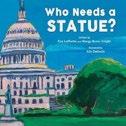
A gallery of intrepid American groundbreakers, pathfinders, and activists who have earned commemorative statues. Starting at the U.S. Capitol and ranging as far afield as an airport in Austin, Texas, and a park in Napa,
California, the book covers more than a dozen figures—all either women, people of color, or both—who have been immortalized in stone or bronze. Many of the names will likely be unfamiliar to young readers. Beginning with Thocmetony Sarah Winnemucca, the first published Native American woman author, and continuing on past the inspirational likes of Anne Hutchinson (who was banished from colonial Massachusetts for illegally teaching men), comet discoverer Maria Mitchell, and Olympians and activists Tommie Smith and John Carlos, each entry features a brief but sonorous initial annotation and a more detailed one in the backmatter that identifies the statues’ sculptors. Delinois’ painterly images don’t always capture the individual style or character of the monuments the way photos would have, but he does take advantage of his medium to add homey or historical flourishes, such as a view of Deborah Sampson—who dressed in men’s clothes in order to fight in the American Revolution—blasting away at a group of redcoats and an image of a child in a wheelchair seated next to a chatty effigy of Everglades advocate Marjory Stoneman Douglas in a garden near Miami. An oblique closing reference to commemorative statues being removed or replaced in many localities ends this powerful recitation on a cogent note.
Deserving but less prominent luminaries shine more brightly here. (Informational picture book. 7-10)

Latimer, Alex | Random House (32 pp.)
$18.99 | Oct. 22, 2024 | 9780593810965

Quick—think about something other than tigers!
The author of this delightful, interactive book promises to draw anything the reader can imagine. That is, anything other than tigers, which are too difficult. As the reader repeatedly fails to stop thinking about tigers, each page fills up with not-quite-right big cats rendered in a variety of artistic styles. A tiger with eight legs. A coffee-drinking tiger in a tie, with a long, noodlelike tail. A deconstructed tiger, its body parts scattered across the page. A mertiger. As the end of the book approaches, the narrator nearly gives up before coming to a realization: After all that practice, the narrator’s tiger-drawing skills have improved dramatically. Instead of trying to get the reader to think of something besides tigers, the narrator now asks the reader to envision a detailed tiger, which the narrator will then depict. With that completed, it’s the narrator’s turn to think of something for the reader to draw. A note at the end explains how the author internalized the message of the book: that “making bad pictures is part of learning to make good ones.” Latimer’s dynamic visuals ramp up the energy, while his humorous text encourages readers to try new things of all kinds, embrace doing them badly at first, and keep going. A creative, lighthearted way to nurture a growth mindset. (Picture book. 4-8)
Liu, Marjorie | Illus. by Grace Kum Quill Tree Books/HarperCollins
(256 pp.) | $15.99 paper | Oct. 1, 2024
9780062995551 | Series: Wingbearer Saga, 2

A magical girl works to unearth her origins and seek her destiny.
Zuli, who’s held captive aboard a floating ship alongside her owl companion, Frowly, and her friend Orien, a green-skinned, winged creature, is about to be freed—or perhaps captured by someone else— while plotting to pursue her own noble quest. That journey, established in the saga’s previous volume, involves saving the souls of birds held in a purgatorial parallel world. This follow-up is full of political machinations and worldbuilding ideal for fantasy lovers. But the story is ultimately rooted in the personal: Zuli’s attempts to understand and contend with her connection to the fearful witch-queen Zara. Both seek to save the birds and preserve their world but by drastically different means. Kum’s elegant character studies visually recall a family-friendly iteration of the Saga space-opera comic book series. The backdrops are beautiful, but the constant conversation bustling the narrative along doesn’t always give these majesties space to breathe. Its most meaningful moments are those of eerie, ominous quiet: mystical visions of the past, apocalyptic red skies over a burnt-out city, and a glowing ghostly world. Zuli and Zara are Black humans, while most other characters appear in animal forms.
A creative, lighthearted way to nurture a growth mindset.
Intricate, ambitious fantasy with a thoughtful, glowing heart. (Graphic fantasy. 8-15)
Kirkus Star
MacKay, Elly | Tundra Books (44 pp.)
$18.99 | Oct. 1, 2024 | 9780735266988

On a quiet winter walk, two fox sisters look for a snow dragon and find magic in the natural world around them. Miriam and Celeste meander through the glittering, silvery wonder of a snowy day. Miriam, the eldest and a selfproclaimed dragon expert, points out signs that a snow dragon is hiding in their garden. That low, rumbling noise is its roar; a snowbank is its camouflage; and the swirling pattern of frost on a greenhouse window is, in fact, frost fire. Miriam has an answer to all of Celeste’s questions: Why doesn’t the dragon leave tracks? Where does it go in the summer? Miriam also notes that dragons are sneaky and greedy and that they would love to eat Celeste. Bravely, Celeste marches off alone to confront the dragon. When she finds it, all is not quite as she expected. She returns to her sister, but now Celeste is the one armed with knowledge, and it’s Miriam’s turn to learn. The sibling relationship is sweetly authentic. Their dynamic has enough mild friction to ring true, with Miriam’s slightly know-it-all air and Celeste’s tendency to tag along and ask questions, but the sisters’ strong bond and mutual trust never waver. Whimsical illustrations feature dreamy colors and soft-focus backgrounds washed out with reflected winter light. This tale is magical anytime, but it’s a top choice when seeking a winter story that doesn’t center on a holiday.
As contemplative and lovely as a walk in the snow. (Picture book. 4-8)
As contemplative and lovely as a walk in the snow.
FROSTFIRE
Marsh, Rachel M. | Greenwillow Books (256 pp.) | $18.99
Sept. 10, 2024 | 9780063325388

Starting over in Massachusetts is a challenge for Louisiana transplant Feliciana Fruge. Feliciana, a Cajun girl from the bayous of Terrebonne Parish, is struggling to adjust to her new life. When her mom and stepdad, Bob, got married, the family left the South for Bob’s hometown of Boston. Feliciana doesn’t like anything about the place. It’s cold, the food is bland, and ever since she moved here last year, she’s been bullied and made to feel self-conscious for being and sounding different. Starting sixth grade at a new school, Feliciana hopes to keep her Southern origins to herself. There’s only one problem: On her first day at Revere Academy, a wolflike creature from Cajun legend shows up, watching her with glowing yellow eyes. It turns out that Grandma knows a thing or two about this rougarou. Juggling excitable Roux with a city-wide art competition makes Feliciana more homesick than ever. But she discovers there’s more to the rougarou—and Boston—than she ever expected. Marsh tackles bullying, alienation, and displacement through the powerful lenses of myth and legend. Feliciana’s journey to accept her new home and herself creates a compelling, moving character arc that acknowledges how hard it is to be uprooted from one’s home while also learning to find joy in a new place. A magically charming debut. (Fantasy. 8-12)
Mbalia, Kwame | Freedom Fire/ Disney (480 pp.) | $17.99 Oct. 1, 2024 | 9781368064736

Mbalia takes the legacy of Pullman porters as inspiration for his latest fantasy world rooted in Black lore and traditions in this series opener. Twelve-yearold Jax Freeman is an unwilling transplant to Chicago, sent away from his Raleigh, North Carolina, home by his parents after an incident lands him in the juvenile justice system. Just about as soon as he descends from the train, the weirdness starts: Inanimate objects speak to him, a strange old woman tells him his ancestors need him, and a terrifying creature tries to steal his skin. The strangeness keeps building, from the inspirational signs at his grandmother’s house that keep changing their messages to the class in… magic?…at DuSable Middle School. And what’s with the peculiar reactions he gets whenever people learn his surname? Pretty soon Jax is riding a magic train called the Shriek, charged with a mission to heal a feud among the five magical summoning families of Chicago—a mission that killed his great-great-grandfather. Jax spends most of the novel in a state of frustration as he tries to understand this new world, and readers may sympathize as they wait with him for other characters to dole out information. Mbalia has so much fun developing the world’s rules and inhabitants, though, that readers will probably not mind the adventure’s
bagginess. Jax has a digressive narrative style that runs to broad comedy, but it’s his fundamental decency that really shines. All aboooooard! (Fantasy. 8-12)
McBeth, T.L. | Flamingo Books (40 pp.)
$9.99 | Oct. 15, 2024 | 9780593528488

A comic case of mistaken identity. A tan-skinned child sees a white-haired, white-bearded, red-suited, light-skinned gentleman enter a store and asks if he’s Santa. The man denies it, but the kid points out that the man resembles Santa. When the man mentions his wife, the child asks if he’s referring to Mrs. Claus. The man protests: “Her name is Cheryl. She’s a veterinarian.” Later, the youngster compliments the man’s “sleigh”—a red truck—and follows the gent home to “N. Pole Drive.” There, the youngster inquires about some nearby reindeer—they aren’t pets, “Santa” says, just neighborhood “wild animals.” Interestingly, “Santa’s” house includes a workshop, where he makes “hand-crafted trinkets,” runs “a coal business,” and employs elflike “assistants.” The man imparts “the true meaning of Christmas”: “spending time with people you love and thinking about others before yourself.” Before departing, the child leaves a long list of gifts—just in case. When last seen, the maybe-Santa gets his truck loaded, and the “wild reindeer” haul him and a burgeoning sack across the night sky. Kids will enjoy this drily witty and original twist on Christmas. They’ll likely have already realized from the outset that, of course, this Santa’s real; they’ll feel vindicated by the conclusion. The humorous, thick-lined digital illustrations feature wide-eyed, racially diverse characters. A genuinely jolly Christmas choice. (Picture book. 5-8)
McBride, Amber | Feiwel & Friends (224 pp.) $17.99 | Oct. 1, 2024 | 9781250908780

Onyx has a secret. It’s 1970, and following the death of his grandmother, Onyx, a 12-yearold Black boy, is left living alone with his mother, who has early onset dementia. Fearing losing Mama, too, he keeps her condition a secret from everyone and instead vows to make sure that he keeps up the show of everything being OK at home. His days are filled with completing chores, leaving sticky notes for Mama to read when she wakes up, attending Catholic school, and catching up with his cousins and other relatives when he can. Onyx relies on the knowledge passed on to him by his grandmother to manage their Alexandria, Virginia, home—shopping for groceries and preparing simple meals for himself and his mother. As her condition begins to worsen, however, he desperately tries to find a way to help Mama get her memories back. Facing the looming threat of a home visit by social workers, Onyx takes bigger and bigger risks in his attempts to return his mother to her former self. Written in verse through the eyes of a child, the novel tackles complex topics honestly yet hopefully. As readers follow Onyx in his endeavors to help his mother, they’re also given a glimpse into being a young Black boy who, for all his troubles in life, has just as many joyful moments with his family and friends. A story of perseverance and love. (author’s note) (Verse historical fiction. 8-12)

Mepani, Kusum | Illus. by Yasmeen
Ismail | Kokila (40 pp.) | $18.99
Oct. 1, 2024 | 9780593110317

Saturdays are a flurry of chores at Meena’s house. She and her sisters help her mother shop and tidy up to prep the house for a deluge of visitors. Meanwhile, her brother lounges in bed reading. Meena knows this is unfair, but her mother says that’s just the way things have always been since she was a little girl growing up. Meena’s family, the first to emigrate from their village in India, help others who come later. As afternoon rolls around, aunts, uncles, and cousins fill the house with activity. While Meena makes countless cups of chai, the women prepare elaborate meals. The children entertain themselves by watching Bollywood movies and reenacting dance and action scenes. At dinner, tradition dictates that the women eat after the men. Meena knows that this, too, is unfair, and today, she decides to bring about change by sitting down to dinner with her father and the other men. The story mirrors the realities of many immigrant communities, demonstrating how families often gather to prepare and enjoy food and give new arrivals a leg up in a new land. Told in a realistically childlike voice, the narrative also highlights the gender disparity that many children encounter from a very young age. The bright watercolor illustrations are bursting with life. Traditional Indian clothes and food figure prominently as characters chatter and play in a whirlwind of chaos and togetherness. A lively look at community, connections, and ways to foster change. (Picture book. 3-8)
Messenger, Madhu | Illus. by Darshika Varma | Whitman (32 pp.) | $18.99
Oct. 3, 2024 | 9780807571866
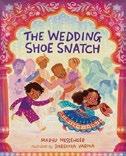
A South Asian girl grapples with big changes at a family wedding. Shilpa’s older sister, Maya, is getting married, and Shilpa is nervous. What if she loses Maya to her new family? Maya’s future husband’s younger brother, Rishi, makes her especially uneasy. For one thing, he won’t stop calling Shilpa “Bean.” For another, Maya calls Rishi “sweet”— will Maya ever call Shilpa that again? Shilpa tries to get past these troubles and focus on her main responsibility: upholding the tradition of Joota Chupai, or stealing the groom’s shoes and returning them only when he offers a prize. Shilpa and her cousin plot to steal the shoes, but Rishi is fast and tries to make off with them. In an unexpected twist, Rishi falls and hurts his knee, and Shilpa stops to help him. She soon realizes that Rishi isn’t her rival. Indeed, he turns out to be her newest partner in crime at the wedding—and maybe even her newest brother. Upbeat text and vibrant illustrations combine for a raucous story full of heart, movement, and joy. Although Shilpa’s change in attitude toward Rishi feels abrupt, her fears about losing her sibling and integrating into a new family are both relatable and beautifully explored. The illustrations are particularly inviting, featuring bold colors, intense emotional expression, and laugh-outloud silliness.
A sweet, playful tale about stealing shoes and finding family. (Picture book. 4-8)
A sweet, playful tale about stealing shoes and finding family.
THE WEDDING SHOE SNATCH
The Little Christmas Tree
Meyer, Thomas | Illus. by
Philippe Goossens
Trans. by Marshall Yarbrough | NorthSouth (32 pp.) | $19.95 | Oct. 8, 2024 | 9780735845411

A tiny tree gets bullied at a Christmas tree school.
Tucked away in a lush forest, a thicket of trees listen to their teacher, Ms. Bear, who shares sound advice: “Stand up straight! Don’t sing along! Drop as few needles as possible!” A tree named Alex, with a tree branch nose, kind eyes, and a worried smile, is smaller than the rest. Kurt, a larger tree classmate, teases Alex. During ornament-holding class, Alex can’t hold as many decorations on his small branches as the other trees. Kurt taunts him: “Ha-ha, you’ll never be a Christmas tree!” Ms. Bear admonishes Kurt, but the damage is done. Alex fears that no family will ever choose him. Unfortunately, when the animal families start to pick out trees, it seems Alex’s fears are warranted. He’s left alone in the forest—until a rabbit family hops along, with a tiny young rabbit who understands Alex’s plight. Alex may be small in stature, but his holiday spirit looms large. This German import doesn’t delve deeply, just skimming the surface of bullying behavior, but it’s a refreshing angle for a holiday story. Goossens’ deep greens and expressive trees lift the woodland message of kindness and give it warmth. Small but mighty. (Picture book. 3-6)
Miles, Shanna

Siren School, a finishing academy for witches—a consequence of becoming temporarily possessed by an angry ghost at her public school. This event, while no real surprise for Issa, could have led to dangerous public knowledge that she’s a rare conduit for spirits. Rumors of deaths at the new school turn out to be all too accurate…plus, whatever is growing in the belly of Headmistress Serena is decidedly not a human baby. Issa’s aversion to the school takes a radical shift, though, when news of a devastating family tragedy sets her on wildly dangerous (and rightfully forbidden) inquiries into ways of cheating death. Sharing several members of a magically gifted extended family with Miles’ The Fall of the House of Tatterly (2023), as well as the same sublime blend of humor and horror, this companion volume pitches its determined Black lead into encounters with terrifying foes and surprising allies—some living, some dead, and one pesky boy who’s not quite either. Better yet, along with being the delightful sort of school where feline familiars stroll through walls and Salome’s spellbinding dance is taught in anatomy class, the Siren School turns out to be a place where Issa finds real friends at last while coming away stronger in both self-command and in connections to her ancestral heritage.
Chills and chortle-worthy twists mix in happy abandon. (Paranormal. 8-12)
Miller, Callie C. | Illus. by Kristy De Guzman | Aladdin (384 pp.) | $18.99 Sept. 17, 2024 | 9781665952323
Series: A Quest of Great Importance, 2
All is definitely not right at Issa’s new boarding school. Issa has been forcibly enrolled by her concerned but often absent parents at the

Merlynda saved her twin, Percy, from the machinations of the evil Morgan le Fey in 2023’s The Hunt for the Hollower Now, both are recuperating—Merlynda from being Hollowed of her magic and Percy from his devastating role as the Hollower. He’s working to right past wrongs, and he’s afraid to tell anyone that he still hears Morgan’s voice in his head. Percy becomes more secretive when it’s discovered that a Shadowsoul is stealing magic. Percy wonders whether he created the Shadowsoul when he was the Hollower. Guiltridden, he charges off solo to conquer the Shadowsoul. Merlynda, ever faithful, follows. Knowledge of the first book is helpful for following the events in this one, although interspersed notes from the narrator provide background information. The white-presenting twins are soon joined in their quest by a colorful cast of somewhat diverse characters—familiar friends plus new allies. Plenty of clashes keep the excitement level high, and readers will be surprised when the villain is revealed. Even when things are tense, the twins’ loyal familiars add comic relief. Gradually, Percy takes to heart what those around him have been reassuring him: He’s more than his worst act and he’s loved.
A thrilling magical romp with a heartfelt message. (Adventure. 8-12)
Mistry, Poonam | Candlewick Studio (48 pp.) $18.99 | Oct. 1, 2024 | 9781536238716
Percy is attempting to rebuild his identity after perpetrating evil upon the magical community when a new threat forces him to examine himself anew.
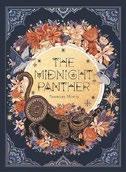
A panther learns to accept who he is. Gentle Panther isn’t like the other bold, visually striking big cats in the forest. By day, he frolics with the butterflies and fish, “filling his heart with joy,” and by night, he ponders his existence and laments his loneliness. Unlike Tiger, Lion, and Leopard, he doesn’t have stripes, a mane, or spots to
A DRAGON FOR HANUKKAH
set him apart. One day, he searches for a way to feel special. Using feathers, pollen, and leaves, he re-creates the distinct features of his fellow felines. Rain, Sun, and Wind, all anthropomorphized, are disappointed in his actions and work to sabotage his efforts. As night falls and Panther begins to despair, Moon encourages him to embrace his own special qualities, leading Panther to find his voice and his place in the forest. Mistry’s ink and digital art is truly stunning, mixing several different contrasting patterns. Inspired by her Indian heritage, she has created mesmerizing, abstract shapes that come together in a dazzling landscape of swirls and deep colors that evoke the natural elements. Never verging on didactic, the text has a lovely flow to it, with a fablelike structure that finds Panther learning an important lesson about seeing the true beauty in himself. An eye-catching, elegantly illustrated, and tenderly told tale of burgeoning self-confidence. (Picture book. 5-8)
Mlynowski, Sarah | Illus. by Ariel Landy Orchard/Scholastic (40 pp.)
$18.99 | Sept. 3, 2024 | 9781338897524

A child describes a series of gifts given by family and friends for Hanukkah.
The first is from young Hannah’s parents: a dragon named Nerry. Hannah details the presents received on the next nights of Hanukkah: a rainbow that “[spills] down the stairs,” a treasure chest filled with gold coins, a merry-go-round, a time machine that takes Hannah back to the ancient days of the Maccabees, a pair of “rocket boots,” and three
boisterous unicorns. On the eighth and final night, it’s Hannah’s turn to give gifts; the child is preparing a “tasty treat.” Readers also discover that Hannah has been describing the presents very inventively. Nerry the dragon’s actually a stuffed animal; the rainbow’s a multicolored drawing; the treasure chest is an assortment of chocolate coins wrapped in gold foil. Hannah’s gift to others? A large batch of latkes. Hannah shares them with family and friends at a festive holiday dinner, “which makes this last night, / the eighth night, / the most magical night… // of Hanukkah.” Kids will enjoy this simple, inviting reminder that the holiday is about warmth and togetherness. The dynamic, colorful illustrations are full of imaginative imagery and present familiar holiday symbols, including menorahs (Nerry lights the candles by breathing fire in one scene), stars of David, dreidels, and jelly doughnuts. Hannah’s family is pale-skinned; the dinner guests are racially and ethnically diverse. An appealing and magical celebration of the Festival of Lights. (more information about Hanukkah) (Picture book. 4-7)
Moore, Katrina | Illus. by Amber Ren Roaring Brook Press (32 pp.)
$18.99 | Oct. 15, 2024 | 9781250851451

On the first day of school, a child learns about the different ways we can nurture, grow, and share the spark within. Each of us has a star deep inside. The stars all vary in color. They can be shy and frightened, sometimes shrinking until they aren’t even shaped like a star. Some stars are bent; sometimes
they even break. Sometimes a star “may start to scratch / like an itch in your throat.” Sometimes, it fills your eyes with a twinkle. As a young child starts school, readers see how the star within changes as the youngster experiences different emotions, like being scared or feeling lonely in the cafeteria. Another student reaches out with an overture of friendship, but the protagonist trips and falls—and withdraws, throwing the star in the trash. But, with the help of a sympathetic adult, the child learns how to make the star grow and glow again— and then how to use that light to help others glow. Readers are asked what they will do with their own stars and light. Told in rhyming, lyrical verse, this is a moving reminder of our potential and the kindness we can share with others. Relying on watercolorlike washes of color and arresting imagery, the illustrations propel the story forward and add context to the minimal text. The protagonist has light brown skin and appears Asian; other characters are diverse.
Vibrant and inspiring. (Picture book. 4-8)
Ms. Rachel | Illus. by Monique Dong Random House (40 pp.) | $19.99 Sept. 24, 2024 | 9780593811252

Popular YouTuber
Ms. Rachel tells a story of searching for a surprise in this song-filled picture book. Wearing her signature pink shirt, headband, and overalls, Ms. Rachel invites readers to help her find something really special. Encountering a series of boxes, she speculates as to what could be inside, opens them, and discovers various objects, among them a yellow school bus, a pretend piece of bubble gum, and a teddy bear. Though none of them are what she’s looking for, each
one prompts Ms. Rachel to sing a song and engage with readers. Ultimately, she’s seeking a mirror to see the reader’s smile: “You are so special because you’re you! Remember, you’re a great kid!” Ms. Rachel’s fuzzy orange friend Herbie makes an appearance, providing help when she’s frustrated. The book contains plenty of singing, clapping, and animal sounds, all of which makes it ideal for young toddlers. The simple, colorful illustrations work well with the interactive elements. While not much sets this tale apart from similar titles, Ms. Rachel’s popularity and the age-appropriate content make for an appealing read. The final page includes “Ms. Rachel’s Tips for Language and Brain Development!”—a list of activities aimed at adults, among them narrating one’s day and creating routines. A fun, familiar, interactive tale that will especially resonate with the author’s many fans. (Picture book. 1-3)
Kirkus Star
Ormsbee, Kathryn | Illus. by Molly Brooks
Colors by Marta Todeschini
Random House Graphic (240 pp.)
$21.99 | Oct. 29, 2024 | 9780593650066

Turning 12 isn’t easy. In this standalone companion to Growing Pangs (2022), Katie cannot wait for her 12th birthday. She’s looking forward to getting her first real babysitting job, auditioning for the musical Annie, and hanging out with BFFs Ginni and Amalie. Unfortunately, 12 isn’t turning out as she expected: Ginni and Amalie are moving away to help their grandmother, Katie doesn’t land her coveted lead role in the musical, the mean girls in her church youth group bully her, and her anxiety and OCD (which she describes as her “buzzing thoughts”) seem to be worsening. When Katie meets Grace,
who’s also cast in Annie, she realizes that this is her first crush. Growing up home-schooled and religious, she’s been steeped in purity culture and homophobia, creating a deep chasm of anxiety as she struggles to find self-acceptance, confidence, and community. Loosely based on Ormsbee’s own life, this delightful tale is a stellar middle-grade offering, adroitly capturing the heartbreak and joy of early adolescence. The alluringly vibrant illustrations feel cinematic, with their immersive feel and keen emphasis on facial expressions. Notes from both the author and artist provide resources and enriching anecdotes. With its unabashed candor, empathy, and accessibility, this book will appeal to fans of Raina Telgemeier, Kayla Miller, and Shannon Hale who are searching for their next favorite read. Katie and Grace present white; Amalie and Ginni have brown skin and wavy black hair.
A heartfelt and endearing snapshot of adolescence. (Graphic fiction. 8-12)
Parris, Wendy | Delacorte (224 pp.) $8.99 paper | Sept. 17, 2024 | 9780593807996

Growing up may be scary—but not as scary as a malicious ghost. Avery is excited to visit her Midwestern hometown after moving to Philadelphia. She’s miserable in her new home, not fitting in the way she did at her old school, so returning to her close, trusted friends feels like just what she needs. Only, things are different. The dynamics
between Jaylen and Tyler are off, and her best friend, Paige, seems too cool for the things they used to enjoy. Afraid that the group has grown up without her and determined to have things return to normal, Avery suggests a thrilling game: a seance at an abandoned theater where, 10 years prior, a young girl plunged to her death. Rumors about her ghost abound, making this the perfect occasion for Avery to show that she’s not “still a scaredy-cat,” as Jaylen says. At first it appears the seance doesn’t work, until the spirit reveals herself—and she’s more terrifying and dangerous than they expected. Now it’s up to Avery to fix what’s been broken and save herself and her friends. The character development is light overall, but Avery has some nice moments of growth. The story moves quickly, the friendship complexities are believable, and readers will enjoy the genuine scares. Jaylen is cued Black; the other main characters are coded white. A fast-paced, spooky tale exploring adolescent tumult and the uncertainty that comes with change. (Paranormal. 8-12)
Patterson, James & Joe Kulka | Illus. by Joe Kulka | Jimmy Patterson/Little, Brown (40 pp.) $18.99 | Oct. 15, 2024 | 9780316572835

What is Fox planning? Fox is carefully monitoring eight little chicks. “Fox is coming! / Hide away.” And off they go. Before setting off after them, the sly fox ties a kerchief onto a stick, perhaps to hold captured chicks. Trying to outwit the fox, the chicks run
A fun, interactive tale that will especially resonate with the author’s many fans.
MS. RACHEL AND THE SPECIAL SURPRISE
and flap throughout the farm, hiding in any place that might provide safety, or at least a temporary respite: maybe nestled among the large tree roots, in a hollow log, in the tin cans strewn around a foraging goat, or even among pigs in a muddy hole. All the while, the other farm animals look on benignly. But wherever the chicks run, the fox is not far behind, eagerly grabbing one or two of them at a time and placing them in that kerchief. Told in simple rhyming couplets, the tale will have youngsters following along with breathless anticipation as the desperate chicks careen around the farm in very bright, colorful, sharply defined illustrations, sometimes in wide angle, sometimes close up. The overall-clad fox’s expressions are by turns thoughtful, intense, and triumphant but never overtly menacing. When all the chicks are in the bag, the story comes to an unexpected, reassuring twist. The book is essentially a reworking of Kulka’s earlier work, Wolf’s Coming (2007), with co-author Patterson joining in as part of his recent series of collaborations. Delightful, surprising, and all in good fun. (Picture book. 3-6)
Please, Mikey | Harper/HarperCollins (48 pp.) $19.99 | Sept. 24, 2024 | 9780063345492
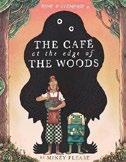
A determined chef and an enterprising waiter serve a finicky patron. Rene, a young tan-skinned woman, washes windows and “save[s] up every bean” to realize her dream of opening her own eatery, the titular cafe. The only applicant for the waiter position is Glumfoot, a short, squat, pointy-eared, green-skinned fellow. Morning after morning the cafe remains discouragingly empty until Glumfoot brings in a customer: a huge, green, lumpy-headed ogre. Unimpressed by Rene’s menu, the ogre requests some icky, off-menu items: pickled bats, slugs,
and battered mice. When Rene bravely suggests a cheddar tart, the ogre counters, “A bag of bats! That smells like fart!” Rene nearly gives up, but Glumfoot, realizing that the ogre’s aversion to different foods is rooted in his desire for the familiar, deploys a clever solution that results in rave reviews from the ogre. The jaunty rhythm and rhymes of the text are lighthearted, while the warm, cartoonlike illustrations are droll and highly expressive, reflecting the author/ illustrator’s background as an animator. Rene’s clothing, kitchen, and the cafe’s interior have a pleasantly retro feel, and the story concludes with an abundant variety of fairy-tale creatures who come to dine at last.
A delightful and silly treat for gourmets, gourmands, and picky eaters alike. (Picture book. 3-7)
Potter, M é lisande | Illus. by Giselle Potter
Christy Ottaviano Books (40 pp.)
$18.99 | Oct. 15, 2024 | 9780316335447

A celebration of the iconic sled dog who led a medical rescue mission to Nome, Alaska, in 1925. Balto the sled dog still gets the press, but Togo did more of the work—leading a team that carried diphtheria serum through storm and over ice on one long, dangerous leg of a 674-mile relay mission. But the entire team’s intrepid spirit and strength of doggy character—which Robert J. Blake portrayed so compellingly in his
2002 Togo —is at best only fitfully present here. The golden, stubby-legged pooch in the painted illustrations doesn’t look anything like the noble figure in the closing photos, and, when they’re not lounging at ease in the Alaska wilderness, dining on fish elegantly served on dinner plates, the team’s dogs are depicted merrily mushing along beneath clear, high skies over a neatly plowed path or even somehow upright on a vertical cliff, harking perhaps back to a previous reference to “curvy landscapes.” And though the afterword has details about sled dogs in general and Togo’s later life in particular, the author admits that one incident she’s depicted to demonstrate his intelligence actually occurred on an earlier, unrelated journey. Togo’s owner was white, but there is some racial variation in scenes depicting the crowds that flocked to see him on a subsequent tour of the U.S.
Takes too many liberties with the facts, for all that the tribute is well deserved. (sources) (Informational picture book. 6-9)
Preller, James | Feiwel & Friends (240 pp.) $17.99 | Sept. 10, 2024 | 9781250834492

Life changes quickly for a middle schooler after an accident forces her to slow down and reevaluate who she is.
Thirteen-yearold Kristy Barrett has always attracted attention on the soccer field: As a 4-year-old, people saw her playing and just knew there
An introspective and realistic coming-of-age story about rediscovering oneself.
SHAKEN
was something different about her, from her focus to her speed. She was special. This phrase has been repeated her whole life. Now, as a seventh grader, Kristy is starting on the varsity girls’ soccer team, dominating players who are several years older than she. Soccer isn’t just her passion, it’s her identity, the thing that people notice her for— and she loves it. But after she’s kicked in the head while diving for the ball, she suffers a traumatic concussion. Suddenly, Kristy is a different person—and no one seems to understand her or what she needs or even how to talk to her now that she’s not that special soccer player. Preller’s careful pacing matches the fuzziness and slow healing of Kristy’s brain, introducing readers to the realities of the pain, loss, and feelings of isolation that dedicated athletes often experience when they can no longer play. The somber tone of the story is lightened by the presence of two minor characters who bring levity and humor. Strong themes of healing (both physical and emotional), family, and friendship abound. Main characters cued white. An introspective and realistic coming-of-age story about rediscovering oneself. (Fiction. 9-13)
Preston-Gannon, Frann | Paw Prints Publishing/Baker & Taylor (24 pp.) | $7.99 paper | March 5, 2024 | 9781223188065

Making the world better, one small step at a time. In jaunty verse, six diverse families present 30 simple, practical, and economical ways to make the world a nicer, greener place to live. These fun ideas can be put into practice immediately and can be carried out by even the smallest family members. Young children can plant seeds together, then water the growing plants—activities that support
wildlife, including butterflies, bugs, and bees. Siblings can bathe together to save water. Children can donate “pre-loved” clothes, books, and toys to others, while adults are encouraged to mend broken toys, fix broken taps to save water, shop with reusable bags, buy food from local vendors, and use public transport or ride bikes. Naturally, Preston-Gannon mentions recycling (e.g., cartons and bottle caps) straight off—which is a helpful lead-in to a discussion of how wonderful it is for eco-conscious families to visit the library, that marvelous place where people can return old books, borrow new ones, listen to storytime, and take part in arts-and-crafts activities using recycled objects. This bouncy U.K. import includes softly rounded digital illustrations, with characters who reflect a broad, realistic spectrum of skin tones and family structures. The word family in the book’s title also suggests that all of us, as our planet’s inhabitants and stewards, are responsible for its well-being.
An engaging reminder that it’s up to all of us to care for Earth. (Picture book. 4-7)
Little Dino
Put, Diane | Illus. by Rik de Wulf | Clavis (32 pp.) $18.95 | Aug. 20, 2024 | 9798890630964

When young Dino emerges from his egg, he immediately looks for his mother, who’s nowhere to be found.
Reminiscent of P.D. Eastman’s classic tale Are You My Mother? (1960), this story follows a newly hatched purple dino on his search. After encountering a triceratops, a T. Rex, and a Pteranodon, he feels lonely and a bit inadequate—why doesn’t he have horns, sharp teeth, or wings like the others? But a friendly brontosaurus offers some help. Little Dino climbs aboard the bigger dinosaur’s back and eventually finds
his mother—and learns who he really is. Originally published in the Netherlands, this book cleverly embeds facts about each dinosaur within the narrative. Little Dino is more curious than frightened. In fact, he maintains a cheerful demeanor throughout his journey, becoming discouraged only after being rebuffed by the third dinosaur he comes across. The softly colored illustrations feature humorous depictions of Dino’s fantasies as he wonders what life would be like if he were the offspring of each of the dinosaurs he meets. The endpapers provide kid-friendly tidbits about each dinosaur—for instance, that a triceratops weighed as much as a truck and that a T. Rex had teeth as long as a water bottle.
A tender tale of parent-child love, with some dino facts for good measure. (Picture book. 4-7)
Rex, Adam | Illus. by Audrey Helen Weber Neal Porter/Holiday House (48 pp.) $18.99 | Oct. 29, 2024 | 9780823457175

A sleeping baby embarks on a variety of adventures. While many tales are intended to convince little ones that it’s time to go to bed, this tale focuses on an infant who stays completely asleep while rolling out of the crib and out the door. Tumblebaby escapes scoundrels, becomes the Captain of the Coyotes, and travels through Oklahoma City, Kansas City, and Colorado City. After sleeping through winning the gold at the Winter Olympics, Tumblebaby rolls home “covered with stickers from various hotels and attractions.” With a purple body and a kaleidoscopic head, this cherubim wobbles and somersaults through an unusual world that’s vividly depicted with visible brushstrokes in gouache and acrylic paints. On Weber’s double-page spreads, the baby ranges in size from tiny to enormous. Psychedelic
LAST BEST HOPE
text and illustrations move this tall tale along as quickly as a dream. Rhyming chants interspersed throughout will have readers reciting along (“Tumblebaby, / rumblebaby, / give a snout / a whack. / Serve ’em / humble pie / and you’re / the leader / of the pack”). Though tonally the story feels like a fable of yore, more modern topics, such as characters building a community center in Colorado City, are folded in. Right on the edge of nonsense, this book will surely spark curiosity among young readers. A satisfying tumble through the imagination. (Picture book. 4-8)
Ríos Ramírez, Mariana | Illus. by Sara Palacios | Knopf (40 pp.) | $18.99 Sept. 10, 2024 | 9780593568361

A young Latine girl and her family prepare for a Día de los Muertos celebration.
Julieta had a special bond with Abuelita, who has recently died. Día de los Muertos is approaching, and Julieta and her family will add mementos to the ofrenda, an altar with offerings for ancestors. Julieta wants to find a special gift for Abuelita that will let her spirit know that she is dearly missed. But her attempts at weaving a flower crown and folding an origami bird just don’t work. Julieta becomes nervous: What if she doesn’t have anything to place on the ofrenda in time for the holiday? Then she thinks
about the times when she and Abuelita were happiest and remembers that they shared their biggest smiles when they were dancing together. She brings out her dancing shoes, dress, lace fan, and hair combs—shelved since Abuelita’s passing—and dances for the family. Julieta feels her grandmother’s presence and knows that she and Abuelita will always stay connected. Ríos Ramírez speaks to the complex emotions surrounding loss, while Palacios’ earth-toned illustrations, made with gouache, cut paper, and Photoshop, have a quietly intimate feeling. Her textured backgrounds are immersive, while the characters are wonderfully expressive. Young readers experiencing their own grief will see themselves in Julieta and her desire to remember Abuelita.
A touching tribute to the pain of losing a loved one—and the joys of honoring them. (author’s note, glossary, ofrenda guide) (Picture book. 5-8)
Ritt, Melody Howard | Illus. by Nia Gould Kar-Ben (32 pp.) | $19.99 Oct. 1, 2024 | 9798765604519
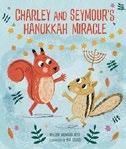
A chipmunk and a squirrel encounter challenges on the last night of Hanukkah. Best friends Charley Chipmunk and Seymour Squirrel love celebrating the Festival of Lights together. They can’t wait for the final night of the holiday. Seymour plans to fry latkes at his place, and Charley will come over with the menorah and
candles. But when the eighth night rolls around, Charley has trouble remembering what he promised to bring. A menorah and…something that begins with a C. Readers will chuckle along as Charley adds a variety of foods that start with C to his backpack, such as cantaloupe, cauliflower, and, of course, candy (chocolate gelt). At Seymour’s house, the friends read the story of Hanukkah. When it comes time to light the candles, Charley realizes his mistake, but the friends take a cue from the Hanukkah story and find a special way to light the menorah. Though the narrative is relatively predictable, young readers will enjoy the humor and the touching friendship. Notably, Seymour comforts Charley after his mistake, and they work together to solve the problem—a nice example of social-emotional learning. The conflict resolution and the cozy illustrations make for a refreshingly thoughtful holiday tale. As sweet as Hanukkah gelt. (the story of Hanukkah, glossary) (Picture book. 4-8.)
Roux, Madeleine | Illus. by Tim Probert Harper/HarperCollins (272 pp.) | $14.99 May 7, 2024 | 9780063039162 | Series: Dungeons & Dragons: Dungeon Academy, 3

The stakes go up considerably in this trilogy closer when the multispecies young heroes of the Danger Club set out to rescue their kidnapped friends. What with Bauble and Flash being in the clutches of necromancer Elgred Morbide, who’s on the verge of raising the mighty dragon An’Kizhek in order to give the monsters a decided advantage in their long war with the adventurers, the club members have their work cut out for them. As it turns out, only an alliance between monsters and adventurers will give anyone a chance of surviving the dragon’s rise. Forging that connection will require brown-skinned Zellidora
Stormclash to shed her false horns and tail, reveal herself as fully human, and accept that since it was Khalira Steelstrike, her own barbarian grandmother, who set these events in motion, it’s up to her to make amends. Fortunately for readers who need everything spelled out, not only is Morbide more than willing to crow about all his plans, but so, too, is Roux eager to wallop readers over the head with messages about being true to oneself and one’s friends. Unfortunately, the price of ultimate triumph is an event that casts a spell of poignancy over the story’s end, with the club’s old members making way for a new generation. Probert’s delicate grayscale illustrations awash in varying shades of blue add to the story’s dynamism and emotional impact. A brisk concluding round of swords, sorcery, and self-improvement. (Fantasy. 8-12)
Ryland, DK | Flamingo Books (32 pp.)
$18.99 | Aug. 27, 2024 | 9780593622421

Acorns don’t just disappear… Squirrel is off to find the thief. Squirrel knows where he buried his acorn, and it isn’t there! He draws the only conclusion he can: Someone has stolen it. Is Deer the culprit? “Oh, no. I would never,” says Deer. “But are you sure it hasn’t sprouted into—” Squirrel interrupts Deer. He has no time to talk! He must find his acorn. Did Skunk take it? “I may stink, but my morals don’t,” replies Skunk, who also tries to explain what might have
happened. Squirrel cuts off Skunk, too. Raccoon and Woodpecker have similar run-ins. Fox hasn’t seen the acorn and tries to trick Squirrel into becoming lunch, but Squirrel backs away. Owl finally tries to enlighten Squirrel by pointing to the little oak tree that’s growing where the acorn should be. Squirrel doesn’t understand, so Owl explains—but is interrupted when an acorn falls from above onto Owl’s head. Squirrel assumes it’s his beloved acorn. He hugs it…and promptly buries it. Ryland’s tongue-in-cheek “mystery” will entertain young listeners. Accompanied by a smattering of narration, the comic-panel-style illustrations depict the animals’ dialogue in colors that match their fur (or feathers). The digitally created illustrations resemble watercolor and colored pencil and feature big-eyed cartoon forest creatures.
A whimsical whodunit. (Picture book. 4-8)
Tonbo
Say, Allen | Clarion/HarperCollins (32 pp.) $19.99 | Oct. 22, 2024 | 9780063248472

Embark on a journey through time. The narrator, an elderly, apparently Japanese man, is out for a walk when a paper airplane whizzes by. He recognizes it as Tonbo (Japanese for dragonfly), the plane he had as a boy. Captivated by this memory, the narrator drops his cane and follows the airplane around a seaside town. He talks with various townspeople, each seeing him as a younger and younger person—until at last he sees the image of a
A rich, enthralling historical mystery that engages and educates.
twentysomething man reflected in an ice cream store window. When the narrator, now a child, finds the plane resting on a bush in a Japanese garden, time catches up with him as he remembers his mother bringing him the plane when he was sick as a boy. Leaving the plane for nearby schoolchildren to find, the man—old once more—returns to his walk and his cane. Say’s signature impressionistic, dreamy watercolors evoke the otherworldly experience of the narrator’s day with a summer palette awash in warm oranges, yellows, and pinks, juxtaposed with cool greens and blues. The whimsical, at times poetically fragmented text is peppered with names and places drawn from the narrator’s memory. While children may have a hard time relating to the experience of reliving one’s past, the tale could spark conversation about the power of memory; older adults may enjoy sharing it with the young people in their lives. A sophisticated, ethereal musing on the passage of time. (Picture book. 5-8)
Sepetys, Ruta & Steve Sheinkin Viking (400 pp.) | $18.99 Oct. 8, 2024 | 9780593527542
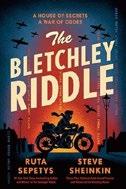
Siblings decode familial and wartime secrets in 1940 England. Headstrong 14-year-old Lizzie Novis refuses to believe that her mother, a U.S. embassy clerk who was working in Poland, is dead. After fleeing from her grandmother— who’s attempting to bring her back to America—Lizzie locates her 19-yearold brother, Jakob, a Cambridge mathematician who’s stationed at the clandestine British intelligence site called Bletchley Park. Hiding from her grandmother’s estate steward, Lizzie becomes a messenger at Bletchley Park, ferrying letters across the grounds while Jakob attempts to both break the ciphers generated by the German Enigma machines and
help his sister face the reality of their mother’s likely fate. With a suspicious MI5 agent inquiring about Mum and clues and codes piling up, the siblings, whose late father was “Polish Jewish British,” eventually decipher the truth. Shared narrative duties between the siblings effectively juxtapose the measured Jakob with the spirited Lizzie. Lizzie’s directness is repeatedly attributed to her being “half American,” which proves tiresome, but Jakob’s development from reserved to risk-tolerant provides welcome nuance. The authors introduce and carefully explain a variety of decoding methodologies, inspiring readers to attempt their own. A thoughtful and entertaining historical note identifies the key figures who appear in the book, such as Alan Turing, as well as the real-life bases for the fictional characters. Interspersed photos and images of ephemera help situate the narrative’s time period.
A rich, enthralling historical mystery that engages and educates. (Historical mystery. 10-14)
Sharp, Tori | Colors by Andrea Bell Little, Brown Ink (336 pp.) | $12.99 paper Oct. 1, 2024 | 9780316538930

Uncertain stars find their spotlights one step at a time. Clay and Kyle are used to operating behind the scenes in their middle school’s drama club. Their creative ambitions snowball from a comedic spring musical audition to performing improv at a local open mic to cohosting their own podcast. Having the support of their moms and Lettie, the manager of the cafe and local venue above which they live, is a major help. Joking with one another about their neurodivergence
A messy, funny, neurodivergent ode to finding your voice and owning your differences.
UP!
is another (Kyle is autistic; Clay has ADHD). During the course of these entertaining antics, Clay crosses paths with musically talented classmate and instant crush, Dania. The anxieties and triumphs of live performance give each of them room to stress as well as shine. Clay’s romantic and aspirational self-doubts become great lesson s in self-kindness. Clay is as bold and expressive as her blond mohawk, even if she gets distracted sometimes, while Kyle’s lavender curtain of hair betrays his calmer but just as creative personality. Combined with Dania’s talent for audio production, these eighth graders can take over streaming and bring down any house. Their authentic banter and earnest enthusiasm will turn readers into would-be subscribers to their show. The fluid, animated illustrations emphasize the characters’ facial expressions, and the pastel color palette is fresh and engaging. Clay, Kyle, and their moms read white; Dania and Lettie present Black.
A messy, funny, neurodivergent ode to finding your voice and owning your differences. (author’s note) (Graphic fiction. 9-13)
Sinclair, Opal | Pajama Press (24 pp.) $17.95 | Nov. 12, 2024 | 9781772783247
Series: Big, Little Concepts, 8

Adorable dogs do big jobs. Accompanied by high-quality stock photos, Sinclair’s text presents 10 working canines, from a therapy dog to a pooch who acts. Each spread
contains a four-line rhyme, written from the perspective of the dog, that offers a hint about its job. Then comes the big reveal at the bottom of the page, set in blue italics: “I am a service dog!” “I am a sled dog!” Each spread also features a decorative blue paw print. This sweet concept book will captivate young dog lovers: The close-up photos of the pups, occasionally seen in action alongside humans, are delightful, and children will learn that dogs can fill roles other than that of pets, though that’s charmingly portrayed here, too. Youngsters will come away with an understanding of the different reasons people require assistance from dogs; notably, Sinclair fosters empathy for humans in need and the brave, intelligent animals who serve them. A quibble: Some readers may wish that the various dog breeds portrayed had been identified. An appended guide for parents and caregivers stresses the importance of helping others and contains useful tips on familiarizing children with working dogs. Humans portrayed are racially diverse; one child uses a wheelchair.
A brief, engaging introduction to the lives of working canines. (Picture book. 3-6)
Smith, Lane | Random House Studio (40 pp.) | $18.99 | Oct. 8, 2024 | 9780593815281

Everyone’s favorite multieyed forest denizen returns with abundant presents (we just hope you like sticks).
Having shared an incredible love of nature and life itself in Stickler Loves the World (2023), the titular hero—a rotund creature with sticklike limbs and hair—knows precisely what to get everyone for Christmas. Taking on a role that’s usually filled by Santa, Stickler climbs astride Judy, a reindeer with treelike antlers, and delivers a Hop-Higher Stick to Rabbit, an Idea Stick to Crow, and an In-a-Pear-Tree Stick to Partridge (who’s oblivious to the “Twelve Days of Christmas” reference).
Upon encountering Doug-the-Fir, Stickler discovers that the introverted tree has been unwillingly trimmed and bedecked in a truly flashy manner. How can Stickler avert attention from shy Doug? Let us simply say that Stickler knows how to bring the glam when necessary. Smith leans hard into the oddest elements of the book (“It was a weird Christmas”), and readers wouldn’t have it any other way. Stickler’s love and care for its friends are oddly touching— in a sea of more saccharine winter holiday selections, this wildly funny, whimsical story stands out in all the best ways. Employing an eclectic combination of materials both traditional (gesso, oil, cold wax on canvas) and digital, Smith creates sweetly surreal visuals. Readers will chuckle at the instructions on the publication page explaining how to “Be a Stickler.” To quote the strangest little fellow ever to star in its own Christmas picture book: “Joy.” (Picture book. 3-6)
Smith, Ronald L. | Clarion/ HarperCollins (288 pp.) | $18.99 Aug. 6, 2024 | 9780063318557

A boy teams up with an old acquaintance to discover the truth about their military base. Thirteen-yearold Ike Pressure is accustomed to the Army brat life. Everywhere he goes, he’s the new kid, barely making friends before his family
is whisked away to another distant location. When his parents were stationed in Georgia, he was thrown together with another kid, Eesha Webb, who shared his birthday. The only thing more annoying than “loud and rude” Eesha is how his parents still bring up their supposed friendship. Eesha, who’s now living in Illinois, isn’t thrilled to learn her family will be moving to tiny Mercury, Nevada, where they’ll be stationed on the same base as “full-blown nerd” Ike and his family. But the two Black teens soon find a common interest: UFOs. In the relentless desert heat, Ike and Eesha fight to remain cool as they discover aliens, a time traveler named Mixie from the year 3000, and a secret Army mission that could put Ike’s mom in mortal danger. As they race to put all the puzzle pieces together, the kids begin to build a real friendship this time around. The plot moves at a churning pace, yet no loose ends are left unresolved. Military terms and scientific facts are inserted into the text and unobtrusively explained. Although the characters are well written overall, Ike’s anxiety can at times seem one-note. A certified page-turner. (Science fiction. 8-12)
Smith Despres, Mk | Illus. by Julie Benbassat
Neal Porter/Holiday House (40 pp.)
$18.99 | Oct. 8, 2024 | 9780823456413

Two friends ride out the ups and downs of life. It’s true that we can have too much of a good thing: The sun shines “so the whole city can skip and jump and swing and smile in it,” but it also burns
so hot that “everyone steams up or melts down.” Two pals, one with brown hair and tan skin, the other pale with dark hair, navigate the roller coaster that is life. When the hum of the day gets too loud for one child, the other is there, and the two sit together in peaceful quiet. When one youngster speeds down a hill and ends up taking a tumble, the other child is there to lend support. The text is lyrical, like stanzas of poetry, and though readers might want the words to rhyme, they don’t have a structured pattern. The illustrations bring the contemplative words to life with often dazzling results, such as a scene of children riding sunbeams like swings. The artwork has a soft, brushed quality that suits the various natural, outdoorsy settings. The final pages show the children returning home to the loving arms of their caregivers. The story lends itself to interpretation and meaningful conversation about the cyclical nature of life and the realization that with support and resilience, we can meet almost any obstacle. Imaginative musings on the world, ideal for young wonderers. (Picture book. 4-8)
Soloy, Lauren | Tundra Books (48 pp.) $18.99 | Oct. 22, 2024 | 9781774883150

In this tribute to the life of Moomin author Tove Jansson, a young girl pursues five naughty, troll-like creatures. Tove arrives at her summer home, where Moomin-like drawings adorn the wall. She begins exploring the striking yet desolate island, a prominent setting in Jansson’s
Imaginative musings on the world, ideal for young wonderers.
THERE’S THAT SUN AGAIN
A satisfying tale conveyed solely—and adroitly—through images.
LOST
life and work. Here, the semi-biographical elements diverge into a fantasy that, per Soloy’s author’s note, was “inspired by Tove’s life and the stories she wrote about her own childhood” (readers will need to consult the backmatter to make that connection). Tove visits a friend—a small, hairy brown creature—to care for his five wild daughters, all “tiny as shells.” A gust of wind blows the youngsters away, and Tove follows, picking up treasures and musing about the island’s mercurial nature before finally locating the wayward girls. She returns home, soaked but satisfied, to her mother’s warm sweater and “piping hot pancakes.” The narrative is pleasingly crisp yet contemplative; Soloy describes salvage as “a gift the sea gives you” and asks readers to “imagine never getting soaked to the bone and then getting dry again…How dreadful!” But it’s her rugged, elemental digital illustrations that steal the show. Thick black outlining and gorgeous, darkly atmospheric, Jansson-inspired backgrounds of stormy skies and sea contrast against slashes of light and warm, colorful domestic scenes.
All readers will find the handsome illustrations a wonder, while Tove Jansson enthusiasts will adore the homage. (Picture book. 4-9)
Lost
Staake, Bob | Anne Schwartz/Random (48 pp.)
$18.99 | Oct. 1, 2024 | 9780593707029

In this wordless tale, a child searching for a missing cat finds other lost animals along the way.
After failing to find the feline at home, the child takes to the
neighborhood, wallpapering every shop and mailbox with “lost” signs. The child encounters the mail carrier, who’s also looking for a lost pet, as well as a shopper seeking a missing giraffe. The child manages to find a pup and a couple of other animals…but what about the cat? Readers can breathe easy: This tale has a happy ending. Staake uses color strategically to highlight what readers should be noticing. All the backgrounds are rendered in shades of gray set against a very pale blue sky. The people with lost pets and the pets themselves are the only elements depicted in color—an artistic choice that turns readers into pet finders and advances the plot in the absence of text. The people themselves are fancifully colored; the protagonist has reddishpink skin. Their expressive faces and body language effectively signal depth of feeling. All these expert touches make for an accessible work of storytelling art. A satisfying tale conveyed solely—and adroitly—through images. (Picture book. 4-6)
Umansky, Kaye | Illus. by Alice McKinley
Peachtree (32 pp.) | $18.99
Oct. 15, 2024 | 9781682637463
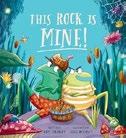
Two frogs have a big disagreement over the ownership of a small rock in the middle of a pond. One frog, comfortably ensconced in its own space, hears snores and, parting tall strands of grasses, discovers another frog lazing on the other side. Frog Numero Uno angrily confronts the interloper, announcing,
“This rock is mine!” The second frog huffily responds to assert ownership, pointing to its belongings. Each frog refuses to budge, and they almost come to blows. Suddenly, a huge shadow looms overhead—one with a menacing beak and pointy talons. It’s a heron! Terror-stricken, both frogs realize that this isn’t the time to bicker over real estate. They escape their would-be predator by jumping into the water. When the heron overtakes their former rocky domain, the amphibious pair, now safely hidden, decide the home they’d once vigorously argued over really wasn’t that great after all and find a “perfect” new rock to live on—together. This comical U.K. import, told in rollicking rhyme that bounces along as effortlessly as any frog, will engage readers while delivering an excellent message about friendships forged through cooperation. Children will relate to the frogs’ “It’s mine!” protestations. Dominated by hues of blue and green, the mixed-media and digital illustrations capture the humorous proceedings, the frogs’ very expressive personalities, and their lush, watery environment. The frogs’ dialogue is set in different fonts, incorporated into the artwork.
Kids will be saying “Mine!” about this delightful story that really rocks. (Picture book. 4-7)
van Eekhout, Greg | Harper/ HarperCollins (208 pp.) | $18.99 Oct. 22, 2024 | 9780063253360

Consumerism turns terrifying in a creepy company town. Newly transplanted Keegan has just settled into his new home in the seemingly utopian and cloyingly named Happy Town with his mom and his stepdad, Carl. Enclosed beneath a climate-controlled dome and devoid of birds or bugs, Happy Town life is dictated by corporate magnate Arlo Corn, who brands everything with
jargon (buses are known as “conveyors,” and detention is called Mandatory Saturday Work Opportunity). All adults in Happy Town receive tiny cranial implants known colloquially as “imps,” giving Corn an all-access pass into their subconscious (kids are thankfully spared this invasion of privacy). Commercials constantly stream as imp-embedded grown-ups fritter from one corporately decreed trend to the next—musical instruments one day and hats the next—all deducted from any pay they earn. Keegan and new friends Gloriana (who has an appetite for destruction) and Tank (a romance novel devotee) know that things aren’t quite right in Happy Town, but when the adults all develop an insatiable craving for meat, things take a dark turn. Van Eekhout’s satirical romp is a wonderfully silly and gross page-turner, sure to resonate with Goosebumps fans. Populated with cryogenic heads, meat-crazed zombies, and adorable animal toys that provide electric shocks, this tale will delight genre fans with its skillfully wrought intersection of social commentary and horror. Physical descriptions are minimal. By turns thrilling and thoughtprovoking. (Horror. 8-12)
Verde, Susan | Illus. by Peter H. Reynolds Abrams (32 pp.) | $15.99 | Oct. 1, 2024 9781419771941 | Series: I Am...
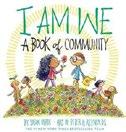
Helping oneself can benefit others.
A brownskinned, longhaired child
comes to an important realization: “The better I feel inside, the more I can be there for others.” With compassion and a commitment toward doing what’s right, the youngster says, we can change the world. We can be a safety net for others, we can collectively demand justice, we can have gentle conversations to work out differences, and we can welcome others into the community. Combining creative talents, we can celebrate together; connecting with others opens up wonderful possibilities. Verde’s contemplative text sets a tone at once musing and affirming, while Reynolds’ cartoon illustrations visualize the concepts in practical ways, grounding readers in colorful and emotive images. In one noteworthy scene, the protagonist sits across a grassy ledge from a pale-skinned, red-haired child, both looking serious but understanding as they talk, the glowing sun and a distant ocean behind them. These characters are physically separated but clearly share a connection. An author’s note urges readers to try a group yoga exercise, while an accompanying image depicts young people leaning on one another in tree pose—a concrete example of how we are all stronger together. The cast is diverse. A genuine call to action paired with sincere reflection. (Picture book. 3-6)
Wall, Robyn | Illus. by A.N. Kang Simon & Schuster (48 pp.) | $18.99 Oct. 8, 2024 | 9781665938723
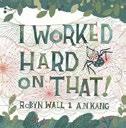
Creating something worthwhile takes time, effort, and patience. Since childhood,
Kids will be saying “Mine!” about this delightful story that really rocks. THIS ROCK IS MINE!
Kiara the spider has spun webs to catch food. Then she sees a web so beautiful that it inspires her to create something similar. Her initial efforts fail, and each time she achieves a breakthrough, another animal accidentally destroys the web. “Hey, I worked hard on that!” she protests. Discouraged, Kiara abandons artistry, then notices that the inspirational web’s gone. Orb, its weaver, suggests that the two collaborate, and the results are lovely. Next morning, hungry Orb breaks the web while grabbing a morsel from it; Kiara refuses to work with Orb again. When Kiara accidentally destroys Paws the squirrel’s “sculpture,” all’s forgiven because, as Paws explains, “I learned a thing or two for my next piece.” Kiara’s never thought about art like that, and she, Paws, and Orb join artistic forces. This thought-provoking story about the nature of creativity is geared more to adult sensibilities; young children are generally more interested in the fun process of making art than in perfecting their craft, as Kiara does. Terms such as dimension and scale and phrases such as “on the cusp of something” won’t be meaningful to youngsters. It’s commendable, however, that expressive Kiara is portrayed determinedly pursuing her passion; she’s also an exemplar of self-confident persistence. The colorful digital illustrations are by turns delicate and lively and incorporate examples of creative typesetting; those intricate webs are spectacular.
Wall weaves a tale that may be too complex for its target audience; still, many youngsters will get caught up in this web. (Picture book. 5-8)

Walton, Julia | Harper/HarperCollins (176 pp.)
$18.99 | Oct. 22, 2024 | 9780063324961

Fifth grader Walter copes with his father’s sudden departure, life with Grandpa, and the challenges of a new school.
“All great moments start with a choice.” The book opens with Walter expounding on this quotation from his father, written in a journal that Walter’s filled with Dad’s words of wisdom. But Walter also directs readers’ attention to Dad’s advice on avoiding constipation—which sets the tone for this candid, reflective, and wildly funny novel. Up until now, Walter’s enjoyed a nomadic existence with his musician father, but for some reason, he can’t accompany Dad on his latest gig and must stay with his reserved, routine-loving grandfather. On his first day at his new school, Walter seizes the opportunity to make new-andimproved announcements over the intercom system. Because this is a performing arts school with an understanding principal, Walter’s catapulted to fame rather than shame. He’s soon cast as the lead in the school production of Willy Wonka and the Chocolate Factory. New friend Filomena provides encouragement as Walter leans into his dad’s advice to “be weird,” “be kind,” and “find the music in life.” Meanwhile, phone calls from Dad prove enigmatic until Walter finally learns the real reason why he’s been gone. Though some supporting characters are one-dimensional, collectively they offer insight into the adolescent experience. The novel skillfully weaves together lighthearted plot threads and more serious issues, including alcoholism, coming to a heartwarming—if somewhat predictable—conclusion. Walter is cued white; there’s some diversity among the cast. Entertaining and wise. (Fiction. 9-11)
Weatherford, Carole Boston | Illus. by Savanna Durr | Abrams Appleseed (40 pp.)
$18.99 | Oct. 1, 2024 | 9781419771484

Weatherford celebrates the achievements of African American men, from Martin Luther King Jr. to Bootsy Collins.
The inspiration for this poetic offering began back in 2009, when 5-year-old Jacob Philadelphia met with then-president Barack Obama in the Oval Office. “I want to know if your hair is like mine,” said Jacob, right before President Obama bowed to allow him to touch his head—an image immortalized by photojournalist Pete Souza. An illustrated depiction of that moment appears in the book, along with scenes of other young Black children finding inspiration in a variety of role models. “I have hair like Obama’s,” the narrator tells us, “and hands like LeBron’s.”
References to other recognizable and potentially lesser-known Black male inventors, athletes, artists, civic leaders, and more are threaded throughout. Writing in verse, Weatherford cleverly riffs on her subjects’ character traits and contributions, welcoming a new generation of readers to discover more about their legacies: “I think up inventions / just like the real McCoy.” “My voice is my instrument / like Trane’s sax and Bootsy’s bass.” (Backmatter explains that Weatherford is referring to engineer Elijah McCoy, jazz saxophonist John Coltrane, and funk musician Bootsy Collins.) Durr’s digital, animation-influenced
illustrations brim with color as children race Usain Bolt, daydream about following in astronaut Guion Bluford’s footsteps, and more. A poetic example of Black male excellence to inspire an emerging generation of readers. (author’s note) (Picture book. 3-6)
Wellerdiek, Jule | Trans. by David Henry Wilson | NorthSouth (32 pp.)
$19.95 | Oct. 8, 2024 | 9780735845572

In this Swiss import, Worm solicits the help of a friend when his beloved hat goes missing. Worm runs a successful lost-and-found office. He’s shocked when he readies himself to leave for work one day and realizes he can’t find his hat. Worm’s unfamiliar with losing things himself, so he calls on best friend Seal for assistance. Worm gets frustrated while searching for the hat, but ultimately Seal’s good advice proves true when the cap eventually turns up. Seal’s threestep process for locating lost items is one that many little readers will find helpful, and Worm’s very real anger at the situation is relatable. Worm himself is a sweet little guy, peach-colored with black rings. He’s anthropomorphized, with red cheeks and a friendly smile, the end of his body serving as a sort of hand as he holds a pencil and types on the computer. Seal is equally darling, donning an apron and stirring pancake batter in an attempt to boost Worm’s spirits. Some illustrations are spread across two pages, while others convey
An effective, relatable depiction of a frustrating and all-too-common experience.
WORM’S LOST & FOUND
action with a series of four panels on a single page—a design choice that keeps the story moving and gives readers plenty to take in. The final page consists of an array of lost objects hidden throughout the book for readers to find. An effective, relatable depiction of a frustrating and all-too-common experience. (Picture book. 4-8)
Wells, Rosemary | Hippo Park/ Astra Books for Young Readers (80 pp.)
$18.99 | Oct. 22, 2024 | 9781662640711

Prolific author and illustrator Wells returns with three stories of kitchen disasters saved by the Little Chefs. In the first tale, when a kitten named Sylvie burns the chicken pot pie she made as a surprise for her mama, she uses the tiny hidden phone in the kitchen to call the Little Chefs, tiny humans, diverse in terms of hair and skin color. They “whip up a supper fit for a queen” before disappearing quickly, leaving a clean kitchen in their wake. The Little Chefs show up in the next two stories to help Leo, a young porcupine who makes a mess while attempting to prepare French toast and raspberry meringue for his father, and then Oscar, a bunny who uses salt instead of sugar while making a cake for his sister, Pearl. The main characters are darling, anthropomorphized animals, reminiscent of characters in Wells’ past work. Each entry begins with a little blurb titled “Little Chefs in History” that offers a related culinary anecdote. The rhyming refrain of the Little Chefs’ call ties all three tales together, though they can also be enjoyed individually. Adults will appreciate the glorious idea of a salvaged meal, and children will delight in the wonder of tiny cooks who visit from a faraway land and disappear without a trace. Pure magic. (Picture book. 4-8)
A poetic example of Black male excellence to inspire an emerging generation of readers.
HAIR LIKE OBAMA’S, HANDS LIKE LEBRON’S
Wheeler, Eliza | Nancy Paulsen Books (40 pp.) $18.99 | Oct. 15, 2024 | 9780593617205

T he woodland creatures of Acorn Village enjoy snowyday activities. Donning comfy clothes and snuggling into nooks, the villagers burrow in for a snow-filled, cold day. They stack firewood, cook stew, bake bread, and knit by the fire. When the snowflakes finally stop falling, everyone tromps outside to play and go ice-skating. As the sun sets, the neighbors come together for a winter feast before heading home to their own warm beds. The book opens with a visual introduction to the heavily anthropomorphized villagers; Wheeler has depicted a variety of family units. The Hopps family of bunnies includes Dad and Pop as patriarchs and little bunnies who vary in terms of fur colors, features, and abilities, while the Chipleys are a single-parent household. The author/illustrator has considered every aspect of a cozy winter day, and Acorn Village is alive with detail. Readers from colder climates will recognize all the best parts of a snow day, while those from warmer climes will feel immersed in all things winter. Some of the illustrations are accompanied by text explaining what the characters are doing; these additions at times feel unnecessary, though they don’t distract from the story. The gentle text matches the mood of the
illustrations. Visual references to Christmas appear throughout, but the holiday isn’t mentioned by name in the text.
A lovely encapsulation of the best parts of winter. (Picture book. 3-6)
Whiting, Ruth | Candlewick (40 pp.)
$18.99 | Oct. 1, 2024 | 9781536226195
Series: Lonely Bird
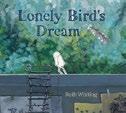
A little bird yearns for more. Last seen in Lonely Bird (2023), the titular character—an avian equivalent of a stick figure—resembles nothing so much as a cut-paper drawing living in a world of thick, realistic oil paints. Little wonder that she can’t figure out where she fits in. Perhaps the sky? But the real birds that can fly have wings that seem entirely different from her own. With pencil-sketched dreams of flight dancing in her head, she sets off to research the many ways of taking to the skies. Drawings and experiments lead to a series of tests.
Lonely Bird builds a glider, tweaking her designs after a precipitous crash before finally attaining a bit of success. Alas, a downdraft causes her to crash in a spiderweb in a tree, her home below appearing comparatively distant. With her plane now crushed, how will she return? This book contains the very rare instance of a realistic-looking spider proving to be a capable friend and ally at a time of need.
THE PIGPEN PROBLEM
Lonely Bird’s final conclusion that “I know exactly where I belong” is heartening, though by no means clear. Her declaration may lead to some thoughtful discussions with young readers about why she feels the way she does. The children who reside in her home present white. This distinctly gentle, earnest protagonist’s quiet triumphs still resonate. (Picture book. 5-7)
Kirkus Star
Wilson, Rachel Michelle | Feiwel & Friends (32 pp.) | $18.99 Oct. 15, 2024 | 9781250910172
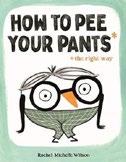
A cartoonish bespectacled owl-like creature provides advice both serious and tongue-in-cheek for coping with a bladder accident at school.
“It can happen when you are sleeping. It can happen when you are in class. It can happen when you are sleeping in class.” These clever sentences show up, respectively, under three comical framed images featuring the protagonist along with other funny, anthropomorphic creatures. Next, Wilson lists reasons people might delay a trip to the bathroom and notes that they may have unsuccessfully tried “scientifically proven methods” to hold it in, including sitting very still and “the grab-and-hold.” A double-page spread with a urine-colored background shows a stain spreading over the
cringing owl’s plaid trousers: “You peed your pants.” After Wilson reassures readers that “we’ve all been there,” the tips begin: “Create a distraction,” “hide the evidence,” and “find new clothes.” Hilarious, largely monochromatic artwork accompanies each suggestion—including the owl trying to wear, among other things, an inverted lampshade. Wilson’s witty, kindly tone will resonate with readers of preschool age and beyond. An image of the humiliated owl, forced by less-than-sympathetic adults to sit on a bubble-wrapped chair while awaiting clean clothes, is paired with a great zinger aimed at said grown-ups. The ending is equally strong—and surprisingly sweet. While other books use humor to downplay the mortification of peeing one’s pants, this one stands out by embracing the embarrassment and using that momentum to remove the stigma.
A number-one hit! (Picture book. 4-7)
The Pigpen Problem: How To Calculate Area and Perimeter
Wise, Bill | Illus. by Davilyn Lynch | Clavis (40 pp.)
$19.95 | Aug. 6, 2024 | 9781605378640
Series: Hilariously Simple Math
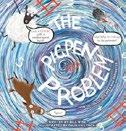
Venture to the barnyard for a lesson in math! Goat, Chicken, and Sheep face an ultimatum from Farmer Ed: Build a pigpen, or forfeit their barn dance. They have 20 feet of fencing, and the pen must enclose the largest possible area. Impatient Goat plans a 20-foot perimeter but hastily hammers together a rectangle
just nine feet by one, “barely big enough for a mouse.” Sheep patiently explains how to calculate the area (“Multiply the length times the width”), but again, Goat jumps into rebuilding without math. Now the pen is eight feet by two. The next rash iteration is three by seven: 21 feet in area. Better, and now Chicken notices a pattern. Sheep presses on with the explanation (“Each time we increase the length by one and decrease the width by one, the area of the rectangle increases”), only to be interrupted by Goat, who tries four by six and then nine by one again. At last Sheep draws the five-by-five plan, yielding the largest area, as all agree—even Farmer Ed, who has one more request, however: a 100-square-foot triangular pen! The final two pages explain perimeter and the area of a rectangle. The jokes are corn-fed, the math clear (though there’s no help with the triangle problem), and the goggle-eyed illustrations are wild, wacky, and amusing.
A practical and entertaining introduction to plane geometry. (Picture book. 7-12)
Witherspoon, Reese | Illus. by Xindi Yan Flamingo Books (40 pp.) | $19.99 | Oct. 15, 2024 | 9780593525159 | Series: Busy Betty

Actor Witherspoon’s latest sees her exuberant young hero returning to celebrate the holidays. Realizing that it’s nearly Christmas, Busy Betty launches into a brainstorming whirlwind; Betty wants to buy the perfect gifts but lacks the necessary funds. Last summer, Betty and best friend Mae had good luck running a lemonade stand, so the kids start a Christmas cookie stand. But chilly temperatures keep prospective customers away even after Betty and Mae sing loud, creative Christmas
carols to get people’s attention and build snowpeople to create the illusion of customers. When Betty’s dog, Frank, accidentally crashes the stand and ruins the beautiful treats, a distraught Betty is sure that “Christmas is ruined!” But upon discovering one intact cookie, Betty has a great idea and dashes to the kitchen to whip up some perfect presents. On Christmas morning, Betty’s homemade gifts are scrumptious and tailor-made for their recipients—a holiday success! Though the story is slightly predictable, Betty’s inimitable voice (“Sweet cinnamon biscuits, it’s Christmas!”) sets it apart; Witherspoon ably captures the emotional extremes that young children often grapple with. Yan’s illustrations effectively portray the steps of Betty’s journey, using a vivid palette of greens and pinks and a dynamic use of perspective to keep wiggly young readers entranced. An appended recipe for cookie bars encourages readers to follow Betty’s worthy example. Busy Betty presents white; Mae is tanskinned with dark hair.
A tasty holiday confection. (Picture book. 4-7)
Wong, Wai Mei | Illus. by Kirsti Beautyman Tilbury House (32 pp.) | $18.99 Sept. 15, 2024 | 9781668945117
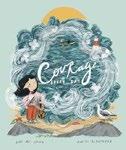
Papa has many answers when a youngster asks, “What is courage?” Tomorrow marks a momentous occasion for an East Asian–presenting child with pale skin and straight black hair: a musical performance in front of a crowd of people. “But there are thousands of butterflies fluttering in my tummy,” the child tells us. White-outlined butterflies surround the youngster. “I believe in you,” Papa says as he hands the protagonist a violin. “Have courage.” But what is courage? Papa catalogs many different
An accident involving a beloved lantern has a young girl hustling for a replacement for Lunar New Year.
AMY WU AND THE LANTERN FESTIVAL
types of bravery, from saving the day to making small but meaningful choices and speaking up for what’s right. Next, the protagonist reflects on “times that I chose not to give up. Times that I said sorry for my mistakes. Times that I shared my feelings.” At last, the child concludes that “I may still feel scared sometimes, but I will remember, I find courage, every day.” Butterflies—now in color—fill the air as the child plays the violin onstage the next day. Wong’s soothing text offers guidance on using self-talk to cope in the face of fear and anxiety. Delicate, charming artwork uses varied compositions and a warm palette to depict this father-and-child duo, while Beautyman’s swirly butterfly motif helps emphasize that courage can be found even in simple, quotidian moments. An author’s note explains to parents and teachers how to help children build resilience in the face of uncertainty.
A sweet, instructive look at everyday bravery. (Picture book. 4-8)
Zhang, Kat | Illus. by Charlene Chua | Simon & Schuster (48 pp.) | $18.99 | Oct. 15, 2024 9781665943109 | Series: Amy Wu

An accident involving a beloved lantern has a young girl of Chinese descent hustling for a replacement for Lunar New Year. The whole house is bustling with preparations for the two-week holiday, and Amy Wu adores it all.
“The food, the decorations…but most of all, Amy loves the traditions!” Tonight is the Lantern Festival. To observe the first full moon of the new year, her family takes out a special lantern belonging to her father. It may look ordinary—a red oval with gold fringe—but her father explains that it helps him remember Amy’s grandmother. But disaster strikes when Amy trips coming out of the attic and smashes the lantern. Despite her father’s reassurance, she and her friends take it upon themselves to fix it. They do their best but can’t get it quite right. A stricken Amy laments that Lantern Night “won’t be the same. It won’t be extra special. It won’t be tradition.”
Zhang’s enthusiastically told narrative comes to a climax as Dad explains that “sometimes traditions change, and that’s okay.” Amy, her family, and her friends, who vary in skin tone, are now fully able to appreciate the evening festivities, complete with lanterns, food, and dragon dances. With dynamic shades and composition and perfectly comedic expressions, Chua’s illustrations shine. Instructions on creating a lantern complete the story.
A sweet holiday venture, laced with important insights into embracing change. (Picture book. 5-8)

For more by Kat Zhang, visit Kirkus online.



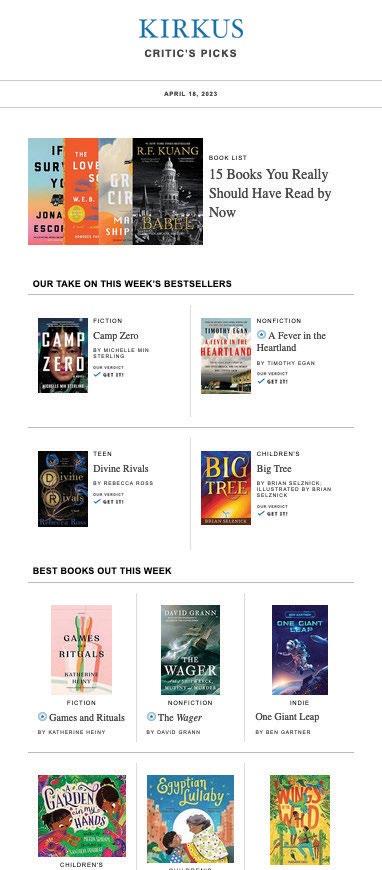



Whether you want to sink into a complex fantasy world, get swept away by a swoon-y romance, or experience the ache of humanity’s struggles, there’s a book to satisfy this season. Alongside exciting debuts, you’ll find established fan favorites—like Lamar Giles, Jason Reynolds, and Sabaa Tahir—who are hitting the shelves with new fall releases.
Kirkus Star
Ali, S.K. | Kokila (544 pp.) | $21.99 Oct. 8, 2024 | 9780593531242

In a socially and physically stratif ied future, political forces seek a marital alliance between Raisa Freelund, daughter of the chief guardian of Upper Earth, and Lein Verg, son of the amir of Lower Earth.
Upon their marriage, Verg and the Alliance Liberté of Independent Guardian Nationals, or ALIGN, will launch the Enlightenment Project, “knitting” the population of Lower Earth into streams of knowledge and the accoutrements of industry, technology, and prosperity while eliminating the Ahraar, whom they regard as destructive “brutes.” The Ahraar conduct strikes against ALIGN and the Verg collaborators’ exploitation of people and resources, while planning a second revolution; their analogue records reveal the consequences of their failed first attempt, and the subsequent mind control of the people of the Bridge. To prevent a future of eternal subjugation and servitude, Ahraar enlists political prisoners Nayf and Nada Verg, the twin grandchildren of the deposed amira, to capture Raisa. To win people over and promote the Enlightenment, ALIGN styles Raisa as the Fledgling, a symbol of freedom foretold by the late amira—but fractures soon reveal unexpected underlying plots. In this duology opener, Ali depicts a richly complex setting through the perspectives of an a rray of politically positioned characters. References to the Islamic lunar calendar and scripture and Arabic naming conventions, as well as clear allusions to present-day geopolitics, conflicts, inequities, and imperialism, lend verisimilitude to a dystopian future of technological and environmental destruction.
A grippingly believable mirror of our own world. (cast of characters) (Dystopian. 13-18)
A grippingly believable mirror of our own world.
Butler, George | Candlewick Studio (168 pp.)
$27.99 | Oct. 1, 2024 | 9781536240436

This work of war reportage presents illustrations, reflections, and interviews with everyday people who were in Ukraine when Russian forces attacked the country in February 2022.
British journalist and artist Butler visited the country in March 2022, only days after the initial invasion; he completed a return trip in the spring of 2023. While he conducted his interviews and observations during a specific time frame, a broader history—as well as ruminations on the human condition and the “circularity of war”—emerge through and within them. The visceral accounts are deeply affecting, mixing stories of trauma and quotidian aspects of life and reflecting their subjects’ varied perspectives—when Butler met them, Volodymyr was 7 and Madame Olga was 99. Butler includes stories of survival, sacrifice, and unspeakable violence, as well as reflections on community care and people’s hopes and dreams and what brings them joy. The subjects and settings are carefully rendered in sparsely colored ink, watercolor, and collage illustrations, offering a loose, unfinished style that befits the ever-evolving stories and conflict. In most instances, a portrait is followed by a write-up offering each subject’s name, age, location, and context about how Butler came to be in contact with them. Many portraits are accompanied by the subject’s own words,
recorded through direct conversations or email exchanges; Butler acknowledges the assistance of “Ukrainian fixers, translators, and drivers.”
A raw and indelible work that presents the experiences, perspectives, and voices of ordinary people. (map, afterword, art notes) (Nonfiction. 12-adult)
Castellanos, Alexis | Bloomsbury (336 pp.)
$19.99 | Sept. 3, 2024 | 9781547613717

A teen enlists help from an unlikely source to make her culinary dreams come true. Rising senior Ana Maria Ybarra loves helping at her family’s Cuban bakery. Her dad wants her to take over the struggling business, but, dreaming of attending pastry school in Paris, she enters a scholarship competition for “Latin American students interested in furthering their food-related education.” Meanwhile, her mom wants her to attend a good college like UCLA, and it’s on a college tour in Los Angeles that Ana Maria meets handsome Cuban American Miguel Fuentes. They share one incredible day—and an unforgettable kiss—before parting, likely for forever. When Miguel suddenly appears at a party in Ana Maria’s small Washington state hometown, they have the same strong connection, but it’s ruined by the revelation that Miguel is a cousin of the Morales family, who run a nearby Cuban bakery that went viral with their dessert burritos. Thanks to a decades-old betrayal, the Ybarras don’t trust the Moraleses. Still, struggling with the social media aspect of the scholarship
contest, Ana Maria secretly accepts help from talented aspiring cinematographer Miguel. Their chemistry is undeniable, but they’ll have to overcome their family feud if they want to be together. This fun, heartwarming story of star-crossed lovers centers on a relatable lead who’s struggling with her family’s expectations and her own desires. Cuban food, culture, and immigration stories are seamlessly woven throughout, enriching the characterization and setting. A sweet and delectable love story. (recipe) (Romance. 12-18)
Cole, Bill | Illus. by Sarah Green Magination/American Psychological Association (144 pp.) | $16.99
Sept. 10, 2024 | 9781433843532
Series: Extraordinary Women in Psychology

A charmingly illustrated biography that highlights psychologist Carol Gilligan’s life and achievements.
Gilligan is famed for her contributions to understanding people’s voices: “how they were used, not used, and even silenced.”
As a young woman involved in the Civil Rights Movement, she pondered why the voices of certain groups, especially women and people of color, were routinely ignored or dismissed by members of various professional fields ranging from law to psychology, education, and medicine. In part through the 1982 publication of her book In a Different Voice, Gilligan established a model of moral decisionmaking and reasoning that she called an Ethic of Care (in contrast to the widely used Ethic of Justice model that privileged traditionally male processes). She also developed a revolutionary interview style she dubbed the Listening Guide Method. Beyond discussing Gilligan’s life and studies, Cole highlights key figures and psychological concepts in the world of psychology,
explaining them in digestible segments. Green’s soft and expressive artwork brings additional life to this easy-to-follow biography. Tools that encourage readers to think more deeply about the content are interspersed throughout the book, providing further learning opportunities. Individual readers and educators alike will find the balance of information, suggested activities, and additional fun facts to be an effective way to learn about this pioneer of inclusivity in psychology.
A straightforward and effective exploration of a remarkable scholar and her influence. (timeline, glossary, further reading, bibliography, photo credits) (Biography. 12-18)
Croucher, Lex | Wednesday Books (352 pp.) $20.00 | Nov. 26, 2024 | 9781250847232

The once-celebrated Merry Men have lost their way in the years since Robin Hood left the cause, making them nearly as feared as the Sheriff of Nottingham. Serious, unflappable Mariel Hartley-Hood has a lot to live up to as Captain of the Merry Men. Her father is Commander Hartley, and she’s the granddaughter of Robin Hood himself. Her ragtag team is on the right track until a botched kidnapping lands her with a very annoying (and distractingly cute) captive: Clemence Causey. Clem is a wisecracking, skilled natural healer from a far corner of the forest. Eventually, Clem’s humor and lightheartedness chip away at Muriel’s stoic exterior, and sharp banter and tender moments stoke a romantic fire between the two. When Mariel learns that her father has been captured by the Sheriff, the Merry Men (and Clem) embark on a rescue mission. Told from Clem’s and Mariel’s alternating third-person perspectives, this queer enemies-to-lovers romp features a cast of racially diverse Merry Men who, of course, are not all men—the gang members use a variety of
pronouns and represent a range of sexualities. Clem and Mariel read white. Croucher peppers their well-paced, witty, and thrilling novel with battle scenes. The story takes as many twists as the winding forest paths and hums with an undercurrent of friendship, honor, and the importance of found family. A captivating, action-packed, queer reimagining of the Robin Hood legend through the sharp eyes of his granddaughter. (Fiction. 14-18)
Donne, Alexa | Random House (352 pp.) $19.99 | Oct. 15, 2024 | 9780593651063
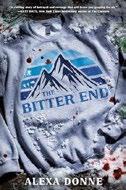
In this closedcircle thriller, a group of teens become stranded on a Colorado mountain during a snowstorm while a killer picks them off. After all their original preferences for the Senior Excursion trips offered by moneyed Warner Prep fall through, a group with a history of bad blood find themselves stuck in a remote cabin with their hard-nosed guidance counselor, Ms. Silva, for an enforced technology-free weekend. The students smuggle in illicit booze, and the very first night, they drug Ms. Silva with Ambien so they can party. By the following morning, someone is dead. A volley of first-person narration alternates among the perspectives of Piper, Willa, and Delaney; third-person interludes focus on each of the other teens—Eden, Camille, Liam, Wyatt, and Declan. The multiple voices make for an intricate setup. Donne also switches the narrative back and forth in time between the present and another night of alcohol- and drug-induced chaos three years earlier—one that resulted in tragedy—further contributing to an unsettled feeling. Many in the large cast of lightly developed characters are image focused, self-involved, and not particularly likable, and this element works in favor of this plot-driven thriller. Readers will be kept guessing until the
end about which of the duplicitous, secretive people in question may be the murderer. Most cast members present white, Liam is cued as having some East Asian ancestry, and Piper is asexual. A twisty whodunit filled with unreliable narrators. (Thriller. 14-18)
Kirkus Star
Egbert, Corey | Farrar, Straus and Giroux (336 pp.) | $25.99 | $17.99 paper | Nov. 19, 2024 9780374308421 | 9780374308391 paper

Illustrator Egbert has drawn on tumultuous childhood memories to craft his first solo graphic novel. Looking back, Corey wonders how much of his childhood was real. His family, who present white, lived in a remote, rural part of California, so his mom was his “teacher…entertainer…and partner in crime.” His dad, though loving, was more distant. Shortly after Corey’s younger sister, Sarah, was born, his maternal grandfather was arrested for child sexual abuse. A couple of years later, Corey’s parents divorced, and his mom, convinced his dad was also a predator, enlisted Corey to be his sister’s protector during court-ordered visitations. Clinging to the family’s shared faith in the Church of Jesus Christ of Latter-day Saints, his mom became increasingly paranoid, eventually loading both kids into the car and taking off. Hungry, filthy, and afraid, the teenage Corey received a nighttime visitation from an ethereal girl who helped repair his fractured heart. The author’s note (which includes family photos) fills in background details, including more about his mother’s paranoid schizophrenia diagnosis. The emotional truth of this narrative rings out on every page. The artwork enhances readers’ understanding of Corey’s confusion about religion, sexuality, family dynamics, and his own memories, drawing the audience toward sympathy and understanding. Egbert’s
softly illustrated panels are primarily executed in muted tones of peach, gray, and brown with clean, uncluttered backgrounds; this soothing palette subtly and skillfully supports the depth of emotion in the story.
Nuanced and real; impressive and valuable. (Graphic memoir. 12-18)
Kirkus Star
Elliott, Victoria Grace | Graphix/ Scholastic (240 pp.) | $15.99 paper Sept. 3, 2024 | 9781338840407

A teen strives for authenticity while battling imposter syndrome in this graphic retelling of The Phantom of the Opera . Eleventh grader Erika Early has just moved from Atlanta to Texas with her family, bringing with her a lot of emotional baggage. Eager for a fresh start, she chooses a striking green blazer from a thrift store to be the focal point of her signature look. When Erika joins the theater group at Gaston Valley High School, she meets Julie Karimi, a white girl with a flair for sarcasm. Julie discovers Erika’s secret crush on good-looking Mexican American Christian Dominguez, and she introduces Erika to him and more of the racially diverse theater kids, including Miguel Hinojosa and Morgan Tsang. Erika and Christian discover a shared love for music and comics; the chapters reference a playlist featured at the end. After Erika writes her play for the school’s One Act Stage Festival, her four new friends become her cast and crew, bringing her closer to her crush. But Erika’s anxiety and obsessive behavior, including a secret she’s desperate to keep hidden, threaten these new bonds. Blue-eyed, auburn-haired Erika’s social anxiety is portrayed as a grayed-out doppelgänger who voices her self-doubts and negative self-talk in black speech bubbles. Erika’s struggles with mental health strike an empathetic chord that will resonate with readers. The clean, inviting
art features varied panel shapes and perspectives and highlights the characters’ emotional expressions. Manga-style art animates this charming story of self-discovery. (Graphic fiction. 14-18)
Giles, Lamar | Scholastic (368 pp.)
$19.99 | Sept. 17, 2024 | 9781338894134
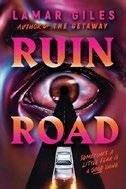
A star football player makes a life-changing wish that comes to haunt him. Kincade Webster III attends high school on an athletic scholarship—he’s one of the few Black students at the exclusive, mostly white Neeson Preparatory Academy in Virginia. With his dad dying of lung cancer, Cade dreams of making it in the NFL so that he’ll be able to support his mom and younger sister. He also wants to someday help his childhood best friend, Booker, and Booker’s sister, Gabby, leave their neighborhood of Jacobs Court. Meanwhile, the school’s football games are frequently being canceled due to anonymous bomb threats. Fearing for his own safety after a white woman on the bus misinterprets Cade’s helpful gesture as criminal and riles up an angry crowd, he flees, ending up hiding from the police in a pawn shop. Following a strange interaction with the eccentric shopkeeper, Cade utters the fateful words, “I wish everyone would stop acting so scared around me,” thus triggering a series of chaotic, otherworldly consequences and leading him to Ruin Road, or “the road between realms.” Giles’ robust descriptions of the setting and nuanced characterization provide this intricately plotted story with incredible depth. Occasional perspective shifts deftly flesh out the landscape of suspenseful supernatural elements, and abhorrent acts of racism bring a
RUIN ROAD
sobering sense of reality to this magic-filled story.
A riveting thriller that seamlessly incorporates powerful social themes.
(Paranormal thriller. 14-18)
Kirkus Star
Immortal Dark
Girma, Tigest | Little, Brown (432 pp.) $19.99 | Sept. 3, 2024 | 9780316581448

An orphaned teenager tries to connect her sister’s disappearance to their family’s decadeslong relationship with vampires.
Nineteen-yearold Kidan Adane wants nothing to do with her family’s horrifying rules and traditions, which stipulate that Kidan and her sister, June, who are Black girls of Ethiopian heritage, must honor soul-binding contracts with dranaics, or vampires. After their parents died, the sisters were placed in foster care with Mama Anoet. For years, Kidan had thought they were safe from evil—until Silia, their maternal aunt, unexpectedly died, and June and Kidan became the last two living members of House Adane. When June is abducted in the middle of the night by an unknown assailant, Kidan traces the clues to Uxlay University, where worthy leaders are taught how to protect a hierarchical society in which humans and vampires harmoniously coexist. Kidan believes that June was taken by Susenyos Sagad, the formidable vampire who’s bound to her family’s bloodline. As she dives deeper into this cruel new world, the line between her hatred of Susenyos and her growing fascination with him begins
to blur. Debut author Girma’s trilogy opener offers a richly detailed, sweepingly imaginative narrative that artfully explores the dark heart of desire, rage, and loss through expansive worldbuilding. Kidan’s powerful characterization is layered, and her journey toward the truth has been crafted with a cinematic eye.
A fresh, arresting entry in the vampire genre that revels in violent, bloody delights. (map, content warning) (Fantasy. 15-adult)
Glasgow, Kathleen | Delacorte (464 pp.) $21.99 | Oct. 1, 2024 | 9780525708087

An unflinching portrayal of the complexities of one teenager’s journey through alcoholism and recovery. Bella took her first drink when she was 11. Now she’s 15, and she and her friends have perfected the art of asking strangers outside liquor stores to buy them booze. It’s the best way to cope with her parents’ fighting, the grief and trauma of watching her beloved grandmother die, acting as a caregiver to her younger sister, and getting dumped by her first boyfriend, who said she was “too much.” A party a few weeks ago led to the drunken mess of a night known as Bella’s Extremely Unfortunate Public Downfall, after which her mom ruled: “no drinking, no parties.” But Bella’s parents are divorced, and when she’s staying with her permissive and inattentive dad, who’ll stop her? After Bella blacks out at a Thanksgiving party and her friends drop her on her mom’s stoop, she ends up hospitalized with alcohol poisoning and a broken face. Her
mom sends her to an outdoorsy rehab center with a program focused on building self-awareness and self-reliance. Bella’s experiences with the program and her fellow residents are depicted with realistic nuance; nothing comes easily, and Glasgow carefully addresses relapses, anxiety disorder, self-harm, and death. After Bella’s treatment ends, she discovers that returning to her life may be the most significant challenge of all. Most characters are cued white.
A visceral, weighty read. (author’s note, resources) (Fiction. 14-18)
Guron, Ravena | Sourcebooks Fire (368 pp.)
$11.99 paper | Sept. 3, 2024 | 9781728296906

Sixteen-yearold Londoner Jesminder Choudhary is horrified when one of her classmates is killed—especially when she finds out that the murder scene was re-created from one of her writing assignments.
When news breaks of Hugh Henry Van Boren’s death, Jess receives a chilling anonymous text: “Thanks for the inspiration. I couldn’t have killed Hugh without you.” Jess, who’s of Indian descent and a scholarship student at Heybuckle School, knows that she would make an easy scapegoat for the outraged parents of her classmates if they discovered the connection with her story. When it appears that the police are unable to properly investigate the crime, and the Van Borens’ private investigator proves incompetent, Jess and her best friend, Clementine-Tangerine Briggs, take matters into their own hands.
Could the killer be Millie CalthropeNewton-Rose, Hugh’s ex-girlfriend who was furious at him for cheating on her? Could it be someone in Jess’ Gifted and Talented class who had easy access to her murder mystery assignment? Or is there a connection between Hugh and the Regia Club, a secret society that wields immense influence at the school? The
book is structured as a retrospective written by Jess, whose reliance on a scholarship heightens her awareness of her wealthier, mostly white, classmates’ privileges and entitlement. She has a sharp sense of humor, which comes through in her sarcastic commentary and well-timed breaking of the fourth wall. The supporting cast includes some queer representation. A proper prep school puzzler. (Mystery. 13-18)
Kirkus Star
Helander, Amanda M. | Disney-Hyperion (352 pp.) | $18.99 | Oct. 8, 2024 9781368096171 | Series: Divine Mortals, 1

The mortal world’s fate hinges on one magical, snarky, introverted teen girl.
Eighteen-yearold Mona Arnett hasn’t left her room in 10 years, preferring its familiarity and the comfort of whiskey due to her debilitating guilt in the wake of the death of her beloved older brother. But Irinorr, the crow god of love, selects Mona, bestowing upon her the power to divine a person’s soul mate and the ability to travel to the Flood, or realm of the gods. When handsome Delmar Whitman, the master of practitioners of magic for King Isaac, calls upon Mona to discern the ailing king’s true love so he can maintain the royal line of succession, she finally leaves home. When Mona divines Isaac’s soul mate, she discovers a shocking answer that she tries to hide from Whitman and new friend and fellow seer Bernadette. The deeper into the palace’s intrigue and politics Mona delves, the more she finds that deceit runs rampant: Not only the future of the monarchy but the fate of the entire mortal world hang in a precarious balance. Debut author Helander’s series opener is finely wrought and intricate in its worldbuilding, populated with characters who are sure to inspire an eager fan base and filled with smoldering
THIEF OF THE HEIGHTS
enemies-to-lovers scenes replete with swoonworthy banter. Fans of Rebecca Yarros and Sarah J. Maas need look no further for their next big read. Mona and Whitman are cued white, and Bernadette reads Black.
Sexy, thrilling, and utterly unputdownable. (dramatis personae) (Fantasy romance. 14-adult)
Kirkus Star
The Unfinished Isaacs, Cheryl | Heartdrum (336 pp.) $19.99 | Sept. 10, 2024 | 9780063287389

In the forest outside Crook’s Falls lies an unnaturally still body of black water that hides—until it’s hungry. Legends say that the pond is connected to the Ragged Man, who lurks in the shadows: “Walk with him, and you don’t come back.” When Avery, a Kanyen’kehá:ka (Mohawk) high school athlete with a white dad, defies warnings and ventures off the trail during a run, she discovers the deep black water that awakens endless nightmares. Sensing an eerie presence, Avery flees but can’t escape the water’s calls. She’s never felt connected to “the culture [that’s] supposed to be mine” and hesitates to seek the truth until the danger becomes undeniable as her nightmares intensify and people begin to disappear. When Key, the boy who’s her best friend and romantic interest, vanishes, Avery seeks guidance from Elders and learns more about the black water and the Ragged Man. In a desperate attempt to save Key and her town, she navigates a
chilling mystery, torn between following wisdom passed down by her Elders and risking everything for love. Against a haunting backdrop, debut novelist Isaacs, who is Kanyen’kehá:ka and white, skillfully portrays a young woman’s struggles with the fallout of having distanced herself from her ancestors, showing how she comes to acknowledge this disconnect—grounded in avoidance of pain and discomfort—and wrestles with the resulting regret.
A harrowing work that combines suspense with a coming-of-age journey of cultural exploration. (Kanyen’kéha glossary, note from Cynthia Leitich Smith) (Supernatural. 13-18)
Jasinska, Alicia | Peachtree Teen (384 pp.) $19.99 | Sept. 10, 2024 | 9781682637364
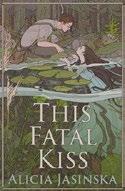
A water nymph and an exorcist form a strange alliance.
Gisela is a rusałka—a girl who’s bound in spirit form to the river where she died. After almost a year of her watery existence, she longs to become human again and return to her family. According to water goblin Wojciech, the rusałki’s protector and father figure, this requires a kiss from a mortal. To local exorcist Kazik, however, Gisela’s love-seeking antics are a constant source of irritation and alarm. He finally captures her, but at the triumphant moment, his powers fade, leaving him unable to exorcise her. Gisela—now in frog form—escapes with the help of Aleksey, a handsome human boy. When exorcist and rusałka cross paths again, Gisela proposes
an accord: If Kazik helps her get the kiss she needs, she’ll stop bothering him. She even has a new romantic fixation on her savior, Aleksey. But Aleksey is Kazik’s crush—and might not be all that he seems. As they plot together, Gisela and Kazik find themselves drawn both to one another and to Aleksey. Lovingly detailed Slavic folklore forms the basis of this gripping fantasy, with particular focus on the water and forest spirits. The mystery of Gisela’s death provides a strong and unsettling undercurrent, helping to up the ante and ground the romantic hijinks. The subversion of a typical love triangle will also delight readers.
Engaging and immersive—a delight from start to finish. (pronunciation guide, content note, resources) (Fantasy. 14-18)
Johnson, George M. | Illus. by Charly Palmer | Farrar, Straus and Giroux (144 pp.) $18.99 | Sept. 24, 2024 | 9780374391249

Johnson, author of the acclaimed memoir All Boys Aren’t Blue (2020), presents profiles of 12 notable queer Black people from the Harlem Renaissance. This work introduces readers to figures including Langston Hughes, Ma Rainey, Zora Neale Hurston, and Countee Cullen. Johnson laments growing up learning about “white heterosexual men” who were presented as “our saviors.” They explain that “as a Black queer child, I had the right to know that Black queer people existed before me.… They paved the road for me to walk on. Yet that road was hidden from me and so many others.” This book shines a light on Black figures from “one of the queerest historical periods,” honoring the legacies of these musicians, artists, and authors and offering their lives as representation for the present generation. Throughout the biographies, mostly about five pages in length, Johnson weaves their own personal narrative, drawing parallels between the
historical figures and society today. These elements frequently contribute additional layers of depth and relatability, as, for example, with their description of the impact of Josephine Baker’s internalized homophobia on her gay son and Claude McKay’s rejection of elitism within Black nationalism. Johnson’s own poems are interspersed throughout, further illustrating their passion for this history. Double-page spreads featuring Palmer’s vibrantly colored portraits open each narrative, adding further life to the subjects.
A sincere and beautifully illustrated ode to queer Black figures who shaped the Harlem Renaissance. (sources/recommended reading) (Nonfiction. 14-18)
M., Son | Illus. by Robin Yao HarperAlley (240 pp.) | $18.99 paper Oct. 22, 2024 | 9780063067325

Moving up could change everything for the better— but for three friends, it could also mean casting aside everything they stand for.
In the vertical city of Muqadas, people’s lives are defined by tiers; quality of life deteriorates as you go deeper. Those in the lowest tier never see the light of day, and a virus called Habar infests their water, causing numbness and often requiring the amputation of limbs. Close friends Mustafa, Basem, and Aarfah are ambitious engineers who dream of making better prosthetics and moving up so they can help change the system. But despite their skills and camaraderie, they’re limited by a lack of resources and Habar’s ubiquity. When an ambassador offers them the chance to leave and run their business in a higher tier, they face a difficult choice: Should they take this opportunity in hopes that it will bring better resources to their people, or stay put and continue the work they’ve been
doing to help their community? This story, which features an ethnically diverse cast in a world infused with North African and Islamic cultural elements, as well as meaningful queer and disabled representation, explores complex themes around inequality paired with compelling art. The thoughtful imagery pushes the narrative beyond the text. Yao’s use of light, particularly the striking color palette of teal and orange, brilliantly captures the contrasts between Muqadas’ different levels.
Introspective and insightful, with eclectic characters who burst through the narrative. (Graphic science fiction. 12-18)
Moore, C.G. | Little Island (208 pp.)
$12.99 paper | Sept. 10, 2024 | 9781915071538

In the wake of a life-altering night, a gay teen in the British Isles fights for survival, closure, and justice. Jay Walker awakens in a park covered in blood and bruises; he was drugged and raped, but shadows cloak his memory of what happened. He and his boyfriend, Jackson, were at the club. Why did Jackson leave him? Why won’t he answer Jay’s messages? “Stats help me understand,” Jay says in his first-person verse narrative, but they offer the grim likelihood that someone he knows was responsible. Still, these numbers are only “maybes and possibilities”: Jay needs to know the truth. Confused by his boyfriend’s behavior, he goes to Jackson’s house, where he finds evidence that leads to even more questions—a Mac and a Rolex. How could a boy with a struggling single mum afford these expensive items? The poems’ short lines capture the fragmented nature of Jay’s memories and the frantic frustration of his feelings. As Jay recovers physically, his parents and his best friend, Lau, surround him with support, but Jay feels out of place in his old life. He grapples with fear, shame, self-doubt, questions of identity, and his understanding of love. Therapy







RANDY RIBAY
Author of Everything We Never Had
FORMER ENGLISH TEACHER and award-winning YA novelist Randy Ribay is back with Everything We Never Had (Kokila, Aug. 27). As Kirkus’ critic put it (see p. 161), this stirring work explores “struggles with identity against the backdrop of changes in American society” even as it offers “deep insights into intergenerational patterns.” Ribay answered our questions by email; his responses have been lightly edited for length and clarity.
The dreaded elevator pitch: What, briefly, do you tell people your latest book is about?
Everything We Never Had is a historical fiction YA novel about father-and-son relationships across four generations of a Filipino American family. Through intertwined timelines, you see each character at the age of 16 at a pivotal moment in their life and in history. Or: YA Filipino American Pachinko, except one-third the length.
What inspired you during the writing of Everything We Never Had ? What were you reading, listening to, watching?
I first got the idea for the story after my son was born. Like most new parents, I began to think a lot about how I was raised. What did I want to keep? What did I want to leave behind? What did I still need to heal from? Thinking through those

questions made me wonder how my own father might have answer ed them, which made me think of how his father might have, and so on.
I reread some of my favorite short texts to study how they crafted such emotionally poignant stories with so few words: Jean Toomer’s Cane, Sandra Cisneros’ The House on Mango Street, Justin Torres’ We the Animals, and Jacqueline Woodson’s Red at the Bone. I think I was watching Gilmore Girls and Pachinko —among many other shows—and I was listening to Klassy’s new album, Good Seeds, as I revised.
Where and when did you write the book? Describe the scene, the time of day, or any necessary accoutrements. I have very little memory of any of this. I was still a full-time classroom teacher, and my son was a toddler. I wrote whenever and wherever I could. There was probably a lot of coffee involved.
What was the most challenging part of writing this book? And the most rewarding?
The answer to both is the research. It’s my first attempt at historical fiction, and I was never a stellar history student. But my YA historical fiction writer friend Stacey Lee gave me some advice: I hired a research assistant, I traveled to many of the places I was writing about, and I connected with organizations like the Tobera Project and Watsonville is in


the Heart, who gave me access to their digital archives.
What books releasing this fall are you personally most eager to get your hands on?
So many. When the World Tips Over by Jandy Nelson. Pick the Lock by A.S. King. Twenty-Four Seconds From Now… by Jason Reynolds. Sunderworld: The Extraordinary Disappointments of Leopold Berry by Ransom Riggs. Onyx & Beyond by Amber McBride. The Bletchley Riddle by Ruta Sepetys and Steve Sheinkin. To name a few. I’ve also already had the privilege to read Heir by Sabaa Tahir and Midnights With You by Clare Osongco, and I can’t wait for readers to discover those stories.
Interview by Laura Simeon.
and a support group play important roles in his journey toward confronting what happened and discovering how to keep living. Most characters are cued white. A survivor’s story portrayed with honest heaviness and caring vulnerability. (author’s note, resources) (Verse fiction. 14-18)
Moore, John | Illus. by Neetols Flying Eye Books (192 pp.) | $19.99 paper Oct. 1, 2024 | 9781838741556
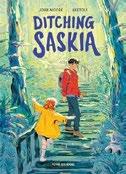
A shy teenager rejected by his father and a nosy 9-year-old ghost untangle a complicated web of lies.
Damian, a teen of Filipino descent who lives with Lolo, his grandfather, is the quiet new kid at a school where having the best story can earn you friends and popularity. So, when Damian accidentally summons Saskia, the spirit of a little girl who died after becoming lost in the woods, he invents a story to explain why he didn’t use his rare, precious Spirit Flower to be reunited with his mom, who died when he was 4—he says someone stole it. When persistent classmate Meghan interviews Damian for the student paper, his robbery story evolves into ever-bigger lies. Meghan also posts a video fabricating lies that misrepresent Saskia, much to her rage. Damian grapples with grief, his complicated memories of his mom, and mounting scrutiny and pressure to tell the truth. Meanwhile, his crush on his friend Elijah grows into something more. The delicate and expressive illustrations are executed in shades of gray, black, and navy; the gold accents of
the Spirit Flower signify its value in bringing back those who have passed. The quirky character dynamics create a sense of comic relief amid the emotional intensity. Saskia and Meghan read white, and Elijah is cued Korean. The story leaves unanswered plot points that suggest a sequel.
Intriguing supernatural elements grounded by genuine expressions of friendship and understanding. (Graphic paranormal. 13-17)
Pinede, Nadine | Candlewick (432 pp.) $19.99 | Dec. 3, 2024 | 9781536235661

Sixteen-year-old Lucille comes of age in 1930s Haiti. Following the death of her mother during childbirth, Lucille has been cared for by her woodworker father and maternal aunt. Lucille can hear the sacred mapou trees sing, although a teacher chides: “The Church or the spirits, / you can’t serve them both.” Lucille and best friend Fifina dream of opening their own school for girls, one that centers nature and creativity, but ongoing conflict in Haiti poses an obstacle. When Fifina vanishes, Lucille learns she’s been taken by the section chief as his second wife. Then, the section chief cuts down Lucille’s favorite mapou tree, and she confronts him. Fearing for her safety, Papa and Tante Lila send her to Port-au-Prince. As a servant to a wealthy Haitian family, Lucille takes steps toward adulthood; she also falls for her employer’s son and is sent away again, becoming a servant to
charismatic American writer Zora Neale Hurston. Lucille learns that activism comes with sacrifice—and even mortal danger. The book’s slow pace demands patience from readers, and the resolution feels rushed, but Pinede’s beautifully written debut sharply observes class divisions and encourages readers to ask critical questions about dignity. Lucille’s optimism is rooted in the purpose she derives from loved ones and a cultural inheritance that values nature over material wealth. The well-drawn characters, strong dialogue, and surprising twists add depth.
A rich, lyrical story that shows the high cost young women pay for daring to dream of a better life. (historical notes, bibliography, sources) (Verse historical fiction. 13-18)
Pink, Randi | Feiwel & Friends (352 pp.) $20.99 | Oct. 15, 2024 | 9781250820372

The Great Dismal Swamp is ready to unearth family secrets. In 1722, Babylou Mac, nearly 19, killed the preacher’s son right after he murdered her mother. With the owner of the plantation where the family was enslaved in pursuit, she and her siblings fled into the magic of the Great Dismal Swamp, a wild and dangerous place that offered death and salvation in turn. In modern times, Atlas returns to her grandmother Grannylou’s home for the Bornday celebration: She and three cousins, all born on Grannylou’s birthday, are turning 19. Atlas worries that Grannylou’s age is catching up to her; she speaks of impossible, magical things, including having lived for hundreds of years. Grannylou, in turn, sees in Atlas a beacon for the lost souls, “guided by the promises of our ancestors” and seeking a paradise hidden in the swamp—but she also warns against letting the wrong people in. When
Grannylou decides to return to the swamp, the cousins must unravel the secrets of the Isle of Floriate, which “has been a refuge of necessity” that blesses those “brave enough to reach its shores.” They must also guard against old enemies with grudges against their family. Poetic language, lush descriptions, and characters so conflicted and nuanced as to feel real anchor the magical elements, while the cousins untangle centuries of heartbreaks and horrors inflicted by cruel white enslavers to learn where they came from and the gifts they’ve inherited. A fierce, loving, and exquisite humanity-centered book. (author’s note, sources) (Fantasy. 13-adult)
Kirkus Star
Reynolds, Jason | Caitlyn Dlouhy/ Atheneum (256 pp.) | $19.99 Oct. 8, 2024 | 9781665961271

Two high school seniors anticipate a big change in their relationship.
Neon Benton and Aria Wright have been a couple for two years. They’re planning to take a huge step in their relationship, and while they have a plan, Neon is battling a serious case of nerves. Fortunately, he’s close to his older sister, Nat, and leans on her for advice. He also finds himself reflecting on the journey that led the two of them to this moment— readers learn of Neon’s close ties with his no-nonsense mother, his affectionate, hardworking dad, and his grandmother (who’s still grieving the death of his grandfather). Aria’s family life is a bit more complicated, since she’s the only nonmusical household member, and her relationship with her mother is somewhat strained. Amid family, school, and yearbook club, moving toward more physical intimacy takes center stage for the Black teens. The fact that Aria will be heading away for college while Neon stays home to earn money for film school is
another factor. Setting aside anticipation and apprehension, the couple have a bond that is clearly of paramount importance to them. This rich, tender story captures the range of emotions surrounding emerging love and what they mean in the lives of young people. Neon narrates with clarity, sensitivity, and humor. The wonderfully developed cast of characters (both adults and teens), lively language, and the clever flashbacks contribute to the freshness of the storytelling.
A warm, heartfelt, and fully engaging portrayal of teen love. (Romance. 14-18)
|
(288 pp.) $18.99 | Aug. 27, 2024 | 9780593461419

Explores the relationships among four generations of Filipino American boys and men. In 1929, 16-year-old Francisco Maghabol immigrates from Ilocos Sur in the Philippines to California, lured by the promise of riches. Instead, he ends up doing grueling agricultural work for a dollar a day and faces violent racism. In 1965, Emil studies hard, hoping to attend college and make it in America, unlike his absent father, Francisco. Determined to escape his father’s divisive reputation for organizing strikes for Filipino workers, Emil attempts to assimilate. In Colorado in 1983, Chris wants to play football, but his controlling, grades-focused dad, Emil, forces him off the team.
A school history assignment and a Filipino classmate make Chris realize he wants to learn about the culture his father has erased. In 2020, Enzo, Chris’ son, has just started managing his anxiety—but thanks to the spreading pandemic, Lolo Emil, the grandfather none of them like, comes to live with them in Philadelphia, causing tension. Told in alternating viewpoints, this strongly characterized novel covers the
boys’ struggles with identity against the backdrop of changes in American society. The many heartwarming and heartbreaking moments offer deep insights into intergenerational patterns and how one’s life experiences and upbringing affect parenting and relationships. Ribay weaves historical events in the U.S. and the Philippines and Filipino cultural elements into the story, showing their impact on the Filipino diaspora. A powerful and moving family saga. (family tree, author’s note, resources) (Fiction. 12-18)
Rogers, Andrea L. | Levine Querido (400 pp.)
$19.99 | Oct. 8, 2024 | 9781646143788

In the mid-21st century, a Texas teen tries to plan for the future, while around her, people struggle with extreme weather cycles and other threats. Stevie, a member of the Cherokee Nation, is working in a museum gift shop and saving for college. She has healthy relationships with her family (although her parents are “fighting about the end of the world”), and she spends her free time developing her photography skills. One day, a new interning artist piques her interest: Adam says he’s Indigenous from Costa Rica but doesn’t offer any more information, leading Stevie to wonder if he’s lying. But when she presses him, Adam says he’s a time traveler from 2201, 150 years in the future, and that he needs her help stealing an important piece of art for him to save because her “world is about to implode.” The story’s strong pacing allows ample room to explore multiple themes, including people who pretend to be Indigenous, exploitation of people and natural resources, museums’ retention of sacred ceremonial items, climate change and environmental devastation, and pandemics. Stevie is a complex character who’s dealing with anxiety. Her adoptive father is Black, and her younger brother,
Levi, is Black Cherokee; their identities offer room for Rogers to naturally explore racism both from white people and between marginalized communities. Stevie’s closest friends bring additional diversity to the cast and help ground Stevie, offering her different perspectives on the world.
Presents sharp social commentary folded into an all-too-believable dystopian setting. (Dystopian. 12-18)
Seitz, Crystal | McElderry (416 pp.) $19.99 | Oct. 1, 2024 | 9781665959926

A Swedish girl must venture into the heart of ancient legends when her beloved grandmother disappears. After Amma vanishes into the forest that’s home to the Hidden Folk, 17-year-old Astrid Skarsgård leaves Stockholm for the small village of her childhood. While searching for clues, Astrid finds a note from Amma telling her to follow the path into the Tiveden forest beyond the stave church, a place shunned by locals. Astrid’s skeptical of her grandmother’s folktales, but her disbelief is shattered when she finds a hidden cellar in Amma’s house containing a sleeping draugr, or undead creature, named Soren. After accidentally waking Soren, she learns he’s the lover of Skaga, her distant foremother who imprisoned him there. Soren wants to find Skaga and break the blood oath that’s destroying Tiveden, and together they journey into the forest, where they encounter nightmarish creatures and undead ancestors, growing closer as they face dangers. Through visions of Skaga,
Astrid learns of her village’s violent history and realizes she’s a pawn in an age-old war between villagers and the Hidden Folk, forcing her to choose between love and family. Debut author Seitz intersperses passages narrated by Skaga into Astrid’s first-person account, weaving an impressive backstory deeply rooted in pagan beliefs. Astrid’s story expertly conveys her pain as she unravels her family’s secrets and her own destiny. Astrid is immunocompromised and has Crohn’s disease.
A bloody love letter to Norse mythology. (author’s note with content warning and link to pronunciation guide) (Dark fantasy. 14-adult)
Heir
Tahir, Sabaa | Putnam (496 pp.)
$21.99 | Oct. 1, 2024 | 9780593616949

Th ree young people find their places in a world of vengeance and destiny in National Book Award winner Tahir’s duology opener set in the multicultural world of her
An Ember in the Ashes series.
Aiz, from the impoverished nation of Kegar, seeks revenge against Tiral bet-Hiwa, an air squadron commander who, as a child, murdered Aiz’s fellow orphans. Guided by a voice claiming to be Mother Div, Kegar’s first queen, Aiz escapes imprisonment after her failed assassination attempt on Tiral and embarks on a journey to free Mother Div’s trapped spirit. In the Martial Empire, Sirsha, a skilled tracker with magical abilities who’s been banished from her homeland, is saved by a stranger who hires her to hunt an unnatural killer.
Quil, the crown prince of the Martial Empire, faces an invasion by the Kegari and the lingering threat of a mysterious force responsible for recent murders, including those of two of his loved ones. As the storylines converge, Sirsha and Quil cross paths, leading to revelations about the insidious force. The story explores the blurred line between good and evil and the lengths one will go to for a better life. Tahir’s deep and intricate worldbuilding requires time for readers to fully grasp. Following a slow start, the plot engages as pieces fall into place, leading up to an unexpected ending. The beautiful writing compensates for the romantic relationships, which develop quickly and somewhat inorganically. A fantasy with complex characterization that will build anticipation for the next entry. (Fantasy. 14-18)
Vidal, Juan | Holiday House (336 pp.) $18.99 | Sept. 3, 2024 | 9780823457113

In Vidal’s YA debut, a grieving teen takes his father’s ashes on a healing journey to Colombia. Marcos Cadena’s life turns upside down when Papi unexpectedly dies in a motorcycle accident. On top of that, Marcos’ closest friends leave Miami the summer before junior year of high school, and he struggles to cope with his grief. But resourceful, athletic Marcos soon finds solace in writing poetry and in the magical realism he finds in his father’s old copy of One Hundred Years of Solitude by Gabriel García Márquez. Márquez lived in Cartagena, the city where Papi was born. Composed in verse, Marcos’ story is warmly studded with memories of his loving dad—from the way Papi danced while he cooked to how he taught Marcos never to start a fight but to always defend himself. When Ma takes Marcos and his sister to Cartagena to pay a final tribute to his dad, Marcos
meets Camilo, a teen cab driver with a tragic past who shares his affinity for Nobel laureate Márquez. The boys become fast friends, exploring Cartagena and shooting hoops together—until a dark secret that Camilo initially hides from Marcos threatens their newfound bond, potentially putting both boys in danger. A responsible son, protective older brother, and caring friend, sensitive Marcos will win readers’ hearts as he tries to navigate the complexities of both mourning and friendship with forgiveness and compassion. Heartfelt, moving, and beautifully written. (Verse fiction. 14-18)
Wajid, Andaleeb | Duckbill (272 pp.) $12.99 paper | Sept. 10, 2024 | 9780143463689

Seventeen-year-old Abir Maqsood, a Muslim girl from Bangalore, India, has her life all planned out. She hopes to ace her exams, study software engineering, and make her own life choices. Her conservative, working-class parents, keen to get her married off, think otherwise. When Abir’s mother, a part-time bridal henna artist, is cheated out of her full compensation, a seething Abir ensures the clients pay up. This success inspires her to want to continue helping her mother—and after Abir hears about an incubation program competition, she dreams up a henna service app for booking and prepayment. Executing this plan involves teaming up with her friend Keerthi, her crush, Sahil, and the annoying class Casanova, Arsalan. As the group presses on with an app prototype, Abir finds herself caught in a web of changing feelings, deception, lies—and her parents’ wishes. The fast-paced story skillfully tackles issues of class, societal constraints, and first brushes with romance with spirit and humor. Abir’s strength of conviction and belief in her abilities make her a likable, well-defined character. The writing paints a realistic
and relatable portrait of barriers that girls from conservative families must deal with. Though the enemies-to-lovers trope is continually underscored, the book posits many thoughtful questions about societal restrictions and shows there is room for grace in shifting one’s perspective about oneself and others. A delightfully inspiring story that champions loving yourself.
(Romance. 13-18)
White, Andrew Joseph
Peachtree Teen (416 pp.) | $19.99
Sept. 3, 2024 | 9781682636121

A n autistic, transgender teen seeks justice as a 100-year-old feud threatens his family and anyone who associates with them.
In 1917, the sheriff of Twist Creek County executed a man named Saint Abernathy, leader of the coal miners’ strike, by hammering a railroad spike through his mouth. A century later, the mines have closed, but Miles, as an Abernathy, is caught up in the cycle of oppression and violent vengeance that killed his great-great-grandfather Saint. On the night of the annual high school graduation party, Miles hits send on an email telling his parents he’s trans and then sneaks out of the house with photos stolen from his father’s lockbox—photos offering proof that Sheriff Davies caused the “accident” that killed Miles’ former best friend Cooper’s mother five years ago. Before Cooper and Miles can decide on their next steps, the feud is reignited, and neither of them can outrun the flames. White captures violence with vivid and lethal precision. Set in rural West Virginia in 2017, this tremendously suspenseful, queer coming-of-age thriller confronts the impact of economic injustice, local political corruption, and generational trauma. As Miles fights for himself and his family, he’s haunted
by the ghost of Saint Abernathy. His struggle to understand his ancestor parallels his journey to understand and accept himself. The cast of white characters includes representation of those who are marginalized for being fat, disabled, and queer and living with disfigurement. The hopeful, satisfying ending emerges from community collaboration. Unflinching and empowering. (Thriller. 14-18)
Wolf, Ryan | West 44 Books (200 pp.)
$25.80 | Dec. 1, 2024 | 9781978597440
Series: West 44 YA Verse

On the cusp of his senior year, one high school boy spends a summer both mourning and honoring life and, in the process, discovering new facets of himself. One day, Dustin is planning to spend an epic summer in Japan with his baseball team, playing the sport he loves more than anything. The next, he’s at the funeral of his 20-year-old cousin, a college baseball player with an undetected heart condition. There, Dustin meets Andrea, and despite his negative first impressions, they grow close. In the coming months, Dustin and Andrea attend several more funerals together, leaning on one another as they navigate the deceased people’s different ends. A constant undercurrent in this story of loss is how Dustin’s life as a baseball player and the culture of the sport influence the way he engages with the world. This verse novel for reluctant readers doubles as a love letter to baseball—a game that, like life and death, connects people. The beauty in Wolf’s word choices and in his poems’ line breaks creates an emotional tone that beckons to readers, inviting them to reflect on their own mortality and place in the world. Song titles make up the titles of the poems, inviting readers on a musical journey. Major characters present white. A lyrical and sweet coming-of-age story. (Verse fiction. 12-18)
Scan the QR Code to listen now:
New episode every Tuesday





GEORGE M. JOHNSON
Author of Flamboyants
THIS FALL, George M. Johnson, author of the New York Times bestseller All Boys Aren’t Blue and We Are Not Broken , offers a heartfelt paean to queer heroes of the Harlem Renaissance. In Flamboyants: The Queer Harlem Renaissance I Wish I’d Known (Farrar, Straus and Giroux, Sept. 24), they seamlessly weave personal narrative and poetry into profiles of 12 outstanding writers, artists, and activists—including Langston Hughes, Countee Cullen, Bessie Smith, and Zora Neale Hurston—with illustrated portraits by Charly Palmer. Kirkus calls Flamboyants a “sincere and beautifully illustrated ode to queer Black figures who shaped the Harlem Renaissance.” (See p. 157 for the full review.) Johnson answered some questions by email; our exchange has been edited for length and clarity.
What made Flamboyants the right title for this book?
I wanted a title that was just as powerful as the figures profiled. All of the figures were stars in their own right, and they carried such flare and power in their work. I wanted to find a word or phrase that described them and that they encompassed. I looked at these figures like they were the “Avengers,” a group that separately held their own stories while collectively changing culture and the world. So I call them The Flamboyants.
What were some of the pleasures
and challenges of bringing their stories to the page?

The pleasures were learning about how complex their lives were. They weren’t monolithic in thought, and each added their own special thing to the era. As a kid, I only knew of them through their accolades, so it was amazing to learn about their actual lives and just how similar many of them were to us and how we navigate life today. The challenge I had for some was that there isn’t a lot of information about them, so it made the research really important. The other challenge was that some of them lived really hard lives and died in poverty—very sad endings for such important people. However, I’m grateful that I get to share their stories.
If you could choose one of the remarkable people you profile to be your artistic mentor, who would it be and why?
It would probably be Langston Hughes. He was really like the glue of the Renaissance. He knew everyone and collaborated with so many individuals. He also chronicled the period in a beautiful way. He is the reason we have many of the stories from the era. It reminds me of the work I do to ensure our stories of today get told and aren’t forgotten. His writing is also very whimsical at times, which is a style I tend to write in. He also seemed like he was a good time to be around.


Flamboyants: The Queer Harlem Renaissance I Wish I’d Known Johnson, George M.; illus. by Charly Palmer
Farrar, Straus and Giroux | 144 pp. | $18.99 Sept. 24, 2024 | 9780374391249
How do you plan to celebrate publication day, Sept. 24?
I’ll probably be on tour, but it will most likely be with my family. I enjoy celebrating my wins with them.
What fall release are you most looking forward to?
I’m looking forward to Shadowed by Carl Deuker.
What’s the last great book you read?
The Bluest Eye by Toni Morrison. I read it a lot.
Interview by Megan Labrise.
FROM INTRIGUING DEBUTS to new books from beloved favorites, this fall brings a whole host of must-reads. Here are six particularly compelling YA titles.
This Book Kills by Ravena Guron (Sourcebooks Fire, Sept. 3): A boarding school is the ideal setting for a murder mystery: the intensity of the students’ relationships and the small circle of potential suspects help ratchet up the tension. With this story that’s begging for a screen adaptation, London lawyer Guron immediately grabs readers with drily hilarious protagonist Jess Choudhary


and the intriguing circumstances in which she finds herself suspected of killing a classmate.
A Second Chance on Earth by Juan Vidal (Holiday House, Sept. 3): Journalist and critic Vidal explored masculinity and fatherhood in his memoir, Rap Dad . His young readers’ debut, written in hypnotic, propulsive verse, follows Marcos, who’s grieving for his father. Returning Papi’s ashes to Cartagena, Colombia, offers the Miami 16-year-old an opportunity to deepen his understanding of himself and his dad. “I’m


told / the old stories / live on inside me. / Run like rivers / through my veins, / even if I don’t have / a father around / to tell me / any new ones.”
Ukraine: Remember Also Me: Testimonies From the War by George Butler (Candlewick Studio, Oct. 1): As the Russian onslaught in Ukraine enters its third year, Butler, an artist and journalist who has traveled to many scenes of conflict and disaster around the world, offers poignant personal accounts of the war from its survivors. His spare, delicate illustrations have a haunting quality— portraits that capture the interviewees’ personalities, and scenes of daily life that add to the emotional impact of the narratives.


The Glass Girl by Kathleen Glasgow (Delacorte, Oct. 1): Glasgow is a critically acclaimed author of works that honestly address subjects such as self-harm and opioid addiction; her books have also gone viral on BookTok. The latest deals with the crisis of teen alcohol abuse: Bella’s raw first-person narration shows how she uses drinking to cope with overwhelming emotional pressures. The 15-year-old’s journey through rehab offers readers hope without sugarcoating the real challenges of her situation.

From Now. . .: A LOVE Story by Jason Reynolds (Caitlyn Dlouhy/Atheneum, Oct. 8): Prolific and versatile Reynolds, a living legend in young readers’ literature, has written an endearingly frank and hilariously sweet story about head-over-heels young love and the anticipation and terror of a first sexual encounter. Neon and Aria have a solid relationship, and they’ve prepared carefully for this special moment—but none of that can quell Neon’s nerves. His conversational, disarmingly honest narration animates this stellar work.
Under the Heron’s Light by Randi Pink (Feiwel & Friends, Oct. 15): Pink brings her magical touch and passion for telling stories rooted in U.S. history to this enchanting novel that spans centuries and celebrates the power of family and endurance. In 1722, after taking revenge on her mother’s murderer, Babylou fled enslavement and retreated with her siblings into the Great Dismal Swamp. Now Atlas, who’s grown up listening to her Grannylou’s colorful tales, is ready to uncover long-hidden secrets.
Laura Simeon is a young readers’ editor.
A teenager who sells memories for a living gets tangled up in a risky assignment while being tracked by the authorities. Eighteen-year-old Liv Newman works for LifeCorp, a company that manufactures and sells “everything from toothbrushes to televisions—the goods that keep the entire Metro going.” She’s an EmoProxy—someone who’s been mechanically modified to sell memories, or Scraps, and enhance the productivity of wealthy Uppers in a futuristic Boston. Liv, who’s cued Black, is from the Lowers, a community built by the residents whose labor keeps the Metro running
but who are unable to reap the benefits of their work. When she’s offered a lucrative job in the dangerous Outerlands, far beyond the surveilled city, she must figure out how to survive until payday. Before venturing on her mysterious assignment, Liv meets rookie Forceman Adrian Rao, a loyal, young, brown-skinned officer also employed by LifeCorp, which he credits with saving his life after he was left in the Metro by his Outerlands raider family. Their serendipitous meeting takes them on an adventure during which they test their limits as their feelings toward each other evolve, a

journey narrated in their alternating voices. Tew’s fantastic contribution to the genre is full of heart. Themes such as class, labor, and ethics lie at the center of the story, which also features plenty of action,
contributing to the enjoyable pacing. Fans of writers such as N.K. Jemisin and Octavia Butler are in for a treat. A gutsy debut that will leave readers wanting more. (map) (Dystopian romance. 12-adult)
Aldridge, Ben | Holler/Quarto (176 pp.)
$12.99 | Sept. 3, 2024 | 9780711297807

A self-help guide to happiness that strives to make philosophy relevant to modern teens.
Aldridge mines the lessons of ancient Greek and Asian philosophy for wisdom, describing wisdom that’s focused not on boundless euphoria but on eudaemonia, or “living a good life,” which is achieved through honing resilience and character, embracing balance, and accepting life’s vicissitudes. Along the way, he explores Zen, Cynicism, Socratism, Taoism, Stoicism, Aristotelianism, and Buddhism, showing how these philosophies can help improve critical thinking, well-being, decision-making, resilience, self-discipline, and relationships. Anecdotes explain how these ideas helped Aldridge deal with his own severe anxiety. Each chapter concludes with challenges: for example, the Banana Walk, a therapeutic exercise created by Albert Ellis (who was inspired by Diogenes), which involves walking a banana tied to a piece of string in public as a way of becoming desensitized to fears of judgment. Unfortunately, perhaps due to the impossibility of accurately condensing multiple complex schools of thought in such a short space, the book often oversimplifies philosophical lessons in ways that misrepresent the underlying concepts and promote stereotypes. For example, Taoism feels reduced to spending time in nature, learning to go with the flow, and heeding your gut instinct (a “subtle art that is often neglected in Western culture”). Despite these weaknesses, the book’s overall message—that happiness might best be found in moderation and restraint—is instructive and conveyed in an accessible, conversational style. A well-intentioned but underwhelming
mishmash of philosophical tidbits and stereotypes. (reading recommendations, resources) (Nonfiction. 12-18)
Ameyaw, Maya | Annick Press (320 pp.)
$19.99 | Oct. 8, 2024 | 9781773218632
Series: When It All Syncs Up, 2

A teen musician’s life changes overnight when his original song goes viral on YouTube. When the “Indigenous indie pop rock artist” Jesse Jacobs reposts his video, Ollie, a Canadian boy who has Algerian, Libyan, and French ancestry, is swept into a meeting with music executives who offer him a record deal and a spot on Jesse’s upcoming tour. Touring would mean missing most of senior year, but the advance could help support Ollie’s family after his father’s job loss. Other hurdles include Ollie’s anxiety disorder and the deeply personal inspiration behind his viral song. Ollie’s close friends and girlfriend, Aisha, encourage him to follow the opportunity and help him embrace his bisexuality, which he hasn’t yet widely disclosed. Ollie, who’s nearly 18, is devoted to Aisha, but he can’t deny his attraction to 19-year-old Jesse as they bond on the road. Jesse and Ollie’s backstage banter offers nuanced discussions of identity, vulnerability, and the pressures of fame. Ollie manages his anxiety with a realistic combination of medication, therapy, and meditation. The novel includes a steamy, slow-burn romance and multidimensional characters while deftly tackling tough topics. Featuring familiar faces from Ameyaw’s debut, When It All Syncs Up (2023), Ollie’s story stands alone. Jesse belongs to the Squamish Nation, and Ollie’s group of friends is realistically diverse in race, sexuality, and gender identity. From behind the scenes to center stage, readers will cheer for a young man as he explores authenticity through music. (content note) (Fiction. 14-18)
Anta, Julio | Illus. by Jacoby Salcedo Colors by Francesco Segala | DC (208 pp.)
$16.99 paper | Oct. 1, 2024 | 9781779522825

A Blue Beetle origin tale that tackles the fraught discourse over immigration at the MexicoU.S. border. Once again, the border has been shut down and the National Guard deployed along the Rio Grande. Anti-immigration flyers around town have also escalated tensions in El Paso, Texas. High school student and avid astronomer Jaime Reyes would much rather stargaze—but he learns that an old friend who’s fallen out of touch has inexplicably gotten involved with an online white nationalist movement called the Legion of Patriots. Jaime decides to join his activist friends’ efforts to unearth the hate group’s violent plan of action. Complicating matters, after he finds a mysterious scarab, Jaime has meetings in his dreams with an ambassador of the Reach, a race of aliens claiming to help “destabilized planets.” The scarab, it turns out, grants heroic powers to the Mexican American teen. As the conflict between immigrant rights activists and white nationalists worsens, Jaime must also keep his El Paso community safe from the incoming Reach, whose true intentions aren’t altogether clear. This well-timed superhero outing unpacks thorny topics—online extremism, radical activism, climate change— from an earnest, almost utopian angle, reinforcing a belief in community as a method of resistance from threats both internal and external. This adventure unfortunately wraps up too swiftly. The action-oriented artwork in shades of vibrant blues and burnt oranges leverages panoramic perspectives with aplomb. A riveting start to a superhero saga. (Graphic fiction. 13-17)
Beiko kits out her stagestruck teen with an easily relatable desire to shine.
THE DOOR IN LAKE MALLION
Arnold, Marie | Little, Brown (224 pp.)
$18.99 | Oct. 15, 2024 | 9780316568005
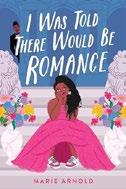
A teen’s life goes topsy-turvy thanks to secrets, lies, and a romantic bargain with a crush. Falencia “Fancy” Augustine is a 15-year-old Black girl of Haitian descent. Fancy doesn’t do well with change and also has issues with focusing, which have resulted in her falling behind in several classes. She generally feels like an outcast except when she’s with her best friend, Tilly Fischer. When Fancy learns that Tilly has kept secrets from her—she has a new boyfriend and was invited to the exclusive birthday party of Imani Parker, the most popular girl in school—she’s thrown off kilter. The threat of being sent to Haiti if her grades don’t improve also hangs over her head (“‘vacation Haiti’ and ‘sent-back Haiti’ are two very different things”). Anxiety attacks, fast-spreading “Voodoo witch” rumors, and impulsive decisions lead Fancy to agree to a deal with Imani: She can come to the party; she just needs to show up with a boyfriend. Fancy persuades Rahim Robinson, her crush, to fake date her in exchange for a potion. But how will she untangle this complicated web? Arnold’s multidimensional lead organically pulls readers into the story: Fancy is flawed, self-aware, and charming, and her open and direct nature and often-humorous delivery are appealing. This novel also thoughtfully explores themes of friendship,
romance, identity, and body image. Most cast members are Black. A refreshingly vulnerable and candid protagonist cements this story’s appeal. (Romance. 12-17)
Beiko, S.M. | ECW Press (312 pp.) | $17.95 paper | Oct. 8, 2024 | 9781770416963
Series: The Brindlewatch Quintet, 2
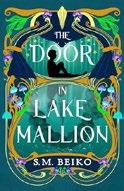
A frustrated young thespian discovers an alien civilization that runs on mushrooms and musical theater in this second series entry. Fifteen-year-old Dunstan Cord’s bright dreams have only slightly been dimmed by juvenile macular degeneration and a disruptive streak that’s kept him out of the limelight in his lakeshore town of Knockum. But he finds himself a singular sensation after treacherous heartthrob Moss Richler (an A-lister with “teeth for miles”) throws him overboard into the deep waters of Lake Mallion. Instead of drowning, Dunstan, who presents white, winds up in the large subterranean Geodom of Jet—where the reptilian residents are lit, fed, and housed by fungi that are powered by mysterious green Meteorlight, which is keyed to charismatic public performers called Truffledours. In no time, Dunstan is onstage, his imagination, “a thing alive that always ran away with him attached…cracked open, pouring out over the audience.” Unfortunately, while also making a flashy connection with Jet’s scaly, taily,
totally kissable Prince Ven, he discovers a threat to Knockum and potentially all of Brindlewatch. The language is rich in references to stagecraft, and Beiko kits out her stagestruck teen with an easily relatable desire to shine, an eminently breakable heart as big as his personality, and a notably diverse queer supporting cast. By the end, hearts are mending and the threat is diverted, if only in what feels like a temporary way. A hot ticket, chockablock with memorable performances. (Fantasy. 13-18)
Bello, Abiola | Soho Teen (336 pp.)
$19.99 | Oct. 1, 2024 | 9781641296106

A city girl and a country boy strike a deal to help each other out with their relationship woes. Nigerian British Tia Solanké thought life was going well. But then her boyfriend, Mike, who’s Black and Indian, asked her for “space,” and her mum announced a surprise two-week winter holiday at a country house. They’d be away from London during Mike’s 18th-birthday party, which Tia planned and sees as her one shot to save her relationship. Meanwhile, 18-year-old Quincy Parker is reeling from betrayal—his best friend and now-ex-girlfriend slept together. Perhaps that’s why he panics and lies about having a date to their small market town’s storied Winter Ball, which for the first time will be hosted by a Black family—his. When the Solankés arrive at the Parkers’ luxurious Georgian farm property, neither teen is impressed by the other, but they nevertheless soon make a deal: Tia will fake date Quincy so his ex will see that he’s moved on, and in turn, Quincy will help Tia sneak out to Mike’s party for a few hours. It’s a perfect plan—until their feelings become real. This charming, straightforward romance with a little added drama will appeal to Hallmark fans. Quincy, Tia, and their siblings feel like fully formed characters,
and the portrayal of Tia’s blended family is particularly heartwarming. Though the ending feels abrupt, the story appealingly incorporates popular romance tropes. A sweet Christmas love story. (Romance. 13-17)
Birdseye, Tom | Groundwood (280 pp.)
$17.99 paper | Oct. 1, 2024 | 9781773069548

Tragedy, emotional conflicts, and uncertain prospects dog a teenager on the cusp of independence. Birdseye constructs this outdoorsy outing around multiple metaphors, most notably that of a jigsaw puzzle, pieces of which fall down around 17-year-old Ren at a rate that threatens to bury him. Fleeing from his widowed, obnoxiously born-again mom to take refuge in the Cascade Range in Oregon with beloved big brother Levi doesn’t provide the security he hoped for. First, Levi dies tragically in an avalanche. Then Levi’s traumatized girlfriend, Ellie, disappears, leaving behind an alarming note after sliding into Ren’s bed for a night of ecstatic comfort. And just for a kicker, amid the resulting turmoil, the devastated teen manages to lose both of his part-time jobs. The title aptly conveys Ren’s gnawing fear and confusion, which readers will feel keenly as he frantically chases after Ellie while undertaking the understandably painful process of fitting the various parts of his life together into a recognizable self-image and a tentative personal road map. Some seemingly fragmentary pieces come together to help resolve unanswered questions, especially after a dramatic climax leads to sudden revelations and clarity. Better yet, at the end, the author leaves Ren credibly on his feet and moving forward. Main characters are cued white. An unusually raw, frank bildungsroman. (Fiction. 14-18)
Blum, Isaac | Philomel (304 pp.)
$19.99 | Oct. 15, 2024 | 9780593525852

Yocheved “Yoyo” Gold is a good Orthodox Jewish girl. She proudly does the family’s grocery shopping, the weekly Shabbos cooking, and even looks after her two younger brothers. When her closest friend, Esti, is suddenly put on a plane to attend boarding school in Las Vegas after kissing boys and breaking the laws of kashrut, Yoyo feels blindsided, depressed, and betrayed. She misses sharing absolutely everything with her best friend and only confidant. While she’s volunteering with Jewish Hunger Relief, Yoyo is paired for meal delivery with Mickey, who has a white dad and a Korean and white mom who’s a rabbi at a Reform synagogue. Through her, Yoyo is introduced to different ways of being Jewish. She soon decides to get the filter on her smartphone removed and turns to TikTok for comfort. As she attempts to navigate her sheltered upbringing on the outskirts of Philadelphia and the intoxicating world of social media, Yoyo confronts new situations and difficult decisions. Through her new friendship and a budding forbidden romance with Shua, her friend Chani’s older brother, Yoyo discovers more about herself and the role she wants to play within her family and the Orthodox Jewish community. The book’s well-written short chapters and fast-paced, first-person narrative will keep readers glued to the pages. Yoyo’s voice is compelling, and both she and her
observant family are portrayed positively and respectfully. Blum’s fans won’t be disappointed. A kosher coming-of-age story with a bissel of romance. (Fiction. 14-18)
Boucher, Marianne | Emanata (152 pp.)
$20.00 paper | Oct. 22, 2024 | 9781772621044

An anti-colonialist tale that’s also a love letter to the natural world. The story unfolds on a rocky, isolated island where necessity and ingenuity have led to the creation of Kerpathics, messengers who make the dangerous trek between two villages separated by a waterfall. Sable has trained for a decade with her dad to become a Kerpathic, and she knows the island like the back of her hand. She’s counting on Blade, her goat best friend, to help her rescue lost travelers and bring people “news, medicine, and food.” But even though Sable saves a child during her first solo mission, she learns that her work comes with real risks. Meanwhile, on the mainland, people have heard rumors about the island. Naturalist Antone Krill and ship’s captain Smith take advantage of the king’s support for expeditions and set sail in search of the “distant island where they spin gold.” Krill is obsessed with naming a new species and views wildlife behavior through his biased understanding of power dynamics; he clearly wants to hunt and trap unusual species. When the foolish, arrogant men arrive, the villagers are welcoming, and Sable gets roped into being their guide. Still, the forest is a dangerous place, especially for those who don’t respect it.
Embraces a message of living harmoniously with all creatures.
SURVIVAL OF THE GOODEST
Boucher’s dynamic, original illustration style contains sharp angles that convey energy. The compelling story, illustrated in grayscale art, embraces a message of living harmoniously with all creatures. Characters present white. Enjoyable and rich in themes and execution. (Graphic adventure. 12-18)
Brittan, Leyla | Holiday House (304 pp.)
$19.99 | Oct. 1, 2024 | 9780823457137

A teen carries out a plan she devised years before for social climbing.
Rosaline Demir has long yearned to go to Pine Bay, a pricey resort in Maine where many of the kids from her high school in Connecticut vacation. So she makes sure to get invited to join her best friend Eleanor’s family when they finally go there. Eleanor is straightforward and kind. Ros is myopically focused on her dream of meeting a hot guy so she’ll have a better chance in her run for homecoming princess. It’s initially hard to like Ros as she makes excuses for things she does that hurt her friend, but a compelling backstory involving an earlier best friendship that soured will soften readers’ feelings toward her. Ros’ experience of her mixed heritage—her dad is from Türkiye, and her mother is Scottish American—have left her feeling an outsider in her “super-white town,” lending her further vulnerability and explaining her need for validation. Though Ros succeeds in acquiring a lovely boyfriend, Aydin, whose parents are also Turkish, her plans go awry upon their return to school, resulting in an unexpected and satisfying conclusion. Diversity in the supporting cast rounds out this ode to self-awareness: Ros’ friend Ben, who’s gay, and Chloe, who’s also biracial (Korean and white) but has a different social experience from Ros. Ben and Eleanor are cued white. An engaging story with a rightfully complex protagonist. (Fiction. 13-18)
THE WITCH'S THRONE
Caballes, Cedric | Andrews McMeel
Publishing (368 pp.) | $15.99 paper
Aug. 20, 2024 | 9781524892463
Series: The Witch's Throne, 3

A series built on battles is ready to go all out for its tournament arc.
Are you ready to rumble? Reksha the Breaker is, with her bout in the Citadel’s tournament matching her against a massive, armored foe. It’s the first of several fights in this third volume, all of them serving flashy, hyperkinetic attacks that returning fans will have come to expect by now. As familiar as characters like Reksha, Grom, and Agni may seem, this book shows that they still have mysteries yet to be uncovered. Flashbacks reveal motives and revelations, usually at the most dramatic possible moment, so that both sides of each lethal matchup end up being sympathetic to some degree. Agni, who serves as the heart of the story, searches for a way to win the tournament without having to kill anyone. There’s still plenty of room for humor, such as in the running gag of tournament advertisements (“Have stray harpies taken roost on your roof? Get rid of them now with the help of…”) that hide an important detail in plain sight. Gaming logic continues to apply, from job types to hit points and damage totals that actually matter in combat. Caballes is more than inspired by shōnen manga and fantasy game tropes; they are his tools to twist and subvert, and he’s using them to build a series that’s worth following. Fun action scenes with compelling characters and tragic consequences make for a thrilling fantasy brawler. (Graphic fantasy. 14-17)
Conner, Hari | HarperAlley (288 pp.)
$18.99 paper | Oct. 8, 2024 | 9780358682387

Two best friends resist their feelings for each other in Surrey, England, in 1807. Cousins Eleanor and Charlotte are close to their dear friend, George. Although society expects proper young ladies to find a nice gentleman to marry as soon as they are of age, that fate feels unreasonable for these three. Eleanor, who has no plans to ever marry, intends to care for her ailing, widowed father. Black biracial Charlotte’s white father was disinherited; Ellie’s parents took their niece in, but her race and lack of a fortune are obstacles. And, although they were proclaimed to be a girl at birth, that label doesn’t fit the way George feels; rather than seeking a husband, they prefer to help run the estate and dress in masculine clothing. The trio’s trip to London unearths previously unacknowledged issues: George’s gender expression, the unspoken love between Eleanor and George, and Charlotte’s feelings of being unwelcome in high society, as well as her refusal to be “a curiosity or exotic accessory.” The resulting tension forces them to come to an understanding that will forever affect their relationships. Inspired by Jane Austen’s novels and their own research, Conner’s work features beautiful, detailed illustrations that bring Georgian-era England to life. These lovable, witty characters explore identity in nuanced ways and show what’s possible when you are true to yourself.
A queer love story that’s perfect for fans of slow-burn historical romance. (historical notes, resources, author’s note, sketches) (Graphic historical romance. 13-18)
Craig, Erin A. | Delacorte (512 pp.)
$20.99 | Sept. 24, 2024 | 9780593482582
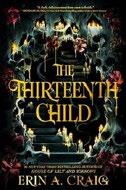
“Godfather Death,” a lesser-known Brothers Grimm fairy tale, gets a gothic update in Craig’s latest stand-alone fantasy.
Hazel Lafitte’s birth doesn’t feel like a gift to her parents, who already struggle to support their 12 other children. But to everyone else, a 13th child is a rare and intriguing thing, and Hazel is promised to the Dreaded End, the god of death, whom she will come to know as Merrick. Merrick plans for Hazel to become a gifted healer and bestows upon her the surname Trépas. For many lonely years, she studies medicine in isolation. She also learns that she’s as cursed as she is gifted. Hazel sees many cures in visions, but sometimes she instead perceives a skull—or deathshead—that commands her to kill her patient. When the king falls ill with a mysterious plaguelike illness, Hazel is summoned to find a cure. As she grows close to the king’s family, she questions her talents, sees deathsheads she can’t accept, and encounters other gods who are pulling strings. There are glimmers of a fascinating world here, though shallow characterization lessens the impact of Hazel’s dilemmas and decisions. The opening scene will appeal to fans of Margaret Owen’s Little Thieves, and while readers expecting similar depth may be disappointed, the haunting atmosphere and worldbuilding details have wide appeal. Most characters read white; Merrick has “deep obsidian skin.” An intriguingly conceptualized story that struggles to create a compelling cast of characters. (Fantasy. 12-18)

Dahlin, Nicola | Kids Can (400 pp.)
$19.99 | Oct. 1, 2024 | 9781525311475

After a dramatic brush with death, twin brothers from small-town Alberta flee home, sent by their parents on a flight to Scotland.
Fifteen-year-olds Cameron and Lewis Larsen are overwhelmed with fear and uncertainty after their parents kill two strangers to protect them—and then send them away. They make an uneasy trek to the home of Margaret “Maggs” Ross in Edinburgh, where they begin to search for answers while still trying to maintain cover. Following their dad’s advice—he warned that identical twins are memorable—the boys interact separately with Maggs’ neighbors as well as the visitors staying at her guesthouse. They appear one at a time and pretend they’re a single person named Will, which results in some funny situations. Some of these people—including fellow teens Aisha, Ruby, and Jamie—also become enmeshed in the mystery, and a sprawling, intricate backstory unfolds involving mobsters, MI6, secret passwords, art heists, underground tunnels, and more. While at times the story can feel a bit overstuffed, the first-person narration, which alternates between the brothers, works well to ground the novel: Lewis’ nervous internal monologues contrast with Cameron’s more self-assured but still vulnerable voice. The abrupt ending leaves things wide open for a sequel. Most central characters present white. Brownskinned Aisha wears hijab, and there’s additional diversity among the supporting cast. Lewis is bisexual.
An expansive thriller with two likable characters at its heart. (Thriller. 12-17)
Doyle, Catherine | McElderry (512 pp.)
$21.99 | Oct. 1, 2024 | 9781665955119
Series: City of Fantome, 1

A forbidden attraction and explosive secrets set a city aflame. Eighteen-year-old Seraphine Marchant’s mother manufactures Shade, a dust sourced from the boneshade plant that’s imbued with the power to manipulate shadows. Shade magic is used by the rival guilds that rule the city of Fantome’s underworld— Cloaks swathed in Shade-infused garments blend into the shadows to commit thievery while Daggers ingest it and acquire the ability to kill with a single touch. When her mother is murdered, Seraphine flees from the countryside to Fantome, seeking sanctuary among the Cloaks. But she’s the Daggers’ newest mark, tailed by talented Ransom. The two are recklessly drawn to one another as a new danger emerges from the darkness and surprising discoveries upend the rules of Shade and shadows. The lush worldbuilding of cobblestones, catacombs, and saints includes a richly crafted history that’s deftly introduced and ripe for continued exploration in the next installment. While the first third of the novel is well paced and tenderly developed, the quality of the remainder is uneven. The juvenile, innuendo-filled taunts lack charisma, although the more sincere exchanges and reflections achieve sultry depths. The repetitive overuse of
For another folklore-inspired fantasy, visit Kirkus online.
An atmospheric tale of the magic of wishes—and the darkness of betrayal.
expletives becomes tiresome, cheapening the dialogue. A steamy encounter that lacks verbal consent and contains power dynamic–coded language feels reminiscent of romances written for adults. Main characters are cued white; the strong supporting characters add racial diversity and elevate the narrative development. A promising series opener that’s sure to please adult readers of young adult novels. (map, character list) (Fantasy. 16-adult)
Ellor, Z.R. | Roaring Brook Press (352 pp.) $20.99 | Oct. 15, 2024 | 9781250866998

A vindictive brother, a cursed kingdom, a Rat King, and a nutcracker… With one of their mothers dead and the other in Kolzechnia, the Rat King’s country of beastfolk, Drakne Zolkedna and her two brothers, Fydir and Nabik, are left to fend for themselves in Malirmatvi. As Fydir rises through the military ranks, Drakne, at the prompting of the Rat King, who knows about her dancing magic and sends her letters, finds new purpose dancing on factory floors to free the people trapped within the soul-engines of Fydir’s patron’s creation. This act of magical rebellion pits Drakne first against Fydir, who seeks to use her, and, soon enough, against Nabik, who hasn’t been able to keep her safe. As Drakne draws closer to the Rat King, Nabik, at the side of a nutcracker with claims to the throne, wrestles with loyalty to his family and the pull of his burgeoning wizardly powers. The siblings struggle with their darker impulses and deepest desires amid peppermint and gingerbread, swirling snowflakes and blazing guns. This queer retelling of The Nutcracker maintains the ballet’s ambience while expanding on and changing elements of the tale to include a land of beastfolk and snowfae standing on the precipice of
technological advancement that in the wrong hands brings only suffering. Characters are cued white. Drakne is pansexual, and Nabik is gay. An atmospheric tale of the magic of wishes and dances—and the darkness of betrayal and pain. (content warning, map) (Fantasy. 14-18)
Ed. by Fan, Mary | Illus. by Various | Snowy Wings Publishing (396 pp.) | $18.99 paper Sept. 17, 2024 | 9781958051801

Mysterious and magical, colorful and captivating: The circus entices, entertains, and enthralls and serves as the inspiration for this anthology. This collection of short fiction spans genres from realistic and historical fiction to fantasy and science fiction. Whether they are set in our world or beyond our universe, all the stories center around a circus-themed narrative. Beginning with a foreword by circus educator Hovey Burgess, the volume’s 14 entries each appear with an accompanying full-page illustration. The collection as a whole is well thought out, but with the exception of editor Fan’s own captivating stories—“On Moonlit Wings,” “A Special Theory of a Circus,” and “Flyer, Flyer”—most of the narratives will not engage a wider audience. A few of the tales, such as “The Shadow Menagerie” by Karissa Laurel and “Walking an Emotional Tightrope” by Amy Bearce, present characters from the authors’ full-length novels and may be appealing to existing fans who wish to continue the adventures begun in other works, but the stories themselves leave something to be desired. Unfortunately, many of the other entries feature underdeveloped characters and lackluster plotlines that end somewhat abruptly. Despite the uneven execution, circus enthusiasts will recognize this collection as a love letter to the source of its inspiration and appreciate the authors’
showcasing of the love and dedication of circus performers and the allure of the big top.
A collection of short stories that isn’t as exciting as its subject. (Anthology. 14-18)
Ferraro, David | Page Street (400 pp.)
$18.99 | Oct. 8, 2024 | 9798890030726

A vampire-turnedhuman vies for the hand of a future duke.
After Count Lucian Cross is driven from his castle by vampire hunters, Vrykolakas, the god of vampires, turns him back into a human as part of a revenge plot. In his mortal form, Lucian, who’s cued white, can compete in the “marriage games” and court the future duke, all the while secretly sussing out which of the noteworthy families of the men and women also in the competition have connections to the monster hunters. If he’s successful in his tasks, Lucian will be rewarded with the return of his immortality—and more power than ever. Being human brings a slew of emotions that Lucian didn’t foresee, though, and he finds himself making friends, regretting past actions, and developing unexpected romantic feelings. Propelled by unfolding mysteries and shifting alliances, this story gets off to a slow start as Ferraro introduces the large cast, which is diverse in race and sexual orientation, and sets the scene. Patient readers are rewarded in the latter half, however, when the action and drama amp up. In the world of this story, which is set in England during a time reminiscent of the Regency era, racism and homophobia are nonexistent, allowing the tension to focus on the clash between humans and monsters. The side characters are mostly forgettable, but Lucian is a captivating romantic hero. Despite some unevenness, an enticing and satisfying blend of genres.
(Paranormal. 13-18)
Galadima, Issaka | Illus. by Frederick L. Jones | Rockport Publishers (224 pp.)
$13.99 paper | Sept. 10, 2024
9780760389232 | Series: Saturday AM TANKS / Clock Striker, 2

In this second series entry, Cast’s STRIKER journey continues as she focuses on desperately trying to save her friend. Cast and her SMITH mentor, Philomena Clock, set out for the Kingdom of Alter hoping to find and rescue Klaus, who’s been kidnapped by a group of Demon Bandits at the behest of the king. The king of Alter, who’s feared by his subjects, possesses powerful thermoelectric crystal technology despite his denouncing many technological advances. Cast and Philomena have their work cut out for them, not least because other SMITH engineer warriors are in turn on the hunt for them. Cast finds it strange that in the Kingdom of Alter the residents share all their possessions. Even more surprising, she meets members of the Miner’s Syndicate, a resistance group protesting the hazardous work conditions of the kingdom’s crystal mining industry, who regard her as their savior due to her connection to Klaus. They hope that Klaus will bring needed reforms. This volume brings new characters, both enemies and allies, into the mix as Cast and Philomena find themselves caught up in plots that raise the stakes. The action scenes, political scheming, humor, and heartwarming and heart-wrenching moments will keep the pages turning. The detailed illustrations immerse readers in a story that centers on an appealing
Black girl hero and explores themes of social class divisions and rebellion against social hierarchies.
A worthy sequel that will keep readers intrigued and engaged. (Manga. 13-16)
Gomez, Halli | Jolly Fish Press (160 pp.)
$9.99 paper | $28.50 PLB | Aug. 1, 2024 9781631638459 | 9781631638442 PLB
Series: Horizon
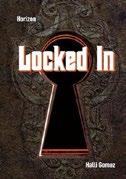
A mysterious puppet master tests an unlikely combination of North Carolina teens by locking them in a room together. When a new escape room located in a half-empty mall puts out a call for testers, four teens apply: Tony Wells’ ambitious parents are pushing him to enhance his leadership skills, Bea Gonzalez loves puzzles and hopes to someday be a business owner running an escape room, Devin King ran away from his foster home and needs the offered compensation of $100, and Anna Blum wants some extra spending money for an upcoming trip to New York. The young people don’t know that they’ve been chosen by a man who wants to do an experiment by putting four very different people together and seeing how they’ll react. The shadowy figure manipulates the game, incorporating notes designed to unsettle and confuse the players, which in turn leads them to reveal secrets they’ve been keeping and to confront serious issues in their lives, including racism, social anxiety, parental loss, and unexamined privilege. Each member of the group changes as a result of the
An excoriating critique of the systemic squashing of girls’ voices and desires.
experience, causing real shifts in their lives. Reluctant readers will be engaged by the personal dynamics and the real-life issues explored in this accessible novel that feels like The Breakfast Club with an escape-room setting. Tony is white, Bea is cued Latine, Devin is Black, and Anna is Jewish. Puzzles, friendship, and personal growth form the backdrop of this intriguing story. (Fiction. 12-18)
Gritz, Ona | West 44 Books (200 pp.)
$25.80 PLB | Oct. 1, 2024 | 9781978597419
Series: West 44 YA Verse
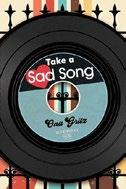
A grieving teen finds sanctuary in a home for “wayward” girls. Set in 1970, this accessible work confronts the consequences of the Wayward Minor Act through poems that even reluctant readers will find riveting. Grieving the death of her father, Jane Flynn is out partying with friends on her fifteenth birthday when police officers show up, explaining that her mother has reported her missing. Bewildered Jane arrives at Spofford, “a maximum-security prison for children” in the Bronx, where she’s bullied and beaten by another girl. Her mom appears before the judge, trying to bring Jane home, but her original worries about keeping her daughter safe are used to justify continued incarceration. Jane is transported to the New York State Training School for Girls, where she meets the Racket, a group of girls who form a secret chosen family within the devastating system. Beatles fan Jane adopts the moniker Jude and develops feelings for the equally broken Jo-Jo. She also meets Miss Coleman, the first adult since her father’s death who listens to her. As Jane grows more comfortable with Miss Coleman, she risks exposing the Racket: With the Stonewall uprising a recent memory, can this adult be
trusted? Gritz presents an excoriating critique of the systemic squashing of girls’ voices and the silencing of their desires and curiosity. Jane is cued white, and there’s diversity in race and sexuality in the supporting cast.
A thoughtful must-read that explores grueling attempts to destroy girls’ spirits. (author’s note, playlist, sources) (Verse historical fiction. 13-18)
Houck, Colleen | Blackstone (350 pp.)
$19.99 | Sept. 10, 2024 | 9798212221696
Series: Tiger’s Tale, 1

Houck kicks off a new story arc in the world of the Tiger’s Curse series with new tigers who live in a northerly setting. The death of their widowed royal mother touches off a crisis in the Kievian Empire; neither Stacia nor Verusha Stepanov, 17-year-old sword-wielding twin sisters, wants to be named tsarina. But questions of succession get put on hold when a battle with a sorcerer inexplicably turns the two into nonspeaking Siberian tigers. Hints of a cure send them, along with a growing entourage of men to provide assistance (and, perforce, do all the talking), on a long trek. Though most of the cast sticks to genre type, Houck throws in a wild card in the form of hunky, inarticulate Nikolai, who joins the quest because he is enthralled by Verusha—and who also killed his whole family in an act of revenge. Occasional anachronistic dialogue (e.g., “Are you ready, ladies?”) disrupts the tale’s generally earnest tone, as do the clumsy attempts at banter. A third tiger, snarky and blind but conveniently able to see through others’ eyes, trots in late in the story. The events in this setup volume unfold with many a flashback and change in point of view and head toward no sort of resolution—only the cave-dwelling White Shaman of the Tundra’s advice that further journeys are in the offing. The central cast in this
Russian-inspired fantasy world presents white; the Indigenous population includes nomadic reindeer herders. Returning fans, anyway, will pounce. (Fantasy. 13-16)
Howard, A.G. | Bloomsbury (400 pp.)
$19.99 | Sept. 17, 2024 | 9781547608126

Twin sisters navigate life after a magical adventure in 2022’s Shades of Rust and Ruin . Lark, previously believed dead, has returned to Astoria, Oregon, to pick up her life, although to do so she must impersonate her twin sister, Nix. Meanwhile, alternate chapters follow Nix, who’s now the Architect and savior of Mystiquiel, the faerie land where Lark lived, loved, and broke everything. Neither sister is entirely sympathetic, particularly angry, embittered Lark, who seems intent upon blaming others, especially Nix, for the consequences of her own choices. Meanwhile, in Mystiquiel, Nix negotiates her longing for Clarey, who was once Lark’s boyfriend and is now Nix’s love. She learns that Lark betrayed her, even as she revels in exploring her creativity as she remakes the faerie world according to her artistic vision. Things are complicated. The rivalry between Goblin King Perish and Scourge, his wicked brother, adds an active plotline to the largely emotional, often-internal happenings. Overwrought similes, word choices that sometimes obscure meaning, and largely indistinguishable character voices do nothing to elevate this lavishly described but thinly plotted tale. Readers who persevered through the first volume will appreciate the neatly resolved conclusion that hurdles seemingly insurmountable odds thanks to love and magic. Of the human characters, Lark and Nix are cued white, while Clarey presents Black. Sadly, there’s little magic here. (Fantasy. 12-16)
Kim, Hyun Sook & Ryan Estrada | Illus. by Ryan Estrada | Colors by Amanda Lafrenais Penguin Workshop (208 pp.) | $24.99 Oct. 1, 2024 | 9780593521298

A college student in 1984 South Korea addresses the personal and political in this graphic novel drawn from author Kim’s life. Hyun Sook joins fellow members of Anjeon University’s folk-dance club—a group that performs satirical, sometimes subversive, works—on a winter break hiking trip to the mountains. She packs the copy of Erich Fromm’s The Art of Loving that club director Hoon gave her, describing it as a work of “socialist philosophy.” She and Hoon were in a club that read banned books, but they’ve been extra careful ever since a friend was imprisoned after being caught with a history of communism. Although the authoritarian political conditions are improving, Hyun Sook is aware of the cost of dissent. Starting another book club would be dangerous, but she hopes to teach others about the rights they’ve lost. Enjoying the getaway while surreptitiously continuing her political education isn’t easy. The bright, cheerfully cartoonlike drawings contrast with the serious topics, echoing the students’ balancing act as they pursue ordinary interests, such as romance, while protesting the dictatorship. The storyline introduces many characters and subplots that would have benefited from greater explication; Hyun Sook at times gets lost amid the clamor. Nevertheless, small details—a girl being harassed by police for wearing a too-short skirt, students cautiously walking to school past menacing troops in riot gear—authentically evoke the stark realities of the era.
A vivid if overstuffed portrayal of life under a dictatorship that educates and informs. (Graphic fiction. 12-18)
OLD WOUNDS
Kirchmeier, K.D. | Bloomsbury (368 pp.)
$19.99 | Oct. 15, 2024 | 9781547615445

Two teenagers are determined to stop monsters from wiping out humanity. The blitz, short for blitzesser (or lightning eaters in German), are dragonlike creatures with strong electromagnetic fields. They caused a major blackout and have terrorized humans into hiding. Sixteen-year-old Cassie lives in a forest camp with other survivors, relying on her strong intuition to keep her safe from the blitz. Miles away on the prairie, 16-year-old Thomas, left alone after his dad’s death and armed with a book on mythical creatures, hitches a ride west with Danica, a truck driver who’s determined to bring hope to survivors. When the teens’ paths cross, their destinies become closely intertwined. To stop the blitz from eliminating the people who remain, they’ll have to deal with enemies both human and otherwise. Magic abounds in this post-apocalyptic tale of an otherworldly invasion. Kirchmeier draws on folklore and legend to populate the world with mythical beings from various cultures. Themes of destiny, dreams, and intuition round out a well-paced story of survival. The worldbuilding is excellent when it comes to the mythical creatures, but weaker when depicting the human beings who are left on a battle-scarred continent, and some interesting scenarios, such as a cult of religious scavengers, would have benefited from more robust descriptions. Most characters are cued white.
A dark look at a post-apocalyptic, magic-filled world. (Dark fantasy. 13-17)
Kisner, Logan-Ashley | Delacorte (336 pp.) $19.99 | Sept. 10, 2024 | 9780593814741

W hile on the run, two transgender teens face darkness—both human and inhuman—in the backwoods of Kentucky. Max and Erin, California-bound teens who are cued white, each have their own reasons for running away. Max, a trans boy, is crumbling under the weight of a family that denies his true identity. Erin, a trans girl, feels lost and insecure despite the acceptance she receives from her mother and sister. When Max finally decides to bid farewell to Columbus, Ohio, and seek a brighter future in Berkeley, Erin agrees to go too despite being confused about their relationship: Max broke her heart two years prior and then cut off all contact. Things are already tense between them when they set off, and everything goes further sideways after the car won’t start and they wind up stranded in rural Kentucky, at the mercy of murderous locals who are searching for someone to sacrifice to a monster who devours girls. The pair must unravel their complicated history as well as find the strength to survive a seemingly endless night. The actionpacked narrative frequently cuts between scenes and characters, creating a filmlike rhythm that propels readers forward. This work shines a spotlight on transgender people in a genre in which they are
underrepresented; it puts Max and Erin through the worst but ultimately empowers them.
An ode to the strength of trans kids, in the face of all kinds of terror. (author’s note with content warning) (Horror. 14-18)
Lamb, Sacha | Levine Querido (256 pp.) $19.99 | Oct. 1, 2024 | 9781646144563

A girl runs away from her wedding and meets the Angel of Death. Seventeenyear-old Sorel Kalmans, motherless and wealthy, does not want to marry the rebbe’s son. For one, the young people’s fathers arranged the match to strengthen both their business relationship and the Jewish communities of the (likely) 19th-century Russian town of Esrog and its surrounding shtetlach. More importantly, Sorel doesn’t recognize herself as a blushing bride—when she looks in the mirror, she sees a stranger. So she steals a stableboy’s clothes and runs away. A mysterious young man named Sam helps her survive her new vagabond life, but Isser Jacobs, the false name she chooses at random, also belongs, unfortunately, to a local boy who’s deeply embroiled in Sorel’s father’s licit and illicit business interests. Lamb’s sophomore novel contains fascinating magical elements drawn from Ashkenazi Jewish lore, such as dybbuks, angels, and demons, but confusing timelines and a muted and anticlimactic ultimate reveal weaken the story. Relatedly, Sorel herself is a blank cipher at the center of this slice of Yiddishkeit life, a character who plays others so much that readers never quite learn who she is, what she wants, and what is at the root of her motivation to leave. An interesting frame for a story that ends up spinning its wheels. (Historical fantasy. 14-18)
Lin, Judy I. | Rick Riordan Presents/ Disney (368 pp.) | $18.99
Oct. 1, 2024 | 9781368099097

W hen dark forces meddle with her family, a teen discovers a world of gods and demons in Vancouver’s Chinatown.
Sixteen-year-old Taiwanese Canadian Ruby Chen doesn’t make waves. As the eldest daughter of immigrants, she does her best to fulfill her parents’ expectations of academic perfection and dutiful obedience. She even stifles her own passion for classical piano just to maintain harmony in her family. But when a malevolent spirit suddenly attacks Ruby and her sister, Tina, on their walk home one day, her life is shaken up. Ruby has always been able to see creatures lurking in the shadows, and she initially tries to move on from the incident. But when Tina starts acting unnervingly differently, Ruby knows she can’t just stand by. Desperate for help, she approaches Shen and Delia, two Taiwanese Canadian teens who can also see spirits and who came to her assistance on the day of the attack. Through them, she learns of an ancient conflict that involves a wandering temple that preys on people’s deepest desires and the guardians who work to keep evil at bay. Can the teens act in time to banish the dark forces from their community and save Ruby’s sister as well? Though the bulk of the book is character-driven, centering on Ruby’s introspection, the blood-curdling horror sequences are riveting, and Ruby’s search for herself amid familial and societal expectations is equally compelling. A captivating blend of horror and traditional folklore. (content warning, author’s note, glossary) (Horror. 14-18)
Lippincott, Rachael & Alyson Derrick
Simon & Schuster (256 pp.) | $19.99
Oct. 1, 2024 | 9781665937566
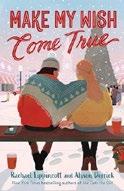
Estranged best friends fall in love amid holiday cheer. Hollywood actor Arden James hails from the small town of Barnwich, where she and Caroline Beckett grew up as best friends. Four years ago, Arden left to pursue her career in Los Angeles and never returned, leaving Caroline heartbroken. Now, in an attempt to prove her small-town authenticity and land a role she desperately wants, Arden comes home at Christmastime and convinces Caroline to fake date her for 12 days. In exchange. Caroline gets to write a Cosmopolitan article about the experience; the byline will help her quest to study journalism at Columbia. As they progress through their dates, from stealing a Christmas tree to sampling unusual hot chocolate, their romantic feelings for one another resurface. But as they grow closer, their real lives feel further and further apart. The backdrop of Barnwich makes for a believably charming holiday setting, populated by pleasant people and ample Christmas traditions (Caroline, who has one Jewish and one Catholic parent, even finds a way to celebrate both sides of her heritage). Arden and Caroline, who alternate first-person point-of-view chapters, feel like real teenagers, each with relatable struggles and desires, and their relationship unfolds in an organic, well-paced way. Their palpable chemistry lends verisimilitude to the story’s many tender romantic moments. Caroline presents white; Arden is
The blood-curdling horror sequences are riveting.
implied biracial and was raised by her Korean grandmother.
A swoonworthy Sapphic holiday romance. (Romance. 14-18)
Lloyd-Jones, Emily | Little, Brown (432 pp.)
$19.99 | Oct. 8, 2024 | 9780316568142

Three misfits join together to compete in the Wild Hunt. As a child, Branwen was touched by magic, allowing her to see creatures others cannot. She uses this power to hunt dangerous monsters. One day, a young man named Gwydion shows up in her village offering her a job helping him compete in the terrifying Wild Hunt, which takes place “on the last day of autumn every fifth year.” Branwen agrees, in hopes that she’ll win the boon that offers its recipient “anything that magic or power can grant.” Gwydion, who can enchant trees and plants, is the nephew of King Math of Gwynedd. Gwydion is determined to win the hunt and stop the king from naming Amaethon, his violent older brother, as heir. Upon joining the Wild Hunt, Gwydion and Branwen (along with her excellent cat, Palug) meet Pryderi, a prince who was kidnapped and raised by monsters. He’s struggling to find his place in the world after being found by his father, the king of Dyfed. As the three find their paths inextricably linked, they desperately try to outsmart other players in the hunt—but a shocking betrayal threatens everything they’re working for. Told in alternating viewpoints, this sparkling novel moves at a rapid clip, quickly developing connections among the immensely likable characters. Readers will find Lloyd-Jones’ trademark charm and subtle humor in a compelling and fantastical package. Main characters in this Welsh-inspired world are cued white.
A worthwhile and enchanting read. (map) (Fantasy. 14-18)
HALFWAY THERE
Madden, Tobias | Page Street (384 pp.)
$18.99 | Oct. 8, 2024 | 9798890030740

A prospective university student searches for himself during a seaworthy gap year.
Eighteen-yearold gay Italian Australian Marco Di Mario got the highest score of any student in the state of Victoria in his Year Twelve exams and was accepted to Melbourne University to study biomedicine. But when he lands in the hospital after suffering panic attacks due to anxiety over heading off to uni, his parents force him to take a year off. Nonna Sofia, the family matriarch, arranges for him to join his estranged uncle Renzo on the Mediterranean cruise ship where he works. On board the Ocean Melody, Marco hopes to find answers about himself, his anxiety, and the reason for his uncle’s abandonment of the family decades earlier. With support from CeCe Casupang, his Filipina Australian lifelong best friend, Marco decides to break out of his comfort zone and begin solving his problems by trying to “get a few things wrong ” for once in his life. This plan includes getting into a situationship with “Hot Surfer Dude” Hunter, a charming dancer from California. A cast of characters with realistic human failures propels the narrative through mostly witty dialogue. The cruise ship world is diverse in nationality, race, and sexuality, and even minor walk-on characters are described in ways that add to the story’s inclusive nature, although their identities aren’t developed in substantive ways.
An endearing examination of family, friendship, and personal growth in the wake of mental health struggles. (Fiction. 14-18)
Kirkus Star
Mari, Christine | Little, Brown Ink (304 pp.) $17.99 paper | Oct. 15, 2024 | 9780316416726

In this graphic memoir, a young biracial woman recalls her complicated emotions when she returns from America to her childhood home in Japan.
Nineteen-year-old Christine is excited to study Japanese in Tokyo, where she lived until age 5. Being “half”—with a Japanese mother and a white American father—has long been a source of pain because it’s been the main lens through which other people, both Asian and white, see her. While leaving Japan made Christine an outsider, she hopes that going back will help her “stop feeling lost” and offer a sense of belonging. She envisions new adventures with new friends, but her excitement is tempered by embarrassment that her Japanese isn’t fluent. Initially Tokyo is thrilling, but even there she despairs of being seen for herself rather than being exoticized. As she’s variously judged to be too Japanese and not Japanese enough, Christine begins to feel alienated and hopeless and slides into depression. Christine’s portrayal is appealing and true-to-life; Mari captures her fragile emotional state with
care and accuracy, and her self-loathing, self-isolation, and endless rumination are brought to life in strikingly realistic ways. The muted light-purple-and-black color palette with occasional pops of color evokes nostalgia and melancholy. The artwork creatively conveys Christine’s experiences, from the Tokyo backdrop to her internal state (such as black scribbles representing the Japanese speech she can’t understand). Identity issues and mental health crises portrayed with depth and authenticity. (Graphic memoir. 13-18)
McBride, Lish | Putnam (400 pp.)
$19.99 | Oct. 8, 2024 | 9781984815620
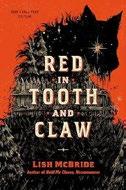
A girl disguises herself as a boy to escape gender roles and takes down a magical cult in this fantasy Western. Faolan Kelly lives in an alternate universe very similar to our own, but one where the Old West is pervaded with magic and horror. She’s feared and hated by others because of superstitions about her red hair and gray eyes. When her grandfather dies, she’s set to inherit his land—until the mayor concocts a scheme to steal it out from under her, beginning by sending her to live at the compound of the worshippers of the Shining God. But there’s something not right about the community, aside from its charismatic cult leader—and something there is killing people. Through her adventures, Faolan meets the attractive and intelligent Tallis, who’s a Rover. The Rovers display an amalgamation of characteristics commonly used to cue Native American and Romani peoples, but they’re depicted thoughtfully and without too much exoticism. They embrace far more progressive values than Faolan’s townsfolk do. Soon a heart-fluttering romance develops alongside the spooky magic and gunslinging as Faolan learns to love and trust others. The
well-crafted plot is exciting, and Faolan is a clever, tough, and sensitive protagonist. Most of the secondary characters are essentially one-note, but they’re likable, nonetheless. Mysteriously spooky and ultimately heartwarming. (Fantasy. 13-17)
Mendoza, Paola & Abby Sher | Nancy Paulsen Books (272 pp.) | $19.99 Oct. 8, 2024 | 9780593530818

Resistance and a fight for freedom in the face of unspeakable horrors.
In a bleak, near-future dystopian world in which the New American Republic has built walls along its borders and commits acts of terrorism against undocumented immigrants, four women from different backgrounds are brought together by a labor camp. The prisoners are forced to dig for aqualinium, a toxic chemical that could bring much-needed rain to a land affected by climate change–induced drought. Jess is a white girl who at 16 volunteered to join the Deportation Force; after killing a man, she let other “illegals” go, and now she’s being severely punished for her treason. One fellow prisoner is queer, Lebanese Rania, whose visa was invalidated when the tyrannical president banned everyone from predominantly Muslim countries. Working beside them is Liliana, a Colombian woman who recently learned of the resistance group SOLIS. Unbeknownst to her, Vali, the daughter she longs to reunite with, has joined SOLIS’ Special Ops team with one goal in mind: rescuing her mother. Although the book explores important subjects and the scenes of graphic violence are visceral, overall, readers will feel as if they’re being told a story rather than being immersed in one. Extensive exposition and repetition slow the choppy narrative, yet the resolution, though satisfying, feels rushed.
Nevertheless, the characters are three-dimensional, and their deep connection and care for one another are highlights of the story.
A gripping concept let down in the execution. (authors’ notes) (Fiction. 14-18)
Painter, Lynn | Simon & Schuster (368 pp.)
$19.99 | Oct. 1, 2024 | 9781665947138 Series: Better Than the Movies, 2

In this follow-up to 2021’s Better Than the Movies, a 20-year-old college freshman gets a second chance at his dreams. After the death of his father and his mother’s subsequent physical and emotional disappearance, Wes Bennett left behind all of his plans and the girl he made them with to go home and take care of Sarah, his younger sister. But now, Sarah has graduated, his mom is back on her feet, and by some miracle, Wes has an offer to pitch for UCLA’s baseball team. Liz Buxbaum, the girl he’s always loved, works for the university’s athletic department, taking photos and video of the team for social media, which means that maybe he can have a second chance at love, too. But since Wes left, Liz has made every effort to protect herself from ever feeling that broken again; there’s no room for love, because she doesn’t believe in it anymore. Or she doesn’t want to. This second-chance sports romance includes fake dates, quippy and quirky best friends, real heartache, and the sweet ache of first love. The clever dialogue keeps readers from drowning in the main characters’ emotional push-and-pull. Reading the first novel isn’t necessary for appreciating this one, although knowing the full history between Wes and Liz will only add to the ache and longing readers feel from and for them. Main characters are cued white.
A worthy second-chance romance. (Romance. 14-18)
Reilly, K.J. | Nancy Paulsen Books (352 pp.) $19.99 | Oct. 15, 2024 | 9780593620052

Three teens are drawn into a time-loop mystery, but only one person knows the whole truth of what’s at stake.
In Clawson, New York, “two hours south of nothin’ and just north of nowhere,” Nell, Cole, and Stevie B have been best friends forever. Oh sure, Nell and Cole are a couple, and Stevie B’s sketchbook is filled with drawings of Nell, but they make the dynamic work. It takes just five days to upend this tight trio, however, when Charlotte appears at school one day. Cole seems enthralled, and Nell is unnerved: Who is this girl? Why is Cole suddenly elusive and withdrawn? And why is he meeting Charlotte at the quarry at night? Nell’s not just jealous; she’s genuinely worried about Cole. She enlists Stevie B to be the Watson to her Holmes, and that’s when things go loopy. Charlotte’s not just a new girl; she’s from the future, and she’s returned to enlist Cole for help. But is she being completely honest about Cole’s role and the time continuum? Is Nell spiraling in her suspicion of Charlotte’s intentions? As Nell peels back the layers of this mystery, she unearths greater stakes, not just for her relationships, but for the future—and the intensity of those stakes ratchets up with every thrilling page. There are so many questions readers can ask with each surprising twist, before the truth is revealed. Main characters present white. Fast-paced and packed with surprises. (author’s note) (Science fiction. 12-18)

Rodkey, Kelsey | Harper/HarperCollins (352 pp.) |
$19.99 | Oct. 1, 2024
9780063243774

Senior Ella Parker-Evans challenges her new private school’s student council status quo with the help of the principal’s son. Ella takes her responsibilities as older sister to Connie very seriously, thanks in part to pressure from her parents. To help Connie escape bullying at her public school, the girls’ parents transfer them to Courtland Academy, where Ella can continue her protective role. On their first day of school, however, the entitled class president publicly humiliates Connie by reading aloud a sensual scene from her fan fiction and making innuendos. Incensed, Ella starts a petition for a new election and gets her name on the ballot. It’s hard to win as a brand-new student, so Ella strikes up a deal with handsome Patrick, the principal’s son: He’ll fake date her, using his popularity to bolster her chances. In return, she’ll help him secure a coveted apprenticeship at her mom’s restaurant in hopes of persuading his parents to support his dreams of culinary school. Predictably (and delightfully), the plan gets complicated when real feelings simmer below the surface of their pretend relationship. The leads are white; refreshingly, Ella is described as both fat and desirable. The writing is strongest during the swoonworthy scenes, which are dripping in romantic tension. The plot moves along at a nice pace, and the ending doesn’t disappoint. Delivers on genre must-haves while successfully challenging outdated conventions. (Romance. 13-18)

Nico’s interior monologue feels raw and real, expressed in an authentic voice.
ONE
Stork, Francisco X. | Scholastic (320 pp.)
$19.99 | Sept. 3, 2024 | 9781339010236

Nico wants to write his way out of his life, but does he have what it takes?
Seventeen-yearold Nico Kardos wants to be a writer. He also wants to go to Sarah Lawrence College and get away from his Bronx neighborhood of Hunts Point, where the girl he’d loved his whole life, Rosario Zamora, died from a heroin overdose six months earlier and where Javier, his younger half brother, is headed for a cruel, hard life in the local gang, the X-Tecas. One night Nico has what he believes to be a prophetic dream about his own death and the deaths of his mom and Javier. In the dream, Rosario appears and says something to him that he can’t recall when he wakes up. When Nico’s mother falls seriously ill just one week later, he wonders whether he can change his future—and whether he wants to. Is he fated to follow in Rosario’s footsteps? In this story that unfolds in the form of journal entries for his AP English class, Nico’s interior monologue feels raw and real, expressed in an authentic, youthful voice. The grittiness of his reality—absent fathers, the need for money, and the desire for bigger things—is at the core of award-winner Stork’s latest. At times the journal entries make narrative jumps that feel jolting, but the novel moves at a quick clip and is hard to put down. All major characters are Latine. An honest, brutal exploration of reality. (Fiction. 13-18)
Storm, Jen | Illus. by Ryan Howe | Colors by Alice RL | HighWater Press (64 pp.)
$20.95 paper | Sept. 3, 2024 | 9781774921074

A moving exploration of how grief affects people, centering on an Ojibwe family. When 15-yearold Chelsea doesn’t come home after school one day, her family deals with trying to find closure. A year passes, and the family members are coping with their trauma in different ways. Reanna hopes to feel closer to her sister through traditional dancing and wearing Chelsea’s regalia. Their mother does everything to distance herself from her life on the reserve, however. She moves to the city, leaving Reanna and little brother Theo with their father, a caring man with whom they have a strong relationship. The story handles the crisis of Missing and Murdered Indigenous Women, Girls, and Two-Spirit People with dignity and authenticity. The limited text on some pages draws focus to the art and its powerful imagery. Many story elements add to the authenticity and nuance, from the portrayal of the various ways Indigenous people style their hair to the inclusion of Ojibwe mourning traditions and the poignant notifications on Reanna’s phone, showing her photos that revive memories from a time before her sister vanished and highlight how fractured her family has become. The ways that Chelsea’s family tries to find closure and deal with her absence vary, realistically showcasing the forms grief can take and the struggle of longing for answers one may never get.
A powerful and sensitively told story. (content warning, author’s note) (Graphic fiction. 12-18)
Swanson, Kara | Enclave Escape (352 pp.)
$24.99 | Aug. 20, 2024 | 9798886051346
Series: The Phoenix Flame, 1

A fantasy series opener presenting two different pathways.
Mara, a 200-year-old phoenix, must learn how to control the destructive fire inside her. Her adoptive father, Darkholm, instructs her to hide from the Hollow Ones, or humans, who use the phoenixes’ fiery blood for warmth to combat the cold due to the “sun’s slow death.” Father even tells Mara to cut off her wings for her own protection. When Father and the rest of their flock disappear, Mara sets out to rescue them. On her journey she meets half-phoenix / half-human Eli, who challenges her views of humanity. Eli, his human brother, Jude, and his phoenix father, Haven, also share a different side of Darkholm. Mara and Eli bond as survivors of tragedies and find healing in one another. Through her interactions with the phoenixes, Mara discovers that her fire can be an agent of destruction—or restoration. Mara and the phoenixes communicate telepathically; these conversations provide insights into gaslighting, manipulation, and psychological abuse. Religious links to sacrifice, worship, and temples support the worldbuilding and provide further commentary on the lengths people—or phoenixes—will go to in order to serve their own self-interests. Mara’s resistance offers glimmers of hope amid the darkness. Despite some cliched elements and disruptive changes in point of view, the messages of strength and self-advocacy resonate. Mara and her father are light-skinned, Eli has “bronzed skin,” and the humans in this world are racially diverse.
A fiery protagonist shines a resilient light in the darkness of complex family trauma. (Fantasy. 14-18)
Ulrich, Josh | Putnam (272 pp.) | $24.99 Oct. 8, 2024 | 9780593403655
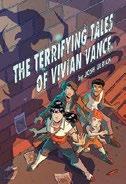
A young would-be sleuth faces supposedly mythical monsters who turn out to be not just real, but shockingly familiar. Vivian has long dismissed the tales she and other Pensmouth kids have always heard from their parents about shape-shifting Flesh-Takers roaming the streets at night. Then she actually witnesses one eating a man who’s down on his luck in a seedy neighborhood. As an ambitious high school sophomore, she seizes on the chance of qualifying for the town’s Greater Achiever Program by finding the creature’s lair. Ulrich pitches his intrepid protagonist into situations of extreme peril as well as developing friendships with street orphans Leon, Zack, and Jacob, whom she initially strongarms into helping out. He spins an investigative yarn as thrilling as it is edifying, complete with clever sleuthing, shocking revelations, and a disquieting closing twist. Along with having a knack for crafting fantastically nightmarish monsters, the author/ illustrator also shows a rare talent for artfully using reaction shots, wordless sequences, page turns, and changes of body language and facial expression both to ratchet up the suspense and to fill in his characters’ nuances and backstories. Fans of gory horror in general (and the Buffy the Vampire Slayer aesthetic in particular) will be well pleased by the violent plot and acerbic teen banter. Leon and Jacob have brown skin; the other major cast members, including Vivian and her disabled single dad, present white.
A fizzy mix of courageous exploits and really creepy creatures. (Graphic fantasy horror. 12-14)
Underwood, Sarah | Harper/HarperCollins (400 pp.) | $19.99 | Oct. 1, 2024 | 9780063234529

Two girls work to discover their own strength to survive.
Sixteen-year-old Eirene and her twin, Phoebe, who have light brown skin and curly black hair, live in Zakynthos, a town controlled by Leandros, a descendant of Eros. Women there are manipulated by Leandros’ Desires, magic that seemingly brainwashes them into being under their husbands’ control. After Alexandra, Leandros’ 18-year-old wife, dies suddenly and mysteriously, he decides to marry beautiful Phoebe, wooing her with lavish gifts. When Stavros, the sisters’ cousin and guardian, agrees to the match, Eirene, who has never had “an interest in the beauty of men,” is determined to save her sister from Alexandra’s fate. She makes a deal with Leandros: If she can complete four tasks that he sets, she’ll marry him in her sister’s place. If she fails, he’ll take Phoebe as his wife. Unbeknownst to Eirene, Leandros has a daughter, pale, redheaded Lamia, who’s been hidden from the world. Her left leg never fully healed from an accident and affects her mobility. A connection quickly blossoms between the two girls as Lamia helps Eirene with the increasingly difficult tasks. As they complete each one, Eirene and Lamia grow closer to discovering the mysteries of Leandros and his powers. The compelling plot explores themes of feminism, disability, and abuse in thoughtful ways, while staying true to the setting of ancient Greece. Readers will be intrigued by this Sapphic retelling featuring a strong sense of place. A creative, well-told story to satisfy fans of Greek mythology. (Fantasy. 14-18)
IS IT SHAMEFUL to admit that I prefer the essays of some celebrated novelists to their fiction? I never completely warmed to Martin Amis’ gimlet-eyed satires like Money and London Fields, but I’ve read my copy of his essay collection The Moronic Inferno to tatters. And I routinely bypass my three-quarters-read Infinite Jest to once again page through David Foster Wallace’s Consider the Lobster There are special pleasures to be had from dipping into a good collection of essays: variety, deep-dive specificity, the sensation of being spoken to directly by the author. The essay is the province of the voice; as always, Indieland is rife with distinctive voices and compelling, individualistic points of view. The following recent collections have caught our attention: Sean Enfield’s Holy American Burnout! (2023) tackles issues of race, American history, and education. Enfield, a biracial millennial, pulls no punches: One piece in this collection surveys conservative memes featuring Martin Luther King Jr.—posted by Enfield’s white aunt. In a particularly painful episode,
a teacher has a class bedazzle paper shackles with glitter and stickers as part of a lesson on enslaved Africans enduring the Middle Passage. Our reviewer praises Enfield as “a skilled wordsmith with a keen sense of American history and a deep appreciation for the Black intellectual tradition.”
The educational theme continues in The World From the Eighth Grade (2024), in which former social studies teacher Richard Aston has compiled essays written anonymously by his eighth grade students, with no fear of reprisals or judgment, in 1969. Their extraordinary offerings are collected here, reflecting a dizzying array of voices that range from “the surprisingly insightful to the charmingly

absurd.” These essays offer a rare, unguarded glimpse into the adolescent psyche (“I don’t know what I want to do. Maybe a dope peddler or a secret agent or a billionaire”) as well as a unique vantage from which to consider one of the most tumultuous eras in American history.
Moving from innocence to experience, Janet Benner’s Olders’ Voices (2023) gathers essays written by a group of respondents between the ages of 68 and 99. The pieces offer some expected advice (adults should call their elderly parents more often) as well as hard-won wisdom regarding loneliness, isolation, and failing health. While such subjects are inarguably bleak, the collection is buoyed by the writers’ overall sense of optimism and gratitude, and the book’s biggest takeaway—in the face of adversity, maintain flexibility—is worth its weight in gold. Our reviewer praises
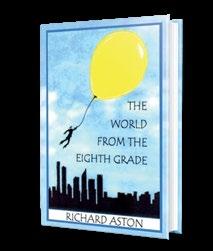

ARTHUR SMITH
the “thought-provoking” entries for their “keep kicking” attitude.
Finally, Lawrence Shainberg’s Hot Hand Sutras (2023) offers an “absorbing and poignant exploration of the human brain,” per our reviewer. Shainberg, an accomplished writer, spent decades researching the workings of the human mind, publishing his findings in such august journals as the New York Times Magazine and Harper’s. The essays collected here cover such topics as athletic “hot streaks,” the practices of Zen and meditation, and creativity. Our reviewer notes that the pieces display “literary sophistication and the gripping storytelling of a skilled novelist”; perhaps the rewards of good essays and good fiction aren’t so different after all.
Arthur Smith is an Indie editor.

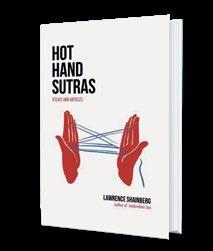
The stories of two women separated by miles and years intertwine in Thomas’ riveting blend of family drama and thriller.
Single mother and journalist Leslie Graham has shaken off a disturbing past event and now leads a full life in California with her two teenage daughters, Rhonda and Jillian. Leslie is shortlisted to become the first Black news editor at the local paper in the charmingly named town of Dancing Hills. Suddenly, her world is thrown into turmoil when her daughters are involved in a car crash that is no accident: An SUV intentionally hits their vehicle, but why? In contrast to Leslie’s success and family life, 10 years earlier, New Yorker Barbara Morris, unhappily married
to her husband Edward and aware he is planning to divorce her, develops a plan to keep their young daughter, Nancy, should the marriage dissolve: Barbara intends to hide their daughter and insinuate Edward is to blame for her disappearance. It is a dark plan, concocted by a woman with significant psychological issues; Barbara fears she may suffer from schizoaffective disorder, likely inherited from a mother confined to a mental institution for killing her boyfriend (“The noise in my head, the voices. I couldn’t ignore them. The voices, those damn voices!”). Secrets abound throughout the book, and none of the women, young or old, is who she seems to be. Mother/ daughter issues—good, bad,
Kevin Harkness
Lynn Osburn

Thomas, Alretha | Diverse Arts Collective
327 pp. | $15.95 paper | May 7, 2024
9798218389680
and very, very bad—knit together a narrative that brims with surprises. Characters who initially seem sympathetic turn otherwise, and vice versa. Leslie’s and Barbara’s stories are told in alternating chapters, with the two narratives converging in an explosive finale.
Throughout, attention to small details helps make the characters feel more real, such as Leslie’s love of crocheting, Rhonda’s smile that reveals retainers, or Barbara’s approval of styling her dreadlocks in a French twist.
A deeply satisfying suspense tale.
TRY BEFORE YOU TRUST
Ashley, Garrett | Press 53 (172 pp.)
$17.95 paper | May 3, 2024 | 9781950413768

Bizarre zoological phenomena feature in Ashley’s debut collection of eerie short stories. These short narratives lean toward the macabre and largely fixate on the animal realm, in which odd mutations occur in somewhat dystopic futuristic settings. The title piece describes the Deep-Sea Atrium, a vast, multi-storied aquarium. Visitors behold rare, exotic, and sometimes monstrous maritime specimens in simulated abyssal depths (an angler fish “hangs in the water beneath a timid yellow light. Extendable jaw and elastic stomach full of shrimp and other tank debris”). The emotionally detached, college-dropout narrator, an Atrium guide in a troubled relationship, habitually steals from the premises— readers will sense that this cannot end well. One creature from the menagerie figures in another story, “Riding the Waves of Leviathan”—an immense sea beast that frequents a stretch of the Atlantic coast, forcing the hard-drinking local fishermen to seek new employment as gold miners (faintly absurdist dream-logic is another recurring trait here). Their neglected children take to surfboards to master the waves the Leviathan stirs up in a sometimes fatal pastime. Another family bedeviled by water-dwellers, weird biology, and alcohol appears in “Last Stand of the Alligator Killers,” a story depicting a (literally) decaying household of swamp folk who grow scalier and less human while
hopelessly fighting the amphibious encroachment of saurian “horn-tailed Joes” that have rudimentary intelligence. A sort of slime-mold “protist,” a subterranean species possessing sentience and near-human emotions, tries to co-exist with unusually accommodating Homo sapiens in “Skin,” but the social arrangement is heartbreakingly fragile. Many of the yarns have ambiguously open endings, but they are rarely less effective for leaving things not tidied up; the animal-free “An Execution” is narrated by a bereaved father in an America in which relatives of homicide victims have the right to ritually slay the guilty party in an eye-for-an-eye manner (this provides dubious closure). These tales raise shudders of the existential dread variety rather than “Halloweenboo!” scares, despite such Lovecraftian mainstays as tentacles, ichthyic environments, and creature-metamorphoses; one suspects the author has bigger fish to fry. An unsettling bestiary of narratives for SF and horror readers with a taste for unease—and seafood.
Briones, Constance | Historium Press (286 pp.) | Jan. 9, 2024

Briones’ mid-16thcentury romance novel is inspired by the life of Isabella Whitney, the first female English secular poet to have her work published. Isabella (Izzy) Whitney, the daughter of a landowner with a small estate, turns 18 in 1567. She
has accepted the position of maidservant to the widowed Lady Bramwell and will spend the next year in London, where she will be trained in the skills necessary to run a proper home should she marry and have children. It is not the prospect of perfecting the womanly tasks of the day that excites Izzy (she far prefers to write poetry) but rather the opportunity to avail herself of Baron Bramwell’s extensive library. (Her cousin William has been tutoring her in writing and the reading of “ancient tales of history, adventure, and romance,” subjects not deemed appropriate for proper young maidens.) Unfortunately, when she arrives at Bramwell House, she learns that the Baron’s library is locked to all but Lady Bramwell and her handsome, 21-year-old nephew Robert Barrington. Izzy finally meets the elusive Robert, a law student at Cambridge, when he is ensconced in the Baron’s library during Lady Bramwell’s lavish Twelfth Night celebration. He is charmed by Izzy’s interest in literature and poetry; he too is a poet, he tells her. Thus begins a passionate (verging on melodramatic) tale of love, ambition, secret betrothal, and a betrayal that compromises Izzy’s reputation. Briones has faithfully replicated the fashions, mores, customs, effusive linguistics, and social stratifications of the early Elizabethan era. Although little is known about the life of the historical Isabella Whitney, Briones’ fictional Izzy, an eloquent narrator of her own story, is a vibrant and independent protagonist who refuses to be felled by her lover’s betrayal—despite the hardships she undergoes, she becomes a dynamic literary advocate for women. Briones packs the novel with literary references to works of Virgil and Ovid, and the narrative overflows with vivid historical details about 16th-century London.
A dramatically drawn portrait of the plight and power of Elizabethan women, be they high-born or low.

For more Indie content, visit Kirkus online.
Carter, Susan Sisko | Atmosphere Press (298 pp.) | $25.99 | $17.99 paper | July 16, 2024 9798891322691 | 9798891322080 paper

A woman embarks on a journey of self-discovery at a hotel with a connection to her past in Carter’s secondchance romance.
In 2019, Jeanette Coles, a commercial director from San Francisco, spent an unforgettable night in Los Angeles at the Lyric Hotel. While walking her dog, she met Evan Jameson, a cello player who’d performed with such world-famous musicians as Sting and Diana Krall. Their instant connection led to a night of passion; however, both were married, and Evan was reluctant to start an affair because “the only woman he’d give that much of himself to was his wife,” Nancy. After she returned to her home in San Francisco, Jeanette’s world was shattered when her husband, Michael, was killed in a car accident. Eight months later, Jeanette returns to the Lyric Hotel for an extended stay with no set departure date. Meanwhile, Evan’s busy performing schedule becomes complicated when Nancy tells him she’s pregnant with their second child. As he navigates the responsibilities of marriage and parenting with his life as a musician, Jeanette copes with her grief through a series of business and romantic encounters with other guests at the hotel. As the December holidays approach, Jeanette gets an invitation to join her mother in Paris, which offers the possibility of a surprise reunion with the man she’s unable to forget. Carter’s debut is a sparkling romance with vivid characters and sharp, crystalline prose. Jeanette is an instantly memorable protagonist whose journey through her grief is heartfelt and poignant. Evan is a strong foil for Jeanette, and their scenes together crackle with romantic tension. The author also shows a knack for clever chapter titles (such as “Loathing Me Loving You”) and witty character
introductions, as when Jeanette meets with an aging actor to film a commercial: “One historical landmark leaned against another. Charles Millburn stood among the gnarled roots of the 120-year-old fig tree, resting his silver pate against a venerable branch, eyes closed as a makeup woman dabbed foundation onto his nose.”
A page-turning tale of the healing power of love.
Childs, Allen | Bartleby Press (458 pp.)
$32.00 | Feb. 9, 2024 | 9780884003977

The lives of two very different groups of people change forever as they collide in unexpected circumstances in Childs’ debut historical novel. In 878 C.E., a merchant ship sets sail on the Red Sea. Upon it are friends Eldad and Saul, who find themselves talking to the beautiful Babylonian Adiva, her brother Hillel, and her cousin Yosef. Eldad, a member of the tribe of Dan, is on a mission to discover the meaning of a book his family has entrusted him with; Adiva has treasures hidden about her person given to her for safekeeping by a rich banking family. The groups become increasingly intertwined as the ship runs aground among the Zubair volcanic islands and they find themselves in a fight for survival. Childs brings together a variety of Jewish experiences from this period, demonstrating his extensive research as he gives each character—and there are many—detailed backstories that illustrate various heritages and migrations of Jews throughout the early Middle Ages. As Adiva’s father observes, “It just reminds us that Jews must always be ready to carry their culture with them to find a better world.” In particular, Eldad’s journey as a Black Jew is illuminating. However, parts of the story are convoluted and overlong, making the narrative a little hard to follow. The shipwreck part of the storyline takes up a
huge portion of the novel, and the action feels drawn out, while the resultant journeys of the separated characters back to each other can seem compressed and erratic. Though Childs has pulled together a trove of historical detail that truly does push the novel into epic territory, sometimes it reads more like a history lesson than a fluid narrative. Despite this, the subject matter and time period are compelling, and the love story between Eldad and Adiva remains engaging throughout, leaving readers eager to discover their fate.
A unique and highly detailed novel for historical epic enthusiasts.
Creel, E.G. | Illus. by Elizaveta Kres | Self (38 pp.) $26.77 | $12.99 paper | June 5, 2024 9798869367044 | 9798324891336 paper

Divided in their beliefs about what sort of cheese the moon is made from, three major factions in the mouse world plan a lunar mission to find out for certain in Creel’s picture book.
From the moment a mouse child first lays eyes upon the shining moon, he believes that the moon is made of cheese. That belief passes down through generations, and in time it leads to disagreement: What sort of cheese is it?
Three major faiths emerge: the Cheddarics, the Swissologists, and the Goudists, each with followers devout to the point of fanaticism. Still, they work together to send a rocket to the moon. There, three mouse representatives find...only dust and rocks. Many of the faithful back on Earth refuse to believe such blasphemy, but one mouse child decides it still loves the moon—whatever it might be made of. Creel and illustrator Kres concoct a fun little fable that will both amuse adults and encourage children to favor heartfelt faith over dogma. The book is divided between dark-backgrounded (with white text) two-page spreads that play to the moon’s mystical appeal and single-page white backgrounds (with black text) against which the mice
squabble or plan their mission. The prose is refined and offers plenty of memorable lines. (“The Swissologists made their own announcement: ‘In the most holiness we believe!’”) Kres’ digital artwork offers serviceable landscapes and depicts mouse protagonists full of vitality and character. A clever religious parable, playful in the telling.
Danna, Robert | Ibis Books (284 pp.) $14.99 paper | April 8, 2024 | 9781956672282

Continuous curiosity propels Danna’s life and career in this memoir. In the prologue, the author describes his memoir as “a collection of stories, reflections, calls to action, and hard-earned insights,” addressing the book to his two young grandsons to share his life story and strongly held values with them (“So, my grandkids have a record of Grandpa”). The narrative is divided into four sections. The first (“If My Life Were a Play”) gives an overview of his life—his Italian immigrant heritage, suburban childhood, education (he holds graduate degrees in both physics and environmental engineering), and career—as Danna speculates about what the future will hold for his grandkids. The remaining sections focus on other aspects of the author’s life and values, including reflections on being an intellectual and business leader, understanding his own personality, his personal “guiding principles,” art, music, politics (liberal), religion (skeptic), and more. Identifying as a “boomer,” Danna has certainly led an eventful life. He describes visiting the 1965 New York World’s Fair 17 times, protesting the Vietnam War as a college student, serving as a U.S. Navy officer and instructor at its Nuclear Power
School, getting a pilot’s license, training and consulting at commercial nuclear power plants and government facilities, being a business executive and an early adopter of technology, witnessing several solar eclipses, and traveling throughout the U.S., Europe, and Asia. Along the way, he also was married and divorced twice, had a daughter, and entered a third long-term relationship; aside from some expressions of regret over the lack of balance between his work and personal life, the book provides minimal details about these relationships. A selection of images enlivens the text, ranging from family and travel photos to items of memorabilia such as concert programs and military insignia. Finally, an epilogue provides “Lyrics to Songs that Reflect Who I Am,” a list of selected technical publications and presentations, and the author’s sarcastic comments on four Bible stories that he finds outrageous. Danna’s writing style is direct and straightforward, casual and conversational. Rather than offering flowery descriptions, even his most exciting and moving experiences are simply recorded as “amazing,” “incredible,” or “pretty cool.” He explains the scientific concepts underlying such events as the nuclear reactor accident at Three Mile Island and various solar eclipses succinctly and clearly, as befits his training and presenting career, and he describes art and music in terms of personal meaning. Danna’s humor shows in lines like “we partied like it was 1999. Actually, it was 1999.” The book’s structure, which presents overviews of subjects followed by deeper dives on specific topics, sometimes feels like summarizing, and the narrative jumps back and forth in time. However, it’s easy to follow, and the approach permits
the author to express some very pointed opinions and include such extras as “The Humanist Ten Commandments,” a list of the organizations he supports, and a description of a visit from his grandsons. Again and again, Danna emphasizes the importance of curiosity, asking questions, thinking critically, and sticking to principles. An engaging, curiosity-driven journey from the 1960s to the present.
Druhot, Amy | Just Brave It (238 pp.) $18.60 paper | May 14, 2024 | 9798990214101

An inspiring self-help book based on one woman’s personal (and often humorous) journey of finding her authentic self. Druhot makes it clear from the start that she has no “official” credentials to write a self-help book. What she does have, however, is the kind of relatable lived experience that everyone who has ever struggled to find themselves will recognize. As a result, Druhot has formulated a “(Who) + (Why) + (How) = Fulfillment” formula for living honestly and passionately. She explains why everyone’s “why” power is greater than their “will” power while helping readers identify their “impact why” (that is, the idea around which every future choice revolves). Druhot peppers her advice with anecdotes
An engaging, curiosity- driven journey from the 1960s to the present.
from her childhood in Alabama, as well as her struggles with an eating disorder and compulsive spending. She includes occasional black-andwhite photos from her life, including of the son of a woman she knows, who was born with a complete bilateral cleft lip and palate. “Reflect Before You Neglect” writing exercises conclude most chapters and feature reflective questions like “What is the life you’re not only capable of achieving, but worthy of having?” Druhot masterfully balances humor and heartfelt advice in a guide that’s as entertaining as it is instructional. Her knack for self-deprecation results in some unexpected, laugh-out-loud moments. (“I only drank once before I turned 21. Never went to parties or tried any drugs—not even a cigarette. But, girl, bless my heart, I was a ho.”) But Druhot also challenges readers to push deeper into their own selves. She transforms the tired “Who am I?” question, for example, by pointing out that labels like mother and wife are simply “titles we or others give us…All of those titles are about other people. You can’t have a single one of those titles without someone else’s involvement.” Readers will likely find both comfort and inspiration from the author’s wholly unique voice. A witty and heartfelt guide that urges readers to treat themselves with kindness and live with meaning.
Dupuis, Michael | Illus. by Michael Kluckner | FriesenPress (282 pp.)
$38.99 | May 16, 2024 | 9781038306647

A female cub reporter chases her first big story in Dupuis’ historical novel about an astonishing, lesser-known disaster that nearly obliterated a Canadian town. On December 6, 1917, two ships made a catastrophic collision in Nova
Scotia’s Halifax Harbour. One was the SS Mont-Blanc, a French cargo ship toting 3,000 tons of explosives from New York to Bordeaux. The resulting blast, which killed nearly 1,800 people and left scores of others injured and displaced, was the largest humanmade explosion before the atomic bomb. Here, the story unfolds in the immediate aftermath of the disaster and tracks the journalists who covered it. The titular “woman reporter” is the adventurous yet proper Kate Dawson, a young staffer at the Toronto Advocate with a personal connection to Halifax. Was the explosion an accident? Part of a German spy plan? Equipped with a reporter’s pad and an ivory comb, she plans to do whatever’s necessary to get the facts, encountering her fair share of sexism and adversity along the way. Stenographic illustrations and an adventure-driven plot give the book an accessible feel that YA readers might particularly enjoy. Straightforward, if occasionally dialogue-heavy, prose (“I have never accepted the belief that men do what they want, and women do what they are told”) also makes this an easy read. Dupuis’ thoughtful research of the disaster and its repercussions is apparent throughout, including the real dispatches from Halifax reporters. His protagonist, on the other hand, is less meticulously crafted. With her “tall, slim-waisted figure,” “deep blue eyes,” “firm sensual mouth,” and “ready smile,” Kate is a Hollywood archetype in a whale bone blouse who’s just bold enough to stand up to her male counterparts without sacrificing her feminine charm. If readers can look past the cliched character choices, there’s a fun read in store.
An entertaining interpretation of a cataclysmic event in Canadian history— saddled with timeworn characterization.

Eastman, Cindy | She Writes Press (168 pp.) $17.99 paper | Sept. 17, 2024 | 9781647427184

Eastman’s memoir details the realities of caring for an elderly parent. In a series of essays, the author tells the story of looking after her father while he was in his 80s. This was a man who, in his younger days, worked as a chemist for General Electric and was known for his sense of humor; per Eastman, he “saw every problem as an opportunity to fix and make things better.” However, in his later years he could no longer care for himself. He required regular doctor’s visits, a strict diet, and help with simple tasks. (As she says of this time, “When his day starts, so does mine.”) This book takes a close look at the quotidian routines and the struggles of elder care—everyday incidents in which the author’s father might do something like unknowingly put the television on maximum volume and then become defensive over his actions. Then there were outside pressures; Eastman writes of dealing with Medicare concerning how long one is allowed to stay in a hospital: “When Medicare says they’re done covering your stay, you’re done.” The narrative includes humorous situations as well—at one point, the author’s father told a therapist that she had called him “skanky” when in fact, after some consideration, it seemed he actually meant “snarky.” As readers might expect, dealing with an aging parent is no pleasure cruise—the book does not sugarcoat the difficulties. Eastman learned firsthand how “there just aren’t many solutions in our current culture or societal construction to appropriately care for our elders.” Even with the occasional comic relief, readers come to understand just how tough it can be. Some aspects of this toughness are, however, mentioned more than once in different essays (the author relates on multiple occasions
how, at one point, her father broke his ankle). Though such repetition can disrupt the flow of the essays, it does not diminish the unglamorous, punchy portrayal of Eastman’s experience. An unfiltered, invitingly irreverent look at what it means to be an adult caretaker.
Ellis, Jackson | Green Writers Press (184 pp.) $19.95 paper | Oct. 22, 2024 | 9798989178452
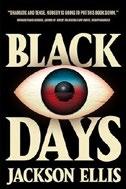
A deeply depressed man takes a break from life via cryogenic hibernation and wakes to a world of trouble.
Daniel Fassett’s life has been a disappointing one filled with regret, but he sees a second chance in retirement from his factory job in Granbury, Vermont, his hometown. Expecting a generous pension after 30 years of employment, he buys a small cottage in Key Largo, Florida, eager to start life anew at 62 years of age. However, he loses control of his car and drives into a freezing river, where, for at least 20 minutes, he is unconscious before being rescued. When he awakens from his coma four months later, his life is in a shambles—facing a considerable rehabilitation, he discovers his pension was greatly reduced on the basis of a technicality; all but broke, he has no choice but to abandon his retirement home. Utterly despondent and terrified to face a long winter alone, he comes up with a crazy idea, one fantastically implausible but nevertheless fascinatingly developed by the author: Daniel decides he’d like to spend the winter suspended in hibernation and shares his plan with his old friend and physician, William Butcher. Butcher is initially incredulous, but then decides it can be done, and they freeze Daniel in a “hibernation casket” housed in an old sugar shack designed for the production of maple syrup. The plan works—Daniel wakes rejuvenated after nearly 119 days of slumber—but when the world learns what he has accomplished, it
A compelling plot infused with philosophical vitality.
BLACK DAYS
turns his life inside out. Ellis’ prose is simple and powerfully foursquare. When Ralphie, Daniel’s son, asks him why he froze himself, he answers plainly: “Desperation. Money. Sadness…loneliness.” This is a strange and marvelously unpredictable tale, one that raises provocative questions about the tension between scientific progress and moral goodness. The narrative is intelligently conceived and executed, and refreshingly original. A compelling plot infused with philosophical vitality.
Gormley, Sarah | Salt Creek Publishing (256 pp.)
$28.00 | Sept. 10, 2024 | 9798990642508
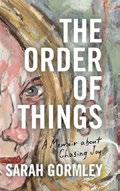
In Gormley’s memoir, a successful executive returns home to care for her mother and, eventually, herself. After growing up in Ohio, the author pursued a career in marketing that took her to the heights of the corporate ladder; she had fabulous apartments in glamorous cities like New York, Chicago, and San Francisco, but she also found herself on the edge of a nervous breakdown: “I thought I might get fired. I needed to quit.…My job was not my life, but I couldn’t figure out what my life was without my job.” That sentiment would change in an instant when she received the call informing her that her mother had cancer—only one year after losing her father. Without hesitation, Gormley left her highpowered executive job at Adobe to take on a “grown-up gap year” in which she would care for her mother back in Ohio. As Gormley recounts the year spent
taking her mother to doctor’s appointments, each with more depressing diagnoses than the last, she also delves into her own psychological issues. Since she was a child, Gormley strived for “gold stars,” achievements that ranged from straight-A report cards to promotions to obsessive calorie-counting. With the time off of work and the help of some long-distance therapy sessions, Gormley was finally able to confront some of the origins of these issues and even start to prepare for a new life with the handsome cousin of a neighbor, Camillus Musselman. (“Who falls in love when their mother is dying?” she asks herself, but Camillus’ charm was too great to resist.) Gormley soon found herself on a new path that would lead to owning an art gallery in Ohio and continuing the work of “untangling” herself from the memories of her beloved, late mother—which, as she says, is “something I will keep doing for the rest of my life.”
Gormley’s style makes inventive fun of the concise, corporate messaging from her former career; pivotal scenes and emotional revelations become bulletpointed lists or simple, choppy declarations. It’s a rhythm that feels specific and refreshing, bringing a punchy and enjoyable tone to her heavy subject matter. She also has an eye for peculiar and unexpected details, crafting imagery that stays with readers long after her book is over, including playful descriptions of her boyfriend’s wrists (a body part she never expected to be attracted to); the haunting death rattle sound that signaled the ends of both of her parents’ lives; or the sharp contours of her hip bones jutting out of the bath, a marker of her “progress” in staying thin (just one of the many effective ways she conveys an array of powerful emotions around her history with anorexia). No matter the weight of the
subject, Gormley maintains a steady sense of humor—she and her mother have hilarious repartee even in the darkest moments, and there are plenty of corporate gags peppered throughout (like her recipe for “Martha-StewartFired-Me Cookies”). This keen eye and quick wit tie the memoir’s different themes, from self-help introspection to family tragedy, together into one cohesive whole. A distinctive voice delivers an entertaining and insightful look at family and mental health.
Kirkus Star
Harkness, Kevin | Shouting Room Books (274 pp.) | $12.99 paper | July 1, 2023 9781778226298 | Series: A War of Banes and Demons, 5
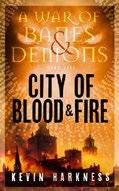
The concluding installment of Harkness’ YA fantasy series pits young soldiers against a new kind of enemy.
The fifth and final book in the A War of Banes and Demons series finds demon slayers Garet and Salick back in the city of Shirath after their dangerous trip to the Far North, where they discovered that the demons they’d been fighting were being created by a powerful enemy. What they find on their return shocks them both: Already weakened by continuous demon attacks, the city will face a final onslaught on the spring equinox, which is worryingly close. Trax, king of Shirath, is also showing signs of losing his grip on his people and his sanity. Soldiers, for example, refuse to perform unlawful executions on his orders, exacerbating the sense of fracture within the city walls. Soon, the Fifth Ward’s Maze, where “the dregs of the city” reside, finds itself under attack by the arrival of a new type of demon—one created using humans: “As expected, since the demon had spread no fear as it approached, he found silkstone plates fixed to its skull with small iron nails….Its
face was no longer even vaguely human, but bore a fully toothed beak, eyes as black as a starless night, and a helmet-like crest that stretched from just above the stone plates to the back of its head.” Alongside the rich descriptions and brisk action are explorations of larger themes: good versus evil, the weight of power, and what it means to be human. A bittersweet ending—complete with a shocking banishment and slightly less shocking wedding—provides a fitting conclusion to a saga that still contains the potential for many more adventures.
A smart, fast-paced series finale that ties up loose ends while providing all the action readers have come to expect.
Harrison, Alan | Changemakers Books (232 pp.) $19.64 paper | Jan. 26, 2024 | 9781803414461

Harrison presents a radical new vision for nonprofit arts organizations in this nonfiction work.
Drawing on his 30 years of experience in nonprofit theater, the author breaks down, in easy-tounderstand language, the United States tax code and the ways in which nonprofit groups misconstrue their responsibilities as a 501I: “The purpose of nonprofit arts organizations is not about… the production of art, but the production of impact using the arts as tools.” Harrison also discusses the toxic influences within these organizations, including the lie of subscription revenue, glory-chasing artistic directors, and overly pampered big-money donors. The author proposes pragmatic reforms placing focus on better outreach to the neighborhoods these organizations operate in. Better diversity, equity, and inclusion (DEI) integration both on the boards and
staffs, along with transparency regarding both donations and pay, would increase hospitality and impact, per Harrison. He argues that fostering diverse voices would help institutions to better understand the specific issues that require a nonprofit’s help—be that aiding the houseless, combating gun violence, or raising awareness about the opioid crisis—while putting on shows that both engage and matter to the community. The author is aware that his advice will be seen as controversial and pulls no punches as he explains the problems he views as inherent to nonprofit arts organizations. Sarcastic asides are common, and Harrison has seemingly never met an analogy or metaphor that he didn’t love, but he also emphasizes the importance of data and gives specific advice. Some of this work’s progressive ideas, like giving away tickets or divesting from a theater space, could be game-changing, though the text doesn’t offer many real-world examples aside from Minneapolis’ Mixed Blood Theatre, New Haven’s Long Wharf Theatre, or the occasional personal anecdote. While forceful, even the harshest commentary is not presented prescriptively, and it clearly comes from a place of love for the subversive and utopian possibilities of the arts.
Many in the nonprofit arts sector will decry this manifesto as heresy, only validating its necessity.
Hart, Livy | Entangled: Amara (352 pp.) $17.99 paper | Aug. 6, 2024 | 9781649376510

Two people bring fake dates to a wedding but only have eyes for each other in Hart’s comical romance. Nora meets Sebastian when he comes into the bookstore where she works. She really likes him, but just when he’s about to ask her out, her friend and boss Benji arrives at the store. Benji is in some trouble with his family; Nora
pretends to be his girlfriend to get him out of it. This ruse gets her invited to a family wedding as Benji’s plus-one (“We were so worried the wedding photos would be unbalanced. We thought he’d be the only single Ferraro, sullen in the back of every portrait”). Sebastian, meanwhile, is taking some time away from his job opening Boys and Girls Club chapters around the country to help out his grandmother. His best friend Alessia’s brother is getting married, and Alessia asks Sebastian to be her fake date to the wedding. (It turns out that all of these characters are going to the same nuptials.) Sebastian realizes pretty quickly that Nora and Benji are faking their relationship, and his friend Alessia gives away their game, too. What follows is a farce in which both fake couples have to keep up the con, even though Nora and Sebastian both really like each other. Not all is well; the feud brewing between the bride’s and groom’s families threatens to blow up the wedding, and Sebastian tells Nora he’s about to move to another state for work. This is a fun take on the fake-dating trope. Sebastian is a do-gooder who seems a little too good to be true, but both he and Nora are engaging, likable protagonists, and the chemistry between them is off the charts. The bride’s and groom’s families are involved in a Montague/Capulet-level rivalry, and everyone involved comes from big, nosy Italian families, adding depth to the story with a lot of quirky side characters and complicated interpersonal dynamics. The dialogue is zippy and clever, too. Overall, it’s a light, amusing read. A big fat funny wedding romp.
Joiner, David | Stone Bridge Press (264 pp.)
$18.60 paper | Nov. 21, 2023 | 9781611720815

Joiner offers a meditative novel about love and abandonment set in the picturesque Japanese countryside. Things are not going well for
A methodical yet fun approach to brightening and expanding the everyday.
Sedge, a Westerner living in Japan. Until just before the action of the novel begins, he owned and operated a ceramics shop with his Japanese wife, Nozomi. When Nozomi leaves him, without warning, for a highly talented and respected ceramicist, Sedge is devastated—the abandonment would be bad enough, but Nozomi left with all their money, too. Stuck in dire straits, Sedge receives a lifeline from an unlikely source: Nozomi’s brother, Takahashi, and his wife, Yuki. They offer him free residence at their ryokan in the hot spring resort town of Yamanaka Onsen under the condition that he teach English to the inn’s staff. The situation is complicated by the fact that Mariko (the wife of the man Nozomi ran off with) works there, too, and is keen to meet Sedge. They soon grow close when Sedge—much to the dismay of Takahashi and Yuki, who want him to keep a low profile— begins teaching Mariko privately at her home. There, he meets her stepson, Riku, a bright if troubled child who was also left behind when his father fled. As Sedge and Mariko bond over their shared trauma, they discover they have much in common—in particular, their love for herons. As their companionship evolves into sex and romance, their need for secrecy only increases— neither of them has heard from either of their runaway spouses, and things could implode at any moment. Joiner’s novel is full of pastoral beauty: “Two or three herons stood in each field… perhaps thirty fields altogether unfurling toward the sea. Even the river, miniaturized by distance, had herons circling above it.” Through clean prose eliciting a placid calm (which deftly evokes the landscape), readers spend time with characters who feel full and human, and whose
dramas, in their quiet way, will leave a lasting impression.
A powerful journey through emotional devastation led by some unforgettable characters.
Lamp, Pamela | Clovercroft Publishing (170 pp.)
$16.99 paper | Aug. 6, 2024 | 9781956370331

A memoir that also serves as a self-help guide to making big changes incrementally. Lamp used a sensible strategy— build an entire structure one piece at a time—to plan a different life for herself in late middle age. After her sons grew up and moved out of the house, the stay-at-home mom felt a little unmoored. She still had church, pets, friends, and activities, but nothing that sparked great passion, and she feared upending her life. When her husband accepted a job offer in Nashville, Lamp remained in Houston for four years before deciding to join him in Tennessee. Alone in an unknown city while her husband worked, the author devised a plan; she’d try to do something new every day for a year. It could be something ordinary, like learning how to cut a whole pineapple or drinking coffee from a pretty tea cup she got in Paris instead of worrying that it would break. Lamp went to movies and concerts alone, growing to enjoy doing things solo. She took a sewing class, figured out how her phone worked, made her own pasta, and joined a book club. Going topless on a beach in France gave her courage. At last, after a year of
stretching herself in unfamiliar ways and becoming more present in her life, she discovered what gave her joy. To help others on their own self-discovery process, the author, along with mapping her own progress, includes prompts and blank lines for readers to brainstorm ideas for trying new things. She suggests creating different lists—for example, of local activities, items never used because they’re being saved, what play means to the reader, delayed dreams, etc. Lamp’s writing voice has the flow of a conversation. She urges the anxious reader, who’s afraid to try low-stakes new things, to “GET OVER YOURSELF.” Her advice isn’t groundbreaking, but it’s well organized and practical. The emphasis on small steps makes Lamp’s achievements seem attainable, especially since she presents herself as having no special talents, and her end result is worthy of emulation: a gratifying life. A methodical yet fun approach to brightening and expanding the everyday.
Lennon, Rooney | Illus. by Andy Catling Deflocked Books (42 pp.) | $19.99 $9.99 paper | Jan. 1, 2024
9798989883028 | 9798989883035 paper

In Lennon’s picture book, a long-haired girl loves her mane but might be ready for a change. Sunny is known for her long, long, long blond hair. “A little bit springy, a tiny bit straight, she never knew what it would do on any given day.” Her mom is dedicated to wrangling it into a functional shape like a braid, but Sunny couldn’t care less. She loves to use her hair as a jump rope for her friends, a jungle vine to swing on, or a rope for climbing towers, despite the fact that everything from birds’ nests to puppy dogs can get caught in it. One day, as she waits for her mom at the hair salon, she finds a brochure asking people to consider donating their hair to make wigs for children who have suffered hair loss. In making a decision about her hair, Sunny learns that it’s what’s on the
inside that really counts. Lennon tells her story in lilting verses that never shame Sunny for her unruly hair but instead honestly depict its advantages and its downsides. Catling’s whimsical illustrations fly all over the page (just like Sunny’s hair), mixing a medieval setting with modern details like cars and jokey signs. The images depict a diverse cast of background characters; Sunny has lightly tan skin.
An inspiring story with a fresh approach to hair that may move readers to give back.
Lockwood, Linda M. | She Writes Press (312 pp.) | $17.99 paper | Sept. 10, 2024 9781647426347

A girl comes of age within the shadow of her mother’s schizophrenia in Lockwood’s debut memoir. Schizophrenia was not a subject discussed in Lockwood’s house growing up, at least not by the name. “Every five years or so, my mother blamed all her troubles on my father, and day after day, I watched her verbally attack him,” she remembers. “One day, she was sent away to a strange hospital nowhere near where we lived, and even then, I had no one to help me understand what was wrong with my mother.” The author’s sense of isolation was exacerbated by the fact that home was a 650-acre ranch in Washington’s remote Chiliwist Valley. The family moved there from the Seattle suburbs in 1954, when the author was 8, so her father could raise sheep and grow wheat. In her memoir, Lockwood recounts not only her experiences growing up on Sky Ranch—learning to ride a horse, shepherding livestock—but also her lifelong quest to understand her enigmatic mother, Zelma, whose erratic behavior helped to define Lockwood’s childhood. Even after she’d escaped the ranch, her early adult life was marred by
Zelma’s suicide, an event that increased the author’s desire to understand her mother. Lockwood’s muscular prose captures the drama of rural life, both the human and the animal kind. Here she describes one of her chores: making sure none of the sheep get stuck in the swampier parts of the ranch. “I patrolled those places to make sure a sheep hadn’t gotten stuck in any of the soft, wet spots. As they sank to their bellies, their sharp hooves churned the watery earth with no purchase until they gave up the struggle. If I didn’t find them in time, they would die there.” Some of the most affecting writing comes from Zelma herself, whose poetry and journal entries are occasionally included. It’s a stirring portrait of ranch life in the 1950s and ’60s, but also a disturbing window into the mental health care of the same era. A big-hearted memoir on the way a parent’s mental health can shape a child’s life.
McGuire, John W. | FriesenPress (276 pp.) $22.99 paper | May 16, 2024 | 9781039198111

A n experienced financial advisor with more than 25 years of experience presents a comprehensive guide to financial management and retirement planning.
McGuire, the president and CEO of a business brokerage and financial services company, offers readers an in-depth look at the principles and strategies that he’s found to be most effective in building wealth, securing retirement, and leaving legacies for future generations. His book contains personal anecdotes (including an opening story about a significant investment loss), vignettes, and quotes from financially successful people throughout history. The author also offers his own golf analogies (“Ah, the
financial water hazards, where our hard-earned money can go to swim with the fishes!”), which teach downto-earth lessons about the game of finance, showing how each of the principles he discusses plays out in real life. The examples he provides are based on Canadian and U.S. currencies, and his inclusion of charts in the text makes his explanations feel concrete and easily actionable.
McGuire exposes different aspects of how banks and financial institutions have “rigged the game in their favour,” while also instructing readers on how to manage money wisely in such an environment. The author also strongly urges readers to invest in whole life insurance, devoting the end of the book to making his case for this financial strategy. Overall, McGuire’s straightforward, well-researched prose is best read in small increments, with a highlighter handy to note the important nuggets of information in each chapter. This book will be a particularly useful resource for adults in midlife trying to navigate the complex challenges of planning for a secure retirement. However, it will be a worthwhile read for anyone attempting to get their finances in order, whether they’re beginning budgeters or seasoned investors.
A valuable peek into the toolbox of a seasoned money-management expert.
Nielsen, J.A. | Wild Rose Press (404 pp.)
$22.99 paper | Sept. 4, 2024 | 9781509255450
Series: Fractured Kingdoms, 2
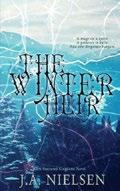
A human mage searches for a long-lost heir as part of mission to free his imprisoned faerie love in Nielsen’s fantasy sequel. Months after the events of The Claiming (2023), Summer faerie princess Lady Dew Drop, nicknamed “Dewy,” remains a captive of the Winter Fae. They’re confining her to their Winter Court
THE WINTER HEIR
until Spense Ferrous, an apprentice mage in the human kingdom Telridge, tracks down a missing Heir—the child of exiled Princess Snow. It’s a seemingly impossible task that Spense willingly takes on, as he and Dewy have fallen for each other. His plan is straightforward: Find the faerie Oracles and ask them where the Heir is. As this involves trekking the dangerous faerie lands, Spense travels with his half brother Crown Prince Dirk and other Telridgians to the mystical region of the Between. Meanwhile, Dewy works with the unexpectedly accommodating Winter King Lumine to develop her water magic. If she manages to uncover a link between water and powerful blood magic, it could change everything. Nielsen ably depicts the various environments; brisk cold and “winterstarved pines and fir trees” surround Dewy, while “bent and stretched” tr unks and branches form archways and corridors in the Summer faeries’ palace. It’s a solid backdrop for a breezy story teeming with modern dialogue and descriptions, including a “royally pissed off” Dirk. The two lovers recall Romeo and Juliet, but the author keenly expands upon their seemingly starcrossed status. Much of the narrative, for example, is about acceptance; for example, Spense, as the son of King Ferrous and Head Cook Cait, isn’t treated as well as Dirk is. There are also profound moments that focus on understanding others’ cultures: Winter faeries struggle to learn human customs, and Winter and Summer Fae are virtual opposites in many ways, including in their attitudes toward meat-eating. The strong-willed, ever-positive Dewy is a standout in a vibrant cast, even if she pines for Spense, who comes across as incompetent at times.
Magical characters navigate curious lands in an absorbing series installment.
Norton, Jamie | Valenza Publishing (350 pp.) $17.99 paper | June 25, 2024 | 9798989136896

In Norton’s novel, a retail worker in his late 20s navigates the challenges of his relationships, his passions, and his personal growth. The story opens in Rockingham, New Hampshire, in the late 2010s, with Mickey Patrick and his wife and high school sweetheart, Beth, at a health clinic; there, he discovers that she’s been having an affair with a man named Brad and is pregnant with his child. Afterward, the narrative shifts between the past and present, illustrating the pivotal moments of Mickey’s life that led to his current situation. As a child in Rockingham, he endured physical and emotional abuse from his stepfather, Raymond, which left him timid and submissive. During his high school years in the early 2000s, he found refuge in the Drama Club, where he could finally express himself; that was also when Mickey developed friendships with siblings Torey and Luci Rizzo. Torey, initially a bully, became his pal after Mickey stood up to him; Luci became a close friend for whom Mickey secretly harbored romantic feelings. In the present, with support from his brother, Mason (who eventually marries Torey), Mickey confronts Raymond about the years of abuse and later reexamines other aspects of his life. Overall, the book succeeds in fully developing Mickey’s journey as he moves from a place of
self-doubt to self-acceptance, and readers may find it inspiring and relatable. However, at times, the dialogue can feel overly dramatic, which detracts from the feeling of authenticity, as when one character defends their infidelity during an argument: “What do you care, man? You got to fuck fat little Dora! You should be happy!” Nonetheless, this book maintains a good pace with consistently engaging developments, such as the clinic visit, the confrontation with Raymond, and Mickey’s rekindling of his passion for acting. The relationship between Mason and Torey is sweet and a great foil to Mickey and Beth’s troubled marriage. An often compelling story about trauma recovery and personal empowerment.
Kirkus Star Loop
Osburn, Tara Lynn | Little Red Wagon Books (179 pp.) | $12.99 paper March 1, 2024 | 9798878916790

A tween ice skater struggles to balance her busy home life and the dream of achieving a solo routine in this debut middlegrade novel.
Laney Parker can’t tolerate not skating. At her skating club in New York’s Finger Lakes region, she’s a “spinner”—not ranked high enough to perform an individual routine in front of an audience. But this year, the coaches will choose three worthy spinners for a solo at the club’s spring show. Laney is certain she has a shot, if she can just pull off a double loop. Distractions, however, are ample. For one, new skater Malia Davis represents stiff competition and cozies up to (read: tries to “steal”) Laney’s bestie, Abby. And it’s maple season, so her family is hard at work processing sap into maple syrup to sell. Any skater who misses practice is automatically disqualified for a solo, so Laney will need both focus and determination. Osburn lays out many hurdles for Laney, like a fellow skater who keeps verbally skewering all her
teammates. The remarkable, resilient young protagonist has a tendency to be self-serving but is compassionate enough to recognize that others have problems, too. She’s supported by a dynamic cast that showcases a variety of personalities. Laney’s two-year-old brother Levi, for example, is so deep in his own little world that the Parkers grow concerned, and surely there’s a reason that neighbor/ schoolmate Mason is always at the farm helping out. Not only does the novel teach important lessons about family and friendships and overcoming selfishness, but it’s also full of fascinating details about ice-skating and making maple syrup. By the end, readers may find themselves drawn to many of the characters, including a few unexpected ones. An affecting, sweet tale about understanding and perseverance.
Pepper, E.J. | Troubador Publishing (352 pp.) | $12.99 paper March 12, 2024 | 9781805142836
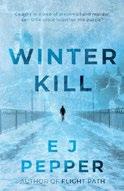
An unlikely detective probes the murder of an unpleasant man in Pepper’s mystery.
The mysterious Hamish Rosser, a shady Scottish peer of the realm, is a powerful man who keeps valuable secrets. With his reluctant assistant, the down-onhis-luck journalist Ollie Moorhouse (“The truth is the Scotsman fucking terrifies him”), Hamish pays mysterious visits to a variety of characters: He offers the bumptious Lord Arnold Leebury a post in government and obliquely threatens Arnold’s young and beautiful wife; he pledges suspiciously large donations to Greg Jacobs, a lonely widower who runs a charity for troubled youth. Many people have reason to murder Rosser, and, sure enough, somebody does, leaving his body in the woods. As the narrative unfolds, the suspects are drawn with more depth. Arnold’s wife, Magdalena, is cleverer and more of a survivor than she seems. The mostly affable Arnold is desperate to keep
his new political appointment—maybe desperate enough to get rid of Hamish. Greg, still mourning the loss of his wife, is struggling to connect with the young people under his supervision. Ollie, the one person readers know is innocent, grows into a bumbling but likable detective to solve the case. Pepper’s prose is brisk and evocative, bringing a variety of British locales vividly to life. Hamish, the murder victim, is oily and nasty enough for the reader to be happy when he meets his end. The other characters have well-developed and distinct personalities, and their stories are compelling even when they’re not engaged in sleuthing. (Magdalena, who seems like the most likely suspect, is particularly three-dimensional, even as she keeps her secrets.) This is, however, a murder mystery, and the author summons a fun Agatha Christie–like atmosphere as each character, in turn, comes under suspicion. Despite this great promise, the pacing in the final third undercuts the tension, and the revelation of the murderer feels a bit anticlimactic. Still, the satisfying conclusions of many of the characters’ stories are enough to carry the reader through to the final pages. This cozy yarn with compelling characters will please mystery fans, despite some fumbling at the finish line.
Rasmussen, Lynn | The Maui Institute (354 pp.) | Sept. 4, 2024
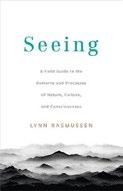
T he intricate dynamics of everything from chemical interactions to elementary schools have deep underlying unities, according to Rasmussen’s searching primer on systems theory.
The author, founder of the Maui Institute and author of Men Are Easy (2007), lays out basic concepts of systems theory and complexity theory
from the last half-century and integrates them into a grand framework based on Lenard Troncale’s systems processes theory, uniting physical, biological, and cultural aspects of the world. Rasmussen covers ideas including self-organization, the process by which simple individual actions yield complex, emergent group behaviors (as when individual birds that instinctively follow a few rules on how to position themselves beside each other become exquisitely coordinated flocks); the structure of networks; chaotic systems like weather and financial markets, in which tiny changes in inputs can generate huge, unpredictable storms or sell-offs; nested fractal patterns visible in everything from lightning strikes to broccoli to bitcoin values; and the breakthrough process of “systems ontogenesis,” in which low-level complexity makes a quantum leap to higher-level complexity (as when an assortment of organic molecules assembles itself into a living cell, or farming villages organize themselves into a state). In later chapters, the author applies these notions to higher-order phenomena like consciousness—slime molds, she notes, can do impressive cognitive feats like navigating mazes. Rasmussen’s treatise unfolds in concise, well-organized chapters that contain a wealth of instructive photos and charts. She conveys sometimes abstruse scientific concepts in prose that’s admirably lucid, straightforward, and intuitively appealing. (“Self-organizing criticality is the point of catastrophic change to the system…The sandpile after an avalanche has flattened, and its parameters have changed. A pandemic spreads until enough people either die or are immune, and the pandemic ends. A spark leads to a forest fire, leaving ash and debris.”) The result is a fine introduction for lay readers to systems theory that reveals its fertile insights in many ingenious guises.
A fascinating vision of the world as a kaleidoscope of patterns on the smallest and largest scales.
Reeves, Alistair | Podium Publishing (332 pp.)
$19.99 paper | Oct. 15, 2024 | 9781039475892
Series: The Rune Tithe, 1
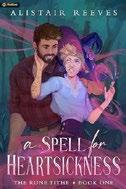
Friendship, love, and a magical mystery come together in Reeves’ romantic fantasy.
Briar Wyngrave, a witch, has always wanted to go to the city of Pentawynn to become a magical fashion designer (“It’s Pentawynn or death for me,” he says). Because the same curse that killed his mother is now affecting him and draining his health and magic away, he wants to leave a mark on the world in the short amount of time he has left; Pentawaynn, “the glittering metropolis of modern witchcraft,” is the ideal place to do it. But in a surprising twist of fate, a prophecy sends him to Coill Darragh, a small town in the middle of the ocean where his destiny has foretold of a lover hiding behind a mask. It’s there, along with his magpie familiar named Vatii, that he meets Rowan O’Shea, a handsome alderman with a mysterious scar to whom Briar is immediately attracted. To further complicate things, Linden Fairchild—a charismatic celebrity Briar has long had a crush on—comes to town to open his own shop, determined to cure curses. Torn between Linden and Rowan, Briar struggles with his feelings about the prophecy while trying to make a name for himself while he still can. A cursed forest, a ghost roommate named Gretchen, and strange happenings in
A novel as comfy and satisfying as “the taste of hot stew on a rainy night.”
town add additional flavor to this charming and cozy romance. The worldbuilding, which plays on a combination of modern and magical, feels fun and fresh—there’s a social media app called “Alakagram,” and enchanted clothing that helps people feel less shy at parties. The story’s focus on gay relationships and the general acceptance depicted in the town make for a refreshing read.
A novel as comfy and satisfying as “the taste of hot stew on a rainy night.”
Richards, Shola | Forbes Books (288 pp.)
$26.03 | Sept. 24, 2024 | 9798887504896

Go Together
Globalfounder and CEO
Richards offers a manifesto for improving the quality of life and work in a stressful world.
“I have been broken by this world, and maybe you have too,” writes the author. “There are times in my most private moments where I am haunted by the cruelty I have experienced and equally overwhelmed by the harshness and brutality of the world around me.” However, he’s also received healing warmth and kindness from strangers, he says, and in these pages, he defines this kind of civility and lays out possibilities for its growth and spread in a society that seems hostile to such ideas. He advocates keeping what he calls a “Civil Unity Journal” for the benefits of regular reflection; he also strongly suggests that readers delete social media from their lives, and, for the uninitiated, he explains such concepts as emotional regulation or personal triggers. Along the way, he also offers a good amount of advice about dealing with stress-inducing people. He effectively explains common fallacies, such as the omnipresent affinity bias, which arises from the fact that large percentages of Americans never deal with people of “different races, sexual orientations, ethnicities, or religions,” and
he warns of the risks of fabricated stories: “Just because a piece of content aligns with your political and social views doesn’t mean that it’s true.” Throughout, Richards’ strong, encouraging voice presents pragmatic, upbeat tips for fighting against forces that make civility more difficult. He even offers an optimistic guiding philosophy for helping radicalized people to feel valued, so that they don’t join extremist groups to find companionship. Whether readers are addressing disconnect on a personal or societal level, they’ll find a good deal of humanistic advice here.
A warmly compassionate call for better listening and more discussion about things that matter.
Rioux, J-S | FriesenPress (276 pp.) $41.99 | $22.99 paper | Dec. 11, 2023 9781039192614 | 9781039192607 paper

In Rioux’s military thriller, a tightknit group of U.S. Army soldiers learn that one of their own has been shot dead—not on foreign soil, but in Kentucky— and they vow to retaliate.
As the story begins, a team of soldiers engage in fierce fighting with the Taliban in Afghanistan. Sgt. 1st Class Emmanuel “Manny” Muñoz’s composure, bravery, and quick decisions keep the mission alive, and also show he’s “a badass and an outstanding combat leader.” A year later, back at Fort Campbell in Kentucky, Manny is promoted to first sergeant, thrilling the platoon. The day after the announcement, Manny and his young son Manuelito stop for cash at an ATM, and masked robbers from a nearby truck shoot and kill them both. Det. Jennifer Beck is put on the case. Because a child and a veteran were gunned down, the police are eager to catch those responsible—and so are members of Manny’s platoon. One of his men, Specialist DeMarcus Brown, locates the truck shown on the video feed from near the
ATM. He and Staff Sgt. Thomas “Sully” Sullivan, along with four other men from the platoon, decide to avenge their friend’s death by whatever means necessary: “Considering the criminal acts that they were about to commit and the possible shitstorm that might explode…if they screwed things up, they felt surprisingly ready.” Adding to that storm is Sully and Beck’s mutual attraction for each other. Rioux packs the pages with action and myriad emotions—disbelief, sadness, fear, love, hatred, loyalty, and hope. As the narrative explores the many ways that actions have consequences, the writing is fluid, the conversations are believable, and the wartime imagery is frightening and powerful. The author served in the military, and his expertise regarding the armed forces is evident throughout the book in passages such as “This was not the 1950s; women now accounted for over 15 percent of US Army personnel and served in the combat arms.” The footnotes explaining various military terms can be distracting at times, however.
A smart, scary, and satisfying novel.
Romero, Phillip | G Editions (256 pp.)
$24.46 | Dec. 19, 2023 | 9781943876396

T he celebrated pop artist Andy Warhol was a textbook example of how the mind can turn suffering into creative gold, according to this biographical meditation.
Romero, a psychiatrist and artist who knew Warhol personally, traces links between the artist’s artworks—including his carefully crafted public image—and his experiences of illness, social exclusion, and bereavement. These included serious childhood bouts of rheumatic fever and Sydenham chorea, also known as St. Vitus’ dance, which had lasting physical and neurological effects on the artist, Romero contends; they included a flattened affect and verbal
inexpressiveness, which he repurposed as an aloof, diffident, “cool” persona. Warhol’s father’s death in 1942 caused the teenager to hide under his bed for three days; however, Romero asserts, it also kindled an obsession with mortality that informed some of Warhol’s best-known paintings. His unhappiness about his physical appearance made him fixate on Hollywood-style beauty and glamour, which infused iconic paintings of James Dean, Marlon Brando, Elvis Presley, and Marilyn Monroe, and his early career as an advertising illustrator provoked disdain from the Abstract Expressionist elite, but it led the artist to an egalitarian pop art philosophy that erased the gap separating Campbell’s soup cans from fine art. And although Warhol’s intense shyness left him virtually friendless for much of his life, the author says, it also fueled a drive to become so famous that the world would seek him out, as when his Factory studio became the center of 1960s avant-garde New York. Romero fits these observations into a therapeutic framework that he calls Logosoma Brain Training, which combines ideas about the brain’s response to stress and its generation of creative thought patterns with evolutionary theory and Buddhist principles of nonattachment and mindfulness.
Romero’s nuanced portrait of Warhol teases out the complexities of his character, highlighting his agitation and insecurity— one vignette has him “sobbing hysterically” when a lover brought another man to their hotel room—and his veneer of Zenlike serenity: “The more you look at the same exact thing,” he said of his repetitive imagery, “the more the meaning goes away, and the better and emptier you feel.” The book’s analysis of Warhol’s contradictory personality conveys psychiatric tropes in colorful text with punchy metaphors: “Ondine, Factory superstar, coined a nickname for Andy— Drella, a portmanteau of Dracula and Cinderella. It reflects a poetic assessment of Warhol as a vampire seeking virgin blood while being disguised as a Cinderella-like virgin himself.” The author’s explorations of Warhol’s art are equally deft and open to the multiplicity of meanings in deceptively simple works:
“What did Andy Warhol see when he looked at a can of Campbell’s soup? He saw lunch. He saw childhood memories with his mother….He saw the factories of mass production. He saw art. A masterpiece of human ingenuity, creativity, truth, beauty, and goodness.” Well-chosen illustrations, including reproductions of some of the artist’s works, as well as candid images of the artist by various photographers, lend visual resonance to Romero’s commentary.
A shrewd and captivating journey into Warhol’s art, combining psychological insights with evocative prose.
Rosenthal, Clifford N. & Michael McCray
American Banner Books (408 pp.)
$34.99 | $24.99 paper | July 30, 2024 9780984690633 | 9780984690619 paper

A pair of insiders explore the complex racial and class dynamics of the credit union movement.
Credit unions first emerged in the early 20th century as an alternative banking option for low-income communities and nonprofits; they now serve more than 130 million members with more than $2 trillion in assets. Rosenthal and McCray assert that credit unions are unambiguously the “good guys” in a fiscal system plagued by greed, predators, and unethical leadership. Their book, which is divided into four parts, starts with 11 chapters by Rosenthal, who provides a historical overview of community development and credit unions. If anyone knows this history, it’s Rosenthal, who served for years as the executive director of the National Federation of Community Development Credit Unions in the 1980s and wrote Organizing Credit Unions: A Manual (1995). Rosenthal’s chapters also explore his own personal journey as a white man who led an organization whose largest stakeholders were people of color; there is also commentary on how the
banking system has perpetuated racial disparities into the 21st century. While Rosenthal is the credit union’s “historian,” according to the text, coauthor McCray is the movement’s “whistleblower.” As a graduate of Georgetown University Law School and a public policy expert, he centers his chapters in Part II on an indepth look at his role in the defense of the Kappa Alpha Psi Federal Credit Union (KAPFCU), organized by a historically Black fraternity, against the federal government. In an extended metaphor based on Alice in Wonderland, McCray highlights the surreal absurdities of the National Credit Union Administration capriciously closing and liquidating KAPFCU, due in part to policies that unfairly target institutions that serve low-income communities.
The book’s more hopeful third part emphasizes the ways that Black churches and other organizations can navigate a treacherous banking system and find ways to provide capital access to their communities. In the book’s final section, McCray provides readers with a nearly 80-page collection of original documents written by the NCUA and other parties during their case against the KAPFCU. Both authors are impassioned regarding ideals of Black self-sufficiency and the need for community-centered credit unions, but their differing perspectives and approaches create a well-balanced, thoroughly convincing book. Rosenthal, who also served on the Consumer Advisory Council of the Federal Reserve Board, effectively provides an insider’s account of the industry with an emphasis on historical context, whereas McCray, whose activism includes work with the Association of Community Organizations for Reform Now, provides an engaging grassroots perspective on the ways in which Black communities and organizations are victimized by a regulatory system that disregards their needs. Both men are experts in their fields, but the book’s intended audience doesn’t only consist of fellow insiders, but also lay readers; Rosenthal and McCray are both careful to provide consistently accessible descriptions of the intricacies of the financial sector. This effort is assisted by the inclusion of ample textbox vignettes, graphs, charts, and other visual aids, and
the authors’ firsthand perspectives are helpfully accompanied by more than 100 research footnotes.
A hard-hitting and persuasive indictment of the American banking system and a compelling defense of credit unions.
Ruskin, Zelly | She Writes Press (336 pp.) $17.99 paper | Oct. 8, 2024 | 9781647427245
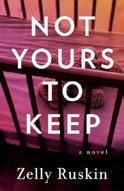
In Ruskin’s thriller set in 2012, a married couple hoping to adopt a child contend with a dangerous stalker with dark secrets. Billie Campbell and her harddriving attorney husband, Tyler, are in their 30s and considering adoption after unsuccessfully trying to conceive a child. Adopting a child won’t be easy, though, due in part to their financial struggles. Billie finds herself becoming increasingly distraught and frustrated, and her job at a local adoption agency makes matters worse, as she keeps witnessing people living the life that she wants but can’t have. Her anguish parallels that of a mysterious woman from Tyler’s past named Anne, who also yearns for a child she can’t have. As she begins stalking Tyler and Billie, he keeps Anne’s identity a secret from his wife, which also threatens to undermine their quest to build a family. Ruskin uses this explosive dynamic to place Billie and Anne on an inescapable collision course, foreshadowing disaster at every step. The labyrinthine twists and turns that follow are, indeed, messy, but they also contain moments of real sweetness and profundity, as when an adult adoptee talks about her relationship with her adoptive dad: “Sometimes, after a particularly tough day…my father would come in, open the window to my room, and help me step out onto the roof. We’d lie there looking at the stars. He’d pull out some chocolate, and we’d share it without ever saying anything.” The author’s depiction of Anne’s increasing instability is particularly heart-wrenching and thought-provoking. The story engagingly examines what drives
a person to commit villainous acts, and whether such acts are necessarily committed by bad people. By story’s end, it’s clear that, for some people, the answers to such questions can be nuanced and complex. An often intriguing narrative about loss and enduring hope.
Sanderson, Stacey | FriesenPress (120 pp.)
$18.99 paper | May 30, 2024 | 9781039197282

Sanderson offers a guide to understanding the psychological harm of narcissism. Thousands of years ago, as the Greek myth goes, the ethereally handsome Narcissus gazed at his reflection in a pool of water and was doomed to think only of himself. Narcissism, whose name was inspired by the story, is a quantifiable personality disorder in the Diagnostic and Statistical Manual of Mental Disorders, and the focus of Sanderson’s 20 years of work and research as a psychotherapist. Her approach in this guide, intended to aid the healing of those who’ve suffered due to narcissists’ actions, has a “holistic” slant; by this, the author means that conditions like narcissism, depression, or anxiety involve experiences that go beyond a binary of “broken” and “fixed”: “Clients identify with their illness and not their lives, saying things like ‘my depression’ or ‘my anxiety’ rather than recognizing the full spectrum of their emotions and experiences,” she writes. Very few people are diagnosed with narcissism, but many people demonstrate its traits, the author asserts. Sanderson effectively outlines which traits constitute symptoms of narcissism and how they affect others, as well as how they correlate with concepts such as codependent control, trauma, compassionate detachment, and boundary setting. The book also contains activities and journal prompts, with questions about identifying “narcissistic wounding.” The exercises use two primary frameworks: the
Attachment Blueprint for understanding and evaluating how one copes with trauma, and the Authenticity Blueprint for healing from grief. Readers will likely find these to be familiar concepts, but Sanderson’s method of grounding mental health in experience, rather than identity, is a refreshing approach.
A nuanced and accessible manual for assessing and transcending traumatic relationships.
Schrader, Helena P. | Cross Seas Press (516 pp.) $23.95 paper | May 15, 2024 | 9798987177020 Series: Bridge to Tomorrow, 2

Schrader continues her dramatization of the Berlin Airlift in this sequel. During the 15-month operation from the spring of 1948 to the summer of ’49, Allied aircraft dropped millions of tons of food and fuel into West Germany after the Soviet Union blocked shipping by rail and by sea. British Journalist Virginia Cox-Gordon, one of the many characters in this follow-up to Cold Peace (2023), thinks of the operation as “the Western Allies’ hopeless plan to supply the entire civilian population of Berlin by air” and as the most important news story since Germany’s surrender. Virginia and other characters return from Cold Peace, and new players are introduced as the Berlin operation complicates the lives of members of the Royal Air Force, the U.S. Air Force, Emergency Air Services, the Berlin city government, and Berlin’s civilian population, who are living under a new dictatorship as Josef Stalin’s grip tightens. The novel covers a few months of the operation, and by making use of the large cast, Schrader is able to take readers into virtually every aspect of the drama,
A
including the experiences of ordinary Germans and their representatives, such as city councilor Jakob Liebherr (“a glance at his surroundings reminded him of just how important hope was”), and those of the flyers, who risk their lives in the continuous air missions and also note how the world is changing. Even Soviet personnel feel the same: “All the good men,” one reflects, “the men who fought the war, are being replaced by party hacks, by NKVD stooges.”
The size of Schrader’s cast may be especially daunting for readers coming to this book without having read the first in the series. However, she effectively overcomes this element of intimidation in several well-deployed ways. She peppers her cast with intriguing characters, including Women’s Auxiliary Air Force Cpl. Galyna Borisenko, a Soviet-born Ukrainian who’s now a British citizen but still very much in alien territory, and wing commander and Battle of Britain veteran Robert Priestman, who bravely continues the airlift even in the face of a Soviet takeover of the entire city: “If I can help save 17,000 civilians—the bulk of them children—from Stalin, then I will,” he declares at one point. “It’s the moral equivalent of going down fighting.”
Priestman also notes the emergence of a new world in which the British Empire “could no longer shower largesse upon the poor of the world as America could.” The most colorful aspect of the Berlin Airlift—when planes delivered candies to the children of the city—is in many ways the dramatic centerpiece of this novel. The whimsical happiness of these “candy drops” helps to counterbalance the novel’s unfortunate penchant for delivering large blocks of exposition. Also, as in many wartime stories, several members of the cast feel more like familiar types than fully developed characters. Still, the power of the book is in how a true sense of humanity prevails. A carefully researched and accessible novel about a pivotal operation in postwar Germany.
See, Gel | Illus. by Gail Rae Javier Self (24 pp.) | $11.99 paper
June 12, 2024 | 9786210614275

See offers a bedtime story exploring the potential and reality of dreams in this picture book.
For the grateful mother of the story, the birth of her child is the brightest dream come true (“Your first hello made everything right”). In reverence of that, she extols the virtue of dreams in a bedtime story meant to guide her baby into peaceful slumber. The mother encourages her child to go to the furthest reaches of her mind. Sometimes with mommy in tow and other times with a fuzzy white bunny that has tall, rocketshaped ears, the small child (who, like her mother, has pale skin and dark hair) ventures out into various landscapes, exploring whatever might exist in each one. While urging her child not to be bound by worldly matters or naysayers, the mother warns of hurdles that are inevitable along the way, reminding the little one that she will always be there to offer support and love. See has rendered this bedtime story in poetic verses broken up into two or three quatrains that question and inspire; this section is followed by a couplet that pulls the child back into the safety net of the mother’s warmth and belief in them. Javier’s chalky illustrations, in deep purples, night and sky blues, and luminous pinks, are speckled with twinkling stars and planets, all hazily softened to evoke a dreamscape primed for subconscious imaginative play. A nurturing sendoff into a dreamworld of playful wonderment.

Semenow, William | Olympia Publishers (234 pp.) | $10.99 paper | Oct. 27, 2022
9781800741058

Rabbi and attorney Semenow tells the story of his life from birth to middle age in this first of two memoirs.
The author was born to a Jewish family in Long Beach, New York, in the late 1940s. He lived in a three-decker with his loving parents and extended family members, and he writes of cultural touchstones that readers will find familiar, such as his desire to get a decoder ring and his admiration of comic-strip boxer Joe Palooka. At the State University of New York at Stony Brook in the 1960s, he headed the student court, presaging his later interests. In his early adulthood, he got a draft deferment during the Vietnam War and attended the Woodstock music festival. He was accepted to medical school in Barcelona, but barely attended class; there, he met his wife, Anna Maria. They came back to the U.S. together, and he attended law school at Cleveland’s Case Western Reserve University. He eventually settled on bankruptcy law as a specialty, and he offers a long, informative disquisition about how Chapter 13 bankruptcy appealed to him as the most humane of options, allowing honorable debt repayment without personal humiliation. It turned out to also be a lucrative field for him and his partner; they expanded by opening another practice in New York City, but there, he says, “it became clear to us that almost everyone on our payroll was stealing from us.” It was a “very expensive lesson,” he says, but an important one. Later, he embraced Orthodox Judaism, which made him happy and fulfilled. Throughout this memoir, he presents accounts of engaging cases and other anecdotes, drawing on his time as a criminal attorney and a real estate speculator. There are also moments that show that he would likely be a wonderful storyteller in person, as when he tells of knowing Yoko Ono before she was famous (“She was trying to be a poet.
She was terrible”) and of seeing the Velvet Underground: “mesmerizing—especially Nico, whose voice was haunting.”
An engaging remembrance by a likable author.
Street, Steve Moncada | Contingency Street Press (330 pp.) | $17.99 paper Aug. 6, 2024 | 9781958015063

People search for meaning in Cairo, Buffalo, and beyond in Street’s debut collection of stories and essays.
The author, who died in 2012, left behind an impressive body of short fiction, which is assembled here along with a number of personal essays. Several of the stories are set in Egypt, where Street taught for four years at the American University in Cairo. In one, a couple from New York on the verge of a breakup share a cafe with a corpse wrapped in a white sheet. In another, an Egyptian tennis instructor is baffled by his American student, and not just because neither of them speaks the other’s language. A Ptolemy-obsessed English instructor heads to a desert oasis despite the impending war to visit a famed oracle from antiquity. An expat diving instructor checks out other expats on a scuba expedition in the Red Sea, as Street describes with his typical dry humor: “He’d chatted with the Californian enough already to have learned her state of origin, but he didn’t like to hit on a woman until he knew they both wouldn’t be stuck on the same boat the next day.” There are also stories set back home in America: A grad student works in a laundromat, a bully visits one of his victims who has recently been in a car accident, a man teaches a boy he’s never met how to fish. The book concludes with eight personal essays, many of them about Street’s life in Obama-era Buffalo, New York (he discusses such topics as the elderly, opinionated neighbor whom he begrudgingly befriends and his experiences taking the bus) as well as a few
miscellaneous pieces on Russia and life in academia. As Don Eron writes in his introduction to the collection, “Street doesn’t give instructions about how to live, or preach that he has a better idea. All he does is report from the front.”
Street is full of brilliant observations about expat life. One American in Cairo, preparing for a party he doesn’t want to attend, thinks, “It would be no worse than he’d expected: another strained expat evening, everybody trying to make up for the impermanence of their circle with the intensity of their delight in and concern for each other.”
The line appears in the title story, one of the collection’s strongest. It follows a language instructor bent on leaving Egypt; he is planning to break up with his girlfriend, only to learn something unexpected about her past romantic life that causes him to interfere with another couple’s engagement. Street is a shrewd observer of human personality: “After all, he’d come eight thousand miles for her sake, professing cultural curiosity, but she knew better,” a woman observes of her boyfriend. “Marty wouldn’t cross a street unless he knew what he wanted on the other side.” Though the stories are better than the essays (which arguably prolong the book unnecessarily), there’s a hard-earned wisdom and quiet craftsmanship to all of Street’s pieces, making it difficult for the reader to ever tire of them.
A varied but reliably compelling collection of prose.
Suitt, Thomas Howard | Palgrave Macmillan (283 pp.) | $104.20 May 24, 2023 | 9783031310812

Suitt examines the role Christianity plays in helping post-9/11 military veterans manage the trauma of their service in this nonfiction work.
In both official and unofficial ways, Christian moral frameworks are inescapable in the American military; as the author observes, approximately 65% of people serving claim a Christian affiliation of some kind. Despite the constitutional separation of church and state, the military reinforces Christian ideals by making the chaplain a central figure who provides religious services, ethical instruction, and spiritual as well as psychological counseling. This “religious cultural toolkit” furnished by the military can be indispensable to veterans processing the pain and trauma of their service. The author presents a rigorously empirical investigation of religion’s role in the healing process— Suitt interviewed 48 veterans and six military chaplains who served post-9/11 and who identified as Christian at some point during that time. What emerges from these “religious military narratives” is a fascinating picture of the ways in which the military’s use of religion “is simultaneously good and bad, or rather, creative and destructive.” On the one hand, it can provide genuine spiritual succor necessary to active soldiers as well as those attempting the fraught reintegration into civilian life. On the other hand, religious dogma can be used to reinforce a military agenda— war, violence, and the dehumanization of the enemy—at odds with Christian morality. The sample of interviewees has its limitations, a fact that the author acknowledges, and Suitt’s prose can be leadenly academic, too often deploying phrases like “religious meaning-making systems.” However, this is a thoughtful and provocative study that highlights the many ways in which the military co-optation of religion can restrict the moral agency of its soldiers and make them fully responsible for their own trauma (“Simply, if service members are not autonomous moral agents, then just war considerations of blameworthiness in war ought to fall on superior officers and the military organization overall”). This is a stimulating and timely study, especially in an age of perpetual and religiously charged war. An important and insightful contribution to the literature on religion in American military life.
Weigel, Erin | Two Waves Books (304 pp.) $37.99 paper | June 11, 2024 | 9781959029373

Weigel offers a one-stop guide to improving product design for customers.
In her nonfiction debut, the author, a senior design manager, shares tips and strategies for product development based on the overall framework of “Good Experimental Design,” which she describes as a way to move the whole process “beyond opinion”: “It uses research, A/B testing, and data analysis to create reliable evidence, which enables consistently better decisionmaking.” Objective evidence is at the heart of what Weigel refers to as “Conversion Design,” which rests on three key elements: Design, Science, and Business. “Accessibility is if something is possible to do,” she writes; “Usability is if something is easy to do.” In these pages, she offers a wide-ranging approach to aligning both. The author covers basic terminology (“contrary to popular belief, the idea behind hypothesis testing is not to prove the alternate hypothesis true,” she writes. “It is to be extremely skeptical of the alternate hypothesis and assume the null hypothesis is true”), explains what makes some experiments effective, and details concepts like controls, randomization, and experimental variables. The book is lavishly illustrated with graphs, charts, colorful visuals, and highlighted insets on subjects such as “Expert advice from the field.” From fundamentals to more specialized topics like work processes and stakeholder responsibilities, Weigel is an energetic, absolutely winning guide. “I’ve lived about a hundred lives in my short time on this planet,” she writes, and readers will believe it—these pages brim with lessons learned from experience and hard-earned wisdom. There’s no such thing as one “right” decision in experimentation, the author cautions, and in the world of Conversion Design, seeming paradoxes abound: Processes can be efficient but not effective,
workers can be productive but not efficient, and so on. With tremendous engagement and clarity, Weigel explains it all. A wonderfully readable field guide to making better designs and getting better end results.
Whitley, Jeremy | Illus. by Cassio Ribeiro Maverick (220 pp.) | $14.99 paper Aug. 13, 2024 | 9781952303609

Two queer girls go on a journey of love and selfdiscovery after learning a beloved manga series has gone out of print. Neesha Sparks is a Black, introverted lesbian who has recently moved with her mother from Queens to North Carolina. On her first day at Durham Western High, she meets a fellow new kid—chatty Boricua Gabrielle Graciana, who’s bisexual. Neesha and Gabby are in the same classes after their principal transferred Neesha out of her original honors classes on the erroneous assumption that her cerebral palsy limited her intellectual ability; he soon moves her back into honors classes, and the two girls become inseparable. The unlikely duo find common ground in their love of a manga series called Super Navigator Nozomi, which is about a steampunk spaceship’s engineer and her feelings for the ship’s pilot. Neither have finished the series, so they create a book club of two, but when Neesha discovers that her collection was sold by her father, they embark on a scavenger hunt for the now-out-of-print volumes. As they travel all over the state, the novel, sprinkled with snippets from Navigator Nozomi’s adventures, becomes less about the manga and more about their developing friendship. Both girls have personal struggles from their pasts that could complicate their budding romance. After Neesha’s last girlfriend tanked her self-confidence, she hid her disability, history of activism, and love of cosplay. Meanwhile, Gabby is still reeling from her mother’s sudden death a year ago. Despite these serious themes, the novel is sweet
and heartfelt with a wholesome romance at its center. The character development is satisfying to watch, especially when paired with Ribeiro’s illustrations, which capture a wide array of emotions in scenes ranging from love confessions to tense arguments. Whitley’s dialogue handles the various issues (orientation, ableism, racism, PTSD, abusive relationships, death) with great care. Earnest and uplifting.
Wilson, Leon | Self (376 pp.) | $10.99 paper April 2, 2024 | 9798876727947 | Series: Jackson Wade and Dog, 2
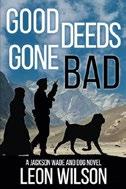
Wilson continues the adventures of former Delta Force soldierturned-mercenary Jackson “Jax” Wade and his giant Kuchi dog partner in this sequel to Dogs Bark and People Die (2020).
Fresh off a successful mission in Afghanistan with former Delta Force brother in arms Jesse Morris (they neutralized marauders attempting to disrupt a natural gas pipeline running through Afghanistan to India), Jackson Wade is contacted by his former employer, Damocles Security Services, at his home in Thailand with an urgent request. As American troops begin their withdrawal from Afghanistan, and as the Taliban rushes in to take over the country, the U.S. president’s niece, a human rights activist, is trapped in Taliban territory with two of her would-be rescuers, both female CIA operatives. With a potential political disaster looming, Wade (along with canine partner Dog) and Morris are tasked with the virtually impossible mission to extract the “package” and the two CIA agents from enemy territory that’s swarming with Taliban and Taliban sympathizers. As the body count rises, the mercenaries travel through a wasteland of inhuman horror and brutality. And as they inch closer to their destination, Morris asks a profound
question that is very much a theme of the work: “Is Dog becoming more like us, or are we becoming more like Dog?”
There are numerous narrative elements that make this novel—and this series— simply unputdownable. The character development is exceptional; while the vast majority of military thrillers feature emotionally stunted, two-dimensional stereotypes, Wilson digs deep into not only Wade’s psyche, but also those of supporting female characters, including former U.S. Army captain Gretchen Sachs, the executive assistant to the head of Damocles; Carol Rossa, deputy CIA station chief in Kabul; and Sharon Beck, an analyst on the counterinsurgency desk in the CIA section of the American embassy in Kabul. The multilayered characterizations are complemented by adrenaline-fueled pacing and nonstop action that will keep readers breathlessly turning pages. Short chapters and frequent shifts of POV also help to maintain the fast and furious narrative momentum. Military fiction afficionados will appreciate the attention to detail when it comes to weaponry and tactical equipment: “Oakley Tombstone shooting glasses with gray-brown lenses covered their eyes, and each wore tan tactical shooting gloves. HK 416C carbines were near at hand, with 10.4-inch barrels, vertical foregrips, retractable stocks, Aimpoint CompM4 reflex sights, and inserted twenty rounds of .300 AAC Blackout cartridges.” Wilson’s frequent references to pop culture add an additional layer of interest and subtle humor—namechecks of Jean-Claude Van Damme, the Game of Thrones series, Mad Max, and Stephen King’s Cujo will have readers smiling to themselves. But the principal element that makes this series such a wildly unique military-thriller saga is the psychic connection between Wade and Dog. Their ability to “mind-talk” is fascinating in and of itself, but the way Wilson subtly ties it to arcane Afghani folklore—“some Kuchi dogs are magical”—makes the connection even more intriguing. One minor caveat: The story’s romance elements around Wade and Morris and their respective love interests come across as forced, inauthentic, and, frankly, unnecessary.
A thrilling amalgam of Clancy’s Jack Ryan and London’s White Fang set in the chaos of South Asia.
David McConnell



Nick Bostrom



